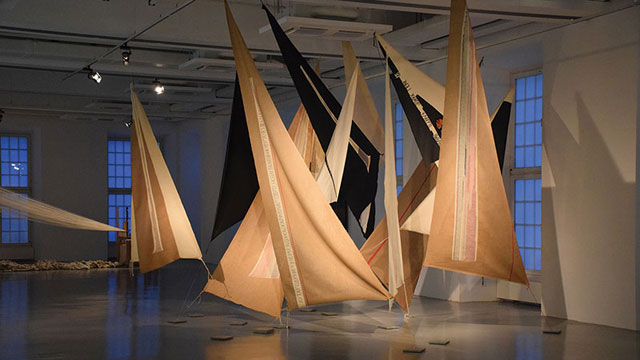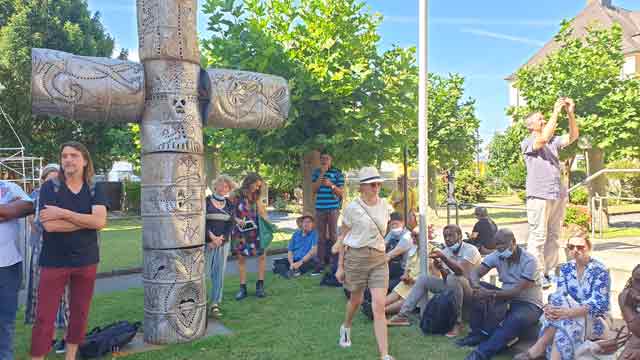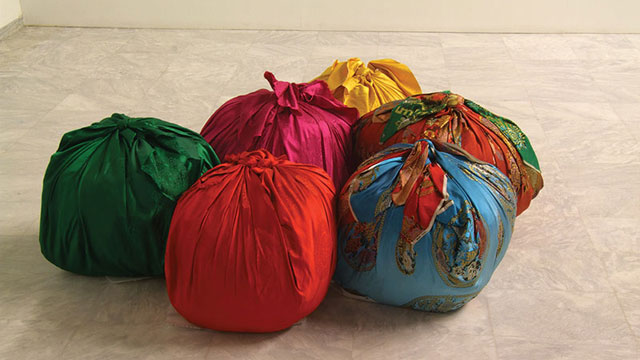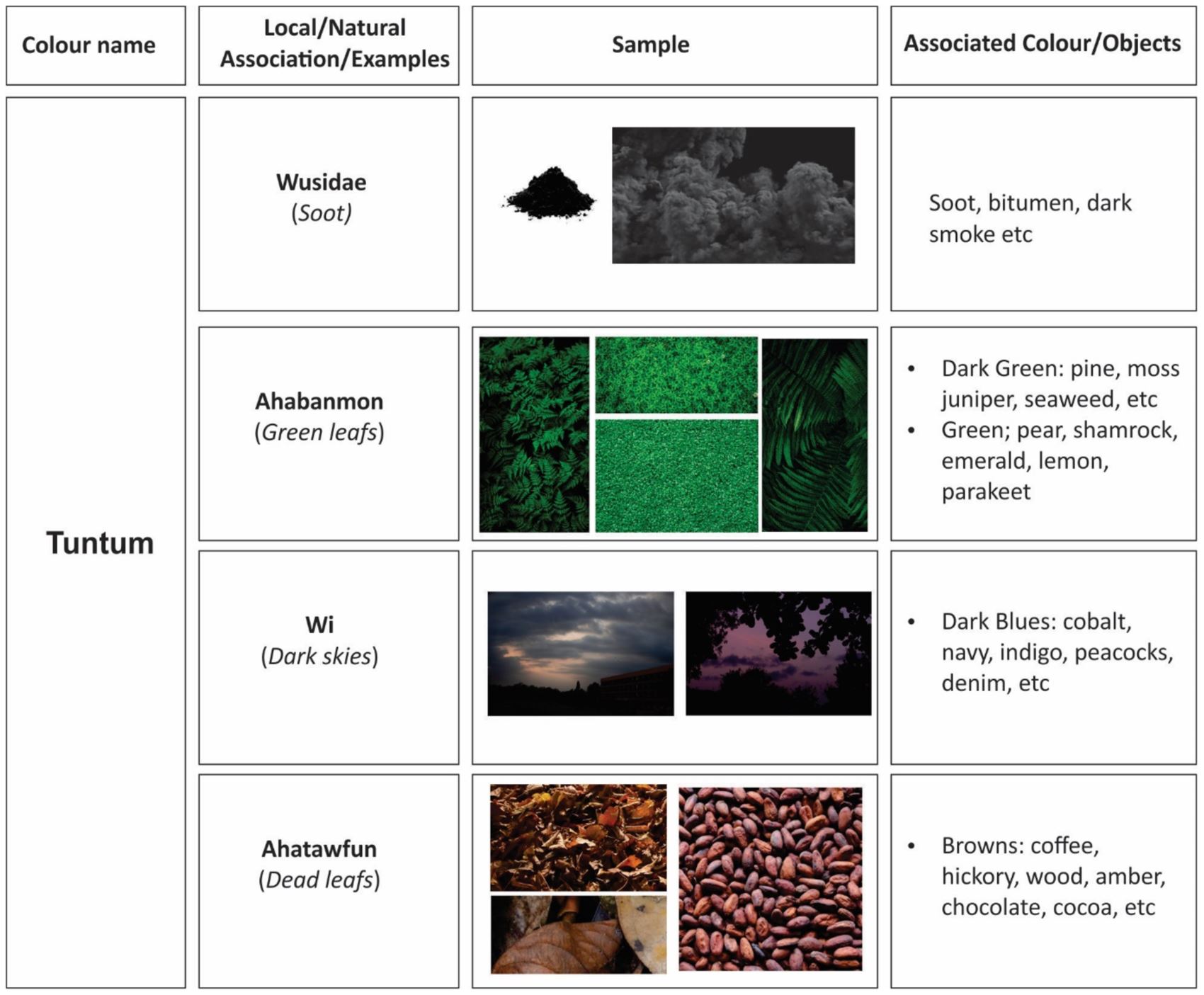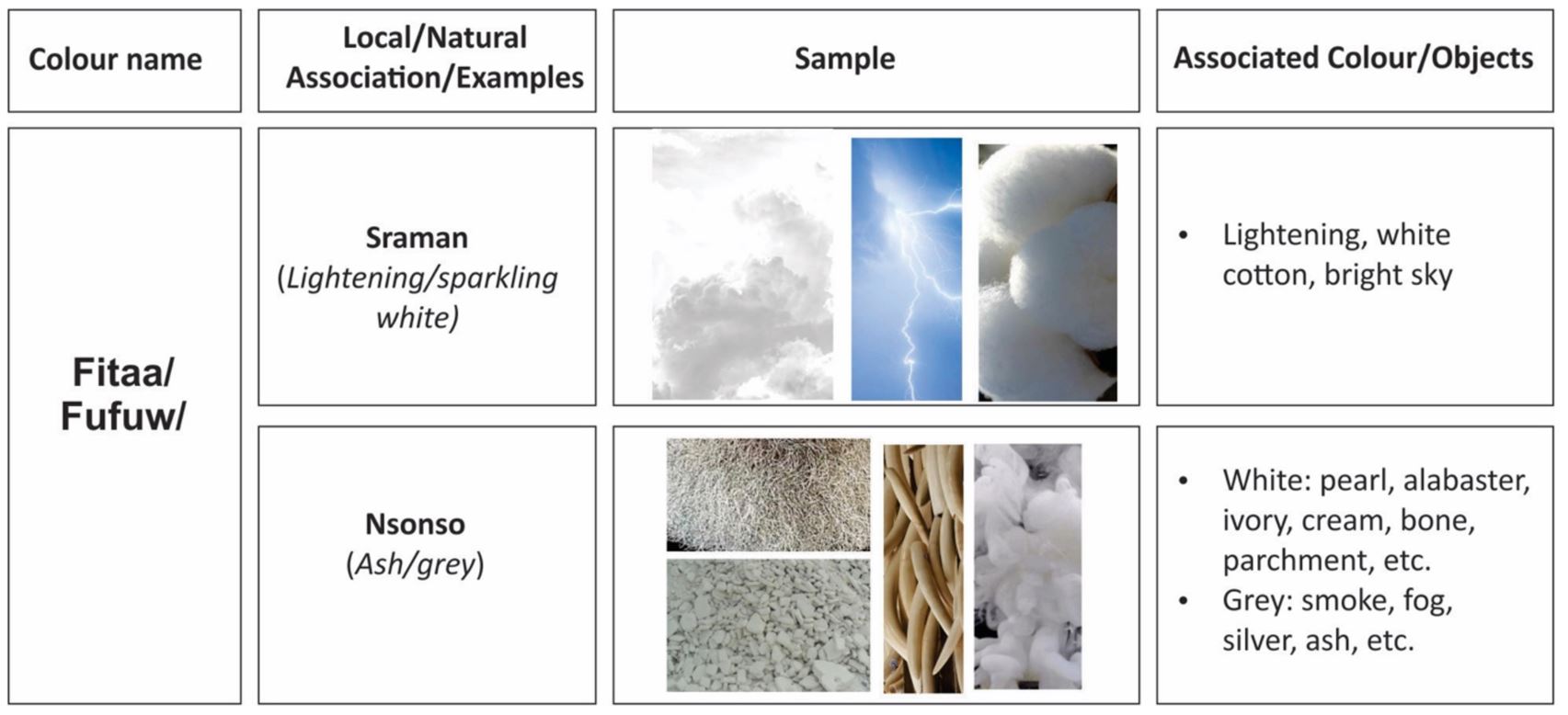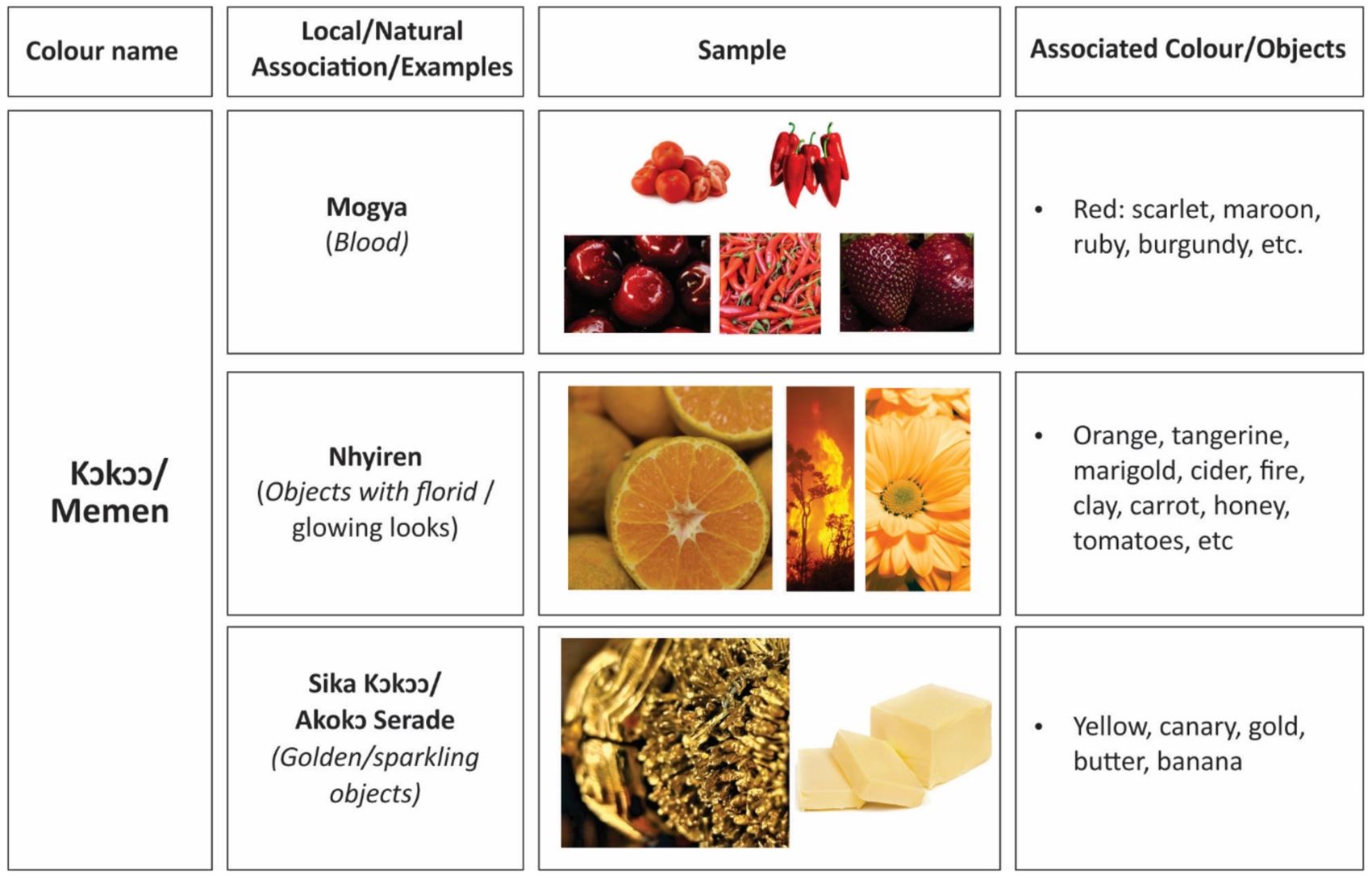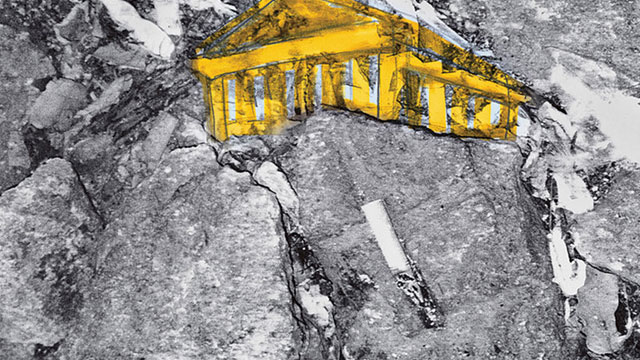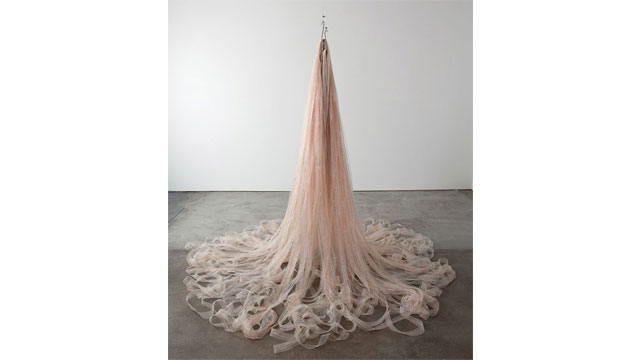Dear user,
This section of our website forms the heart of the EVC project. Here you find a collection of images of objects from different ‘visual cultures’. Our contributors selected and interpreted them in their respective contexts believing that these objects are particularly important for intercultural understanding across boundaries. Each time a user opens this page, the order in which the objects appear changes. In this way we hope to avoid a hierarchical understanding of the collected objects as their entries continue to be accessed in the long run. The constant changing face of the page also reflects the continuous expansion of the collection. As there are already over more than a hundred entries, users may want to form an overview, or to navigate through the growing collection according to their interests. For this purpose, we offer the following search options:

Filter: This enables you to search for objects according to time, place, keywords, etc. / Free title search: If you know the title of an object, you can find it in the free search field. / Lab: In the lab section, objects from the database are grouped under overarching themes. This is an ongoing project and about to be expanded extensively.
Enjoy exploring our database!
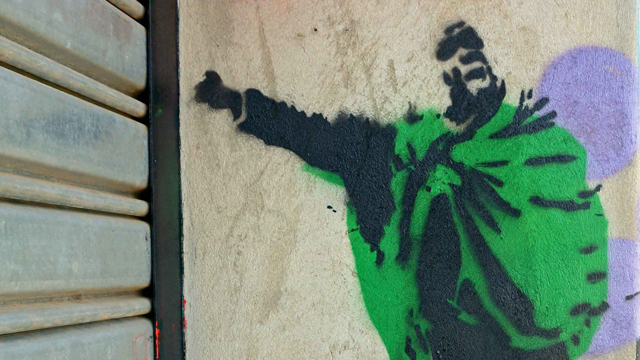
-
 Runette Kruger
Runette KrugerCape Town based Tokolos Stencil Collective uses stencil and graffiti to address socio-political issues such as lingering racial inequality, labour exploitation, segregation, and poverty. The name of the collective refers to a dwarflike mythical being, the tokoloshe, that materialises at night to frighten unsuspecting victims, now mobilised by the Collective to “terrorise the powers that be”, or, the status quo of inequality (Tokolos-Stencils, 2015). The declared aim of the Collective is to highlight continuing spatial and social segregation in a post-apartheid South Africa (Botha, 2014).
The social discrepancies whereby the majority of South Africans continue to experience social and economic isolation are addressed by Adato, Carter and May (2006), who cite the Poverty and Inequality report of 2000. In the report, South Africa is described in terms of two parallel worlds, “one, populated by black South Africans where the Human Development Index (HDI) was the equivalent to [that of] Zimbabwe or Swaziland. The other … [populated by] white South Africa in which the HDI [was] between that of Israel and Italy” (Adato, Carter and May, 2006, p. 226). This inequality had, disturbingly, only deepened between 2000 and 2006, and in a March 2018 report by the World Bank, South Africa is cited as the most unequal country globally in 2015, based on the Gini coefficient of 0.63 of that year (World Bank, 2018, p42). The Gini coefficient measures the gap in income between the wealthiest and poorest members of a population. A score of 0 would indicate absolute income equality, and a score of 1 would indicate that one person owned all the wealth. This disparity, as well as the resultant exploitability of the poor, informs the Tokolos Stencil Collective’s main subject matter.
The most widely recognizable image associated with the Collective is the Remember Marikana stencil, which combines these words with an image of Mgcineni Noki, known as Mambush to his friends and family, or, within the context of the Marikana massacre, The man in the green blanket. The Marikana event played a formative role in the establishment of the Collective – it was founded in 2013 on the day of the first anniversary of the event (Anaya, 2014). The massacre is widely regarded as a watershed crisis, comparable with the Sharpeville tragedy of 21 March 1960, now commemorated as Human Rights Day.
Noki was a community leader who became a prominent news figure in the days before the Marikana massacre, identifiable by the bright green blanket tied around his shoulders. The Marikana massacre took place on 16 August 2012 when striking miners working at the London-based Lonmin Platinum Mine in the North-West Province were gunned down by police wielding automatic rifles, violently ending a six day build-up of tension. Noki grew up in Thwalikhulu, a small village in the Eastern Cape, and was aged 30 at the time of his death. He had a wife and two year old daughter who lived in Carletonville, about 100km away. He is reported to have attempted to de-escalate the growing violent skirmishes, and to focus the gathered strikers on their aim – to increase their wages. The evening before the massacre, the miners were led to believe that if they returned to work, wage negotiations would begin. In the hours before the final events, while the miners’ repeated requests for negotiations were ignored, they were finally beseeched by their union to withdraw. Weighing up the growing indications of a final crack down, Noki began to lead a group of miners away from the outcrop of rock that had been the main scene of conflict over the course of the week. As they reached the nearby settlement their path was blocked by police and barbed wire. Noki led the men another route, only to be blocked again. The ensuing gunfire on the group led to the death of 17 men, Noki among them, identifiable by his green blanket as he lay on the ground. A second group of men were also attempting to leave the site, and were fired at with 295 bullets, resulting in 17 more casualties. The strike continued for another five weeks before the mining company agreed to negotiate. Pay was increased by 7% (Davies, 2015).
I specifically chose this image of Noki, his arm raised while exhorting and encouraging his fellow workers, instead of the dehumanising imagery of up-close, lifeless mineworkers that was freely shared by the press. In contrast, this image in the Remember Marikana stencil shows him as a leader with courage and purpose, and has become an iconic symbol of the struggle for dignity and an adequate wage among the most exploited workers in South Africa, on whose labour an economy that they are unable to access, has been built. Commenting on the lot of the under-classes in 1940, during the impending humanitarian crisis of the Second World War, Walter Benjamin (1969, p. 255 original emphasis) reminds us that “every image of the past that is not recognized by the present as one of its own concerns threatens to disappear irretrievably ... To articulate the past historically ... means to seize hold of a memory as it flashes up at a moment of danger [failing which] even the dead will not be safe”. The Remember Marikana image reminds us that it is crucial to prevent the sacrifices of the most vulnerable members of society from slipping into the amnesia of oblivion.
References
- Adato, M., Carter, M.R., & May, J. (2006). Exploring poverty traps and social exclusion in South Africa using qualitative and quantitative data. The Journal of Development Studies, 42(2), 226-247.
- Anaya, V. (2014, September 10). Tokolos Collective: “Cape Town is a very oppressive place for the poor”. Wiriko Artes Y Culturas Africanas. Retrieved from https://www.wiriko.org/tag/marikana/
- Benjamin, W. (1969). Illuminations. Edited by Hannah Arendt. New York: Schocken.
- Botha, N. (2014, November 21). Tokolos Stencil Collective: 'Crap' art designed to unsettle. The Mail & Guardian. Retrieved from https://mg.co.za/article/2014-11-21-tokolos-stencil-collective-crap-art-designed-to-unsettle.
- Davies, N. (2015, May 22). The savage truth behind the Marikana massacre. The Mail & Guardian. Retrieved from https://mg.co.za/article/2015-05-21-the-savage-truth-behind-the-marikana-massacre.
- Tokolos-Stencils. (2015). Retrieved from http://tokolosstencils.tumblr.com/.
- World Bank. (2018). Overcoming poverty and inequality in South Africa: An assessment of drivers, constraints and opportunities. Washington DC, USA.
published March 2020
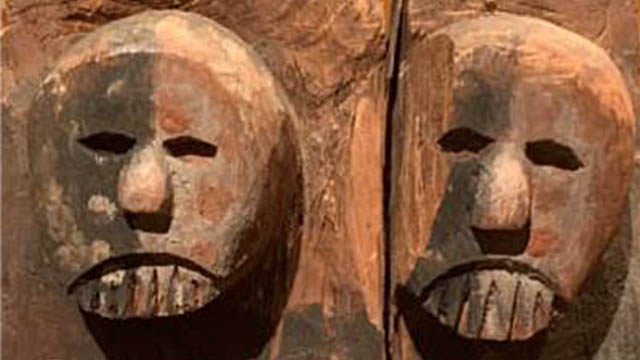
-
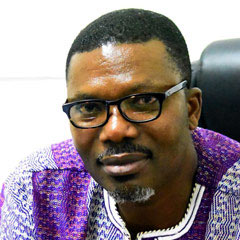 Patrique deGraft-Yankson
Patrique deGraft-YanksonExploring an Enigmatic Piece of Traditional Cameroonian Sculptur
The Veranda Post found in Museum Fünf Kontinente is an exemplification of the extent to which indigenous Africans mutually reinforced socio-religio-cultural existence and expressiveness of form through sculpture. Various examples of these artefacts abound in the collections of African plastic artforms found in many museums across the globe. The beauty in experiencing, analysing and speaking about this artwork (as well as many of its kind), lies within the absence of authenticated historical and analytical literature on them. This makes it possible for the observer to exert complete authority of personal perception and interpretation devoid of any fixed attitude that dictates, interfere or curtails aesthetic enjoyments, interpretations and judgements, as attempted in this presentation.
With the dimensions of 199 x 60 x 50 cm, the Veranda Post found in Museum Fünf Kontinente is one of the numerous examples of the African artistic expressiveness, confirming the artistic prowess of the traditional African. Examples of these artefacts abound in the collections of African plastic artforms which record indigenous religious beliefs, practices and performances that date back from the beginning of African history.
As typical of most indigenous African sculptures, this work is not only uncaptioned, but the artist/creator is not known. What is known, however is that, its peculiar characteristics and style makes it easily identifiable and representative within the milieu of popular African sculptures. According to the Museum Fünf Kontinente records, this work was collected from 'Kamerun'. 'Kamerun' was an African colony of the German Empire between 1884 and 1916, which was located in the region of today's Republic of Cameroon (Wikipedia, 2020). Comparing the characteristic features of this sculpture with similar sculptures described by some art historians as Veranda Posts created as part of ancient African monumental architectures found in the Cameroons Grassland (Willett 1981) therefore, it is not difficult place it within that category. Hence its caption.
As can been seen from similar ‘posts’ and judging from the elaborateness of the images created on them, the major reason for the production of these posts was more to afford the sculptor or sculptors the opportunity to decorate the buildings with stories, rather than serving as supports (see figure 1).
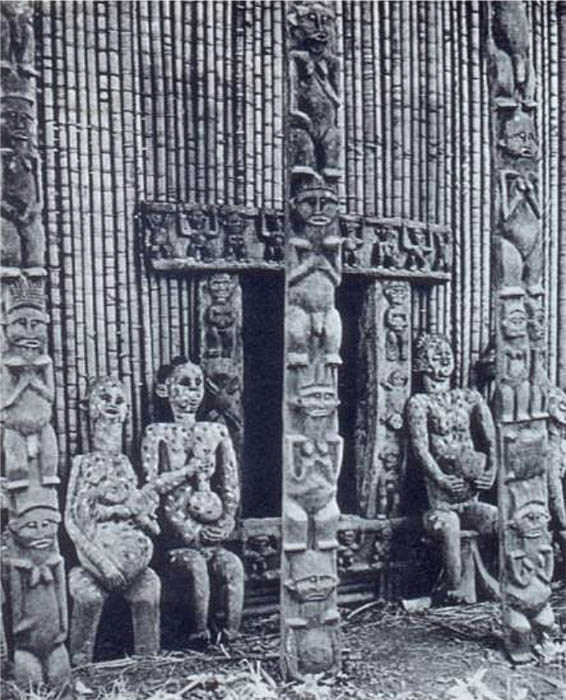
Figure 1: Ancestor statues, carved door-frame and verandah posts (Source: Willett 1981)
As said above, the beauty in analysing and speaking about this artwork (and many of its kind), lies within the absence of historical and analytical literature. The fact that this makes it possible for me (and for that matter any other observer) to exercise personal powers of perception and interpretation without any fixed attitude to direct or curtail their aesthetic interpretations and judgements made it my object of choice for this project at the Museum Fünf Kontinente.
Going by Margaret Trowell’s generalisations about African art, this Veranda Post can be classified under the ‘spirit-regarding’ art. Like many others of its kind, this work, which has front and back views, is flanked with human and other figures, ostensibly those of ancestors and is symmetrically disposed about a vertical axis, rendering it frontal at both sides.
Analyses of the images created on this pole reveal striking similarities between the age old traditional religious practices of the African and the Western religious beliefs and practices brought in by the earlier missionaries.
At the direct look of the object from the front (as it has been positioned at the museum, but actually one of its two sides), a prominent kneeling figure with hands clasped together unto the chest (much like the praying hand) can be seen in a pose that looks very much like the kneeling praying postures at Christian worships. To the African, this posture is not only assumed at prayer sessions as a visual image of submission to God’s authority, but is also exhibited as a sign of respect, humility and total surrender to a superior authority. For the sculptor to present the kneeling man as a central figure and subsequently rendering all other human figures in similar submissive postures therefore makes the theme of prayer, submissiveness and spirituality very strong in the composition.
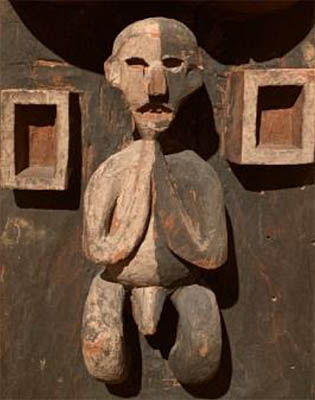
Figure 2: The kneeling or praying figure
The kneeling man is placed right below two human faces whose prominence and positioning easily pass them for elders, superiors, or better still, ancestors. Before the ancestors, all supplications are made, and through them, request are carried through to the supreme God.
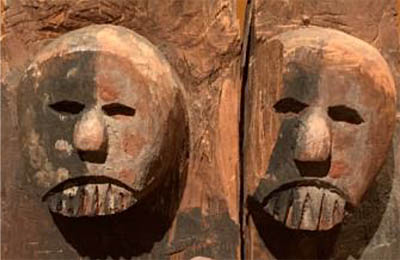
Figure 3: Ancestor figures
The importance of the two faces and emphasis on their superiority is further strengthened by a strong demarcation between them and the kneeling man through a thick rigid contoured line that forms a partition between the elements. This could be interpreted as a spiritual borderline that separate the spiritual world from the physical world. Generally, the African believes in the existence of the physical and the spiritual worlds as separate entities and this demarcation clearly depicts this belief. Also worthy of notice is the orientation of the demarcating border which rhymes with the praying hands of the kneeling figure, thereby visually connecting the figures. This carefully chosen placement of the two faces in the composition alludes to the supremacy of the ancestors and their exclusive existence in the after world as well as their connection with humans.
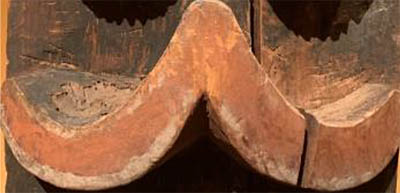
Figure 4: The spiritual borderline
Another striking imagery is created with the placement of a very visible image rendered in concentric circles. Among many African ethnic groups, the circle represents completeness, holiness, perfection and other such attributes ascribed to the supreme being (God). Among the Akan people of Ghana, for instance, the Adinkra symbol called Adinkrahene (king of Adinkra symbols) is presented as concentric circles. This symbol represents authority, leadership and charisma. The sculptor most likely created a bull’s eye of this symbol as an indication of exactly where this particular post belongs. The post could possibly be one of the furnishes for a palace or the abode of a traditional priest. This could also suggest the likelihood of the prominent kneeling figure being the King or the chief priest. Considering the atmosphere created by these symbols, the circle, with the kind of prominence it exudes could also represent the omnipresence of the supreme being, thereby heralding the people’s belief in the iniquitousness of God and His closeness to mankind.
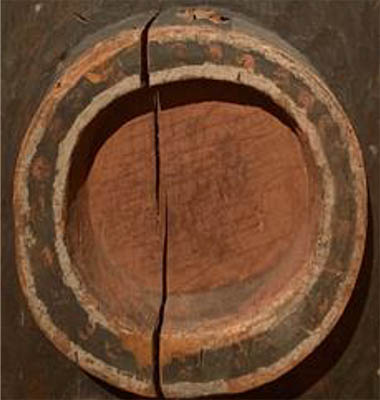
Figure 5: The concentric circles
Other recognizable images of animate and inanimate objects in the work include crocodiles, lizards and geometric shapes. Whilst it is likely that the geometric figures may have been deliberately presented to create balance, simulate a built living environment and arouse aesthetic sensibilities, the images of animals like those of the crocodiles have significant meanings as far as African culture and belief systems are concerned. Among some ethnic groups in Africa, crocodiles are believed to be the souls of ancestors who come back to live with men. Examples are the crocodiles in the Crocodile Pond at Paga in the northern part of Ghana who virtually live peacefully among the people. There are numerous African stories about crocodiles coming to the aid of men to either protect them or lead them to safety. Their inclusion in this particular work therefore is to establish the existence of spirits among men, especially as humans pray to seek their guidance and protection.
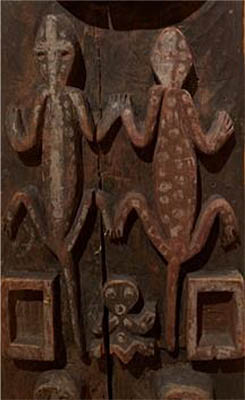
Figure 6: The crocodiles
Considering where it was created and where it is located now, as well as the current effort towards extracting a meaning out of its symbolism, this veranda post and many other such African artefacts in several museums around the globe have demonstrated how images and symbols resonate relationship between cultural practices around the world. The confluence of symbolic interpretations of the icons in the traditional African religions and the Euro-Christian religion, as depicted in this veranda post, gives justification to Africa’s unquestionable acceptance of Euro-Christianity and all the associated visual cultural practices.
For comparison, also read Karin Guggeis' analysis of this object here.
References
- Roy, C. (2019). Signs and Symbols in African Art: Graphic Patterns in Burkina Faso. Signs and Symbols in African Art: Graphic Patterns in Burkina Faso. https://africa.uima.uiowa.edu/topic-essays/show/38?start=13
- Wikipedia. (2020). Kamerun. Kamerun. https://en.wikipedia.org/wiki/Cameroon
- Willett, F. (1981). African Art. London: Thames and Hudson.
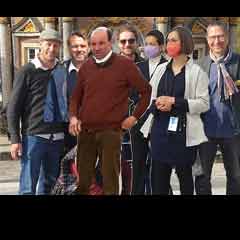 ISB_Team
ISB_TeamThis 'Veranda Post' is variously referred to (mostly in relation to its architectural-functional context) lintel or "te ken dy dye" (in the local Bandjoun language - PHSAA), porch post, house front pillar, post, cult house post (M5K, p. 17), Cameroon post / family crest (Macke at M5K, 13, 24). Post, however, in the sense of sign (post-it) is suggested by PdGY to address the communicative function. Other designations do not address the function, but limit themselves to the given, perhaps to avoid any pre-interpretation: 'sculpted wooden block' (Kecskési 1999 n. 108) or 'large carved square wooden block' (Kecskési 1976, p. 22).
Object biography: The object was taken before 1893 by Max von Stetten during expeditions on the Bamileke Plateau (south-western Cameroon), where it was presumably part of a meeting house of a confederation. Stetten (1860-1925) was German commander of the Kaiserliche Schutztruppe for Cameroon until 1896. Cameroon was a German colony at that time. The exact circumstances of how the object came into Stetten's possession are unknown, as is its original location and context.[2] In 1893, the Royal Ethnographic Collection acquired the pillar as a gift from Stetten.[3] In 1912, a photograph of the pillar was published in the Almanac of the Blaue Reiter. It is currently on display in the permanent exhibition in the Museum Fünf Kontinente Munich in a niche - a mirror allows a view of the second side (see Fig. 2). Along with other objects from the collection, it is currently the subject of a transnational project on their provenance (GI).
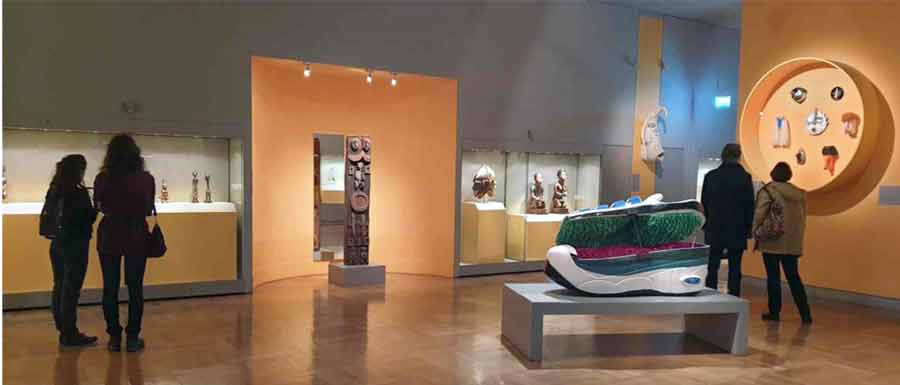
Fig. 2
Status: In comparison with carved mullions on façades of royal residences in the Cameroon grasslands (Fig. 3),[4] other mullions or door frames in the Museum Five Continents (M5K, p. 17, Kecskési 1999 No. 11, 70, 75) or in the Humboldt Forum Berlin, there is a partial similarity of motifs, but a strikingly 'archaic' formal language. Other examples are clearly more 'elaborate'. The multitude suggests that this type of pillar is quite typical of works from this period in this region of West Africa.
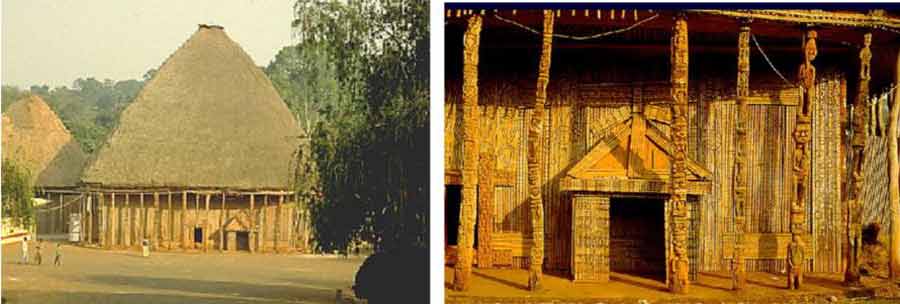
Fig. 3
Interpretation
The current view of the work
For the interpretation, the following questions lend themselves to art lessons: Form, iconography (meaning of the motifs), function, theme (or core idea) of the object, i.e. an interpretation.
With regard to the guiding idea of multi-perspectivity, two positions will be addressed: On the one hand, the view of today on the basis of ascertainable contexts, which seeks to understand the object from its time of origin and its context of origin. On the other hand, the view of the object by the artists of the Blaue Reiter. The comparison of these perspectives seems particularly relevant from an art didactic point of view, even though other perspectives would be conceivable, e.g. from the point of view of museology, provenance research, from the context of current restitution debates, etc. However, these are addressed in the teaching suggestions.
Shape
At first, the pillar develops an immediate physical presence for the visitor: through its sheer size (larger than life, almost square in plan), the materiality of the massive, cracked block of wood (the outline is irregular and probably corresponds to the tree) and the clear, concise, reduced language of form, whose meaning seems inaccessible. The surface treatment is archaic, the wood is more hewn than carved.[5] Thus it appears powerful and at the same time mysterious, which is supported by its presentation in the exhibition on a plinth and without glazing (see Fig. 4).
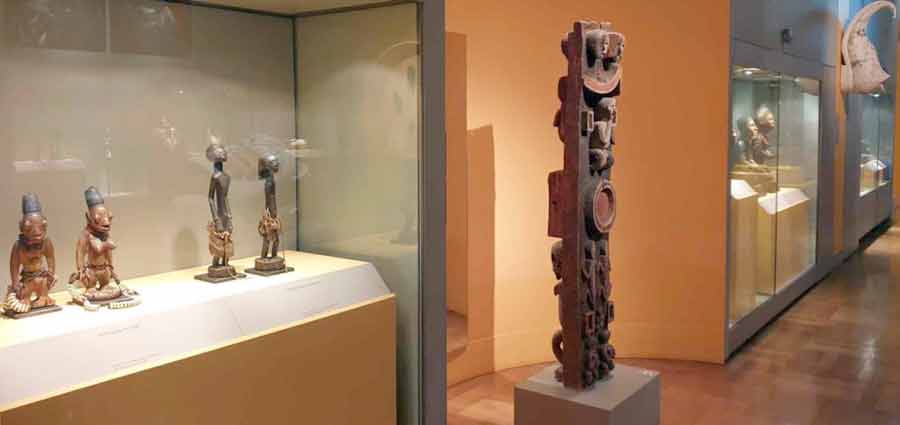
Fig. 4
A closer look reveals how the sculptor interweaves various modes of representation between complete abstraction (circle, rectangle) and representationalism (human figures, animals) in a compositional way[6] , monumentalising the individual motifs through internal symmetry, geometrisation, frontality and statics. This is supported by the painting (see Fig. 5). In this reduction, everything narrative is missing. The representation becomes emblematic, it becomes a symbol.
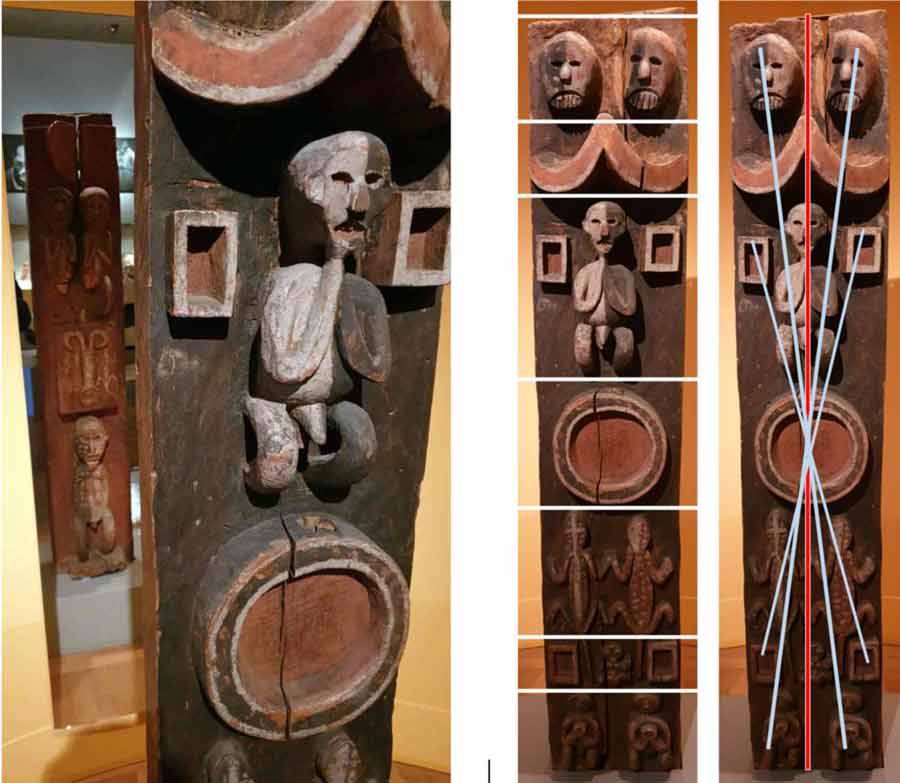
Fig. 5, 6 and 7
This is also supported by the overall composition, which obviously follows a calculated geometric order. It is strictly horizontally divided into individual zones, only once do lizard tails protrude into another zone. However, the separation into individual layers is ingeniously overcome compositionally by the strict axial symmetry in the vertical, but also by the point-symmetrical arrangement around the respective centres. The result is a tension between the contradictory compositional principles (see Figs. 6 and 7) that is decisive for the effect of the pillar.
The lack of any narrative on the one hand and the high creative effort on the other underline once again that it is about a symbolic level. This can perhaps be deciphered, even if its immediate complex order makes it seem above all direct, sensual.
The secure decoding of the iconography (what the individual motifs as well as the arrangement meant in the context of origin) is not possible with today's state of knowledge. Oral culture has left no written sources that could be consulted. Moreover, the oral tradition has been torn down - not least due to colonial destruction. However, since the work obviously has a symbolic language with clear iconography, this level cannot be left out in art lessons. German-language literature and oral experts from West Africa were consulted here. The results contradict each other, but nevertheless yield a court of meaning (see Fig. 8, in which the individual attributions of meaning are named)[7] , which provides a certain direction.
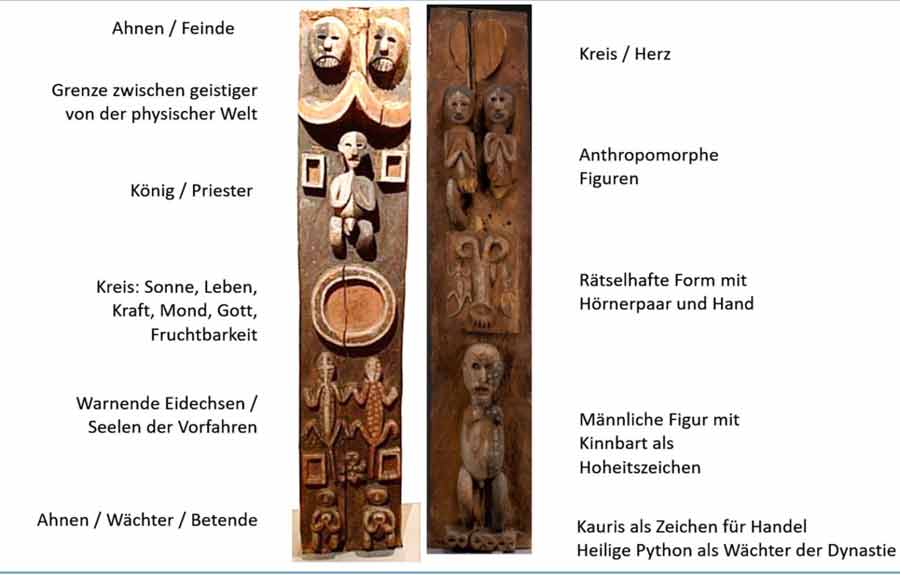
Fig. 8
In addition, the block is painted in three colours. These also carry meanings: Black could symbolise suffering, white could be the colour of the dead and symbolise mystery, red, the colour of blood, symbolises life (PHSAA). The light-dark contrasts themselves symbolise life and death (Kecskési 1999).
Function
PdGY suspects that the pillar - as part of the architecture of the house - stood at the spatial interface with the public (on a path) in order to communicate the significance of the house, presumably a cult house, to the outside. The object could therefore have been part of the façade of a particularly distinguished house[8] , also with a supporting function for the roof. It communicates what happens in the house or who lives or resides there.
Kecskési, on the other hand, considers a free positioning in space (Kecskési 1976, p. 22) and suspects an ancestral tablet. This in turn would fit the following determination by Gouaffo: "The 'Blue Rider Post' is a spiritual object. According to oral traditions, the object was placed in the sacred house like a statue. Caps, chains, bags or skeletons could hang from the object. Secret societies like the 'Losango' used the statue to perform certain rites, for example to cleanse the village of evil spirits." (Albert Gouaffo in GI) KG also suspects the context of a meeting house of such a secret society. Common to all assumptions is that the pillar stood in the context of a house with a sacred or cultic function.
'Theme' of the object: Basically, three different levels can be delimited, some complementary, some contradictory. First, the communication function on the façade or at the entrance to the outside. Then the pictorial formulation of a certain understanding of human being-in-the-world is asserted; man is ultimately embedded cosmologically.[9] At the Humboldtforum Berlin, in turn, such pillars from West Cameroon are also seen as the "architecture of power", power exercised by the rulers or the secret societies through impressing and deterring.[10]
Second perspective
The interpretation provided above can be countered by a second perception of the pillar, as it appears in the almanac "Der Blaue Reiter". This almanac, an artist's book, was published in 1912 by Franz Marc and Wassily Kandinsky. The reception of this book is over a hundred years old, but it is significant for the development of European art, as it is a good example of how artists of this time created a new frame of reference by referring to non-European art. In this respect, the Blaue Reiter clearly differs from Cubism, Expressionism or Dadaism, which were all being developed at the same time.
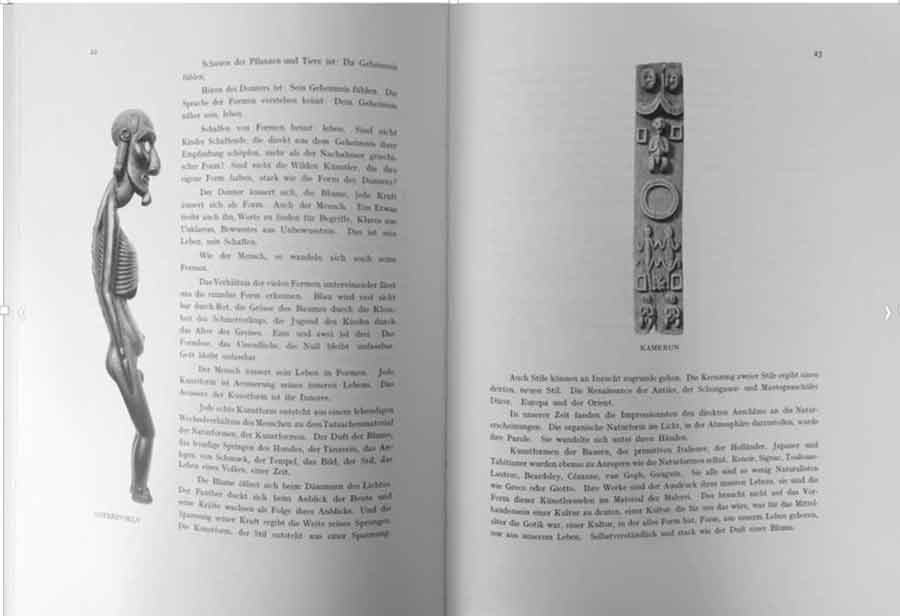
Fig. 9
In the Almanac, on pages 21 to 27, there is an essay by the painter August Macke entitled "Die Masken" (The Masks), in which a relatively small illustration of the pillar in question is embedded (see Fig. 9). Macke's contribution, like all the other texts in the Almanac, was probably written at a joint meeting of Macke, Marc, Münter and Kandinsky in Murnau.[11]
Visits to ethnographic museums are documented above all for Wassily Kandinsky, who was a trained ethnologist, and Franz Marc. Marc had also admired sculptures from Cameroon in particular during his visit to the Berlin Ethnographic Museum in 1911. And it was he who was ultimately responsible for the insertion of the photograph of the post in Macke's article.[12] In his letters to Macke, Marc writes about this. On 14.1.1911 about the objects from Cameroon in the Berlin Ethnological Museum: "I remained amazed and shaken by the carvings of the Cameroonians"; and later that he would furnish Macke's article in the Almanac with "ethnographic wonders" (MW).[13] In the text itself there is a single, very brief reference to "carved and painted pillars in a Negro hut", by which presumably the post was meant.
The text itself represents Macke's conception of art. In it, "intangible ideas", "mysterious forces", an "invisible God" express themselves in the world of appearances and "cultic expressions". The invisible materialises in the visible. This realm of the visible includes not only art, such as that of Giotto or van Gogh, who are classified as 'primitive', but also nature. Children's drawings, the folk art of the 'primitives' and 'savages' or non-European cultural forms are also expressions of the mysteriously invisible. These themselves are - and this is decisive - equal to each other. There is no hierarchy, no distinction between high and low, between high art and popular culture. All forms speak - as Macke characterises it - in "strong language". For Macke, the pillar in the museum is then an example of "the tangible form for an intangible idea, the personification of an abstract concept" (Macke 24). He also calls this the figure of an "idol".
The approach underlying this thinking sounds familiar; we have known it since the Platonic theory of ideas. However, this approach does not justify the selection of this particular post, as other posts from the museum's collection would also have been available.[14] Here one can only assume. I suspect that there are various factors that led to the selection: the archaic power of the forms; the initially wild and carefree-looking, additive combination (or montage) of the various principles of representation in the individual motifs (concrete - abstracted, geometric - organic, symbolising - depicting), which on closer inspection, however, then reveals itself to be consciously composed; or the coarse, physically perceptible materiality of the cracked, thick block of wood in impressive dimensions. PdGY also speaks of "wonderfully composed".
In the work, everything is represented with great sensual power that is the opposite of an "empty" image in European "cultures that have already passed through a thousand-year course, like [...] Italian Renaissance" (Macke 24) and from which Macke renounces: "We must bravely renounce almost everything that has hitherto been dear and indispensable to us as good Central Europeans [...] in order to get out of the fatigue of our European lack of taste". (Macke ibid.)
In art lessons, the question arises to what extent the image that Marc or Macke create of the pillar (as representative of the idea of an idol) goes together with what the object presumably was and is in its original context. Or to put it another way: are they designing a certain, exotic image that does not correspond to the object itself? [15]
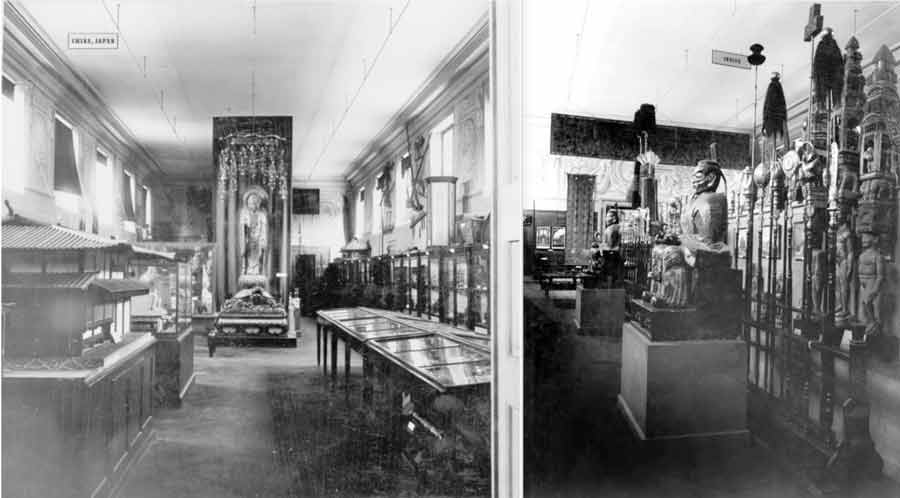
Fig. 10 Historical photos of the exhibition of the India Department in the Munich Museum around 1910 (source M5K)
References
- GI: Juliane Glahn and Marta Krus: CAMERUNS RIGHT TO CULTURAL OBJECTS. https://www.de/prj/zei/de/pos/22656808.html
- Kecskési 1999: Maria Kecskési. Art from Africa - Museum of Ethnology Munich. Munich (Prestel) 1999
- Kecskési 1976: Catalogue for the exhibition African Art. Andreas Lommel (ed.). Munich (Bruckmann) 1976
- M5K: Staatliches Museum für Völkerkunde München (ed.). The Blaue Reiter and the Munich Museum of Ethnology. Munich (Hirmer) 2009
- KG: Karin Guggeis. The Blue Rider Post. (2021): https://www.explore-vc.org/en/objects/expanding-the-canon-of-art-at-the-global-north.html
- PdGY: Patrique deGraft-Yankson. The Veranda Post. (2019) https://www.explore-vc.org/en/objects/the-veranda-post.html and oral interview on 23.4.2022 in Bayreuth, Iwalewahaus.
- PHSAA: Paul-Henri Souvenir Assako Assako. Information by email 20.5.2022
- Wikipedia: Cameroon & Max von Stetten
- MW: Macke Wolfgang (ed.). August Macke - Franz Marc: Briefwechsel, Texte und Perspektiven. 1964. Cologne (DuMont).
- Macke: Macke August. The Masks. In: Almanac "Der Blaue Reiter", 1912, edited by Franz Marc and Wassily Kandinsky, pp. 21-27
Appendix on iconography
- Anthropomorphic figures: ancestral couples / guardians and protectors of the royal residence. These anthropomorphic figures are treated with respect as extraordinary personalities. They are considered ensouled beings, spirits with supernatural powers. (PHSAA) Depiction of all human figures in similar postures: theme of prayer and submission to spirituality. (PdGY)
'Front' side from bottom to top:
- Two people: Ancestral couples / guardians and protectors of the royal residence (PHSAA). People pray for the guidance and protection of the ancestors (PdGY).
- Lizards: The symbol of the lizard warns everyone; it symbolises death. (PHSAA) PdGY sees here two crocodiles (ancestral souls returning to live with humans) instead of lizards.
- Circle: motif of the sun, symbol of life and power; the moon, image of woman and symbol of fertility. (PHSAA) The circle represents completeness, holiness, perfection and other attributes attributed to the supreme being (God). (PdGY)
- Kneeling figure: King or priest (PdGY)
- Line of demarcation between the spiritual and the physical world
- Two heads above: Ancestors (PdGY)
'Back' side from bottom to top:
- Python (geometric frieze at the bottom of the 'back' side): royal totem/sacred python, guardian of the dynasty (PHSAA).
- Male figure with chin beard as emblem of sovereignty (Kecskési 1999)
- Enigmatic form with a pair of horns ending in a hand (?) at the bottom (Kecskési) on a rectangle with two flanking lizards.
- Anthropomorphic figures
- Circular area
Footnotes
[1] The object is variously referred to, mostly in relation to its architectural-functional context: lintel or "te ken dy dye" (in the local Bandjoun language - PHSAA), porch post, house front pillar, post, cult house post (M5K, p. 17), Cameroon post / family crest (Macke at M5K, 13, 24). Post, however, in the sense of sign (post-it) is suggested by PdGY to address the communicative function. Other designations do not address the function, but limit themselves to the given, perhaps to avoid any pre-interpretation: 'sculpted wooden block' (Kecskési 1999 n. 108) or 'large carved square wooden block' (Kecskési 1976, p. 22).
[2] The first German trading posts were established in Cameroon as early as 1868, and in 1891 German military "expeditions" were launched in Cameroon. In 1884, the German Consul General concluded protection treaties with regional rulers and thus proclaimed the protectorate of Cameroon as a German colony. The seizure of the hinterland, which included the grasslands, took place over the course of the following 30 years. (Wikipedia) Even if the provenance is still not clear today, one can certainly share the Humboldt Forum's assessment of such objects that - even if they were not looted through acts of war - they are nevertheless "an expression of unequal power relations and structural, colonial violence". (https://www.smb.museum/nachrichten/detail/ethnologisches-museum-weg-frei-fuer-die-rueckkehr-der-ngonnso-nach-kamerun/)
[3] In the entry book it is noted: "Gr. square block, 1.80 cm high made of heavy wood, carved on both sides with humans and lizards, heavily damaged by termites". (https://onlinedatenbank-museum-fuenf-kontinente.de/) In 1895 Stetten published detailed "Travelogues" in the Deutsches Kolonialblatt.
[4] http://www1.biologie.uni-hamburg.de/b-online/afrika/kamerun/palast.htm; http://www1.biologie.uni-hamburg.de/b-online/afrika/
[5] The block is almost certainly worked with a chisel.
[6] "decorated with geometric, anthropomorphic and zoomorphic forms" (PHSAA)
[7] All performers avoid a complete decoding. They only make suggestions for individual motifs.
[8] It could have been the house of a 'priest' whom one could consult there and through whom or ancestors one could pray to God (PdGY).
[9] "Expression of the cosmogony of the universe of the peoples of the Bamileke plateau; expression of the belief system" (PHSAA).
[10] The assertion of power is also included by PHSAA.
[11] Catalogue: August Macke, Lenbachhaus Munich, 1987, Bruckmann. Munich. S.164
[12] He simply titled the painting "Cameroon", the name of the country of origin (the country whose sculptures he admired).
[13] There are other illustrations in the text: a bird's head from Brazil, a figure from Easter Island (see Fig. 9), one from Mexico, a bird mask from New Caledonia, a cloak from Alaska[13] and a child's drawing entitled "Arabs". Except for the child's drawing, all objects are from the then Royal Ethnographic Collection in Munich (M5K, p.11). They are only titled with the respective country of origin, e.g. Cameroon. Macke was obviously involved in the selection as well as the layout, as his layout sketch shows (M5K 24).
[14] It is not certain what was shown in the presentation at the Royal Ethnographic Collection in Munich at the time, which covered 400 square metres in six rooms in the north wing of the Hofgarten arcades in Munich. The only thing that is certain is that photos of the ten objects depicted, which came from various parts of the world, were lent to the artists for the publication of the Almanac. Photos of the presentation do not exist. "Whether Marc and Macke [actually also] saw the work in the exhibition at that time can be assumed with a high degree of probability, since it is after all very large and thus impressive." (Information Karin Guggeis 26.7.2022)
[15] In this context, it seems of interest that neither Marc nor Macke take up in their own pictorial language the aesthetics of the non-European works they "celebrate" here.
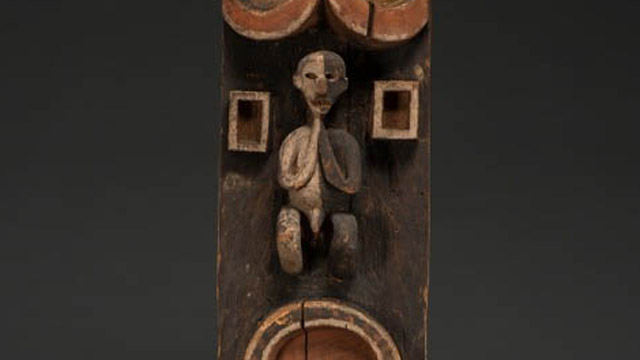
-
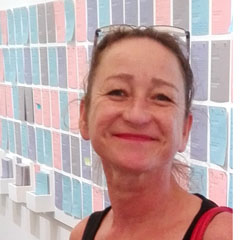 Karin Guggeis
Karin GuggeisObjects from the Global South in early collections of the Global North often lack any information about their specific local context. This is also true for this wooden sculpture made from a single block of hard wood, carved with different figures and forms on two sides and painted with natural colours in red, white and black. It was acquired in 1893 by the “Royal Ethnographic Collection” (Königlich Ethnographische Sammlung) in Munich, today the Museum Fünf Kontinente. No specific information about its geographic origin, its producers, users or use was documented in the inventory book. “Huge four-edged block, 1.80 high made of heavy wood, double-sided carved with human figures and lizards, heavily damaged by termites” is the only information recorded. The wooden block was sent from “Cameroon” (Kamerun) which is therefore documented as its region of origin. It was given to the museum as a present by Max von Stetten, a colonial officer in the German colony.
The post gained a new layer of significance through its inclusion in the almanac “The Blue Rider” (Der Blaue Reiter), one of the most famous and important publications on art in the early 20th century in the Global North. The almanac was edited in 1912 by two artists based in the environs of Munich, Franz Marc and the Russian Wassily Kandinsky. They designed the publication as a starting point for a new epoch of art, rejecting academic art and encouraging new forms of artistic expression. Thus, Kandinsky and Marc included reproductions of different non-canonical art forms, such as artworks from the Middle Ages, folk art, art made by children – and non-Western artworks, in those days called “art of the primitives” (Kunst der Primitiven), among them this sculpted block from Cameroon. In this way, the editors of the almanac aimed to break down the hierarchies between art forms from different times, regions and levels of professional skill, and to expand the canon of art in the Global North.
The editors’ fascination with non-European art had different roots: Wassily Kandinsky was a trained ethnographer and often visited ethnographic museums. Franz Marc, since his visit to the ethnographic museum in Berlin in 1911, especially admired sculptures from Cameroon. Thus Marc included a photograph of this wooden block to illustrate August Macke’s article “The Masks” (Die Masken). Marc captioned the picture simply “Cameroon” (Kamerun), its known geographic origin, and the country whose sculptures he admired.

Fig 1: Almanac "Der Blauer Reiter" (page 58-59)
In his article, the artist Macke stressed that for Africans their “idols” (Idole), as he called their sculptures, were a “visible expression of an invisible idea”, “a personification of an abstract term”. He also stressed the equality of the art forms from different times and regions. For example, Macke valued bronze works from the kingdom of Benin, in what is today Nigeria, and other ethnographic works, because they are just as expressive as a grave marker in the cathedral at Frankfurt. To demonstrate this non-hierarchical attitude to art from different regions and times, Marc and Kandinsky placed two photographs side by side on a double page in the almanac – on one side the Gothic figure of a knight, and on the other a bronze plaque showing a soldier from the kingdom of Benin, which also was in the collection of the Munich ethnological museum by then (Fig 1).
The later fame of the almanac, and of its publishers Kandinsky and Marc as artists, led to the wooden sculpture being named “The Blue Rider Post” in the narrative of the museum.
It is significant for global art history dominated by the Global North that, in contrast to our broad knowledge in respect of the European admirers of this object, very little is known about its original local context in the Global South. The state of our knowledge concerning its producer(s), its patron(s), its use, its specific place of origin, the meaning of special forms, colours, figures or gestures sculptured is poor. There are two reasons for this. First, in the Global North, there has been little interest in investigating its local context. Second, it is actually very difficult to carry out such investigations in respect of such badly documented early works in ethnological museums. To unfold these difficulties: the common method used to trace the local context of poorly recorded works is to look for stylistic similarities and ethnological background information concerning comparable objects in other collections or publications. Spending long periods doing fieldwork in the place of origin is too time- and money-consuming, as there are numerous badly recorded objects, especially in the early ethnological collections. Moreover, in the Forest region of East Cameroon, the assumed place of origin, there are numerous small ethnic communities which have been inadequately studied. Thus the poor results of previous research in the Global North are the following: The sculpted post is valued as unique in ethnological and art publications. Only single figures and their gestures show similarities with a few other objects in collections of the Global North. The current suggested origin of this carved work in view of these stylistic similarities is among the Lundu or Mbo people in the Forest region in East Cameroon. There it was probably used in a cult.
A new approach has been made possible by a provenance research project of the Museum Fünf Kontinente, funded by the German Lost Art Foundation and the Bavarian State Ministry for Science and Art. In collaboration with scholars from Cameroun and the presumed source communities, members of the project are exploring the provenance and the local context of this special Cameroonian wooden block, as well as the whole collection from the German colony of Cameroon donated by Max von Stetten to the museum between 1893 and 1896. Hopefully the blank sheet regarding the original context of this wooden block will be filled.
For comparison, also read Patrique deGraft-Yankson's analysis of this object here.
The post in the context of the the repatriation discourse: Link
References
- Eisenhofer, Stefan (2009): Kulthauspfosten (?). In: Bujok, Elke (ed.): Der Blaue Reiter und das Münchner Völkerkundemuseums. Staatliches Museum für Völkerkunde München, Hirmer, München. S. 16-18
- Erling, Katharina (2000): Der Almanach Der Blaue Reiter. In: Hopfengart, Christine (ed.): Der Blaue Reiter. Bremen, Köln. S. 188-240.
- Kecskési, Maria (1999): Skulptierter Holzblock. In: Kecskési, Maria (Hg.): Kunst aus Afrika. Museum für Völkerkunde München. Prestel, Munich, London, New York. S. 116.
- Kecskési, Maria (1982): Zwei beschnitzte Holzblöcke. In: Kecskési, Maria (ed.): Kunst aus dem Alten Afrika. Pinguin, Innsbruck. S. 238-239, 72.
- Macke, August (1912): Die Masken. In: Kandinsky, Wassily/ Marc, Franz: Der Blaue Reiter. Piper, Munich. S. S. 53-59.
- Marc, Franz and Kandinsky, Wassily (eds) (1912): Der Blaue Reiter. Piper. Munich.
published March 2020
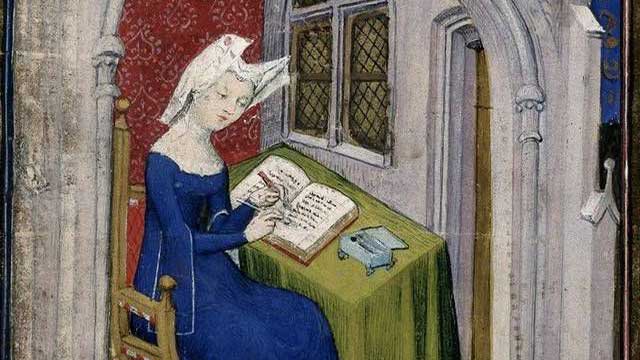
-
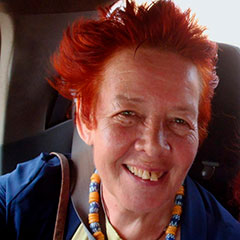 Bea Lundt
Bea LundtThe picture of Christine de Pizan and our knowledge about her life show that this is not true. Christine de Pizan (1364 – c. 1429), born as Cristina da Pizzano in Venice, was a poet and author at the court of King Charles VI of France. Christine produced a large number of vernacular works, in both prose and verse. Her works include political treatises, mirrors for princes, epistles, and poetry.
This very famous miniature is an illustration from a book, handwritten in the years between 1410 and 1414 and preserved at the British Library in London (Harley MS 4431, Vol. 1, fol. 4 r). This manuscript contains texts by Christine de Pizan and is called The Book of the Queen, as it had been produced on behalf of and dedicated to Isabeau of Bavaria, wife of King Charles VI of France. There is another miniature showing Christine on her knees dedicating the book to the French queen. Christine can be identified by her facial features and style of dress.

Detail of: Master of the Cité des Dames and workshop, 1413 - 1414, parchment, 36,5 cm x 28,5 cm, British Library, London. © British Library, London. Photo: the author
In the centre of the aforementioned picture, a woman is shown sitting at a table and writing into a voluminous book. With her left hand, she is erasing coloured letters with a knife and with her right hand correcting them. This dynamic gesture of self-correcting fills her working situation with life. On her head is a headdress typical for a widow, the guimpe/wimple. Around the desk, we see some fictive architecture with a broad symbolic meaning: it shows a room which is specifically tailored to an intellectual working woman but also opens to the outside, as there are windows, an arch, and entryways. The roof of another storey marks the building as a town house. Though the scene is an interior one, the colours on the woman are bright, and there are warm red colours around her. This is different from older pictures showing clerical female authors in the narrow, closed rooms of a cloister.
‘Je, Christine’: An independent author defining her role in society
The picture shows a professional female author in an urban context in the process of writing a book and working for the public, where she is honoured as being part of the highest level of society. There are similar pictures with Christine sitting behind her desk with an open book and people coming and arguing with her in a lively manner. In one, a young man, who has been identified as her son, stands in front of her and speaks to her. Another one shows four men visiting her in her room and discussing her writings with her. Sitting Christine, standing men: the arrangement shows that the guests will leave soon. Such encounters are also atypical for a cloister, which is said to be the usual space for educated women.
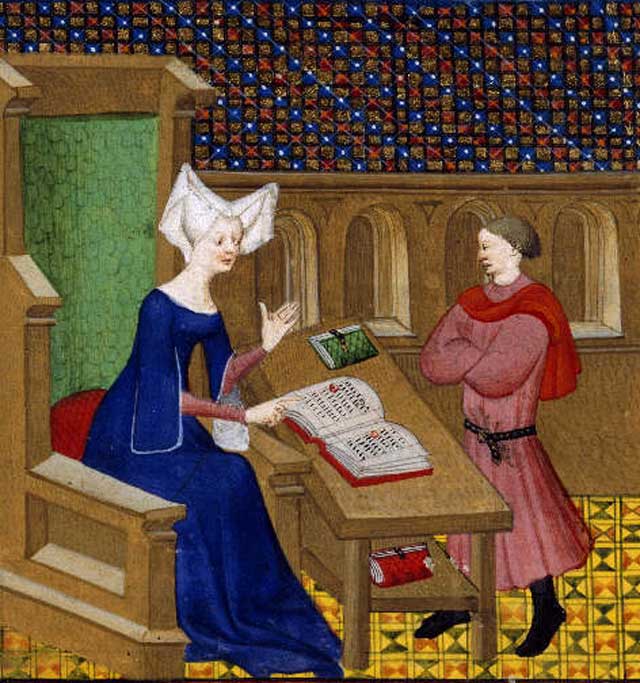
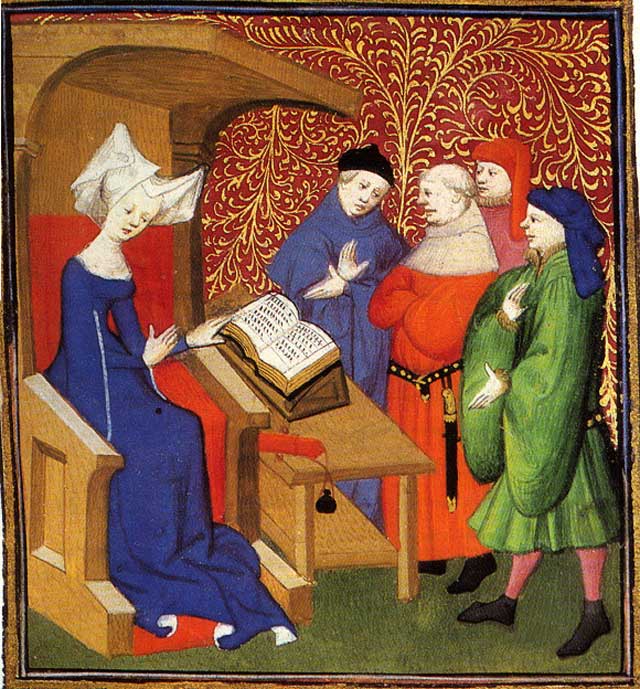
Detail of: Master of the Cité des Dames and workshop, 1413 - 1414, parchment, 36,5 cm x 28,5 cm, British Library, London. © British Library, London. Photo: the author
As experts see it, it was Christine herself who ordered the illustrator to characterise her in this manner. Several autobiographical comments of hers document that she liked to show herself living this individualist intellectual lifestyle. Traditional scholars call this typical for the Renaissance, which began a bit after Christine’s lifetime. Very often in her books we find ‘Je, Christine’ (‘I, Christine’), at the beginning of a chapter.
Christine’s life story
Christine was born in Venice in 1364 as the daughter of a doctor of medicine and astrology. He was called to the French court in Paris. Christine married a royal secretary and had three children. But then her father, her husband, and the king who had supported the family died. Christine was 25 years old and had to care not only for her children but also for her old mother and younger relatives living with her. She decided not to marry again but to support her living by writing. Her oeuvre contains poems alongside utopian, philosophical, historian, didactical, allegorical, and autobiographical texts. Noble families ordered her books and paid her well. In her old age, she escaped from the civil war in Paris to a cloister nearby where she died around 1429.
The first secular female author in Europe
With her Italian-French background, Christine is an example for the migration of intellectuals in southern Europe in the late Middle Ages and early Renaissance. She was not herself noble but came from an academic family and remained near the court. She was privately educated, mostly by her father, and also educated herself using the offer of the erudition centre in France. Living within a totally Christian cosmos with a spiritual way of thinking, she was not a clerical but rather a secular woman. In her books, she fought for gender equality, especially in education, as well as for recognizing the extraordinary performances of women in the past and in her own time. She wanted this knowledge to be part of a new understanding of history. She sharply protested against texts which reduce women to sex objects. With her pugnacious notes, she provoked the first literary quarrel about femininity and masculinity in Europe, the ‘Querelle des Femmes’.
The masculinisation of literacy and education in the modern era
In premodern Europe, competencies in literacy were considered more or less ‘feminine’. Girls learned to read at least the Bible to their families; noblewomen were taught languages and literature to be able to marry into different countries. The ideal for masculinity was fighting strength; sitting with books seemed to be viewed as non-masculine. Many kings and noblemen were illiterate. This changed in modern times. Literacy became part of the public world and school education developed as a privilege of men.
In the colonial period, Europeans attempted to impose this central European order on the African colonies: women were relegated to the private sphere, while men had the privilege of acting in public, which was more valued. The colonisers argued these gender roles were anthropologically fixed constancies, and they had the civilising mission of transferring this pattern to their colonies. But African scholars insist that in precolonial times, polar structures of different worlds for men and women did not exist, exactly as they had not in premodern Europe.
Conclusion: Confirming non-dualistic, fluid gender concepts
As we still need to fight against the discrimination of women and girls in educational systems worldwide, the message of the picture might be encouraging. This visual icon helps to deconstruct a common myth about Europe and to reject static ideas about continuities of bipolar gender structures. Even in the European Middle Ages, independent female authors were shown, combining inside and outside worlds. To see that it was different in history motivates us to see the hybridity of gender structures on both continents, which do not merely follow the dualistic scheme of men working in public professions and women working as housewives.
References:
- Christine de Pizan: Le Livre de la Cité des Dames. Stock 1986 (French).
- Christine de Pizan: The Book of the City of Ladies (Penguin Classics) rev. 2000 (English).
- Christine de Pizan: Das Buch von der Stadt der Frauen. Originally in Middle French. Translated and with commentary and an introduction by Margarete Zimmermann, Orlanda Buchverlag Berlin 1986, dtv 1999 (German).
- Roberta L. Krueger: Towards Feminism: Christine de Pizan, Female Advocacy, and Women’s Textual Communities in the Late Middle Ages and Beyond. In: Judith M. Bennett, Ruth Mazo Karras (eds.): The Oxford Handbook of Women and Gender in Medieval Europe. Oxford University Press 2016, pp. 590-606.
- Henry Kam Kah: The Sacred Forest. Gender and Matriliny in the Laimbwe History (Cameroon), c. 1750-2001. Berlin 2015.
- Oyewumi, Oyeronké: Colonizing Bodies and Minds. Gender and Colonialism. In: ibid (ed.): Invention of Women. Making an African Sense of Western Gender Discourses. Minneapolis, MN 1997, pp. 121-156.
Edited by Kelly Thompson.
published August 2020
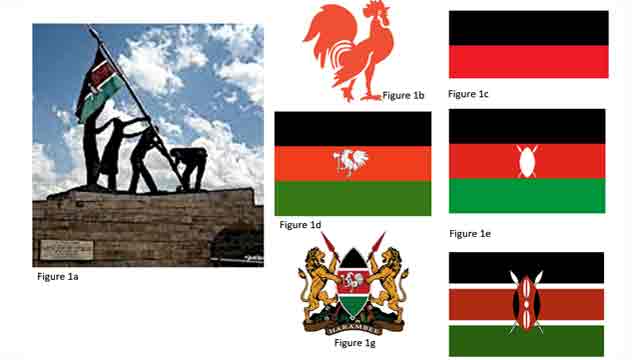
-
 Donna Pido
Donna PidoKenya’s Independence monument resides at Uhuru Gardens in Nairobi (Figure 1a), most likely because this is where received Independence (Kiarie 2022). Though only a few people visit Uhuru Gardens and get to see the monument, it reminds us of 12 December 1963, the day of Independence and when Kenya Army soldiers first raised the national flag on Mt Kenya. Mau-Mau and other guerilla soldiers see hoisting the flag as a visual symbol of military victory over King’s African Rifles and their British collaborators though some felt it is the same collaborators who inherited power from the British (Branch 2007). In this context, Independence is remembered as a military defeat of the British sense of military invincibility. However, a political class comprised of ‘under-educated’ intelligentsia saw Independence as an intellectual contest and a defeat of so-called colonial arrogance. Rural dwellers, on the other hand, seemed spectators with the view that Independence was coming ready with ‘owners’ (politicians, businessmen and educated elite). That Independence has owners who enjoy it while rural remain on the sideline is evident the persistent poverty thriving in rural Kenya (Njeru 2018). So, even Uhuru Gardens and the Independence Monument have ‘owners’ who are not rural dwellers; it is clear that the monument is the collective memory and visual culture of its ‘owners’.
It seems the majority of rural dwellers understood Independence according to what politicians said- wealth as the accumulation of money, health as getting treatment in hospitals, education as attending school and passing examinations (Kenya African National Union 1969). We are not sure they are able to read and understand the Independence monument at Uhuru Gardens. Why KANU did not install the rooster at Uhuru Gardens draws considerable curiosity. That is beyond our scope here. One with a thick African cultural knowledge could easily choose the image of a rooster instead of that of hoisting the national flag because KANU was a nation-wide party and the rooster has cultural meanings nationwide. Among the Luos of Western, establishing new homesteads entailed carrying an axe and rooster to the site of the first house; this ideology is well-represented in the KANU flag (figure 1d). In other parts of Kenya, the rooster is a symbol of manhood required to make many children (Wikipedia. 2022). By crowing early in the morning, the rooster does not simply announce time but also sets the work-eat-rest rhythm of life in rural areas.
Before discussing WWII monument and of pre-Independence flags, we want to briefly address meanings in choices of colors and other elements in party flags and the national flag. The black, red and green stripes in KAU, KANU and the national flag have the same meanings. The black stood for the indigenous population, red for the common blood of all humanity or blood shed during the struggle for Independence. Green symbolized the nation’s fertile land or landscape of the country, while the weapons were a reminder that organized struggle was the basis for future self-government (Smith 2001). No doubt the shield and spear are common traditional Kenya tools of offence and defense. It is said that white represented unity and peace. It is rather clear that a section of Kenya’s coat of arms is modeled on KANU’s flag- colors and the rooster carrying an axe. Meanings herein are similar to those we mentioned in our discussion on KANU’s flag; the shield and spears also bear the same meanings as we mentioned when discussing the national flag.
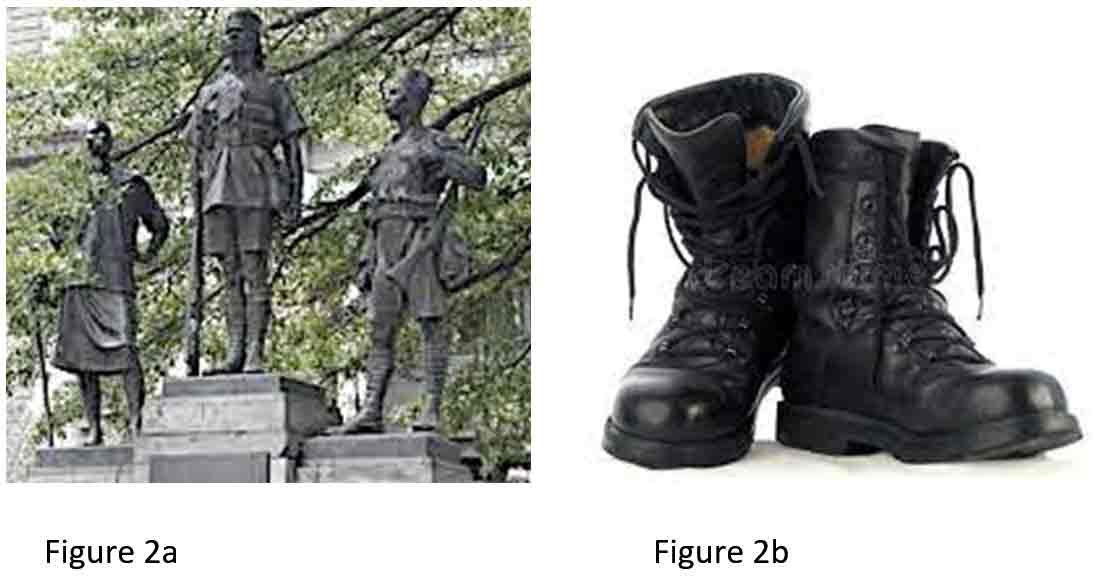
The combat boots (Figure 2b, Internet sources) tend to strike a note that is closer to the Acholi collective memory of WWII because they refer to it as too bin (Acholi for ‘come ye death’). Among the Acholis of Northern Uganda, the combat boots symbolize the massive death in the War and the sacrifice of people forced to be loyal to the King of England. There is quite a stark contrast between the intended collective memory and the actual one. At least among the Acholi, the boots are infinitely more meaningful that the bronze images so hapless servant/soldiers.
Many of us in Kenya may not be able to remember the pre-Independence flags presented here because they were in use a long time ago. Between Indonesians, Indians and Arabs, we are not sure on who first visited Kenya. However, Arabs came in greater numbers over a longer period, intermarried with the local population and eventually set a government with the Sultan of Oman as its emperor or king. We included the flag of the Sultan of Zanzibar (3a, Internet sources) as a part of the visual culture of Kenya. The flag does not fly anymore but Arab dhows and their sails are prominent visual feature at the coast of Kenya. History has it that the Portuguese followed and displaced the Arabs and built Fort Jesus- we included Portuguese flag (3b, Internet sources) of that time since we consider it a part of the visual culture of Kenya at that time. Apart from Fort Jesus in Mombasa and the Vasco da Gama monument in Malindi, there seems no outstanding visual feature that rigorously reminds us of the Portuguese.
We turn now to the World War II monument standing on Kenyatta Avenue, Nairobi (Figure 2a, Internet sources). Our action was driven by the thought that the monument is also a reminder of how Africans were roped into a war they did not start, meaning, they did not have any special interest in the war. While the British saw this monument as honoring the regional war dead, we remember our own who died in North Africa, Burma or elsewhere as WWII raged. In any case it would have served us Kenyans more meaningfully if the monument had represented Kings African Rifles in action instead of as the transport company that was its main function. The figures of this monument are just standing as if posing for a photograph.
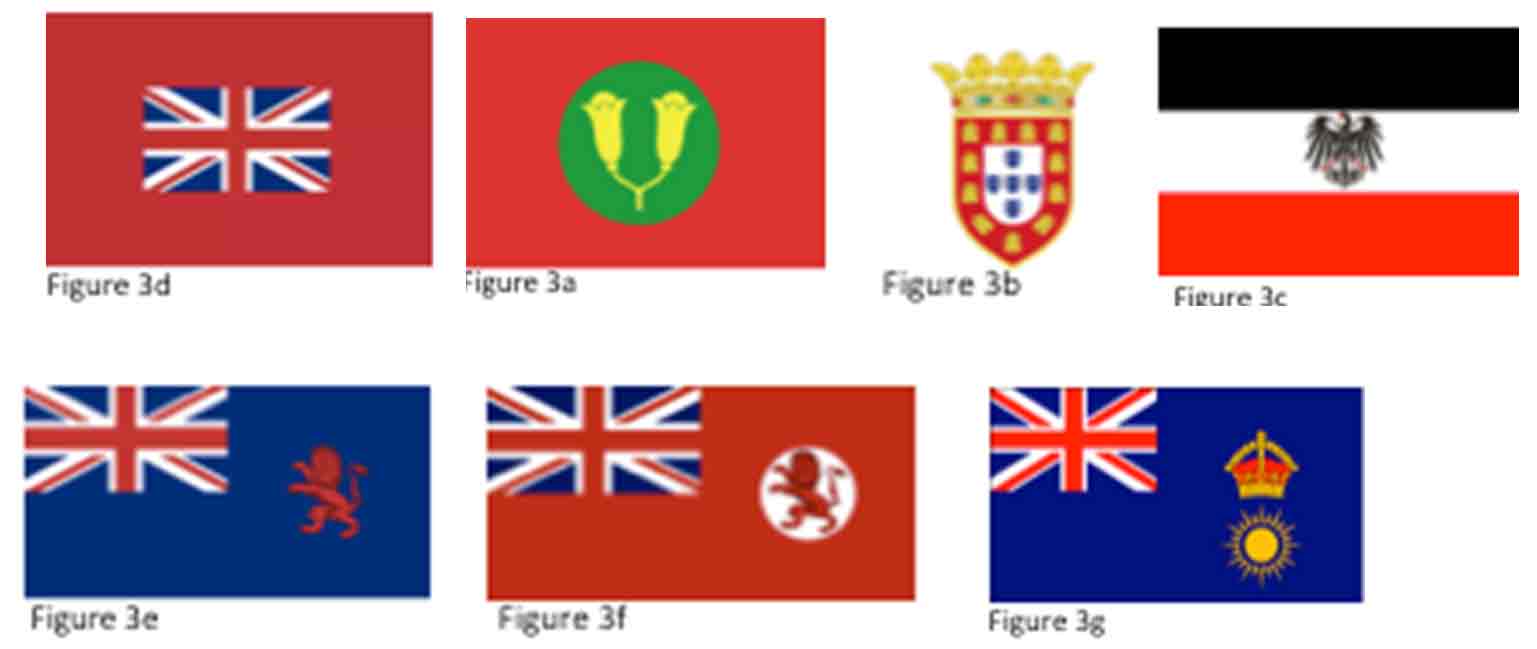
The eagerness related to the partitioning of Africa and the establishing of colonies saw the Germans come to Kenya and German East Africa (Tanganyika) where the German flag flew (Figure 3c). Heller, the German coin is the most outstanding collective memory of German East Africa; old folk still refers to coins as heller (hela, eeera, Figure 4a and 4b, Internet sources). Though rupee was more popular as an Indian coin, it was also used in German East Africa and its name was integrated into many languages that still use it to mean ‘money' (Figure 4c, Internet sources).
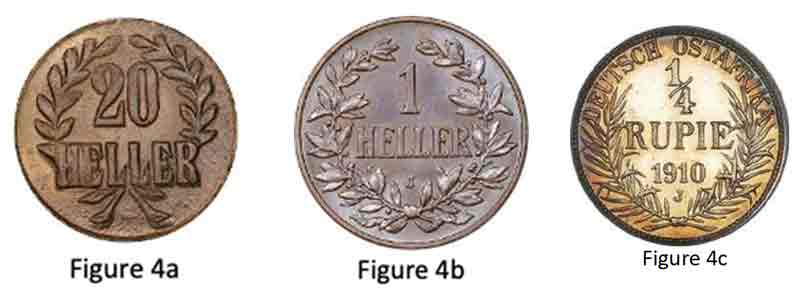
Some people think that if Germany had won World War I (WWI), East Africa would have been a German colony. But that was not to be; various parts of East Africa were under Brisstish rule until Independence in the early 1960s. The Witu flag (Figure 3d) was hoisted soon after the British drove Germans out of East Africa, this was followed by the British East Africa flag (Figure 3g, Internet sources) and flags (Figures 3e and 3f, Internet sources) were used in Kenya colony, specifically. The Union Jack was prominent in flags for British East and Africa and Kenya Colony. British influence is massive in Kenya and related visual culture is so massive that it deserves more attention that is possible here. Meanwhile we note that the structure of Kenya’s coat of arms is similar to emblems and related devices that were in use when Kenya was a colony.
Summary of Discussions
We embarked on writing this article hoping to add to on-going efforts in exploring collective memory in Africa. Our short article touched on political collective memory including but not limited to past and existing monuments, flags, coat of arms and emblems. It is difficult but possible to argue that pre-Independence devices form a part of Kenya’s visual culture; we argue thus for believe that the past makes today as the present makes tomorrow. Heller, the German coin of colonial Kenya, provides one example of how past visual culture persists through time to be a part of the present and does so with little cultural transformation.
In this article, monuments, flags, emblems, coats of arms and coins provided fodder for discussions. It seems the Independence monument is a Government object that only officers of Government and the intelligentsia communicate with and use it to remember Independence and WWI. Kenyans who paid the price of WWI and Independence have yet to enjoy whatever benefits may accrue from the two. The once very powerful KANU that received Independence from Great Britain is now a pale shadow of the political party it was. However, its rooster remains a visually powerful emblem that speaks of time, space, majestic manhood and connection with the universe.
We do not know why KANU’s rooster is dwarfed in the coat of arms and is absent in the national flag. The absence or minimizing of such a powerful symbol can raise questions. For example, is it a part of continued colonization that thrives on suffocating local expressions? Or was it a matter dictated by non-Kenyan concepts of design? These questions need addressing soon and with more concerted efforts.
References cited
- Branch Daniel 2007: The Enemy Within: Loyalists and the War Against Mau-Mau in Kenya, in Journal of African History, Volume 48, Issue 2, July 2007, Cambridge University Press
- Kenya African National Union 1969: The K.A.N.U Manifesto, University of Virginia
- Kiarie Maina 2022: http://www.enzimuseum.org/museums-of-kenya/monuments/uhuru-gardens
- Njeru Timothy Njagi 2018: What is Driving Persistent Poverty in Rural Kenya, in: The Conversation https://theconversation.com/whats-driving-persistent-poverty-in-rural-kenya-99765
- Smith Whitney 2001: https://www.britannica.com/contributor/Whitney-Smith/4445
- Wikipedia 2022 Cultural References to Chickens: https://en.wikipedia.org/wiki/Cultural_references_to_chickens
- Woods Steven Paul, Weinborn Michael, Ryan Yangi Li, Hodgson Erica, Amanda R.J. Ng, Bucks Romola S. 2015 Does Prospective Memory Influence Quality of Life in Community-Dwelling Older Adults? in: Neuropsychol Dev Cogn B Aging Neuropsychol Cogn https://www.ncbi.nlm.nih.gov/pmc/articles/PMC4537668/
For further reading: Lydia Waithira Muthuma. How Public are Public Statues? (Public statues in Nairobi)
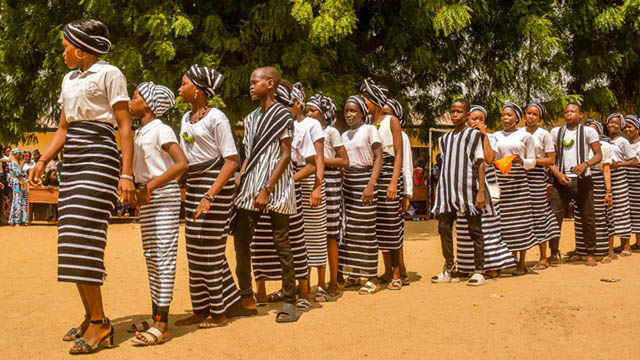
-
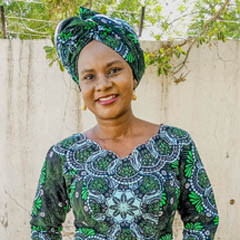 Karimatu Dauda
Karimatu DaudaMany of the group of pupils that were trained on Bura culture and Bansuwe dance in Ruby Springfield College are from this ethnic group, Bura. However, a good number of these pupils did not have prior experience of the Bansuwe dance. Consequently, the facilitator who taught them the dance relied on videos of Bansuwe dance and songs, played through a computer and a portable speaker, to teach them the dance steps from the scratch. This was accompanied by direct demonstrations and direction by the facilitator. Although the facilitator is not a specialised dance teacher, she is from the Bura ethnic group and a skilled Bansuwe dancer who had been performing for many years.
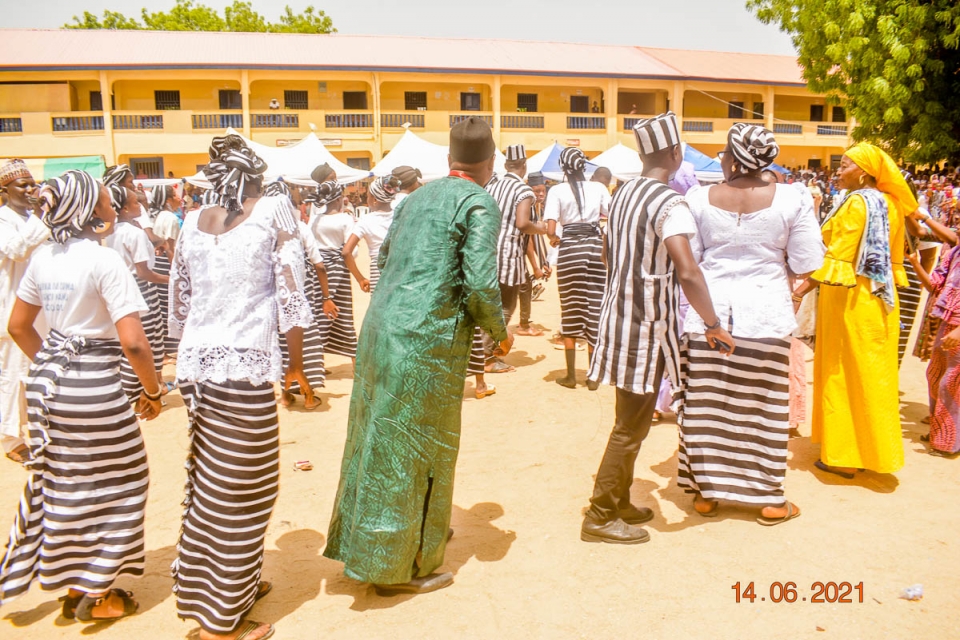
The lady in yellow was a parent of one of the dancers who came to cheer the dancers. The person in green is the principal of the school who also came to cheer the dancers. Cheering of dancers and throwing some money at them is a common practice in Nigeria. It is meant to both encourage and show appreciation to the dancers. (Photo: Karimatu Dauda)
Bansuwe dance is popular among the Bura and is usually the preferred cultural dance at weddings, funerals and other important ceremonies. Yet, the experience in this school shows that there are a good number of Bura people whose children do not know the Bansuwe dance. Part of the reasons for this is that some of the children have never been taken to their villages where cultural practices are better sustained. The Boko Haram conflict in the region also discourages social gatherings which are often potential soft targets of insurgents.
The cultural day events usually involve the presence and participation of pupils’ parents and other guests which makes it a good channel for the sustainability of culture. More girls ended up performing in the dance because many of the boys were unable to pass the final screening for the cultural day. The dancers were dressed in traditional Bura attire called Japta. The audience cheered the dancers and at intervals some would join the dance briefly. This dance was accompanied by traditional Bura music made by drums, xylophone, flutes and vocals.
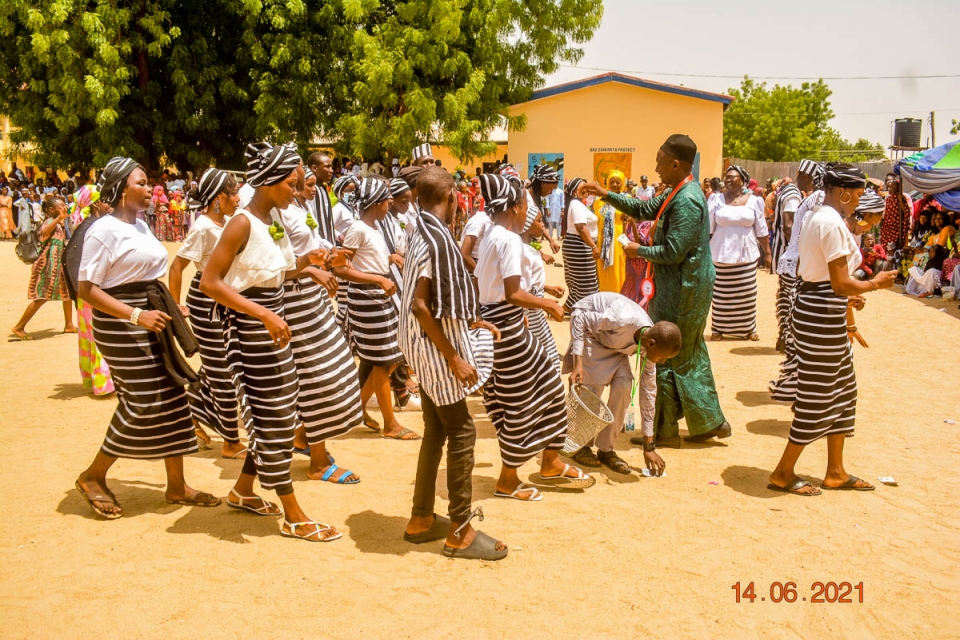
The boy with the basket was picking the money thrown to the dancers by the audience in appreciation of their performance. (Photo: Karimatu Dauda)
The pupils, especially those from Bura, could easily learn more about the Bansuwe dance from their parents and relatives at home. Since dance often carries specific meanings within the social settings it is situated (Pusnik, 2010), there will not be a shortage of what to converse about concerning the Bansuwe dance. Traditional dance in Nigeria is used as a channel for communicating social values, sensitization and even carrying out social sanctions. In addition to these, Bansuwe dance is also used to convey merriment during ceremonies and sadness during funerals and each is reflected by the tone, tempo and messages of the music chosen.
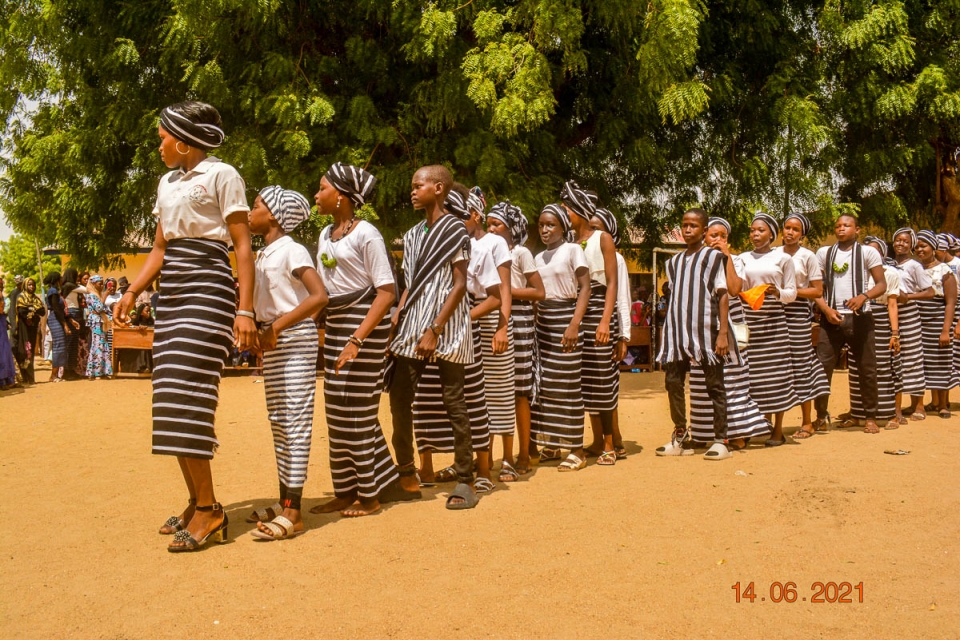
Bansuwe Dance (Photo: Karimatu Dauda)
In the case of the cultural day of Ruby Springfield College, the dance was clearly conveying merriment and the central message of the song was that people should come together as friends and brothers. This message was according to the central purpose of the cultural day which was to encourage mutual cultural understanding among the pupils of the school.
The excitement accompanying the performance of Bansuwe dance by the pupils of Ruby Springfield College is a testimony to the fact that it left a lasting impression on them. This is because, for some pupils, it represented the first time they witnessed and participated in the Bansuwe dance. This enthusiasm by pupils, and even by some parents, is behind the determination by the school to sustain the practice of the cultural day annually. This in turn will ensure that Bansuwe dance is sustained, as younger generations get to learn and participate in it every year at school.
While the annual cultural day cannot be compared to dance subjects formally being taught in the classroom, it is no doubt a contribution to arts education albeit as an extra-curricular activity. It serves as the next best thing in the absence of a dedicated dance subject in the curriculum of schools. In addition, it will be an important space for the sustainability of Bansuwe dance possibly for many generations to come. It is important to sustain this dance because it is one of the few remaining cultural activities which brings together people of all ages, gender, and social status to interact equally on an informal basis. Such a gathering would provide a good space for the conversations on cultural sustainability.
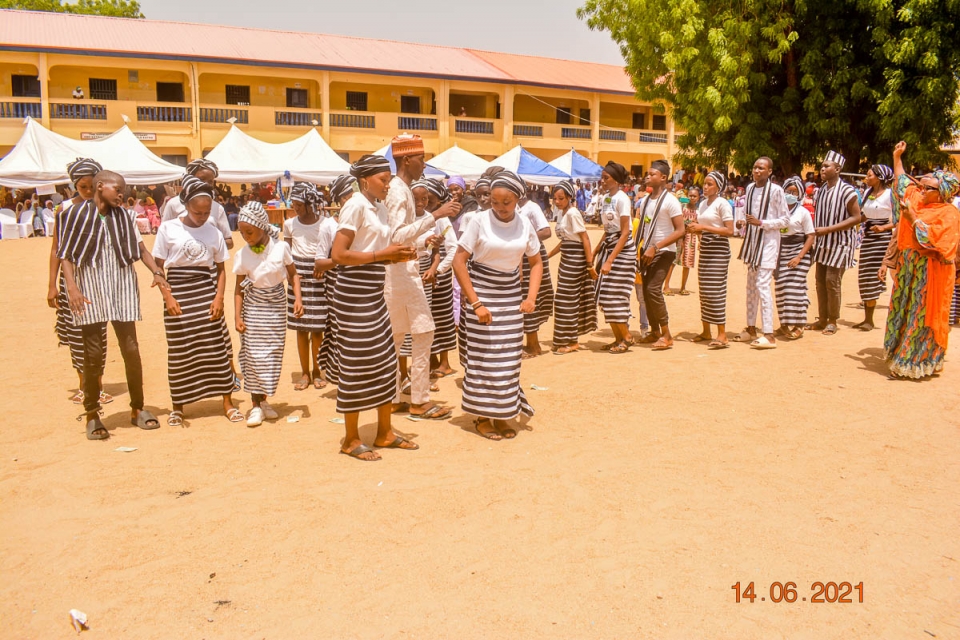
Bansuwe Dance (Photo: Karimatu Dauda)
Arts education is part of the curriculum of primary, secondary and tertiary academic institutions in Nigeria. This does not mean, however, that the teaching of arts is done in every school in the country. The situation is further compounded by the fact that schools offering arts education are often selective about the arts subject they teach. In most schools, fine arts or creative arts make up the totality of their arts education subjects. While their creative arts subject includes lessons in music, dance and theatre, there are also dedicated music and theatre subjects in schools.
In contrast, dance is hardly, if ever, exclusively taught as a subject in formal education settings. Like in many other countries, dance is not taught with the same frequency and depth as painting, theatre or music (Mosko, 2018). Even if there were a dedicated subject for dance education in the country, the hundreds of ethnic groups in Nigeria would make the choice of what dance to teach in formal education settings quite challenging. This is because a typical classroom is made up of learners from diverse cultural and ethnic backgrounds. Generally, arts education in the country is facing a number of challenges, as identified by Enamhe (2013), including the discouragement of children from taking arts subjects by parents, the fear of the perceived difficulty of the creative aspects is arts subjects, and the high cost of materials needed for arts education both for learners and academic institutions.
References
- Enamhe, B. B. (2013). The role of arts education in nigeria. African Journal of Teacher Education, 3(1), 1-7.
- Mosko, S. (2018). Stepping sustainably: The potential partnership between dance and sustainable development. Consilience: The Journal of Sustainable Development, 20(1), 62-87.
- Mtaku, C. Y. (2020). Continuity and change: The significance of the tsinza (xylophone) among the bura of northeast Nigeria. Center for World Music – Studies in Music, Universitätsverlag Hildesheim.
- Pusnik, M. (2010). Introduction: Dance as social life and cultural practice. Anthropological Notebook, 16(3), 5-10.

-
 Kerstin Pinther
Kerstin PintherAs a miniature, the sculpture Indépendence Tchao (2014) by the Franco-Algerian artist Kader Attia refers to the Hôtel de l'Indépendence in Dakar, Senegal. At the beginning of the1970s – a little over ten years after the independence of the west African country under Lépold Sédar Senghor and a few years after the first Festial Mondial des arts nègres (1966), the hotel was built by Henri Chomette and Roland Depret. Since the end of the 1940s and into the 1980s, the office of the French architects had built governemental and private buildings and others in numerous African countries. Indépendence Tchao was initially created as a site-specific installation on the occasion of the 11th Dakar Bienniale in Senegal. It refers back to the hotel high-rise with the sculpture; the ‘borrowing’ can immediately be recognized, above all by its characteristic brise-soleil façade. Kader Attia used discarded and somewhat rusty inex index boxes, stacked on top of each other. The inventory of the archive itself came from a dissolved administration in Algeria. Only a few kilometres away from the central exhibition venue of Dak'Art, the hotel still forms a striking, decidedly 'modern' architectural antithesis to the flat neo-classical colonial administrative buildings - an aesthetic incunabulum that symbolized the future in its outstanding verticality and modern furnishings. However, the former architectural icon is now empty and in a state of decay. Indépendence Tchao (the title is a reference to the famous song Independence Cha-cha from 1960/Kalle) thus refers both to a utopia that has grown fragile, the bursting of a dream; as well as to the persistence of colonial archiving and (also structural) standardization practices, to old and new (architect) networks in the postcolony.

Attia, Kadar. Pascale, Fernand Pouillon, Alger. 2012
https://inferno-magazine.com/2012/06/23/kader-attia-le-corps-utopique/ [Stand: 28.10.24]
Two further - this time photographic - works by the same artist also address the ambivalences and potentials of modern architectural promises: In the case of the photograph of a woman, seen from behind, surrounded by the mighty arcades of the 200-column courtyard, the connection between the body as the 'first architecture' and the 'built' architecture is central. Not least through the title Pascale, Fernand Pouillon, Alger (2012), it becomes apparent that the person is a transsexual. According to Attia in an interview, the strangeness in one's own body corresponds to the 'architectural' alienation that the inhabitants of the 'Climat de France' who had resettled from the Kasbah in Algier must have felt in the 1950s; the necessity of appropriation, re-territorialisation or even 'becoming at home' applies to both bodies (the human and the architectural).
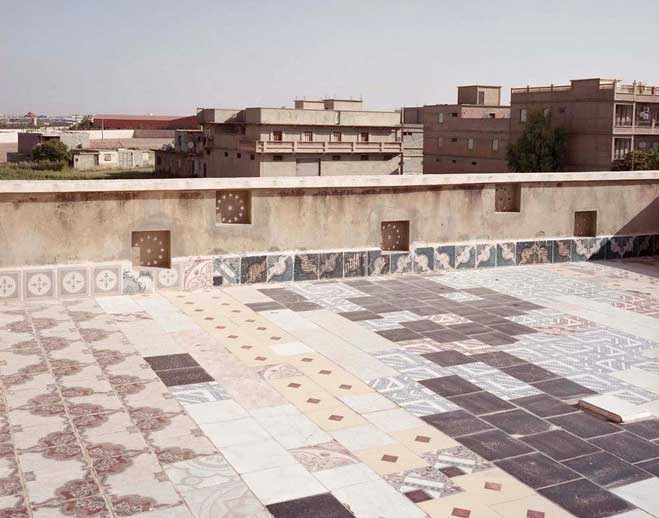
Attia, Kadar. Déconstruir - Reinventer. 2012
https://slash-paris.com/en/evenements/construire-deconstruire-reconstruire-le-corps-utopique/sous/3669 [Stand: 28.10.24]
A reflection on transgression and imagination also lies at the centre of another photo: Déconstruir - Reinventer (2012) actually shows only the results of a minimal intervention in the standardized construction method, and yet these traces of spatial action are marked here as meaningful in the sense of aesthetic place-making.
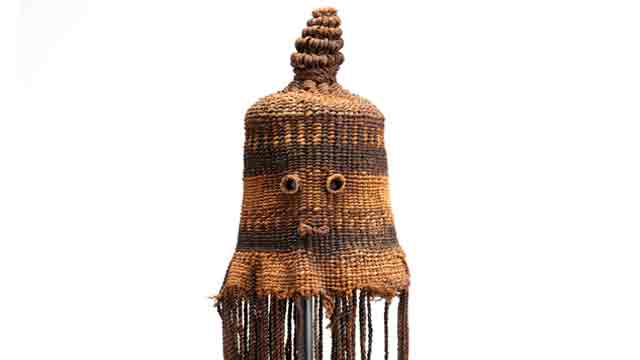
-
 Njeri Gachihi
Njeri GachihiMeaning
Ingolole serves several purposes in the circumcision ritual. It serves to mystify the ritual and more so the initiate. While wearing almost identical masks, the initiates become undisguisable in this full seclusion regalia. It is believed that even evil spirit sent would have a problem identifying the target and hence revert to sender. On the other hand, the masks also serve to wade off and scare women and children who are not supposed to interact with them during the seclusion. Even when they go out of the forest and make processions on major roads singing and dancing, the women and children should stay away. Part of the chants, dance and singing done is meant to break loose ‘childhood/boyhood’ which is symbolized by the breaking of the crown - palm reeds attached on the ingolole. Some do manage to break it which is a sign of physical strength and masculinity as well as spiritual and ritual wellbeing.
The dance that the initiates perform is know as bukhulu/bakhulu which means elder. Bukhulu henceforth, cosmologically viewed, means unity with the ancestors and is also used to symbolize fertility or the life-giving seed (seminal fluid). The effort of breaking the reed henceforth translates into becoming an adult and gaining all the permission to undertake the adult roles and the responsibilities associated with it. This means that this right gives the initiate the ability and power to engage in full conjugal and social responsibility. Last but not least, the initiates spend a lot of time in the open. Ingolole then serves to protect them from the scorching rays of the sun, protect them from sweating too much when dancing and at night serves to protect them from biting cold, wild animals and insects.
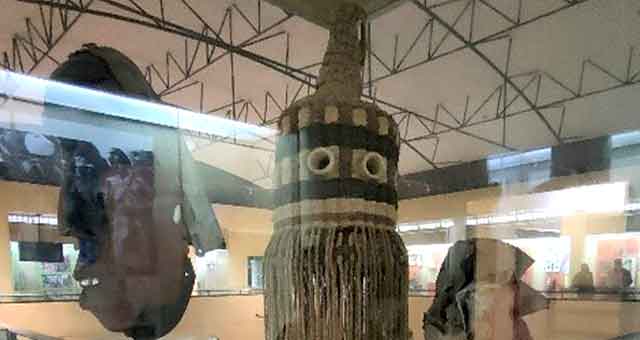 Cutout: Presentation at Nairobi National Museum, Ingolole (Circumcision Mask), Museum Fünf Kontinente and Nairobi National Museum. Photo: Njeri Gachihi.
Cutout: Presentation at Nairobi National Museum, Ingolole (Circumcision Mask), Museum Fünf Kontinente and Nairobi National Museum. Photo: Njeri Gachihi.Is Ingolole an Artwork or a Ritual Object?
The ingolole as a form of ritual art, seems to bear witness to the resilience of the Tiriki culture; what Bakhtin might have called the 'carnivalization of the social order'. A central reason for using this mask, it seems, is to affirm the Africanization of the arena, both public and private, where a culturally appropriate image reigns. The mask usually invests the wearer with signs of power over evil, while modelling him on the norms of masculinity and respectability. The ingolole is one item of art that is yet to be transformed from artefact to curio (or momento). This is apparently so because its mechanism of distinction is yet to mobilize political as well as economic categories. This mask resonates well with the notion that visual art communicates cultural values. It is a complex ideological communication that derives its symbolism and references from culture. Yet it also draws its form and content from the fundamental tenets of the magical appropriation of power through the manipulation of depiction and elucidation.
Therefore, the Tiriki Circumcision mask, Ingolole is not only an artistic representation. It is a ritualistic object that embodies several meanings. It is known to invest the wearer with signs of power over evil - in that the wearer is set apart from his enemies that would intend to inflict harm. It is believed that the evil spirits sent to cause harm on the initiate would find it difficult to positively identify the initiate. At the same time, it causes mystery around the initiates making their looks terrifying and hence keeping off those who are not permitted to come near newly initiates. Physically, it protects the young boys from scorching sun, biting cold and insects while in seclusion. Once ingolole is used, it is kept and passed on from generation to generation. A used one is still valuable to the family and must be kept safely to avoid causing harm to the members of the family. Hence, this is an item of art that cannot be easily transformed from a ritualistic artefact to a simple curio craft.
There are not many Ingolole’s in our Museum in Nairobi. Two are however exhibited in the permanent exhibition, Cycles of life, at the Nairobi National Museum.
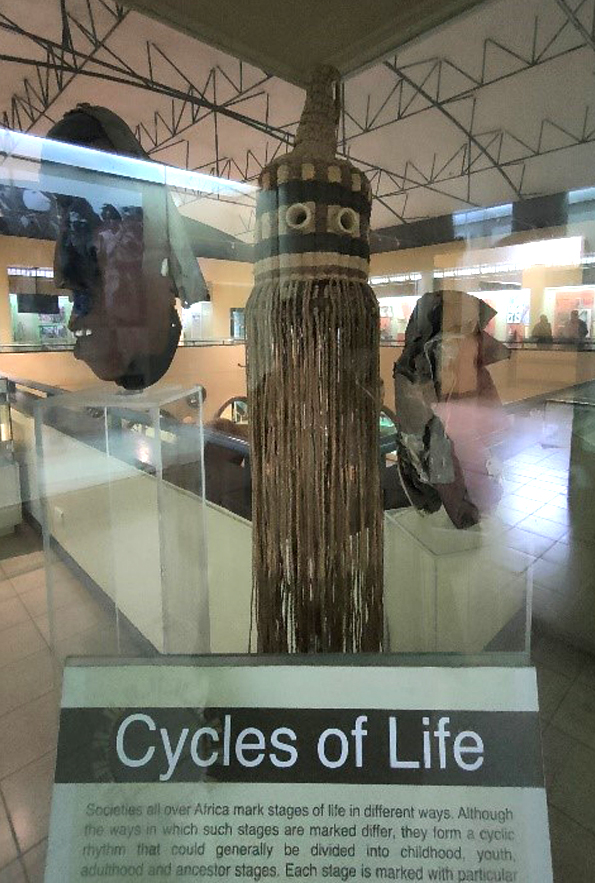 Presentation at Nairobi National Museum, Ingolole (Circumcision Mask), Museum Fünf Kontinente and Nairobi National Museum. Photo: Njeri Gachihi.
Presentation at Nairobi National Museum, Ingolole (Circumcision Mask), Museum Fünf Kontinente and Nairobi National Museum. Photo: Njeri Gachihi.

-
 Rosa Pfluger
Rosa PflugerThe Eiffel Tower in Paris, the Sydney Opera House, the Empire State Building in New York – it is not uncommon for innovative and striking buildings to become symbols of the cities they were built in. Architectural landmarks turn into trademarks of their cities. They shape the city’s silhouette and make it recognizeable.
In Munich, a big city in the South of Germany and provincial capital of Bavaria, one of the most striking buildings is the Frauenkirche, which loosely translates to “Church of Our Lady”. It is dedicated to Virgin Mary, the Mother of Jesus Christ, who plays a big role in Munich as she is said to be the patroness of Bavaria. Its 99 meter (324 ft) high twin towers with the characteristic cupola roofs rise high over the inner city (as it is still prohibited to build any higher than them within the inner city). It is - by all means - not the biggest or even most beautiful church of its kind. Neither is its location in the city center, on plane ground and narrowly surrounded by pubs, shops and historic residential houses, spectacular.
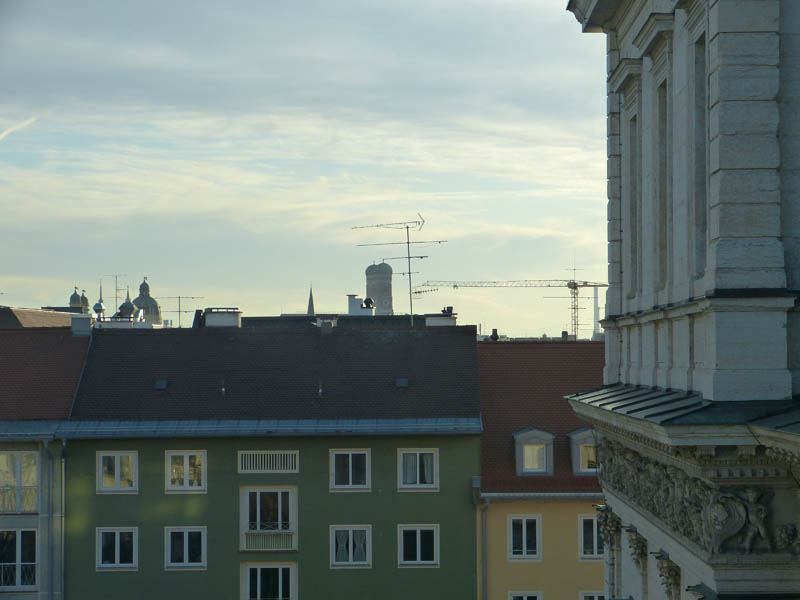 Up to this day, the Frauenkirche is the tallest building in Munich's inner city. View from the Academy of Fine Arts, Munich ©the author
Up to this day, the Frauenkirche is the tallest building in Munich's inner city. View from the Academy of Fine Arts, Munich ©the authorStill: The citizens of Munich have great sympathy with the brick building and identify strongly with it. There are several reasons for that: First of all, about 30% of the people living in Munich identify as roman catholic Christians and therefore have a religious connection to the 500-year-old church that is still in use for almost daily services. But the number of Catholics decreased drastically since 1925, when more than 80% identified as Catholic. In conclusion, there must be other reasons why this church is so important for Munich.
A people’s church
What makes this church indeed quite unique is the way it came to be: Munich didn’t lack any churches at all. In 1468, when the construction of the Frauenkirche was started, only 13,000 people resided there and there already was (and still is) a cathedral in the city center: Saint Peter’s church, or simply: Alter Peter (Old Peter). The Frauenkirche was enormously large compared to the city’s size and can house 20,000 standing people. It was built within only 20 years, which is faster than any other church in Europe at that time. The construction was probably initiated by the citizens – and can therefore be seen as a sign of confidence and emancipation of the common people in regard to the ruling class. (Which makes it all the more tragic that the towers were abused early on as platforms for cannons during the Landshuter Erbfolgekrieg at the beginning of 16th century, a war between two aristocratic families contending for heritage.) As a side note, Germany’s supposedly very first photography, taken in 1839, shows the twin towers of the Munich church.
Muslim towers on a German church?
The two cupola roofs made of oxidized copper give the cathedral its unique and unmistakeable shape. Originally, it was meant to be topped by gothic pinnacles (comparable to those of the cathedral in Cologne, Germany). But at the beginning of 16th century, architectural (and overall artistic) style changed drastically with the advent of the Italian renaissance. Pointed church spires suddenly seemed old-fashioned. And so, for more than 30 years, the two towers of the Frauenkirche remained “headless”.

Bernhard von Breydenbach, Peregrinatio in terram sanctam, 1486, woodcut (Creative Commons); The Temple area, 1920, Library of Congress; Blick auf die Türme der Frauenkirche vom Odeonsplatz aus. 2017, D. Fuchsberger (Creative Commons)
Lukas Rottaler, who was assigned with the construction of the roofs, was long thought to be inspired by Venetian churches, precisely the cathedral Madonna dell’Orto. Indeed, the 14th century Italian church has a high brick tower with a cupola roof that might look a little like the Frauenkirche, if you turn a blind eye. But the origins of the onion-like shape are assumed to reach way back and way farther: Rottaler probably saw a woodcut of Jerusalem, which shows the Dome of the Rock. This dome, erected in the 7th century and therefore the oldest edifice of the Islamic world, marks a place that is equally important for Muslims, Christians and Jews – the dome itself though is Muslim. That didn’t keep Rottaler from taking inspiration from the Dome of the Rock for his building project at a Catholic church in Munich. Hence, the Frauenkirche is shaped by originally “oriental” roof tops.
Moreover, many churches in the rural outskirts of Munich, which were built in the following centuries, are oftentimes crowned by bulbous cupola roofs. This drop shape, which contrasts the villages’ common saddle roofs, now naturally is a part of the landscape as well as of the baroque style.
The devil, a Munich sense of humor, kitsch, tourism and modern lifestyle
One more reason why the Frauenkirche is so important for the Munich identity are the many legends surrounding it, which are an inherent part of many children's upbringings. The story of the bet between the devil and the constructor of the church, master bricklayer Jörg Ganghofer is widely known among Munich citizens. Ganghofer bet his soul that in this church there would be no windows. As soon as the church was complete, the devil entered the back of the church through the main portal and looked around. Indeed – there were no windows visible! Of course, the church has big windows which let an even stream of light enter the gigantic room. Ganghofer skillfully placed the massive pillars framing the middle section of the nave so that they cover all windows from a certain point of view – and thus won the bet! The devil was outraged and stomped his foot on the ground. This footprint is still visible in floor tiles (image below). In his temper, lucifer left in a rush, which caused a chilly gust of wind that up to this day blows around the church.
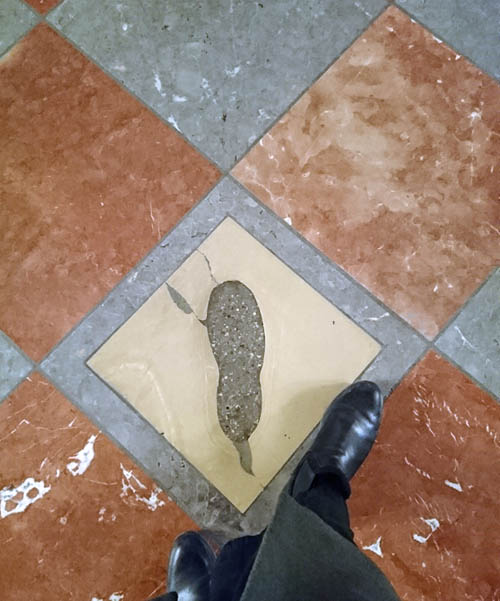
The "Devil's footprint" ©the author
There are many more legends like these surrounding the historical center of Munich. The fact that they are not forgotten but very much part of social life shows how much the people of Munich value their ancient traditions and customs. Also, these legends – and the legend about Jörg Ganghofer is a prime example for that – often showcase a certain sense of humor, mischievousness and boldness. Possibly typically Munich qualities.
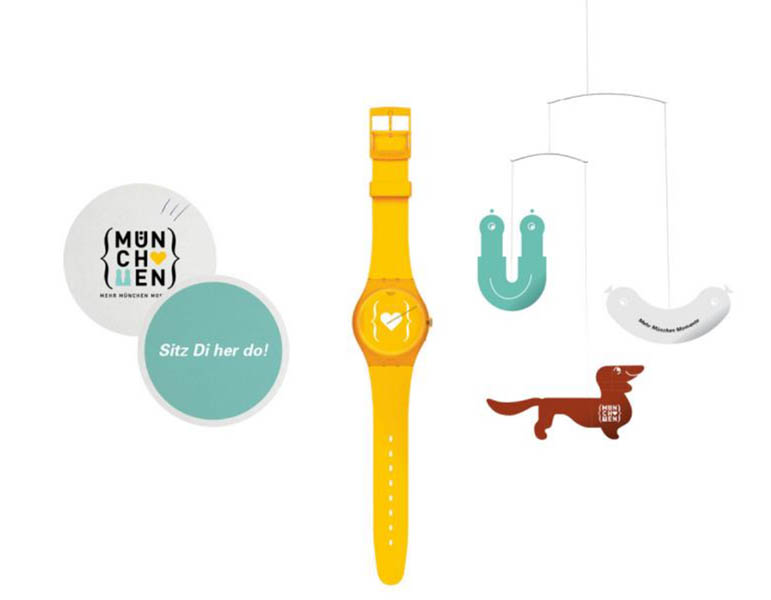
The unique twin towers as logo: A design for a Munich tourism agency ©Georg Schatz, schatzdesign.de
Today corporate logos, kitschy souvenirs but also everyday products reference the Frauenkirche’s silhouette. The Munich tourism agency „München Tourismus“ markets the city with the slogan “simply Munich”: approachable, hospitable, relaxed. It’s all about “Genusskultur, Kulturgenuss”, which translates to „culture of enjoyment, enjoyment of culture”. According to the agency, tranquility, love for old things and the so called “Bavarian cosiness” are trademarks of the Munich way of life. Compared to the daringness of Lukas Rottaler and Jörg Ganghofer, the constructors of Munich’s biggest cathedral, these qualities seem rather tame.
References:
- Forschungsgruppe Weltanschauungen in Deutschland: „München: Religionszugehörigkeiten 1925-2018“, https://fowid.de/meldung/muenchen-religionszugehoerigkeiten-1925-2018
- E. Wagner, S. Wimmer, L. Sedghi: Isar-Arabesken – Spuren des Orients in München, München (Alitera), 2013
- https://stadtfuehrung.info/stadtfuehrungen/zeitreise_muenchen_anhand_alter_fotos_und_bilder
- https://www.muenchen.travel/artikel/ueber-uns/die-marke-muenchen
- https://www.historisches-lexikon-bayerns.de/Lexikon/Frauenkirche,_M%C3%BCnchen#Der_Neubau_im_15._Jahrhundert
- https://www.venediginformationen.eu/kirchen/kirchen-in-venedig-teil-3/madonna-dellorto/madonna-dellorto.htm
- https://de.wikipedia.org/wiki/Tempelberg#Islamische_Bebauung:_al-Masdschid_al-Aqsa
- https://de.wikipedia.org/wiki/Frauenkirche_(M%C3%BCnchen)#Bau_der_sp%C3%A4tgotischen_Kirche
published November 2020
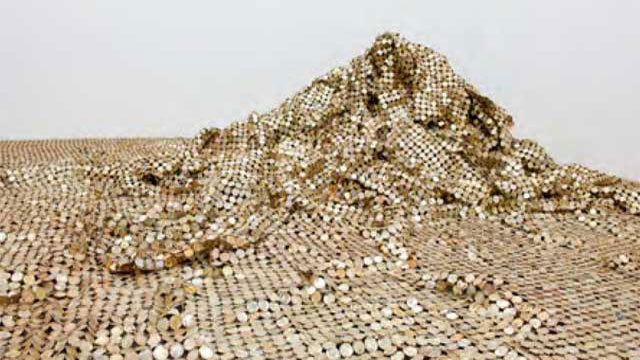
-
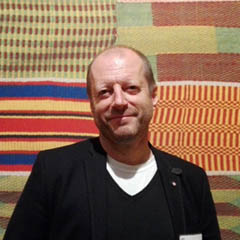 Stefan Eisenhofer
Stefan EisenhoferThe philosophy of borrowing materials and tools, as well as visual motifs, from the local environment goes back to his student days at Kwame Nkrumah University of Science and Technology in Kumasi in the late 1960s. It was the creative efforts of local artisans there that inspired him to become interested in the philosophy of "Natural Synthesis" from 1975 onwards at the University of Nigeria, Nsukka, where he is now Professor of Sculpture. This manifesto of the so-called "Zaria Rebels", whose members included Uche Okeke, at that time also a lecturer in Nsukka, postulated that local traditions should be interpreted using modern materials and techniques. This idea was to have a lasting influence on El Anatsui.
A striking example of its expression in his work is the metal "tapestries" he has made since the late 1990s, which are actually sculptures rather than wall hangings. They consist of thousands of aluminium bottle caps discarded by Nigerian distilleries. Sorted by colour and prepared by El Anatsui's many assistants, they are stitched together with copper wire into "tapestries" several square metres in size. The tiny pieces of aluminium are arranged in patterns that evoke the narrow-band kente textiles made by Asante and Ewe weavers. However, this classical form of West African cloth is subjected by El Anatsui to a radical transformation in these works, which undermine the idea of metal as a rigid material. He transforms into something pliable and almost sensuous. Closely linked to this is the concept of a "nomadic aesthetic" involving fluidity of ideas, impermanence of form and indeterminacy. For El Anatsui this especially includes encouraging and even forcing the curators of his exhibitions to hang his works in accordance with their own ideas. He himself sees his wall hangings as physically unfixed and insists that there is no final and mandatory way of hanging them.
In addition, El Anatsui creates connections with the aesthetic, political and economic roles of textiles – as an important component of global trade and consumer history, and as a significant vehicle for the transfer of ideas and creative ingenuity across cultures. Furthermore, he refers repeatedly to the function of kente cloths as a way of memorializing something, for they are often linked to events, people and historical or current issues: "You can memorialize a lot of things in cloth instead of having a statue in bronze," says El Anatsui and takes this up not only by naming some of his works after kente cloths, but also through the fact that the bottle tops he uses to create his "cloths" come from brands of liquor with names that refer to historical events.
El Anatsui's wall hangings directly continue his idea of creating "transformations" of regional West African phenomena, and experimenting with materials that are important in the local cultural context. His artistic career began with wooden food trays from local markets which he decorated with burned or carved versions of adinkra symbols. The next phase was characterized by a series of broken and partially mended clay pots which served as a reflection on the current political situation in many African countries, and at the same time as an optimistic reference to the fact that clay pots are repairable and new uses can always be found for them: "When a pot breaks it's not the end of its useful life," says El Anatsui. Even breakage can lead to something new.
In the 1980s he again turned to wood as a material, and discovered the chainsaw as a particularly suitable instrument for working African hardwoods. The chainsaw became for him a metaphor of the long history of violence to which the cultural traditions of Africa were, and still are, exposed. "Each process has its own peculiarities or language. [The chainsaw´s] language [is] of violence, of tearing, of clawing, of dividing," says El Anatsui.
In the abstract wood sculptures of this phase the seed is already sown for something that runs through his work to this day: aesthetic comments on globalization and consumer culture, on the wastage of goods – and human lives. It is this aspect that has led to the great popularity of some of his works, for instance "Visa Queue" (1992), and in particular "Akua´s Surviving Children" (1996), which was made in Denmark while he was grappling with the theme of the slave trade. The stylized human figures made of driftwood show the damaging effects of water, wind and weather, the chosen material in itself a symbol of unprotected exposure: "The wood having (like the slaves) been torn from its land source and exposed to the hostile elements of water and wind."
Linking aesthetic creations with political and economic issues is also a characteristic of those works in which he takes up the world's growing ecological challenges. This applies to his "Peak Project", created in 1999, which consists of numerous freestanding "peaks" made from thousands of glittering milk tin lids. Once again, the unfixed nature of the work is a prominent feature, the "peaks" taking on a different shape at each exhibition site. The open-endedness of his works can be seen in "Coal Pot", a work exhibited in the sculpture garden of the University of Kentucky Art Museum. It consists of a 15-feet iron cauldron filled with large pieces of Kentucky coal. In the course of time, the coal will disappear, gradually changing the appearance of the sculpture.
El Anatsui has always been concerned with West African traditions facing the Global North under conditions of modernity, and in his special way he strives to give them new life and meanings that are of relevance today.

-
 Mahmoud Malik Saako
Mahmoud Malik SaakoThe Koma figurines did not only enrich the stock of African artwork but evoke the minds of a great culture represented or embedded greatly in these art pieces. These figurines have been classified into anthropomorphic (the use of human features), and zoomorphic (the use of animal features), based on the stylistic representation while some are both anthropomorphic and zoomorphic (they possess both human and animal features). They are some of the anthropomorphic figurines that have one head and two faces or one body with multiple heads while some have a head with a conical shape. Those anthropomorphic coned figurines are the most common types and are consisting of a head with a long conical neck or body.
The Koma figurines could be equated to those of Nok and Ife (in Nigeria), Sao (around Lake Chad), the Akan funerary clay figures (in southern Ghana), and the Jenne and Bankoni clay figurines of the Inland Niger Delta (in Mali). Beyond their artistic significance and historical products, the Koma figurines have generated some interest among intellectuals in and outside Ghana including antique dealers.
Before the scientific investigations commenced in the 1980s and 2006 onwards, the communities within this geographical area known as "Komaland" were encountering or recovering these terracotta figurines when they were digging for soil to build their homes. The people then referred to them as kronkronballi which literary means "children from an old-time". These figurines are either found in house or burial mounds within the area. The culture of the current inhabitants of the area where these figurines are found do revere their ancestors, and any disturbance of the ancestral graves or the removal of any burial goods either intentionally or accidentally must be expiated by sacrifices, and all the grave goods are reburied at the same place. Since the people are far remote from the creators or ancestors of these figurines, many of the damaged ones were either thrown away while a significant number of them were taken home and given to children as toys.
Moreover, art dealers in Ghana and West Africa recognized the commercial value of these Koma figurines long before the scientific investigations by the first anthropologists, archaeologists, and historians. These Koma figurines were, therefore, sold at the various art markets in northern Ghana (in Bolgatanga at the craft village) and southern Ghana (in Kumasi and Accra art centers) to foreign tourists. It is through this medium that Koma figurines have found their way into many European and Western museums.
Furthermore, scientific excavations in the 1980s and the subsequent excavations in 2006 onward by a team of archaeologists in Ghana and abroad, have attracted the attention of the world through conferences and publications. The Koma figurines were initially appreciated based on their aesthetic values but the subsequent archaeological excavations subjected them to more rigorous scientific analysis and historical classification such as social, cultural, political, and environmental. The scientific excavations have also to some extent put a stop to the numerous lootings of the sites that were hitherto very rampant.
The archaeological investigations in recent times and based on radiocarbon analysis from pieces of charcoal dated the site between the 6th and 14th centuries AD. But further investigations are still ongoing to identify the authors or creators of this supposed complex civilization in northern Ghana though, parallel has been made to the Lobi in Ghana and Burkina Faso.
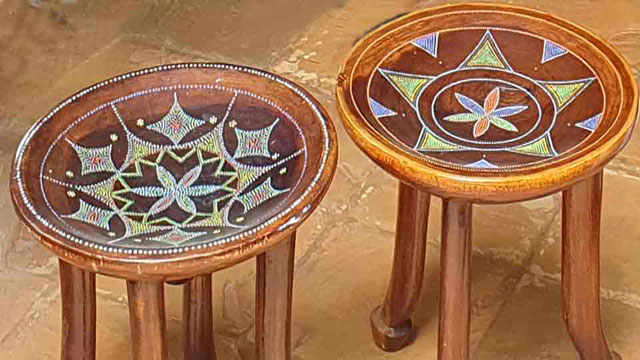
-
 Mary Claire Kidenda
Mary Claire KidendaKenya is extraordinarily rich in creativity, materials, and ideas sources of inspiration reflected in their artefacts which has evolved to its current prosperous state over the centuries. The Kenyan culture can be seen in the visual arts, applied arts, food, music, dance, sports, fashion, literature, and theatre. The artefacts are an extraordinary source of inspiration and nourishment for the artist. Their designs embody African design aesthetics that have retained traditional designs as they also reflect elements of innovation, hybridity, sustainability and modernity (Maina et al., 2017). The artefacts reflect religious beliefs and cultural values – two inseparable elements enmeshed in Kenyan craft. The Kenyan traditional art is fundamentally functional, meeting some specific utilitarian purposes, whereas its aesthetic consideration is typically regarded as having some secondary significance. Art was integrated into everyday aspects of life from formal ceremonies and religious rites to daily household tasks. The arfetacts were produced by skilled experienced crafts persons who were found in the societies. Art is an expression of a particular community or culture through the employment of local materials and craftsmanship.
The Jua Kali manufacturing subsector is the predominant creator of craft products in Kenya (Maina et al., 2017). Jua Kali is a self-organising community of practice producing goods. It is comprised of artisans running micro and small enterprises that are not fully integrated into the mainstream formal economy. The artisans learn skills through traditional apprenticeship (TA). Apprenticeship training is regarded as a critical contributor to skills supply, fostering economic development in Kenya. It involves the transmission of the tacit rather than the explicit knowledge and is the most tangible exhibition of the intangible cultural heritage. It facilitates the transmission of skills from a custodian of knowledge, the Master Craftsman. It combines ethnic design and aesthetics and contemporary styling in craft production in Kenya. Involves the transmission of the tacit rather than the explicit knowledge through observation, imitation and reputation. Besides, apprenticeship ensures that the knowledge and skills that relate to the craft are passed down to future generation so that they continue to be produced within their communities. The learning of the Kenyan design, aesthetics is therefore, an intergenerational phenomenon.
Kenya's ethnic groups can be divided into three broad linguistic groups Bantu, Nilotic and Cushite. The Nilotic tribes in Kenya include Luo, Kalenjin, Maasai and Turkana (Hino et al., 2019). The Nilotic speakers migrated from Sudan and Egypt. They are traditionally pastoralists and fishermen and reside in Kenya's vast Rift-Valley region and around Lake Victoria (Madut, 2020). Each of these communities has its traditions, customs, and practices, imbued with multiple layers of culture, colonial legacies, and migration that add to the rich Kenyan cultures (Deisser & Njuguna, 2016) . The distinctness and confluence of these cultures have served as artistic inspiration for many a cultural product creatively fashioned out of raw materials primarily sourced from the natural environment.
The Luo or Lwoo (also called Joluo, singular Jaluo) are an amalgamated agro-fishery and Nilotic Dholuo ethnolinguistic groups in Africa that inhabit an area ranging from South Sudan and Ethiopia, through northern Uganda and eastern Congo (DRC) (Ojwang, 2021; Prince & Geissler, 2008), into western Kenya, and the Mara Region of Tanzania west Kenya, eastern Uganda, and in Mara Region in northern Tanzania. The name Luo or Low means "God's life-bearing exhalation.' The past economic activities of the Luo included fishing and cattle farming (Ndeda, 2019). Agriculture, especially that which involves staple crops such as maize and beans (Ojwang, 2021). Nilotic communities such as Turkana and Pokot (ekicholong) and even Bantus such as Kamba (mumo ya muthamia) and Taita (kifumbi) in Kenya have traditional stools that have been used for various cultural and functional purposes (Somjee, 1993).
This paper discusses the Luo Traditional Three-Legged Stool called “Kom Nyaluo” in the Luo tribe (Hoehler-Fatton, 1996). My interest in this stool arose because I am a Luo lady married to a Luo man who owns the stool.

Kidenda, “Domestic Exhibition of Kom Nyaluo to EVC Expert Panel Discussing the Versions of the Traditional Stool”, Wood and Beads, 2022 Karen, Nairobi
The circular top of Kom Nyaluo symbolises the round universe and a miniature universe on which the husband reins in a home. It is a sign of prestige and leadership, reflecting the status or power of men or the husband within society and a reflection of the round traditional Luo huts. Its legs embody male masculinity and virility (Biko, 2010). Only the father was qualified to sit on the seat as he had requisite authority and was the owner of all the women he brought forth life with. He would sit on it when addressing issues; women and children would sit on the ground.
The traditional Kom Nyaluo was small, with a height of about 30cm from the ground and decorated with beads (Hoehler-Fatton, 1996). Each elder had their stool, and women and children were forbidden from sitting on it. Kom Nyaluo is associated with the authority the elders wielded and the respect that they were accorded in their homes and society. The stool design reflected the traditional activities of men and women. The men worked and socialised outside the home, and the women mostly worked inside and around the house and garden (shamba). A married young man with a few children applies for an eldership position in a ceremony where he hosts community elders. He would be dressed in traditional regalia, carry a spear and fly whisk. The elders would sit him on Kom Nyaluo and crown him as an elder.
Most traditional Luo homes were polygamous, and the stool played a significant role in controlling the wife, which enjoyed marital favours and childbearing. The husband or man of the house would send the stool to the woman's hut. He would want to spend the night in her hut. The stool would be sent secretly, and early the following day, the man would sneak back into his hut so that the other wives would not know whom he slept with. This brilliantly averted obvious petty jealousy will arise from a polygamous home. If one wife felt that she didn't have the stool in her house often enough, she would ask the first wife to intervene on her behalf. "If the first wife didn't like her, she would ensure her complaints did not reach their husband. The seat symbolised love and joy and sustained life in a traditional Luo homestead. Literally and figuratively, of course. Kom Nyaluo did not only represent the authority of the man but also love and joy and sustained life in the traditional Luo home (Biko, 2010).
Kom Nyaluo was used during the levirate ceremony or "tero", where a widow was remarried to a relative of their deceased husband. The levirate union is consummated by sexual intercourse on the first night. If the widow invited the elders for a drink the day after the night of "ter", it was a sign that the night had been successful. During the drinking session, there was the enthronement ceremony of the new head of the home onto the stool of the deceased, "Kom wuon dala" (seat of the homeowner). With the enthronement, it was as if the dead man was alive again (Lutta, 2015). After marrying and having a few children, a Luo man applies for elderhood by hosting the elders at a party where he will be crowned and dressed in traditional regalia. Signs and symbols of authority that include a spear fly whisk and a three-legged stool are given to the elder.
Production Process
In this case study, the Kom Nyaluo is produced by an artisan from Siaya County Jua Kali Association craftsman. He learned his father's craft skills through traditional apprenticeship and made his products on demand. The Luo traditional stools are carved with logs from ober (mvule tree), ngo'wo (fig tree), duwa (oak tree) and the member (mango tree). The logs are chopped by a power saw and dried for one week. These are hardwood types that are strong, durable and water-resistant. They also feature unique colours and grain patterns that create a stunning display. Oak is light yellowish-brown and generally straight-grained; it is also hard and durable. Mvule wood comes from the African teak, known in Nigeria as the iroko tree; it is challenging, dense, and durable. Fig tree wood sometimes contains latex, which can be toxic or an allergen. Since the fig trees seldom grow straight, their boards tend to be shorter. However, the wood is soft and not very strong. Mango wood is relatively easy to work with; it is easier to shape, plane and sand while still strong and durable. It is also friendly to waxing and staining, making it excellent for furniture or other household objects.
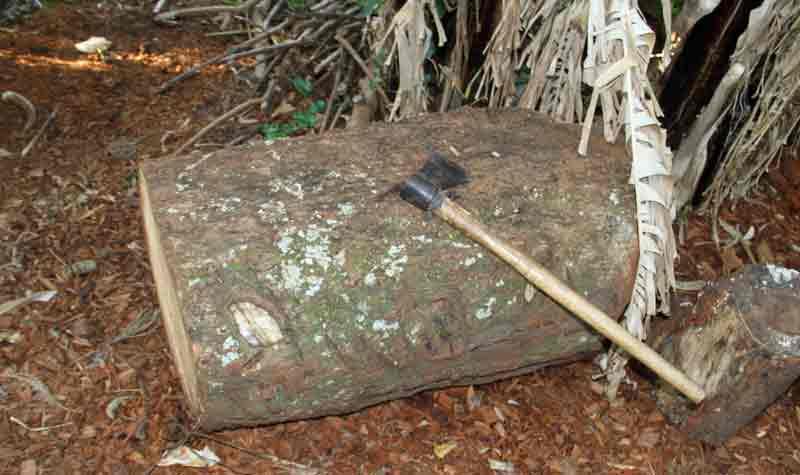
Kidenda, “Wood Logs used for curving out Kom Nyaluo”, 2013, Siaya, Kenya
Each log costs the artisan ten thousand Kenya shillings (Ksh. 10,000), equivalent to sixty-seven (67) euros. The stool is carved from a single block of wood, the wood between stem and roots, which has twisted grains that are more durable and cannot break or crack. The stool is made without using joints or nails. The seat takes the shape of a log. The carver uses Koyo (adze) to fashion Kom Nyaluo from the log, which does not require nails or joints.
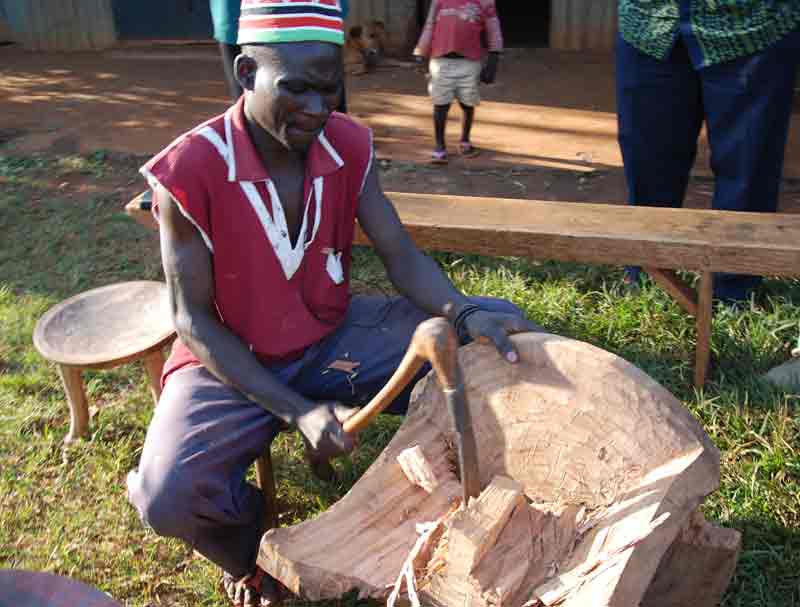
Kidenda, “Curving out the Kom Nyaluo from a log”, 2013, Siaya, Kenya (photo by Mary Clare Kidenda)
Its top takes the circular shape of the log, and after carving, it is smoothened with a furr (metal scrapper for smoothing wood).
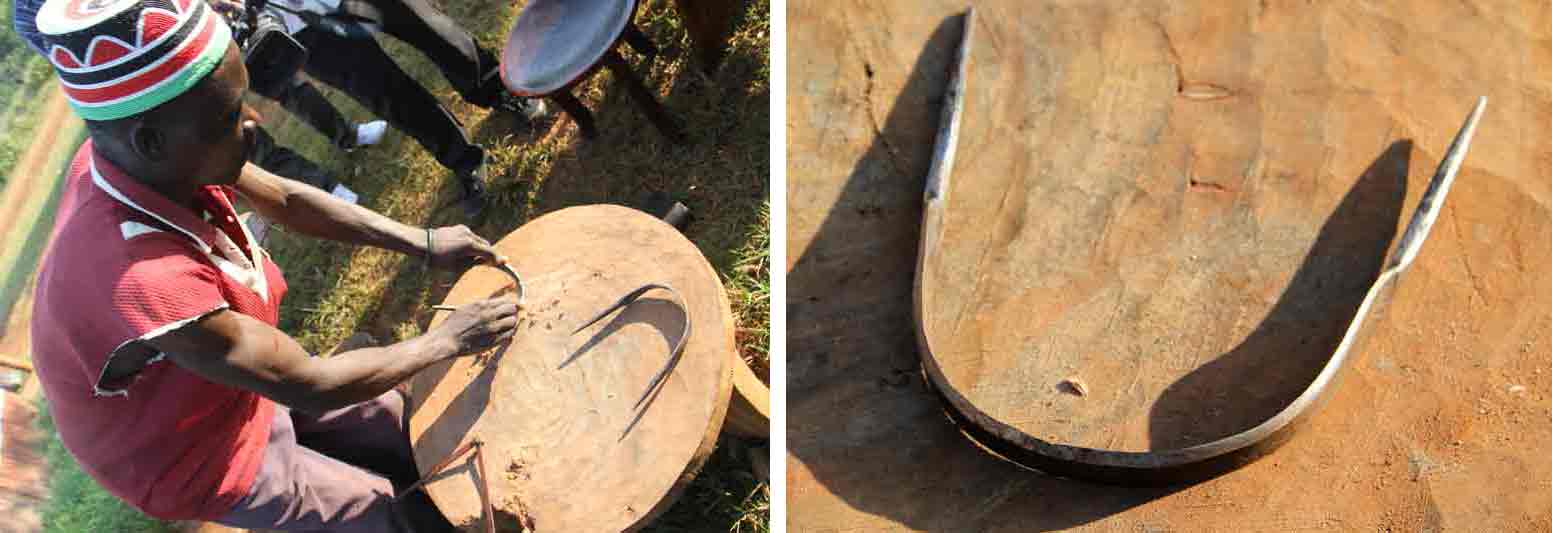
Smoothening the Circular Top Using Furr, 2013, Siaya, Kenya; Furr, the handmade metal tool used to smoothen the top of Kom Nyaluo, 2013, Siaya, Kenya (photos by Mary Clare Kidenda)
They are then sandpapered and vanished using paintbrushes.

Sandpapered and vanished sets of Kom Nyaluo, 2013, Siaya, Kenya (photo by Mary Clare Kidenda)
A compass is used for drawing geometrical patterns on the top of the stool.
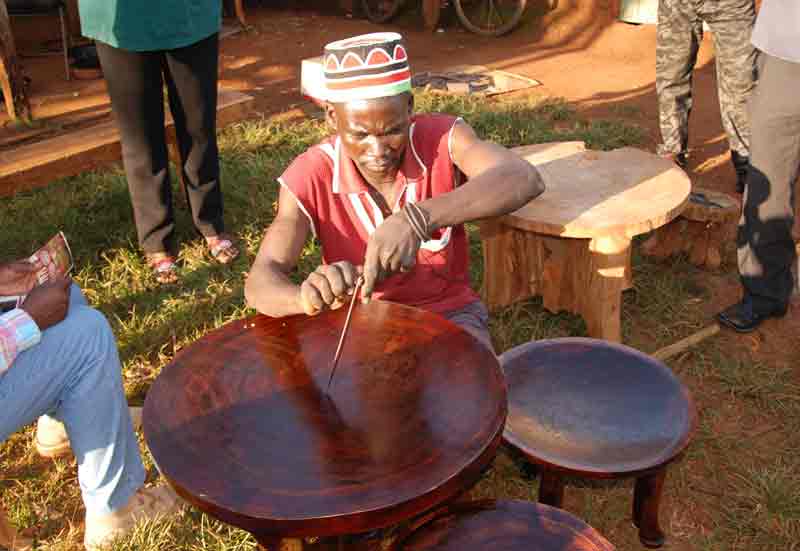
The drawing of geometrical patterns using a compass, 2013, Siaya, Kenya (photo by Mary Clare Kidenda)
Supposedly the design is inspired by a parquet floor in a European-style house owned by Tom Mboya. The wire inlay practised by the Kamba may also have been a model. Thereafter, wood, glass beads, metal, and colourful Maasai beads are banged onto the top, providing intricate decorative artwork.
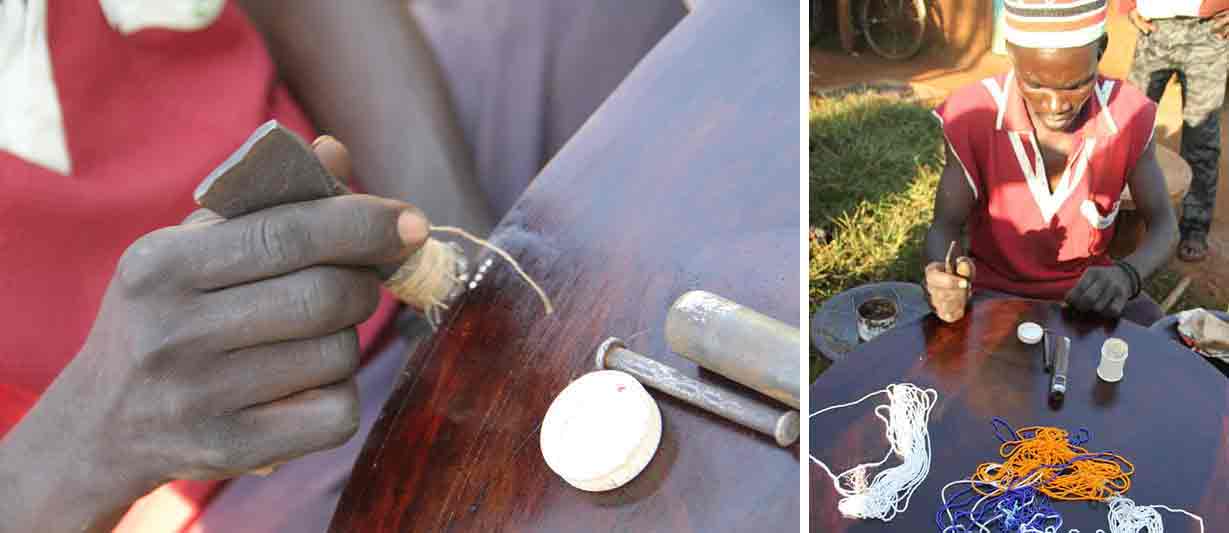
The inserting/banging of beads into the top of Kom Nyaluo, 2013, Siaya, Kenya (photo by Mary Clare Kidenda)
Finished: A Luo Dignitary Stool “Kom Nyaluo”
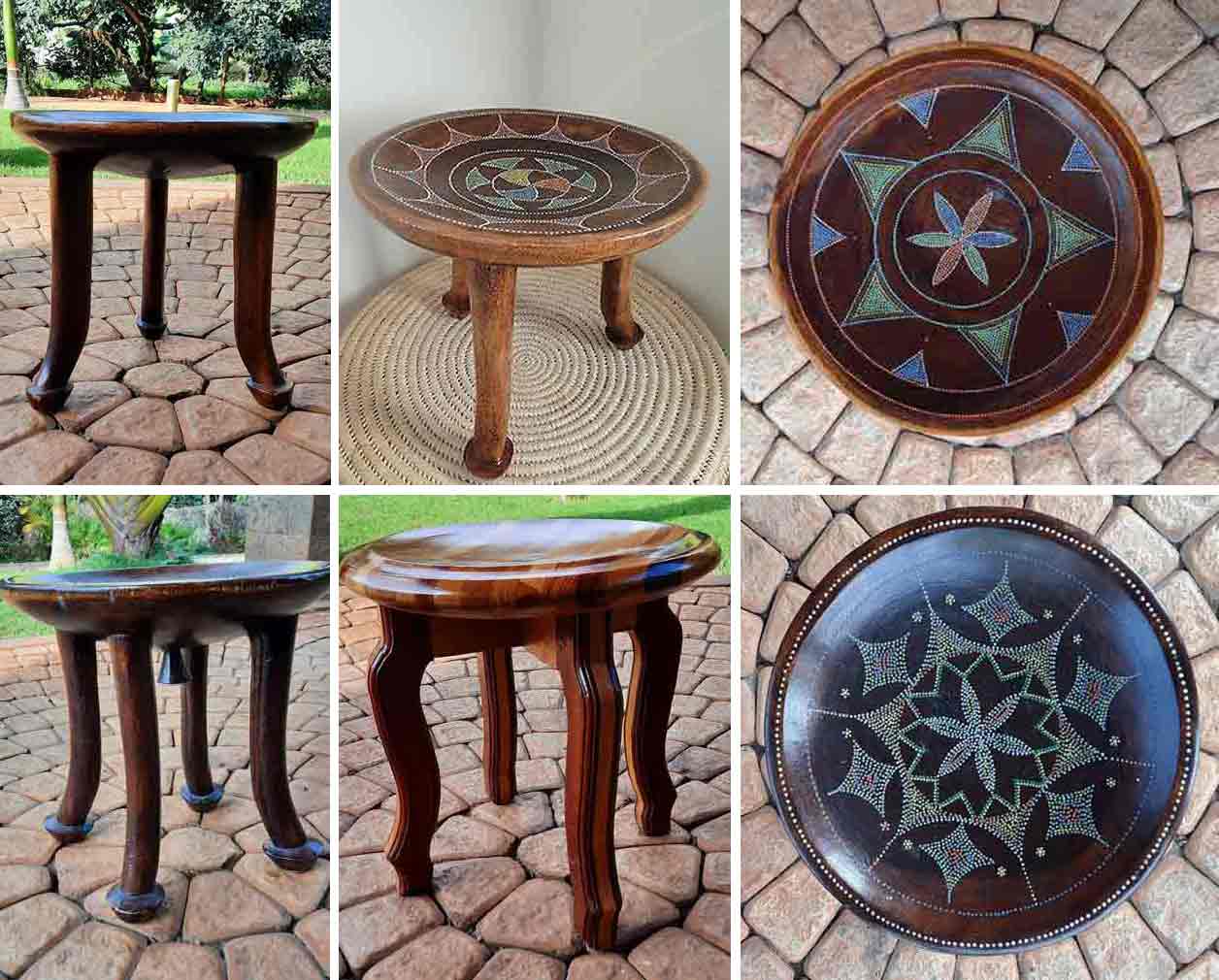
Variety Designs of Finished Kom Nyaluo, 2019, Karen, Kenya (photo by Mary Clare Kidenda)
When Sara went to the US for the inauguration of Mr Obama as president in January 2009 Mama Sarah carried a similar stool. In 2015 when President Obama visited Kenya, he was given a traditional Luo stool (Langat, 2015).
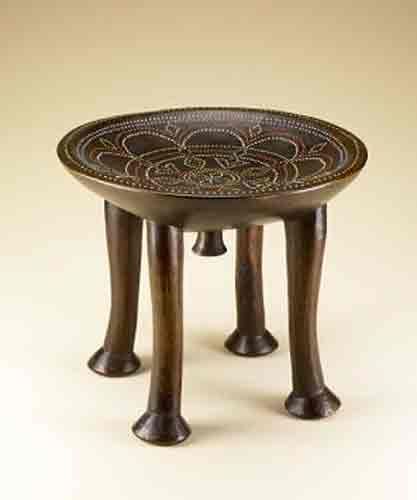
Kom Nyaluo Created by Luberastus Onyango, Wood, glass beads, metal, 2020 Smithsonian National Museum of African Art.
Luberastus Onyango was a renowned Kom Nyaluo craftsman (he died in 1988) whose stools have been given to at least 2 US presidents as gifts President, including John F. Kennedy and Barrack Obama.
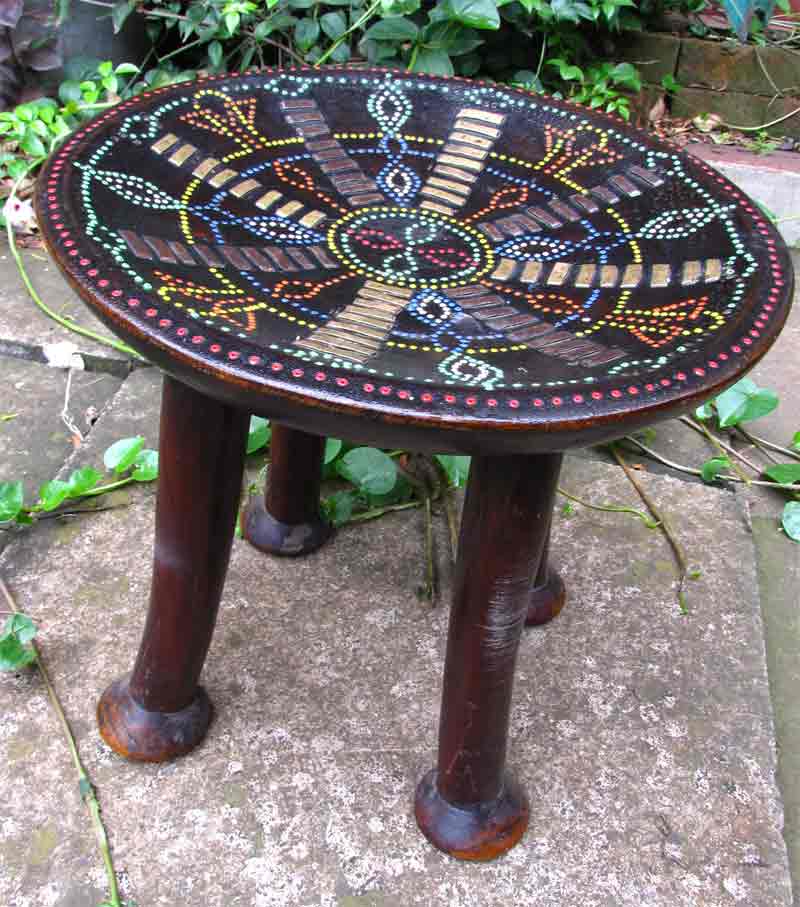
Variety Designs of Finished Kom Nyaluo, 2019, Karen, Kenya (photo by Mary Clare Kidenda)
A generation of Kenyan artists and designers are translating their view of Kenyan design into beautifully crafted products and creating an aesthetic diverse as the tribes and cultures that make up Kenya. This is evident in the JKS in the preservation and modification of the designs like Kom Nyaluo through a traditional apprenticeship that is the critical training methodology of apprenticeship used in Jua Kali Associations. This is evident with the continued production of Kom Nyaluo because of for its cultural utility and aesthetic functionality in the contemporary modern spaces. Artisans and designers are to re-direct and co-create new narratives that re-position philosophical discourse on aesthetics, among other contemporary debates. A generation of Kenyan artists and designers are translating their view of Kenyan design into beautifully crafted products and creating an aesthetic diverse as the tribes and cultures that make up Kenya.
References
- Biko, J. (2010). When in Kisumu, make sure you visit the museum. Eastern African Publication. https://www.theeastafrican.co.ke/tea/magazine/when-in-kisumu-make-sure-you-visit-the-museum--1297986
- Deisser, A.-M., & Njuguna, M. (2016). Conservation of natural and cultural heritage in Kenya: A cross-disciplinary approach. UCL Press.
- Hino, H., Langer, A., Lonsdale, J., & Stewart, F. (2019). From Divided Pasts to Cohesive Futures: Reflections on Africa. Cambridge University Press.
- Hoehler-Fatton, C. (1996). Women of fire and spirit: History, faith, and gender in Roho religion in western Kenya. Oxford University Press.
- Langat, P. (2015). Mama Sarah reveals her special gift to Obama during visit. Nation. https://nairobinews.nation.africa/mama-sarah-reveals-her-special-gift-to-obama-during-kenyan-visit/
- Lutta, C. (2015). The Traditional Levirate Custom as Practiced by Luo Of Kenya. University of Gavle.
- Madut, K. K. (2020). The Luo people in South Sudan: Ethnological heredities of East Africa. Cambridge Scholars Publishing.
- Maina, S. M., Rukwaro, R. W., & Onyango, W. H. (2017). Infusing Design In The Jua Kali (Informal Sector) Production Processes. Journal of Humanities and Social Science, 3(2), 1–12.
- Ndeda, M. A. J. (2019). Population movement, settlement and the construction of society to the east of Lake Victoria in precolonial times: The western Kenyan case. The East African Review [Online], 52.
- Ojwang, H. H. (2021). A study of Luo Ethnobotanical Terminology with implications for Lexicographic Practice. Lifelong Education Material Publishers.
- Prince, R., & Geissler, W. (2008). Becoming “One Who Treats”: A Case Study of a Luo Healer and Her Grandson in Western Kenya. Anthropology & Education Quarterly, 32(4), 447–4.
- Somjee, S. (1993). Material culture of Kenya. East African Educational Publishers.
 Osuanyi Quaicoo Essel
Osuanyi Quaicoo EsselPan-African collective memory: Sociocultural power and identity making on indigenous stools from Ghana and Kenya
Indigenous stools play significant roles in Ghanaian and Kenyan cultures and societies, especially, among the Akan and Masai ethnic groups in the two respective countries. Stools in the sociocultural context serve many functions. One of the primary functional roles is that, it serves as object for sedentary purposes. It is used as a utilitarian object for sitting, welcoming visitors, relaxation for people, for example, family and friends. In Ghana, it is customary to offer a visitor a chair (stool) by way of welcoming, serving him/her water, before asking the visitor of his/her motive for the visit. In the first instance, a visitor is given a sit to relax, followed by cup of water for drinking before asking the visitor to give purpose for the visit. Offering a visitor a chair shows an overt acceptance and respect for his/her presence. This traditional etiquette of serving visitors is ingrained the sociocultural life of both Ghana and Kenya.
Amongst the Akan of Ghana, a visitor is usually given a traditional stool as a seat that may befit his/her status in the traditional society or culture. A family may have different stools: those for showcasing power and authority of its user, honouring guests, and everyday usage by the household. The usage of stools in this context depicts its status-defining tendencies.
Apart from signifying status of individuals, stools, among the Akan of Ghana symbolises the authority of the ethnic or nation states. Stools in Ghana, generally serves as a symbolic soul of the society which links people to the traditional leadership (Antubam, 1963; Amenuke et al, 1991). The stool carries authoritative presence and signifies leadership concept. Warriors, clan heads, chiefs, kings used it to signify their status.
Stools serve as scared and authoritative object in the traditional chieftaincy institution of the southern part of Ghana. Kings/chiefs are enstooled in southern Ghana while those at northern part are enskinned. This implies that in the cultural rituals in the making of Kings/chiefs, stools are inevitable. Amongst the chiefdom, there are several ritualistic uses of stool. Some stools in the court of a chief may be used only once in his or her lifetime. Some are also used once a year during traditional festivities while some are used on daily bases.
As an object strongly connected with power and authority, the Ghanaian stool has three basic parts: the arc-shaped top, the middle portion and the flat base. Its arc-shaped top symbolises loving embrace of women or the concept of motherliness (Amenuke et al, 1991; Antubam, 1963). The middle portion usually gives the stool its name based on the symbol used in representing a concept or idea. The name of the of a stool could be based on a proverb, Adinkra symbol (Figure 1), traditional emblem or idea. For example, the stool in Figure 1 derived its name from the Adinkra symbol which has been stylised to occupy the middle portion, hence the name Nyansapow Stool.
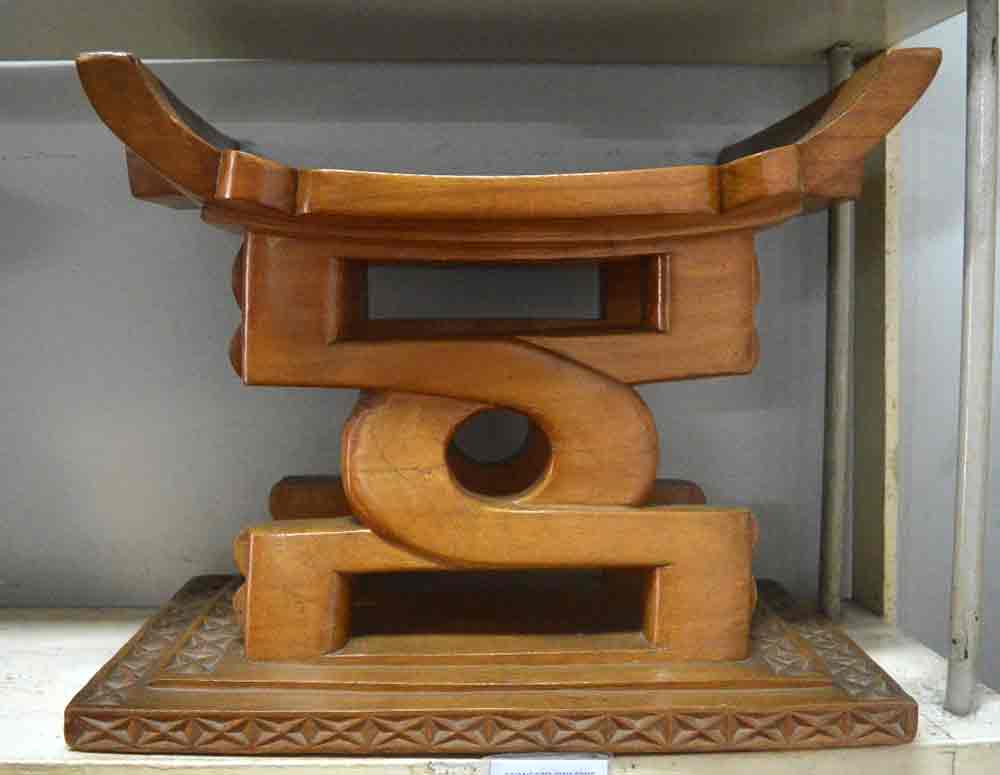
Figure 1: Nyansapow (Wisdom knot) stool, wood, Ghana National Museum, Photo: the author.
The recognition of the presence of God in the society, gender roles and the presence of children is also acknowledged by the middle part of the stool. Design of a stool may adopt basic beliefs and practices of symbolic significance to the society in general. The symbolic adaptation speaks to the visual presentation of Ghanaian societal values including concept of societal functions, cosmic beliefs, family and gender roles.
As a utilitarian object, the stool plays vital roles in the rites of passage (birth, puberty rites, marriage and death) in indigenous Ghanaian and Kenyan cultures in different context. In indigenous Masai culture, stools are used by husbands as object of announcing their eminent visit to their wives on rotational basis. In many African societies, marrying more than one woman is an accepted norm just as same sex marriage are acceptable in other continents of the world. African society holds polygamy as a culture and not in negative perspective as non-African wrongly perceives it. Masai men with more than one wife usually build their houses in circular orientation, allocating a room each to the wives. The house of the man is situated in the middle of the circular-arranged houses. With this traditional set up, the stool is used as a preserve for the husband to signal his presence and authority. To announce his official intention of visiting one of the wives in the same compound, he sends his messenger to send his stool to one of the wives he intended to visit. By seeing and receiving the stool, the wife interprets this symbolic gesture to mean official announcement of her husband’s visit.
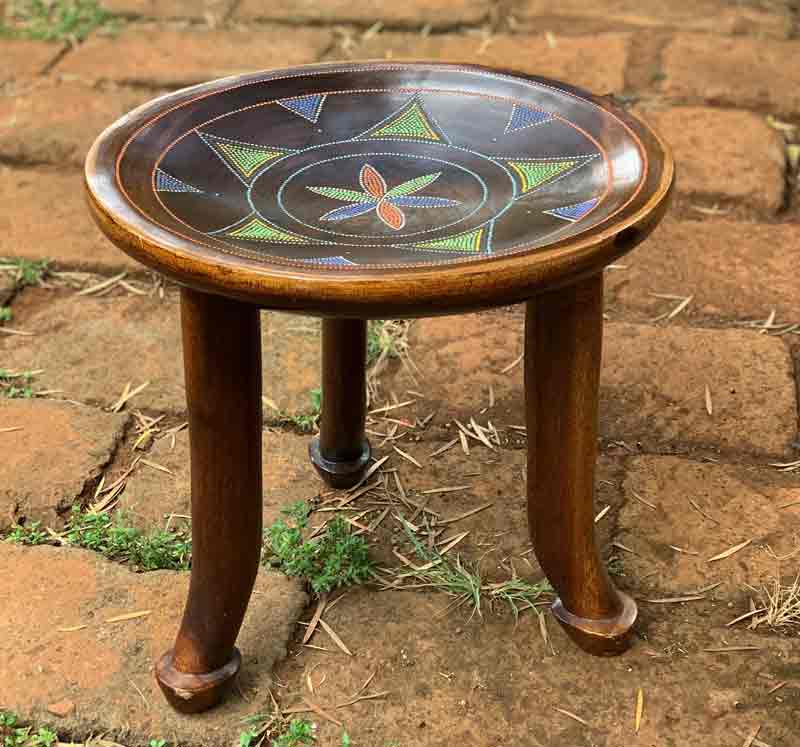
Figure 2: Traditional Kenyan stool used in negotiating visitation to wives, Found in the personal collection Mary Clare Kidenda. Kenya, Photo: the author.
The design of the Masai stool of Kenyan (Figure 2) varies from that of the Akan of Ghana. The Maasai stool features a circular-shaped top and prominent three-legged phallus-shaped upright stands. Usually decorated with traditional Masai beads, the top of the stool has bowl-shaped surface that serves as a comfortable receptor of the buttocks of the user. The tip of the phallus-shaped stands touches the ground and gently bends inward, and depicts crown-shaped cork memetic of the phallus. These observable characteristic features symbolise the presence and potency of the manhood in procreation. Despite its simplistic appearance, the stool creates a collective memory of marital relationships and the supervisory power of males and the loving embrace of women. Interestingly, this depiction to the African, is not a show of chauvinism but a reminder to males to protect and care for women within their power. Generally, having secret rendezvous or extra marital affairs is frond up by society. Performing official marital rights to marry a lady is the traditional expectation rather than having them as mistresses.
In Ghana, the head of a clan, warrior, chief/king and queen mothers uses the stool to symbolise authority. For that matter, the presidential seat was fashioned with inspiration from the shape of the stool. Despite the difference in design concept of the Kenyan and Ghanaian stools, both signify a collective memory of marital relationships, idea of procreation, leadership authority and the loving embrace of women in the society.
References
- Amenuke, S. K., Dogbe, B. K., Asare, S. K., Ayiku, F. D. & Bafoe, A. General knowledge in Art for senior secondary schools. Evans Brothers Limited.
- Antubam, K. (1963). Ghana’s heritage of culture. Koehler & Amelang.
- Asihene, E. V. (1978). Understanding the traditional art of Ghana. Associated University Presses
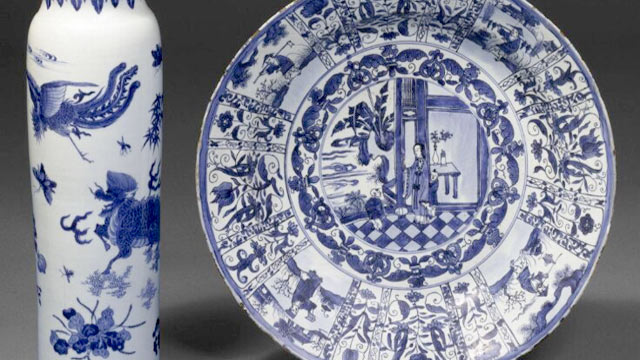
-
 Dong Xiaoling
Dong XiaolingIn the 13th century, when traffic and information were sparse, Marco Polo, a Venetian, came to China by land and served the Chinese Yuan imperial court from 1275 to 1295. The white Chinese porcelain vases, which he took back to his motherland and which are archived at San Marco Museum in Venice today, are reputed as a symbol of the Chinese vogue that went viral in Europe 300 years later. The Travels of Marco Polo has stirred European’s imagination of China[1] , and also promoted Europe's maritime exploration.
However, before the opening of the new sea route between China and Europe in the 15th century, Chinese porcelains were rarely exported to the European market as a commodity. The trade of Chinese porcelains to Europe was monopolized by Arab merchants, while European merchants could only obtain fewer Chinese porcelains from West Asia and Egypt in the form of intermediary trade. Unlike silk and spices, which were easy to carry and transport, Chinese porcelains were mostly sold locally by means of land transportation because of their fragility and weight. They were closely connected with local culture, after which they were imprinted with local aesthetic characteristics and shipped to Europe. However, Chinese porcelains were not what they had always been. Forerunner of great geographical discoveries as he was, Zheng made seven large-scale ocean voyages during Ming Dynasty from 1405 to 1433, but did not establish direct contact with Europe.
Comparatively, European humanism and capitalism were at an embryo stage. From the 15th century to the 17th century, European fleets represented by Portugal, Spain and the Netherlands carried out sailing explorations in order to seek new trade routes and trading partners as well as develop the capitalism in Europe.
First, Chinese porcelains were shipped to Europe as ballast. However, the European upper class favoured them by virtue of their smooth texture, delicate and hard casing and exquisite emblazonment. European royal nobles and bishops all were keen on owning Chinese porcelains to show off their wealth and status. European royal families’ love to Chinese porcelains did not ease in spite of the fact that they had little understanding of the materials and techniques and far away China. Philip II of Spain (1527-1598) had a collection of 3,000 pieces. Although Europe started importing Chinese porcelains on a big scale, a mysterious atmosphere always clung to these exquisite utensils. At that time, some people in Europe even thought that Chinese porcelains could play an anti-virus effect.
The French doctor Loys Guyon (1527-1617) and Sir Thomas Browne (1605-1682) of England studied Chinese porcelains. Père Francois Xavier d'Entrecolles (1664-1741), a French missionary, was in Jingdezhen, China, for 7 years during the 17th century. In 1712 and 1722, he wrote reports on the details of Chinese porcelains making which he observed and inquired into and mailed them back to the Jesuits in Europe, making it possible for French to imitate porcelains locally.
Already in 1575, Italian Medici Grand Duke Francesco's factory made an attempt to produce porcelains, which was the first imitation recorded in Europe. Such a kind of Medici pottery bottle with blue and white patterns is collected in the Louvre. Both the white glazed blue painted pottery in Delft, the Netherlands, and the Nevers kiln in France have imitated the decorative style of Chinese porcelains. However, in terms of materials, they came in pottery or soft porcelain. The alchemist Bottger did not calcinate the earliest European porcelain at Meissen, Germany until 1709. In this process, the aesthetic taste in Europe had gradually changed. The fashion of loving oriental artifacts had gradually spread from nobles to rich bourgeoisie. As the demand for relatively cheap goods had also become more and more vigorous, porcelains had gradually turned a part of the daily life of the common. The nature of Chinese porcelain had gradually changed from collectibles to daily commodities.
In order to meet the needs of European society, East India Companies in European countries imported a large number of porcelains from China in the 17th and 18th centuries. In China, this kind of porcelain for export was called export-purpose Chinese porcelain.[2] From the change of shape and pattern the export-purpose Chinese porcelains can be roughly classified into traditional styles, hybrid styles and foreign styles.
1. Traditional styles (The shape and decoration of porcelain have not been influenced by foreign styles, and are no different from products on the Chinese market.)
From the opening of the new sea route in the 16th century to the lift of the ban on maritime trade in 1684, it was illegal for Chinese to export porcelains. As per the ban on maritime trade in the Ming Dynasty, non-governmental maritime trade was strictly prohibited, while official tribute trade was allowed with strict restrictions. Foreign countries could only conduct limited official trade with the Ming authorities. Since then, the Qing authorities have repeated the ban on maritime trade. The production and shipment then were at great risks.
Merchants usually purchased Chinese porcelains in Guangzhou and then shipped them abroad from Macao, making the export-purpose Chinese porcelains dominated by traditional Chinese style at this stage. It influenced the early stage of the Chinese style in Europe as well as the reproduction and imitation of Chinese porcelain with soft pottery in Europe. Chinese porcelains were mainly used as daily necessities, such as dishes, bowls, bottles and pots. But there were few ornamental porcelains as well. The decorative patterns mostly came in cloud-dragons, deer, horses, cranes, monkeys, flying butterflies, birds and insects, folding branches and flowers, fairy ladies with babies, city walls with mountains and waters, auspicious characters, etc.
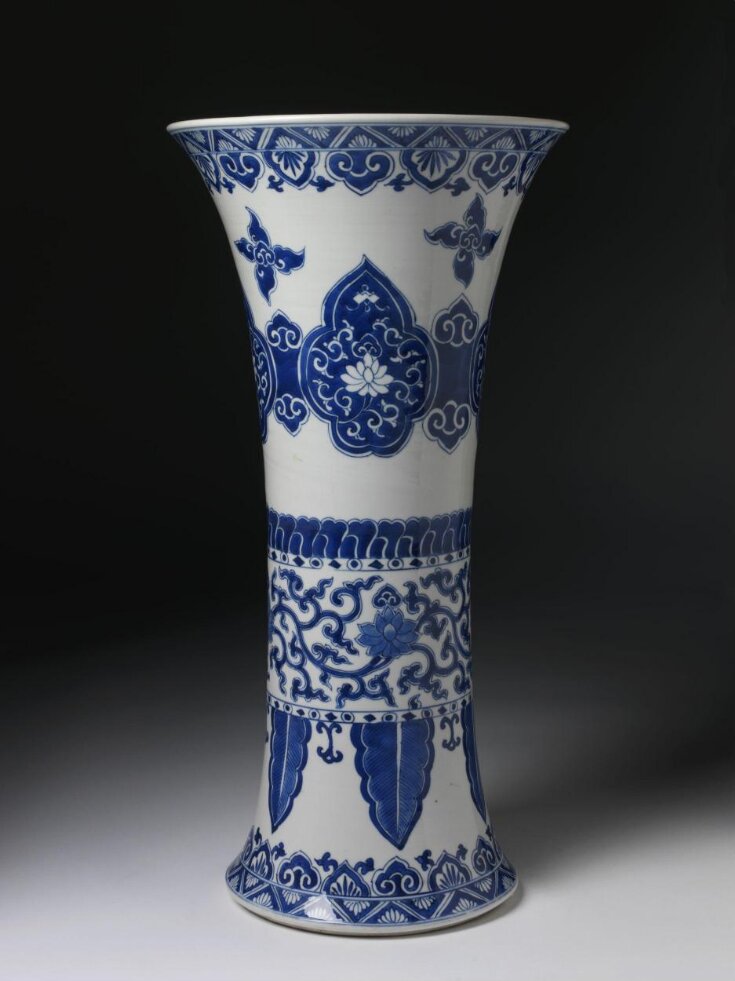
Unknown, Blue and white porcelain vase, 1700-1710, Victoria and Albert Museum London.
The style of blue-and-white porcelains represented the life of the easterners to Europeans. A great number of Chinese porcelains of this kind are recorded in the archives of Dutch East India Company.
On the one hand, few Chinese porcelains were exported to Europe with a higher price; on the other hand, the pure oriental shape made Chinese porcelains deviate from the daily needs of Europeans. For example, easterners’ habit of eating rice and using chopsticks makes bowls the most common utensils in the East, while westerners’ custom of eating bread and using knives and forks has not made bowls, with a deep-walled shape, the mainstream of European tableware by far. Because the typical Chinese tableware consists of fewer parts compared to Western dining habits, Chinese porcelain dishes could only be used for holding cakes and pastries in Europe. For example, porcelain pen containers were used as wine cooler, and porcelain fish tanks were used as flowerpots... Chinese porcelains were constrained in terms of use, and often modified or displayed as ornaments. Therefore, a new style came out in the course of development.
2. Hybrid styles. (Chinese traditional style couples with foreign ornaments and vise versa, or Eastern themes couple with Western ones for hybrid ornaments.)
It is the stage of free transformation of Chinese style porcelains. Among this type, porcelain with traditional Chinese themes, or a mixture of different themes from China and Europe, combined with European shapes is the most representative. Part of the changes in the shape of European porcelain came from metalware, and part from the changes in lifestyle brought about by trade. For example, since the 17th century, Europeans have been importing black tea and coffee from the East and chocolate from Mexico. These hot drinks come brown in color after brewing, and white Chinese porcelains serve as the most suitable drinking utensils. The emergence of new eating habits has promoted the transformation of Chinese porcelain utensils. The Dutch enlarged the size of traditional Chinese small teacups and designed a lug.[3] Kraak porcelain[4] and Mandarin style were the most representative.
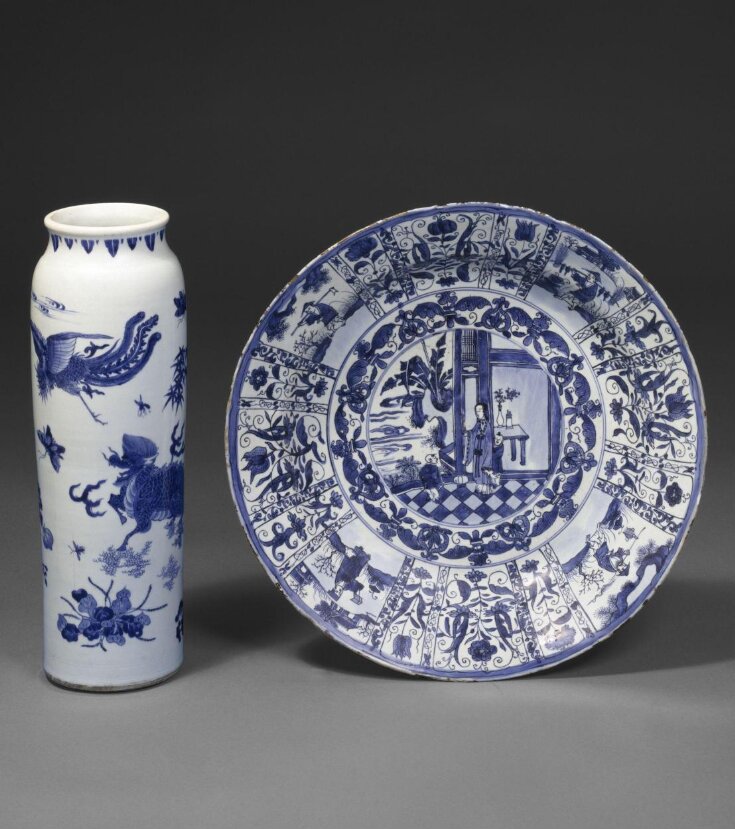
Unknown, Dish, ca. 1635-1655, Kraak Porcelain, Diameter: 47,5 cm, Bibliographic Reference: Clunas, Craig (ed.). Chinese Export Art and Design. London: Victoria and Albert Museum, 1987, p. 38, fig. 16.
Kraak porcelain is a form of blue and white porcelain exported from Wanli Period of Ming Dynasty (1573-1620) to early Qing Dynasty. It was mainly shaped in dishes, bottles and bowls, and represented by trimmed patterns. These patterns came round, diamond-shaped and lotus petal-shaped, with designs of flowers, birds, fish and insects, landscapes, figures and auspicious mascots commonly seen in Chinese porcelains. Later, exotic religious myths and social life themes appeared in trimmed patterns. In terms of techniques, the traditional way of drawing the outline of the pattern on the surface of the porcelain body with a writing brush and then filling it in with color was adopted. Kraak porcelain is a kind of export-purpose porcelain with the largest quantity and the longest influence period of more than 100 years. After that, blue and white porcelain in Kangxi Period (1662-1722) of Qing Dynasty came in western rendering techniques in drawing, showing a maximum of eight or nine color gradations on the porcelain body. And it drew much popularity among westerners.
The word “Mandarin” was a name for Chinese officials when Portuguese traded with Chinese merchants in the 17th century. In the 17th and 18th centuries, many missionaries and painters came to China and recorded their experiences there, including their life and work with Chinese officials in addition to preaching.
Most of the decorative patterns depicted the life of officials and wealthy merchants in Qing Dynasty, who enjoyed a rich and leisurely family life. These descriptions and landscape paintings further aroused European‘s curiosity about live in China. Aiming at this market opportunity, Guangzhou Porcelain Workshop launched Mandarin style products for European and American markets. Some patterns use the perspective technology of European oil paintings, and the expressions of the characters are vivid, which conforms to the aesthetic orientation of Europeans. These patterns presented a desirable pastoral oriental atmosphere for westerners. Playing in picturesque courtyard gardens, hunting in enchanting springtime, harmonious coexistence between human beings and nature, and vivid home life scenes embodied elegant Chinese costumes, fascinating home decoration, exquisite garden scenes, and charming family happiness. These themes greatly satisfied Europeans’ curiosity and yearning for the East.
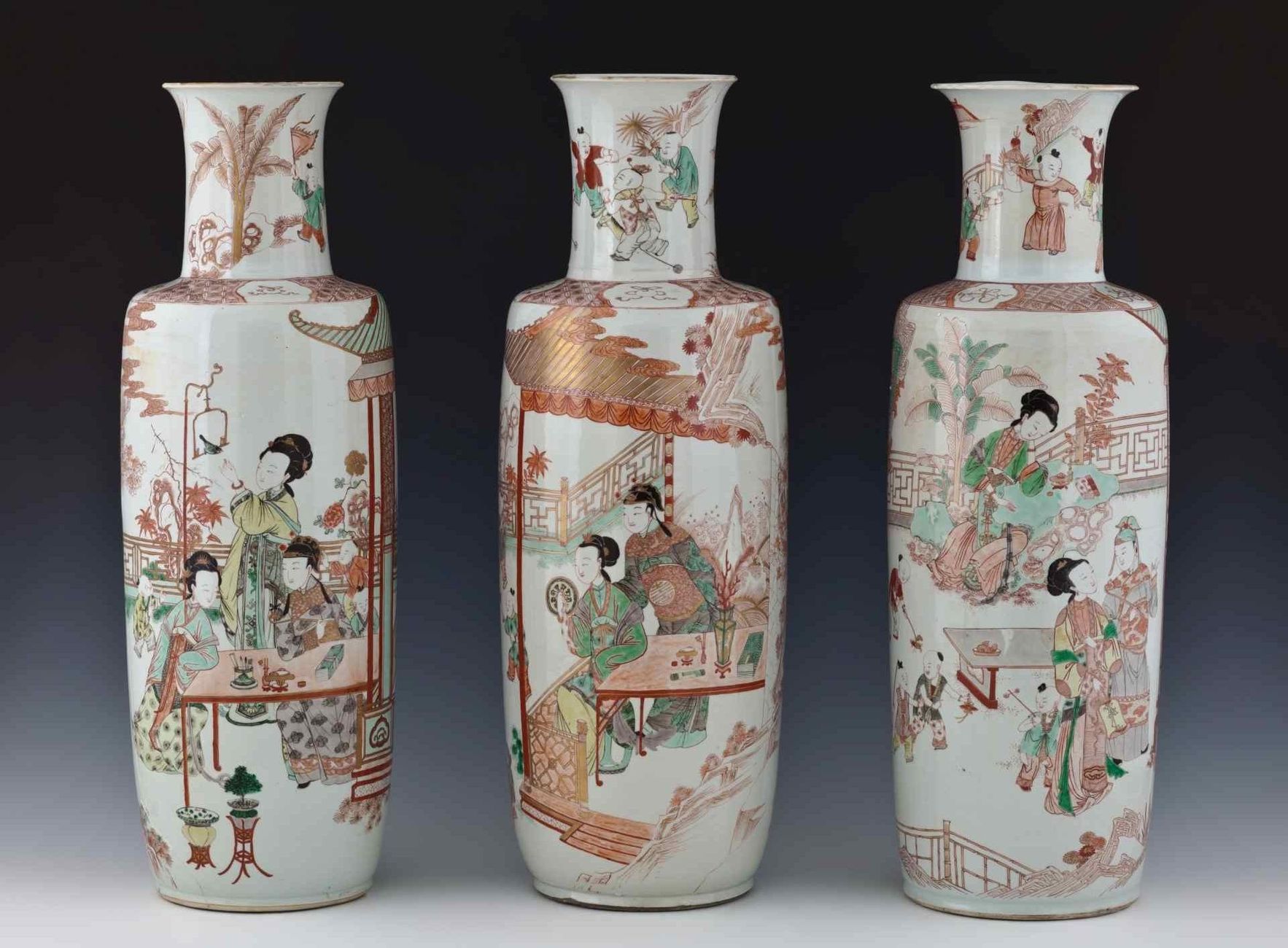
Unknown, Three Vases, 1700-1720, Procelain, Jingdezhen, Staatliche Kunstsammlungen Dresden.
3. Foreign styles. (Chinese porcelains satisfying the requirements of European merchants in terms of shapes and patterns, calcined elaborately to serve European consumers’ needs. Most of the patterns were drawn in strict accordance with the prints and patterns as required by customers, so they were usually called custom-made porcelains.)
One type was produced in the 17th century. Since Europe had not yet mastered the technology of porcelain-making, Chinese porcelain workers imitated the pottery of European style according to the requirements of European merchants. Chinese Porcelain competed with European pottery in this way and earned a lot of silver used as currency.
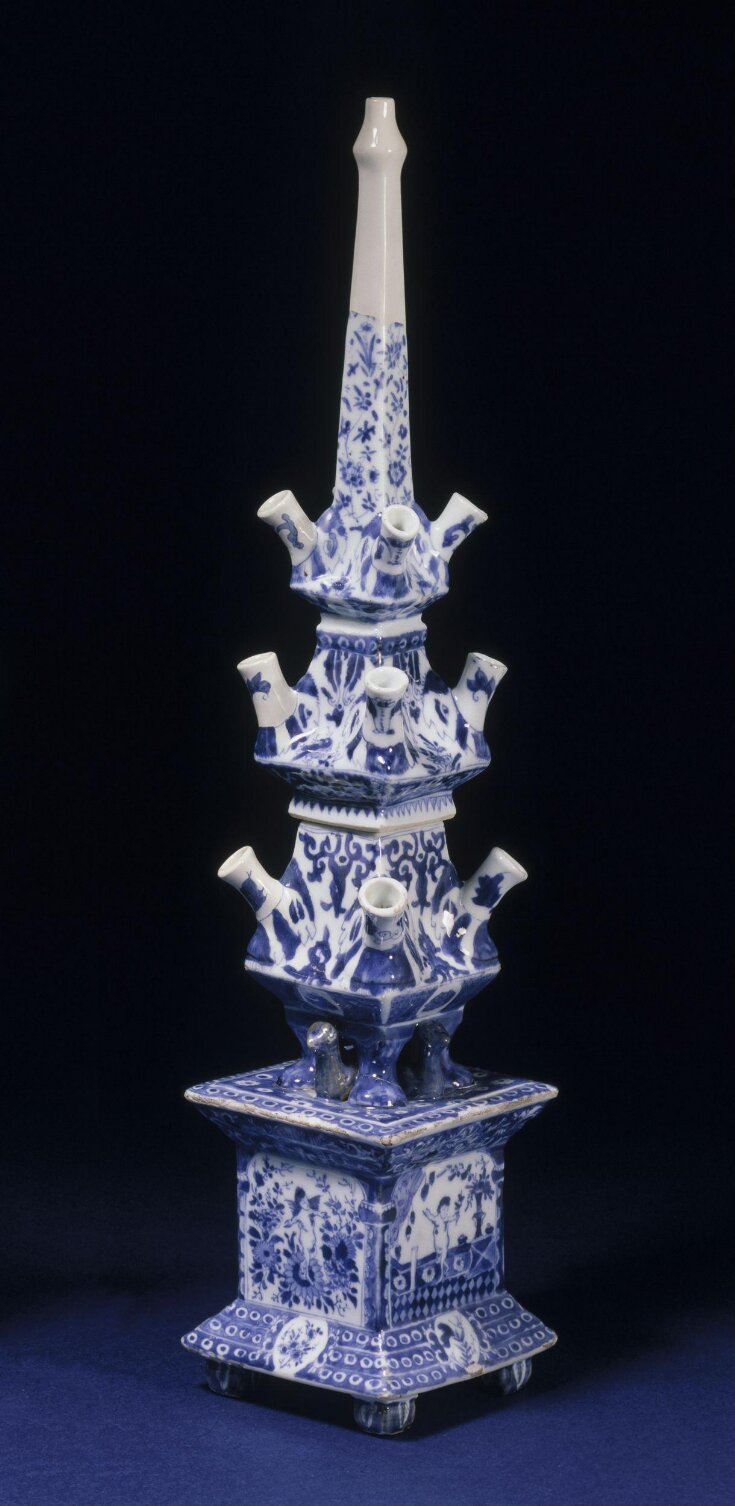
Unknown, Vase with Angel, 1700, Porcelain, H: 36cm, Victoria and Albert Museum London. Bibliographic Reference: Clunas, Craig (ed.). Chinese Export Art and Design. London: Victoria and Albert Museum, 1987, p. 60, fig. 40.
Another type emerged when the Chinese style in the West reached its peak in the 18th century and Chinese characters and landscapes imagined by Westerners appeared in the patterns. The pictures are humorous and interesting, while the number is quite limited. In addition, there were porcelain carvings, figures and animals.
The pattern was typically formed by heraldry (the special signs of European and American aristocratic guilds, groups, etc. In the 18th century, China sold up to 600,000 kinds of heraldry porcelain to Europe). In addition, characters (out of Greek or Roman fairy tales, the Bible, European customs-based sketches), ships, landscapes, flowers, etc. used to be popular themes among Europeans. Besides, European living habits were taken into consideration in terms of modeling.
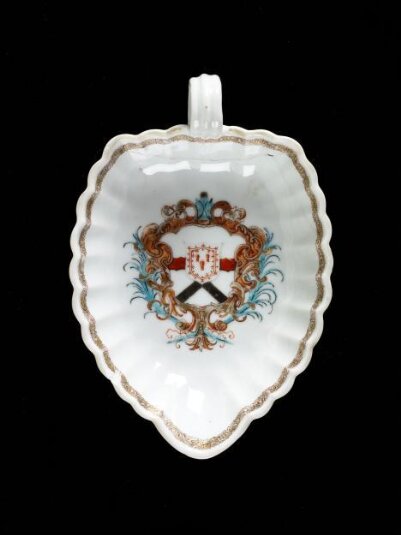
Unknown, Souceboat, ca. 1740, Porcelain, L: 18,4cm, Victoria and Albert Museum London. Bibliographic Reference: Howard, David Santuary. Chinese Armorial Porcelain. London: Faber and Faber Limited, 1974, p. 295.
Apart from blue and white, multicolored and famille rose ones were among this kind of style. Because of the higher cost, longer period of capital occupation, more complicated procedures and greater commercial risks, this variety did not turn a mainstream among export-purpose Chinese porcelains in spite of their distinctive features. Especially in 1769, the first production line of British Wedgwood Porcelain Plant rolled off, when European porcelain production began to leap from the handicraft era to the industrial era. Since then, importing Chinese porcelains has grown unprofitable, and the porcelains in Chinese style turned gradually out of date.
In the course of trade development for nearly 300 years from the 16th century to 19th century, from “Made in China” to “Making Chinese Porcelains”, the Chinese vogue going viral in Europe represented a process of Europeanization of Chinese cultural practices. In this process, lacquerware, woven carpets, clothing, furniture, wallpaper and garden architecture were as well used for reference, quotation and modification in Europe, and finally integrated into the social context of Europe, influencing and even changing the artistic outlook of Europe. Nowadays, the shortened distance and accessible information across the world enable us to see the diversity of cultures more quickly and accurately. More possibilities for cultural exchanges will definitely be springing up in the future.
FOOTNOTES
[1] China in the 13th-19th centuries was only a Far East country geographically along with India, Southeast Asia, South Korea and Japan
[2] Due to the limited space, the export-purpose Chinese porcelain in this paper refers specifically to the exported ones to Europe.
[3] Lin Lin's, Research on Porcelain Trade of Dutch East India Company in the 17th-18th Centuries, pp 31-34.
[4] Its name probably originated from Portugal Caraack, meaning “giant merchant ship”.
REFERENCES
- WangYong, A History of Art Exchange between China and Abroad, Beijing, 2013
- Shanggang, A new compilation of the history of Chinese arts and crafts, Higher Education Press , 2007
- Etiemble, L’Europe Chinoise. The Commercial Press, Beijing, 2013
- Liwei, Through the silk Road, Beijing, 2018
- Hugh Honour,Chinoiserie: The vision of Cathay, Peking University Press, 2017
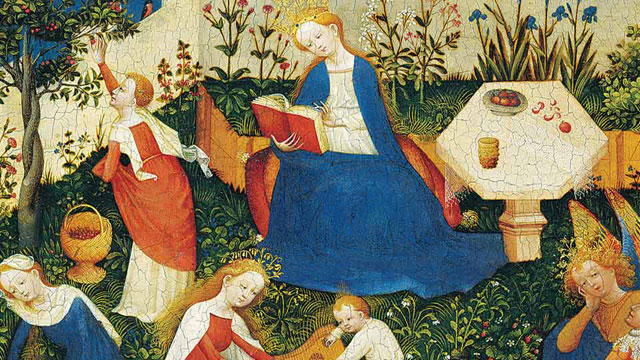
-
 Constanze Kirchner
Constanze KirchnerThe motif Paradiesgärtlein originates from Christian imagery. It was painted many times in the 15th century, especially in Italy and along the Rhine. The enchanting devotional picture shows Our Lady enthroned on a bright red cushion in the middle of the garden, tall, in a radiant blue robe, as the figure dominating the picture. Her head is bowed and she is reading a book. A crown with leaves distinguishes her as the Queen of Heaven.
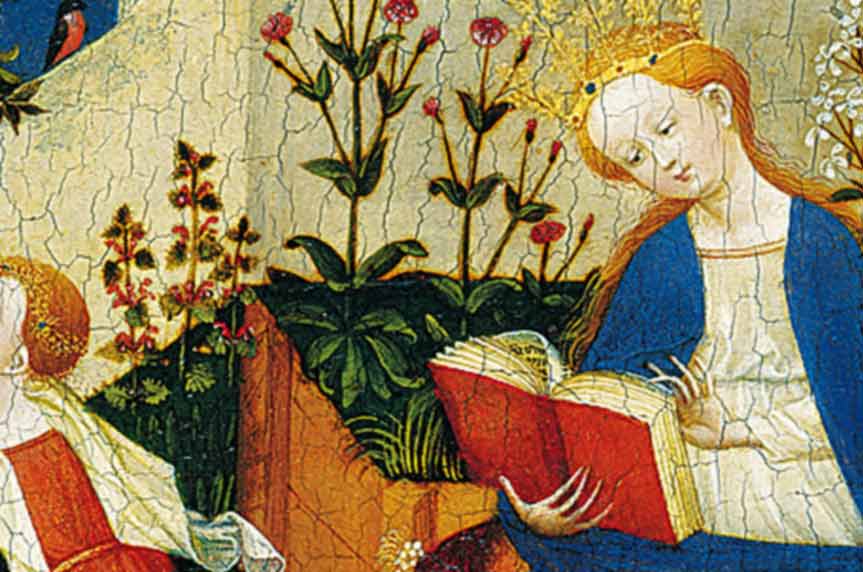
The Christ Child is playing at her feet. The other female figures in the left half of the picture are also to be understood as Holy Virgins because of their splendid clothing. A clear assignment of these saints is uncertain (Keazor 2001, p. 231 ff.). St. Barbara is probably drawing water with a golden spoon from the (life) well in the foreground on the left, because legend attributes to her miraculous powers in overcoming a period of drought. And it could be St. Dorothea who picks cherries from the (life) tree and puts them into the basket, although – according to the legend – the cherries are handed to her (ibid.). The figure holding the plucked instrument (psaltery) to the infant Jesus is interpreted as St Catherine of Alexandria or St Agnes. She is distinguished by a golden diadem with floral decoration and by her flowing hair (ibid.).
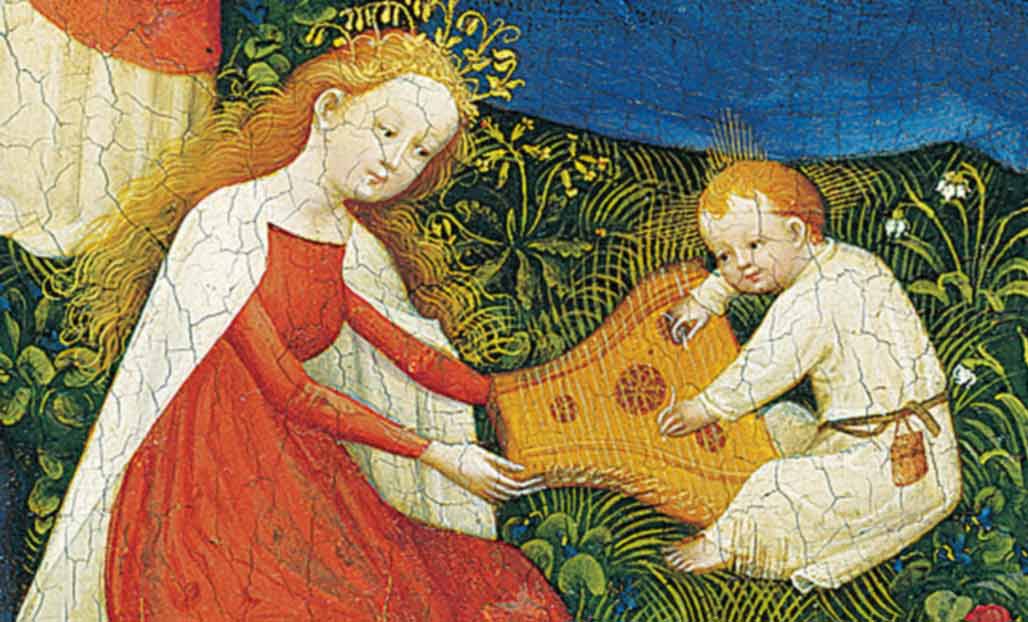
The group of figures on the right consists of the pensive Archangel Michael, also crowned with a golden plant, and – facing him – St. George in chain mail, next to whom lies a small dead dragon. A third figure, probably St. Oswald, bends down to both of them, as a raven peeps out from behind his knee (ibid., p. 233). He is holding on to the tree of knowledge. Saint George has of course already conquered the dragon, which stands for evil, and looks expectantly at Mary. Under another tree sits a frightened monkey with the distinct features of the devil.
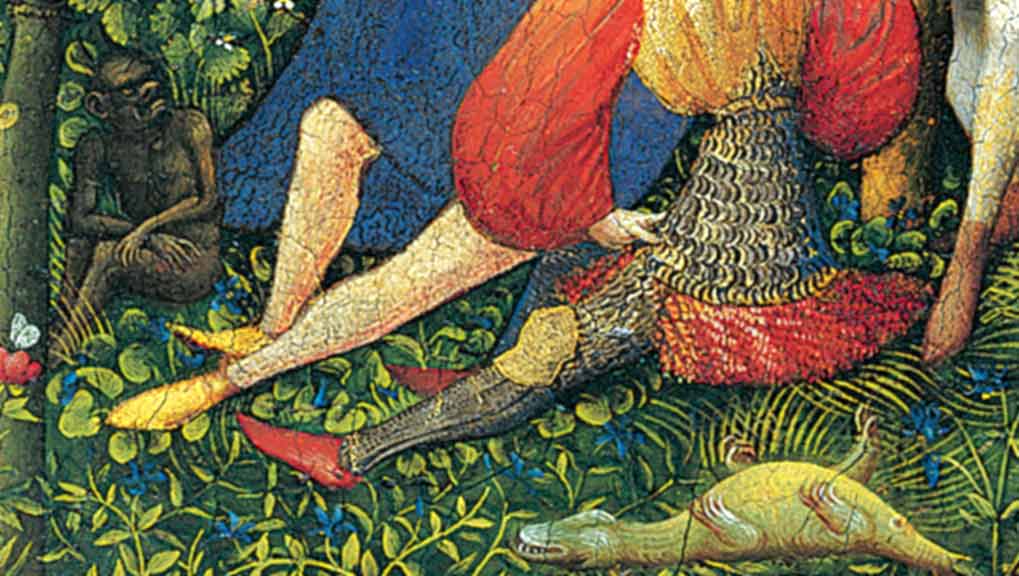
According to biblical legend, he is held in check by the Archangel Michael, the fighter against evil and guardian of paradise. The apples mentioned in the creation story, which tempted to sin, lie ready on the hexagonal, bright white stone table. Wine and bread refer to the Last Supper. The table is compositionally remarkable, dividing the male group of figures from Mary.
Both paradise and the garden stand for a protected, enclosed and bounded place that provides food and water as well as peace and quiet. In the garden, flowers, herbs, fruits and grasses blossom and grow, spanning a supra-temporal, idealising arc from spring (lily of the valley) to midsummer (roses). Especially the white-flowered plants, such as the lilies, stand for the purity of Mary. Just like the plants, twelve birds of different species are depicted in detail and realistically - and thus identifiable (Brinkmann/ Kemperdick 2002, p. 93).
Compositionally, the colour scheme dominates the picture: the secular blue sky frames the graceful Mary leaning towards the book, whose blue robe corresponds with the blue clothing of St Barbara and that of the archangel. The white garments of the saintly figures, the wall in white tones and the light-coloured table enclose the baby Jesus, also dressed in white, in their midst. At the same time, the bright red of the virgins' robes, the red of Mary's book, her seat cushion, St. George's sleeves, the blossoms and fruits reinforce the clear composition, which is additionally underlined by the complementary green of the plants and once again places Mary at the centre of the picture's action. The spatial effect is essentially determined by groupings and overlaps of the figures and pictorial objects; there are no shadows in the heavenly world.
The figures appear relaxed, peaceful and serene, the colourfulness and the abundance of vegetation with springing water embody serenity and earthly happiness. The Holy Virgins are engaged in an occupation that does not cause any trouble. The clothing and hair ornaments are reminiscent of courtly life in a well-tended castle garden. This is also indicated by the killed animals, which are not usually part of the heavenly world, as well as a tree of knowledge that does not bear fruit. This combination of the divine world as a heavenly paradise with the impression of earthly reality characterises the picture to a great extent and thus lends it a peculiar mood, explosiveness and tension in its contemplativeness.
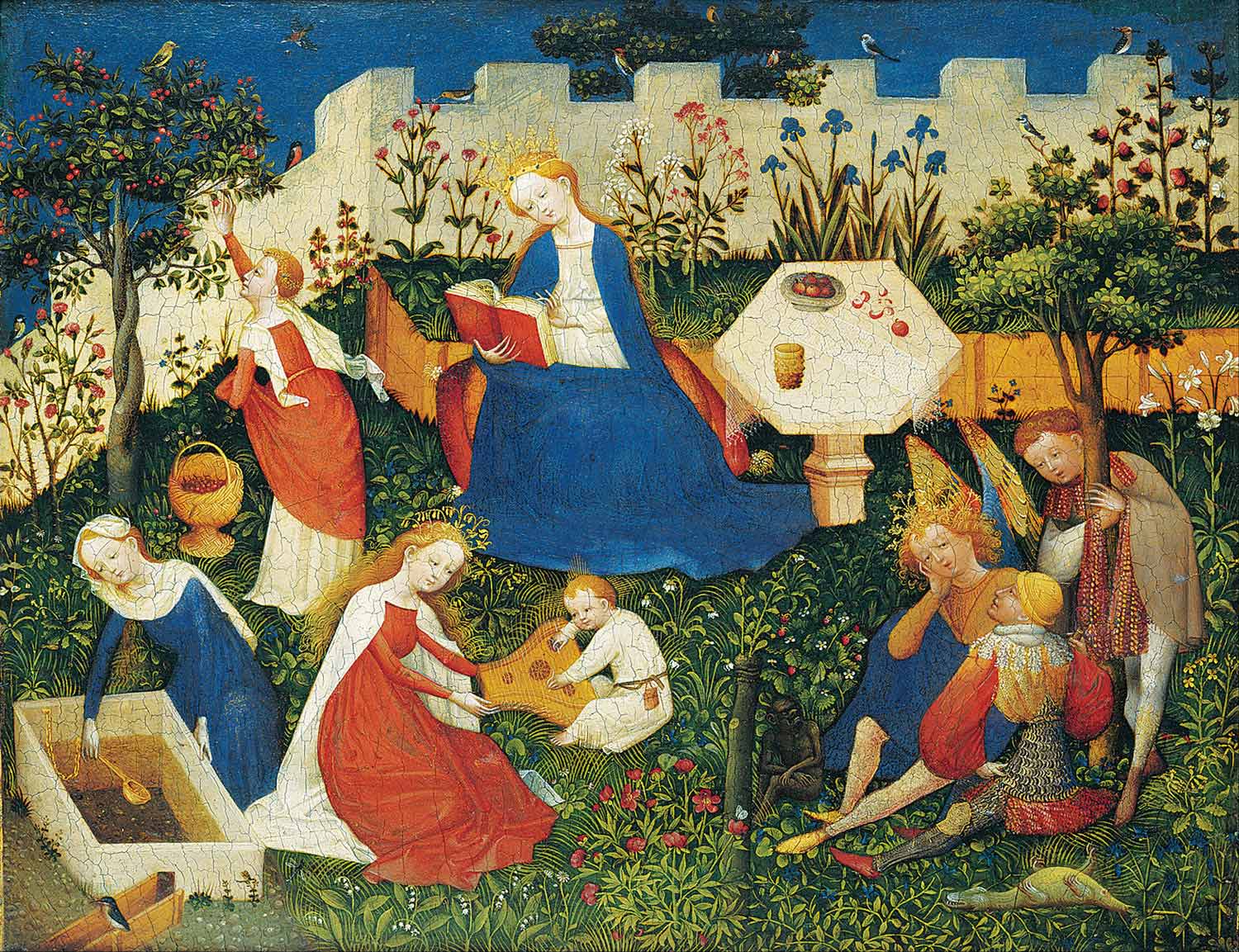
There are numerous studies on the painting technique, the use of colour, the symbolism, the identification, function and activities of the saints, the plants and animals. Also research has been done on provenance in the monastic context or on the attribution of the picture type as ‘hortus conclusus’ (closed garden as a symbol of Mary's virginity). ‘Hortus conclusus’ is often alluded to in paintings of Mary - a garden with an enclosure and with certain plants that refer to Mary (lily, rose, but also lily of the valley or strawberries) - as can also be seen in the Paradiesgärtlein. At the same time, however, the Paradiesgärtlein evokes associations with the gardens of pleasure and love, as found, for example, in engravings by the Master of the Gardens of Love in the mid-15th century (http://bildersammlung-prehn.de/de/node/946, 06.03.2019) - and in this ambivalence once again clearly emphasises the link between divine and earthly worlds of life.
What does the Paradiesgärtlein mean?
The Paradiesgärtlein defies a clear interpretation. The duality of good and bad is hinted at, but the victory of good in paradise over evil or sin – represented by the dead dragon and the vanquished devil – is clearly emphasised. However, the ideal state in paradise is not unbroken: With their tilted heads, the figures in the painting appear pensive, as if they know that there is a life of tormenting reality outside their shelter. The garden as a retreat from the dangerous outside world protects, where in everyday life there is oppression, fear of hunger or sudden death. With the devotional image, religion offers comfort in the promise of salvation to a paradisiacal existence in which the threatening is banished. The imponderable reality is countered by the protective enclosure of the massive wall – outside, the world is full of danger.
The devotional image builds a bridge from this world to the hereafter and vice versa. It opens up a view into eternity and thus into a transcendental space of experience that lies outside finite everyday experience. Visual means are used to create access to the divine, an access that at the same time recalls one's own experience of the world and yet enables the imaginative experience of transcendence.
As an anthropological constant, the idea of a transcendent reality, which usually characterises life after death, runs through many cultures. Experiences of transcendence are described in many ways and often refer to extrasensory perceptions and supernatural forces to which the respective belief is tied.
Why is the painting interesting for art education?
Transcendence and spirituality are often at the core of cultural traditions - in this case Christian heritage. It could be exciting to enter into a conversation about this and to draw on examples of non-European cultural testimonies of faith from the 15th century. In this way, world history can be opened up and a Eurocentric perspective on the history of Western art can be expanded. (As the epitome of European beliefs about the Garden of Eden, the work also stands at the end of the medieval conception of nature and art.)
The image announces divine truth: In paradise, the world is in order. Outside the garden, man lives in untamed nature and is exposed to all incalculable events. With its religious context of origin, the painting's function is primarily to depict an otherworldly, divine order that illustrates the promise of salvation after death in contrast to the earthly hardships of the late Middle Ages. But the pictorial interweaving of earthly and heavenly life already points beyond the late medieval conception of the image. The shielded divine world view experiences ruptures, opening and change.
Not only can the work paradigmatically explain the end of the Middle Ages and the development of art history. Furthermore, the it invites discovery: plants can be identified, animals and groups of figures with their actions tell stories that can be researched, re-enacted, developed further and transformed into the present day. And last but not least, the linking of divine and earthly reality allows analogies to virtual and real, individual and global worlds of life.
References
- Brinkmann, Bodo/ Kemperdick, Stephan (eds.): Das Paradiesgärtlein. In: German Paintings in the Städel: 1300 - 1500, Catalogues of the Paintings in the Städel Art Institute. Frankfurt am Main/ Mainz 2002, pp. 93 -120
- Leaflet of the Städelsches Kunstinstitut on the work: "Das Paradiesgärtlein", c. 1410-1420. Upper Rhenish Master, mixed media on oak, 26.2 x 33.4 cm. Städelsches Kunstinstitut, Frankfurt am Main o.J., o.S.
- Historisches Museum Frankfurt am Main, Prehn'sches Kabinett. http://bildersammlung-prehn.de/de/node/946 (06.03.2019)
- Keazor, Henry: "Manu et voce". Iconographic Notes on the Frankfurt Paradise Garden. Original publication in: Bergdolt, Klaus/ Bonsanti, Giorgio (eds.): Opere e giorni: studisu mille anni d'arte europea dedicati a Max Seidel, Venezia 2001, pp. 231-240. http://archiv.ub.uni-heidelberg.de/artdok/2344/1/Keazor_Manu_et_voce_Ikonographische_Notizen_zum_Frankfurter_Paradiesgärtlein_2001.pdf (07.03.2019).

-
 Elfriede Dreyer
Elfriede DreyerA colonial figure, Baartman’s birth date is unknown – she was born in the Camdeboo Valley somewhere in the 1770s and died in Paris on 29 December 1815. In 1810 Baartman was taken to London by her employer, Hendrik Cezar, a free black man of slave descent, and William Dunlop, an English doctor who worked at the Cape slave lodge. There she was put on display on stage, mostly in the nude, and became known as the ‘Hottentot Venus’, acquiring status as a peculiarity due to the ‘abnormal’ size of her genitalia and buttocks. In 1814 Henry Taylor (Hendrik Cezar) took her to Paris where she was sold to an animal trainer, Réaux, who made her amuse audiences. Specifically Baartman’s steatopygia – a common feature of the Khoikhoi female body – was the curiosity. (Mastamet-Mason (2014:113) argues that the Victorian bustle dress silhouette, which became fashionable in 1870 in Europe, can be attributed to Baartman’s physique, since Baartman was displayed in Europe between 1810 and 1815, and the bustle dress was only introduced in Paris in 1880.)
Baartman came to be viewed as an anthropological freak and a sexual novelty, and she had to perform certain acts (such as mimicking savagery) against her will – first in carnivals, later in aristocratic salons and finally in brothels where she ended up as a prostitute. Georges Cuvier, Professor of Comparative Anatomy at the Museum of Natural History at the time, encountered Baartman in this context and started studying her in terms of scientific racism, mainly with the objective to establish a missing link between animals and human beings. Tragically, Baartman died in 1815 as a result of exploitation and abuse. Her genital parts and brain were initially preserved in Europe for further study, but after much deliberation (driven by Nelson Mandela) her remains were repatriated to her homeland, the Gamtoos Valley, and buried on 9 August 2002 on Vergaderingskop, together with the return home of other disenfranchised individuals under apartheid (Moudileno 2009).A number of problematics issue from this narrative. Firstly, Baartman’s body was considered to be abnormal and animal-like; yet the Europeans found her sexually attractive enough to have intercourse with her. The implication here is bestiality. In 2012, in I critiqued an article entitled ‘Africa’s repulsive charm’ of French anthropologist Jean-Loup Amselle (2008) in which he launched an unmitigated review of perceived predominant Western perceptions of Africans, describing them inter alia as “intellectually degenerate”; “underdeveloped”; “descendants of the Old Testament Ham” and his “cursed and blood-infected progeny”. In short, he describes Africa as “a continent of utter horror, a theatre of primitive cruelty”, the very reason why “we” (the West?) think of Africa in a “libidinous and viral” [my emphasis] way, generating a line of thought so deep and wide that it “permeates the economic, social, cultural and religious domains”. I argued that Amselle’s polarisation of the relationship between the West and Africa – as deeply ambivalent and postulated as the attraction of opposites and ‘sexual intercourse’ – represents a prime example of Othering hate speech towards African people and reaffirms the continuing deep and wide divide between the West and Africa, which still undercuts Africa as a secondary role player and displays a modernist binary view of history. Baartman represented a sexual Other in the context of such a so-called libidinous attraction between Europe and Africa.
Secondly, the Hottentot Venus was a figure of oppression and in feminist perspective she became a supreme symbol of objectification being subjected to the tyranny of the white male colonial gaze. Mastamet-Mason (2014:115) argues that until the twenty-first century, full-figured African women were considered “attractive, were respected, and their bodies represented wealth, fertility and good health”. (There are fattening houses used specifically to fatten women in West African countries, highlighting the fact that some African countries still value and idolise full-figured women (Mastamet-Mason 2014:115)).The Othering gaze is pertinently racial here, not only in personal terms in the Othering of body shape, or in terms of gender in the Othering of gender difference, but mainly in terms of cultural Othering in the European gaze at the nude African woman. The colonial, Westernised view on nude Africans is described by Benjamin Talton (in Jackson et al 2009:82) as follows: “Within European discourses on African cultural characteristics, African women were ‘silent icons of the primitive – the ultimate “others”’. Left largely undefined by Europeans obsessed with categorising people and places, African women became the epitome of Africa’s ‘darkness’. … Public ‘nudity’ was [considered as] symptomatic of a general lack of moral restraint among Africans; an outgrowth of their unbridled sexuality, and a testament to their need for Christian redemption.” The colonial European view was based on subjective perception, lack of factual information and mythologising of ‘dark Africa’, a view that seems to be persisting yielded by the cited Amselle’s article. In many African countries, limited economic and natural resources played a formidable role in determining people’s access to cloth and clothing that had nothing to do with intellectual capacity, intelligence or sexuality. In fact, since the 1950s there were several anti-nudist internal campaigns in Ghana and elsewhere. Men became clothed long before women, which formed part of the cultural view of woman as possession, but it was also due to lack of financial means to acquire clothing. Africa is vast, and it took long for traders to transport and distribute their wares. However, in the case of Baartman, a very different scenario was playing out: she was deliberately unclothed and exploited in the nude for sexual and entertainment reason, and her nudeness thus did not present as part of her cultural tradition.
Thirdly, the Baartman narrative manifests as a discourse on ‘disposable’ bodies as ‘waste products’ of the colonial impulse. Following Braidotti (2011:6), it can be argued that the “disposable” bodies of “women, youth, and others who are racialized or marked off by age, gender, sexuality, and income, reduced by marginality, come to be inscribed with particular violence” in the regime of such powers. Baartman was not only perceived as an object of curiosity, but also as abject, representing those elements and groups of people in society that are perceived to be unwanted and should be eradicated. Politically and culturally the nurturing of notions of abject is potentially dangerous and a concept that in the past has led to genocidal regimes such as Nazism and apartheid. Currently the migrant crisis that many countries are facing has once again stirred such sentiments and actions, and in certain cases has even led to inverted racism or abjection in the redress of the past.
The use of red water colour in Marasela’s Covering Sarah series conjures chilling reminders of the pain and suffering inflicted by the constructs of Othering and abjecting. The artist’s drawing lines on one hand remind of colonial travelogues inscripted with handwritten anecdotes, descriptions of journeys and scenes, and linear drawings of people, the land and other curiosities; on the other hand, it simulates running blood, pain and torment. The use of embroidery in Theodorah, Senzeni and Sarah I ambivalently harks back to both Victorian pastime and African women’s well-known craft of embroidery. Embroidery as an activity evokes associations of quiet meditation, but also of violence through the needle’s rupturing of the cloth. In the latter work there is suggestion of evocation, redress and reconstruction in the physical covering of Sarah with a cloth of some sort, thus a restitution of the past. The cloth becomes like a kind of honorary cloak, as evidence of Baartman’s elevation to celebrity or sanctified status.
The Covering Sarah series affirms the volatility of cultural perceptions and conjectures about others, as well as the socio-political changes that have occurred in Africa affecting the discourses around body types and the clothed/unclothed body. The work reminds us of the dangers and vulnerabilities lurking in obsessive Othering and radicalising difference.
About Senzeni Marasela
Senzeni Marasela is a female South African artist of Zulu origin, born in Thokoza, KwaZulu Natal in 1977. She is currently completing a MA degree in Art History from Wits University (SA); she has exhibited widely in the national and international contexts; and she has been awarded several grants and residencies, for example from Devon Arts Residency (Scotland) The Ampersand Foundation and Axis Gallery in New York; The Thami Mnyele Foundation in Amsterdam; and the Kokkola Art Academy in Vasa. Her artist website is found at http://www.senzenimarasela.com.
References
- Amselle, J-L. 2008. Africa’s repulsive charm, translated by R. Baldinelli. Critical Interventions: Journal of African Art History and Visual Culture Volume 2, Spring, 2008:11 – 18.
- Braidotti, R. 2011. Nomadic subjects: embodiment and sexual difference in contemporary feminist theory. Second edition. Gender and culture: A series of Columbia University Press. New York: University of Columbia Press.
- Dreyer, E. 2012. Functionality and social modernism in the work of untrained South African artists. Third Text (Vol. 26:6, November):767–780.
- Jackson, S, Demissie, F, Goodwin, M (eds). 2009. Imagining, writing, (re)reading the black body. Pretoria: Unisa Press.
Mastamet-Mason, A. 2014. The Saartjie Baartman body shape versus the Victorian dress: the untold African treasures. Open Journal of Social Sciences 02(08): 113- 120. DOI: 10.4236/jss.2014.28017. - Moudileno, L. 2009. Returning remains: Saartjie Baartman, or the “Hottentot Venus” as transnational postcolonial icon. Forum for modern language studies 45(2): 200-212.
- Talton, B. ‘All the women must be clothed’: The anti-nudity campaign in northern Ghana, 1957 – 1969. In Jackson, S, Demissie, F, Goodwin, M (eds). 2009. Imagining, writing, (re)reading the black body. Pretoria: Unisa Press.
published March 2020
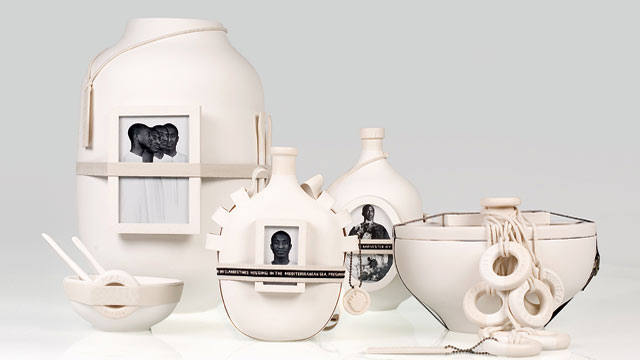
-
 Kerstin Pinther
Kerstin PintherMoulding Tradition (2009) is a work done by the designers Andrea Trimarchi and Simone Farresin of Studio Formafantasma: It consists of a group of five ceramics in different shapes and forms: boat-like bowls of various sizes, vases and bottles. Some of the maiolica objects display special attributes which refer to the sea and to rescue operations on the water such as a pair of paddles and lifebuoys. Others use ribbons, printed with historical and immigration data, to tie framed photographs and other ‘décor’ to the vessels. The project is informed by the tin-glazed maiolica from Caltagirone in Sicily – itself a result of the encounter with (Moorish) Islamic ceramic traditions in the eleventh and twelfth centuries, which in the following centuries triggered a technical and content-related process of adaptation. From the early modern age onwards, maiolica thus became “an excellent indicator and agent of design transmission across the globe” (Ajmar-Wollheim/Molà 2011, 17).
Among the ceramic vessels being produced up till now is the genre of the so-called teste di moro – vases that in a stereotypical, often grotesque and derogative manner depict the faces of people referred to as either ‘African’ or as ‘Arabic.’ In their original form as busts they most probably date back to the seventeenth century, when they were used as flowerpots to decorate balconies and terraces, suggesting an exuberant vegetation. By replacing this generic image with a black-and-white photograph of a known and thus named immigrant from Nigeria, Sofien Adeyemi, Andrea Trimarchi and Simone Farresin update the references and create a link to recent migration movements. A flask with an attached ceramic tile lists the names of the countries Adeyemi has traveled through on his way from West Africa to Italy. His (multiplied) portrait together with written information on present-day migration policies is attached to the ceramic form, thus literally adding a new level of meaning. Yet another wine bottle recalls fruit picking, predominantly done by migrant workers under harsh and exploitative conditions.
By introducing further elements of reality in traditional forms, Formafantasma with Moulding Tradition create complex discourses on the historical and present-day entanglements between Africa and Europe and the imbalance in their economic and political conditions. According to the designers, “contemporary public opinion polls have claimed that 65% of Italians believe that the immigrants are ‘a danger for our culture.’” In this context Moulding Tradition speaks of the blind spots of contemporary culture: Neither the explicit transcultural character of the maiolica which had contributed to – if not established – the fame of Caltagirone’s craft tradition is valued, nor are the descendants of those who once introduced this new ceramic technique welcomed. Moulding Tradition also alludes to the fact that in the most recent age of globalization nearly everything – data, information, images, objects – is free-flowing, but some people’s movements from specific geographies are monitored and restricted. Thus, it questions the ideology of cultural segregation and confronts it with the factual migration of people and goods as well as with the various historical entanglements. Furthermore, Moulding Tradition, for which the designers cooperated with a local craftsperson, can also be read as a comment on the role of craft in contemporary society as well as on the question of how craft is sometimes “locked into a tradition repeating [moulding, author’s note] the same objects over and over again” (Studio Formafantasma 2015). In order to counter this tendency, the designers left their products with a kind of raw surface, since normally maiolica ceramic is painted in bold colors after being dried thoroughly. In the case of Formafantasma’s maiolica, the objects remain ‘unfinished’ – a (blank) space to metaphorically be worked on and to open up a debate. Thus, Moulding Tradition stands for Studio Formafantasma’s conceptual and critical design-thinking approach. In this approach, the duo relies on textual information as well as on the haptic and aesthetic qualities of the substances they use: “[M]aterials are not only functional but also have the ability to evoke memories or to testify historical knowledge” (Studio Formafantasma 2015).
The authors of Global Design History make clear how the most recent phase of globalization not only accelerates flows of people, images, information, commodities and capital, but also contributes to the various types of exclusion and border control regimes (Adamson, et al. 2010, 1f.). At a time when design is becoming increasingly politicized, the question of how designers respond to the hitherto biggest wave of flight and migration in the years 2015/16 becomes obvious. Indeed, similar to Moulding Tradition, there are other design objects as well as works at the interface of design and art which can be seen as tools for reflecting on migration and flight. In using design as a tool, the migrancy reference can often be found on more than only one level. Besides its content-related presence, it is also tangible via the objects’ materiality or techniques, which for their part often bear traces of mobility and cultural transfer. Thus, these objects speak strongly to the historical and cultural migration of forms.
References
- Adamson, Glenn, et al., editors. Global Design History. Routledge, 2011.
- Ajmar-Wollheim, Marta, and Luca Molà. “The Global Renaissance. Cross-cultural Objects in the Early Modern Period.” Global Design History, edited by Glenn Adamson, Giorgio Riello and Sarah Teasly, Routledge, 2011, pp. 11–20.
- Studio Formafantasma. “Studio Formafantasma on Words as a Tool for Design.” Design Indaba Conference, Talk on November 3rd 2015, http://www.designindaba.com/videos/conference-talks/studio-formafantasma-words-tool-design.
published February 2020

-
 Dong Xiaoling
Dong Xiaoling"Father” is a huge portrait created by Luo Zhongli (born 1948) in 1980. The picture shows an elderly man with dark skin and fine wrinkles on his face wearing a white headscarf. He is holding an old bowl containing tea in both hands. The old man’s fingers are rough, there is still dirt embedded in his nails and there is dirty gauze wrapped round his fingers. He has only one tooth left in his mouth. In the wrinkles on his forehead, on his brows and on the end of his nose there are glittering beads of sweat. This is the typical image of industrious peasants in China.
The importance of farmers was of great significance in China in the 20th century. Mao Zedong's assessment of issues concerning Chinese farmers commenced with the establishment of the People's Republic of China in 1949. Before the founding of the People's Republic of China, the peasants were liberated through a political revolution centered on the Agrarian Revolution; after the founding of the People's Republic, the common prosperity of farmers was achieved through the modernization of rural socialism. The role of the farmer changed from a participant in the revolution to a builder of modernization. Farmers were an important political foundation in the Mao Zedong era. Even today, there are still about 600 million farmers in China.
As a result, most of the works depicting farmers were created after 1949. Regarding the painting “Father”, the portrayal basically conforms to the definition of ordinary farmers. With the change of context during history, the visual interpretation of identity is very much influenced by the opinions of the post-modern.
Farmers are considered to be the people society relies on for a living – that is the reason why the artist named his work "Father". The model for this work was a farmer in the Daba Mountains in Sichuan province of China. The Cultural Revolution began in 1966. Mao Zedong advocated that young people from the cities should go to the countryside to receive re-education through hard labor. In 1968, Luo Zhongli, who was studying at the High School attached to the Sichuan Academy of Fine Arts, went to the Daba Mountains and stayed there for nearly 10 years. One Chinese New Year's Eve he saw an old man squatting outside a public toilet, guarding a pile of faeces as if he were guarding something of great value.[1] This image of a peasant bearing the burden of humiliation made a deep impression on the artist's mind. In 1980, when the artist was a student[2] at the Sichuan Academy of Fine Arts, he created his work “Father” by combining the image of Deng Kaixuan[3], an old man who was the artist’s landlord in the Daba Mountains , with the memory of the old man who had been guarding the pile of faeces. In 1981, Luo Zhongli was awarded the gold medal in the Second Chinese Youth Art Exhibition held in Beijing.
Controversy caused by "Father"
Today, the people viewing this large-size portrait may not be able to imagine what the people felt 40 years before when they stood in front of the large-size portrait “Father” for the first time. Those people experienced a visual shock and an impact to their values when they first saw this over 2-meter high portrait of a farmer. At that time, people were used to seeing the huge portraits of Mao Zedong or Marx only, and the monotonous idealized paintings of workers, farmers and soldiers.
During the Cultural Revolution, works of art were of the "revolutionary romanticism" style that is red, light, bright, tall, large, and full. A picture was required to contain brightness and sunshine as well as strong colors, especially red, and even shadows were not allowed to be painted in cool colors. The characteristics of such a picture is vividness and fine detail, and there are almost no traces of the brush. The themes of the works are mainly revolutionary idols and the history of the revolution. In this artistic style the happiness and prosperity of the country and the people are praised. This form of painting depicts a paradise full of sunshine and no pain, a utopian world of social optimism and revolutionary idealism. The depiction of Mao Zedong was always as an extremely tall well-built man in the center of the picture, in fact completely the image of a supernatural god. Mao Zedong was worshipped as an idol.
As an intellectual, Luo Zhongli had his own interpretation of this. "True and benevolent farmers and the like make me feel that there are people whose nature is unpolluted. The people are simple, honest, rustic. ‘Men of the earth’ with soil permanently under their fingernails. This kind of simple, down-to-earth nature often makes me feel ashamed".[4] The artist makes use of a huge portrait, a method traditionally used in nation leaders' portraits to express their sympathy, empathy and respect for ordinary farmers. At the same time, the artist tried to use painting to explain two kind of "truths", the moral truth and the artistic truth. This method is to use the truth of art to criticize the hypocrisy of morality. At the time this was however dangerous and controversial.
In fact, even for a long time after the smashing of the “Gang of Four” in October 1976, the “Mind Emancipation" had not really begun. At the Third Plenary Session of the Eleventh Central Committee of the Communist Party of China held in December 1978, the Communist Party of China clearly showed that the core of their work would be shifted from class struggle to the economic construction of modern socialism. However, at this time people's minds had still not been completely liberated from the shackles of the Cultural Revolution. Regarding the standard of artistic "authenticity", artistic creation at this time was still following the logic of the Cultural Revolution.
Shao Yangde (Chinese art theorist at this time) wrote an article in 1981 titled "Creation. Appreciate, comment, read "Father" and discuss with relevant reviewers"[5]. The article triggered a wide-ranging, long-lasting and intense academic debate on the field of Chinese art theory. Shao Yangde believed that "Father" showed the image of a farmer of the old society: numb, passive, sluggish. Therefore the painting gave the impression that farmers were submissive and pessimistic. He accused the artist of not injecting "noble revolutionary ideals" into "Father". "The image vilifies the peasant”. In fact, the living standards of Chinese farmers had nearly reached rock bottom during the Cultural Revolution while the political theorists were trying to convince the farmers that they were the masters of society and lived in paradise. This view also proved that between 1976 and 1980, many people in China were still living in utopian dreams and were unwilling to recognize reality. Luo Zhongli's "Father" shows a strong critical realism opposite to the rigid thinking at that time.
A dramatic irony is that before the work was sent to Beijing to join the Section 2 National Youth Art Exhibition, at the insistence of Li Shaoyanchairman of the Artists Association of Sichuan Province, Luo Zhongli replaced the cigarette that was originally behind the left ear of the farmer with a ballpoint pen (image below). In this way he showed that the man was an educated farmer with noble ideas in the new era. The artist's compromise was in the hope that his work would pass the intensive political investigation before a work of art was accepted, and thus been sent to Beijing. However, this modification shows the great irony of utopian fantasy.
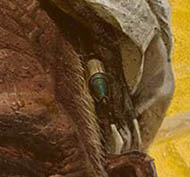
Luo Zhongli, 1980, detail © Luo Zhongli
When the works were successfully exhibited in the National Art Museum of China in Beijing in 1981, “Father”, the image of a farmer who endures the suffering and never complains, deeply moved hundreds of millions of people. The huge size and the hyperrealism of the picture were extremely fresh but tacit to those Chinese people who saw the work at the museum. Li Xianting, the editor of the official media "Fine Arts" magazine at that time, was also moved by the human compassion shown in the work. For this reason, in 1981 he used "Father" as the cover of the magazine. Only through the undisguised expression of reality can art find the truth it has lost.
Changes in social thinking after "Father"
In terms of artistic language itself, China originally had its own context of development and its own system of language. However, Chinese art since 1949 has been mainly influenced by the realistic art of the former Soviet Union, coupled with the Cultural Revolution’s censoring of the traditional Chinese context and the ban on Western contemporary art. Under the influence of this aesthetic inertia, representational realism has become the most acceptable visual narrative method for the public.
Luo Zhongli was inevitably influenced by the American photorealist Chuck Close at that time. However, instead of deliberately hiding traces of personality, emotion, and attitude to create a flat and indifferent picture as Chuck Close did, Zhongli added these feelings to his picture. "I feel that this form is most conducive to powerfully conveying all my feelings and thoughts. The arts of the East and the West have always absorbed and been influenced by each other. Forms, techniques, etc. are just the language that conveys my emotions and thoughts. If this particular language can say what I want to say, then I will learn from it.”[6] The artist seems to have used a more calm and objective approach, but made the most subjective elucidate of a farmer in the work "Father".
To the general public at that time in China, Chuck Close and modern art in Europe and America were unfamiliar and so far away. Even at the Sichuan Academy of Fine Arts, the school had bought a Japanese-published "Complete Works of the World" but it was locked in a cabinet. The students had to press their faces against the window, brush the condensation from their breath off the glass, and view the book as they would a cultural relic in a museum. Such a book would take 1-2 months to read and absorb –but only under such conditions it was possible to read about Western modern art.
For a period of time after this work, a group of artists who were contemporaries of Luo Zhongli returned to their innermost selves in pursuit of their own spirits and emotions. They became more willing to pay attention to people's daily life, and wanted to explore and express the beauty of human nature in ordinary life. The spiritual essence of their paintings was the continuation of the humanitarian sentiment.
It is precisely because of the success of “Father” that the artist was sent by the government to study at the Royal Academy of Fine Arts in Antwerp, Belgium at the end of 1983. He developed a comprehensive and deep understanding of European art and phenomena. Later, he held a personal exhibition at Harvard University in the United States, and thus gained a wide international reputation. Since then, his use of different techniques to express the language of painting has become more pioneering and expressive.
In addition to reflecting on and breaking through the constraints of the political dogma on art, Chinese artists are eager for artistic change. Art theorists have begun to introduce and translate a large number of works on the history of Western modern art, for example Herbert Read‘s: A Concise History of Modern Painting (1979), H. H. Arnason’s History of Western Modern Art (1986) and many more. In the 1980’s, influential art newspapers such as "Art" (reissued in 1976), "Art Translation Collection" (founded in1980), and "World Art" (founded in 1979) began to publish articles on a large number of Western modern art genres and artists. Faced with the influence of foreign culture as well as domestic social pressure to achieve modernization, the ruling party has adopted a more accepting attitude.
Precisely at that time, Western modern art and post-modern ideas came together and quickly merged in China. There is 1985 Art Trend[7] movement, the 89 Art Exhibition[8] etc. So far, Chinese modern art has entered the experimental stage on a large scale and has been continuously reconstructed.
However, what is significant is that the village in the Daba Mountains where the artist once lived has now lost its former prosperity. As villagers have started to go to work in cities across the country, the village has become very glum and mediocre, in sharp contrast to the prosperity of the cities. And those farmers who have moved to the city are also working hard to transform themselves into a part of the city. Farmers, who once held an important position in China's social structure, are now gradually being urbanized under the drive of the market economy, and are being marginalized in the city.
References
- Michael Sullivan, Art and artists of Twentieth-Century China, Shanghai, 2012
- Gao Minglu, Chinese Avant-Garde Art, Jiangsu Fine Arts Press, 1997
- LvPeng YiDan, The Art History of China Since 1979, Beijing, 2011
- WangYong, A History of Art Exchange between China and Abroad, Beijing, 2013
Footnotes
[1] During the Cultural Revolution, China's economy was extremely weak and faeces was the most important source of fertilizer in rural areas at that time.
[2] During the 1966-1976 Cultural Revolution, universities stopped accepting students, and the college entrance examination did not begin again until 1977. Luo Zhongli was admitted to the Sichuan Academy of Fine Arts in 1977.
[3] Deng Kaixuan was a farmer in the Daba Mountains. Luo Zhongli lived in the farmer’s home when he was in the Daba Mountains. Deng Kaixuan was also the model for the painting "Father". He has passed away now.
[4] Gao Minglu, Chinese Avant-Garde Art , ( Jiangsu Fine Arts Press,1997)P70
[5] “Fine Arts" Magazine, (Beijing,1981)Issue 9, P57
[6] "Fine Arts" Magazine, (Beijing,1981)Issue 2, Page 4
[7] The 85 Art Trend refers to an art movement towards modernism that emerged in mainland China in the mid-1980ies. The young artists at that time were dissatisfied with the line of leaning to the left of the art world at the time, and with the Soviet socialist realism art stereotypes as well as some values in traditional culture. They tried to find new blood from Western modern art, which triggered a nationwide art trend.
[8] 89 Art Exhibition, "Chinese Modern Art Exhibition" held at the National Art Museum of China in Beijing in February 1989. This is the first exhibition of concentrated Chinese avant-garde art including performance art and installation art. The artist Xiao Lu shot her installation "Dialogue" and the exhibition was forced to terminate. The shooting incident of "Dialogue" has therefore become a symbol of the 89 Art Exhibition and has an important position in the history of modern Chinese art.
published September 2020
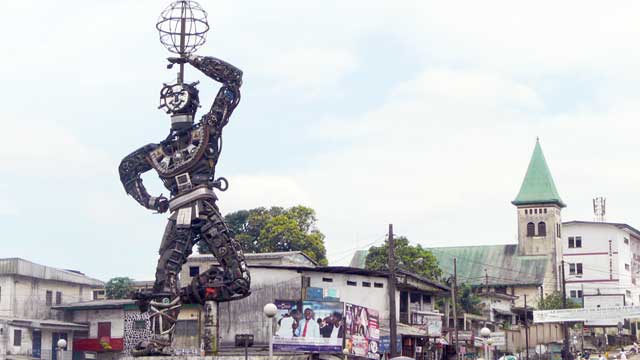
-
 Paul-Henri Souvenir ASSAKO ASSAKO
Paul-Henri Souvenir ASSAKO ASSAKOThrough its form, it reveals the modern urban context, a composite universe whose harmony is constantly negotiated in the logic of the delicate assemblages that characterizes the artist's technique. The work also reveals the socio-cultural mutations of which the artistic practice becomes an expression with its new form. Through the processes of recycling and assembling industrial waste, through the monumental appearance of a work whose silhouette recalls a human figure, through its installation on a roundabout, La Nouvelle Liberté brings together the elements of a manifesto of the transformation of cultural practices and particularly of the visual arts in the second half of the 20th century in Cameroon.

Screenshot from the entry about Douala on Wikipedia
This sculpture is special because of the context in which it was created. The commissioning of the work was part of the first projects of the very first and almost unique contemporary art center in Cameroon, doual'art (1991). The Centre was born in the aftermath of the adoption of the law on freedom of association (law No. 90-53 of December 1990). The approach to artistic promotion that it adopts is defined by the principles of artistic act-action-activism as the main modalities of intervention in the city of Douala. It is in this approach that doual'art commissioned the sculpture from Joseph Francis Sumégné.
Doual'art's artistic project SUD2017 (Link) is a clear expression of the freedoms to which Cameroonian society ardently aspires, according to the president of doual’art, Marilyn Douala Bell. She describes its context as follows: “while the project’s gestation began in 1981, after the election of Francois Mitterrand as president of France, the two principal triggers occurred in the 1990s in Cameroon: firstly, socio-political movements incited the people to seize the street and reclaim “democracy” and, secondly, there was the promulgation of December 1990 law authorized freedom association for the first time in this country” (I. Pensa & al., 2017, 9).
Nouvelle Liberté is one of the major works that marks the transformation of artistic practice in Cameroon which now focuses on the contemporary national society in its various historical, socio-cultural, political and economic aspects. The work takes a great conceptual dimension; it draws material from the field of negotiation and change of cultural meanings in the same context that inspires the image it reflects. For Sabine Breitwieser “for many this field has become the basic practice, focusing on actions and processes along the connecting line between the arts, everyday life, and politics” (A. Alberro & S. Buchmann,2006, 9-10).
Joseph Francis Sumégné explores the urban world both from the material and the conceptual perspective. According to Joana Danimbe (2021), the city is a field of experimentation that affects the work of this artist. The process of making the work and its title place the observer in a critical relationship with urban modernity. The sculptural work echoes the city in which it is erected. It echoes it by its constructed form through a process of assembling diverse heterogeneous elements, industrial waste (plastics, metals, alloys of all kinds) that the city has difficulty in absorbing.

Sumégné, Nouvelle Liberté, Detail (Creative Commons)
The difficulties posed by the management of industrial waste is only one aspect of the work, which questions the impact of the accelerated modernity of the mentalities of city dwellers, which Yakouba Konaté notes as new and characteristic in African cities (Assako, 2011, 103). In this context of modernity par excellence, it is difficult to guarantee the harmonious development of those who live there. The latent tribal and communal tensions in these cities are a sufficient proof of the fragility of this harmony. For example, the nickname "Nju Nju (evil spirit) of Deido” given to Sumégné's work highlights some aspects of the limits of collective integration posed by the cities. The artist reminds us that: “this negative designation is based on the strong protests voiced by native populations against La Nouvelle Liberté. After these first polemics, mainly concerned with aesthetical features of the sculpture, a violent controversy was raised by the media on the origins of the artist (who hails from the western part of Cameroon) taking the fold of an ethnic struggle between the indigenous people of Douala. For such reasons, La Nouvelle Liberté was officially inaugurated only eleven years later, during SUD 2017” (I. Pensa & als., op cit., 93).
The city of Douala, the economic capital of Cameroon, makes the facts of social and cultural transformation, industrialization and related issues in Cameroon remarkably appreciable. Douala is the most important port city in Cameroon and Central Africa. It is a city of great industrialization. The economic opportunities offered by the city make it a real national and international pole of attraction and an important migratory drop-off point as well. The city is therefore a center of great demographic concentration and mixing. It is reputed to be the most polluted city in Cameroon due to its industrial and economic activities and its human density. It is also the city most exposed to social implosion due to the high number of young people who find themselves in precariousness and in search of decent employment. The balance of urban life depends on the city's capacity to promote a process of integration which leads to the construction of a collective identity.

On the right: J.NicolasKondaYansa. Vue aérienne de Douala (Creative Commons).
This is the phenomenon that the image of Sumégné's work has succeeded in bringing about in Cameroon over the past twenty years. It has crossed the phase of rejection and critical questioning to become the object of collective appropriation and an emblem for the Douala people in particular and the Cameroonians in general. "By recovering rejected objects, the artist becomes by force of circumstances a full-fledged actor in the organization of urban life, sharing the basis of his innovative thinking on the relationship between cities, cultures, representations of working-class neighborhoods and environmental ecology. “In his thinking, the city is a place where the intimate (the family side, religion and its rites) and the universal (openness to other cultures within the city) meet” (Joana Danimbe, op cit., 33).
However, this collective identity is not given. There are permanent conflicts between rural and urban, rich and poor, order and anarchy, libertinism and freedom, civic-mindedness and uncivil behavior, etc. For politicians, however, national development is expressed through actions that are generally in vain and aimed at giving a 'modern' appearance to cities. It should be noted, however, that the urban ecosystem, on a social level, lives on the permanent 'daptaïsme[1]' (S. Andriamirado, 2002) of city dwellers in search of a balance between the socio-economic and political references of Western modernity and those relating to the various local customs that are superficially apprehended. In such a context, flourishing in the city takes its trajectory from inventive intuitions as demonstrated by Sumégné in the process of shaping La Nouvelle Liberté. The artist's bold work imposes itself on the city dwellers in the form of a new experience. He magnifies this experience through the novelty and singularity of the codes of representation of his artistic work. The elements offered by the city and used by the artist to create his works are chosen on the basis of two main values: they are true generators of ideas and they are inspirers of structures.
The verticality of Sumégne's work is evident at the Deido roundabout, which is one of the main entries of the city of Douala. The sculpture has a human silhouette and stands on a concrete pedestal. Its posture describes a movement whose balance is suggested by an asymmetrical gesture and a distribution of masses and volumes in relation to the vertical axis. The ascending tension of the monumental sculpture is supported by the base of the right foot, crosses the trunk, the head and ends on the globe which caps the upper end of the work. The movements described by the limbs make the sculpture even more dynamic. The bent left leg crosses the right leg at knee height from behind. The position of this leg structures the pelvis and the part above the knees of the figure in a truncated cone shape. The upper left arm is raised above the head to hold the globe and the right arm is bent and oriented as if to rest on the hip with the fist closed.
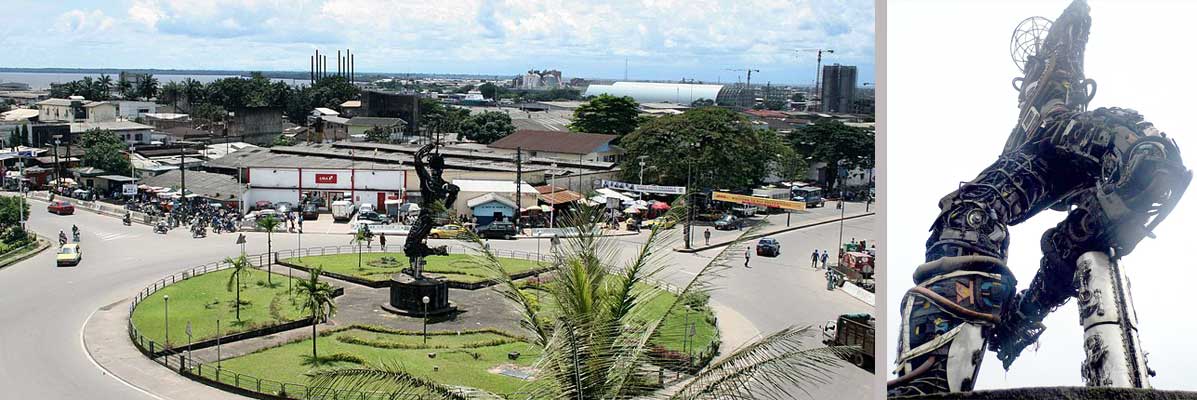
Steve Mvondo, NadègeNN: Sumégné, Nouvelle Liberté (Creative Commons left / right)
A dynamic posture that gives the work pride of place, but also conveys a sense of fragility. This proud appearance is further suggested by the expressiveness of the statue's circular head, which draws a smiling face or a sun. The attention paid to the elegance of the statue can be seen in the details of the adornment on the work. The neck is outlined with a grey band that acts as a necklace. The same band is used to define the belt worn by the figure. A sort of waistcoat covers the figure's torso and contributes to the attention to the adornment being a characteristic detail of the work. The care given to the detailed elaboration of this kind of waistcoat enhances the drawing, engraving, upholstering, painting and sculpting skills, which allow the artist to easily interweave the traditional with the modern and the modern with the traditional through the technique. The technical game describes a stirring of the memory in which Sumégné crosses the past and the present in a delicate process of balance, harmony and construction of a work of art that the work gives to appreciate.
The accelerated modernity of mentalities is accompanied by deviations rather than guaranteeing the expression of freedoms favorable to the construction of a collective identity and a more social dimension of the meaning of development in the cities. The Cameroonian city must cease to be a mere showcase for political celebration / instrumentalization and a springboard for socio-professional accomplishment for city dwellers and become the real space for a new life, a sustainable life. Art, as illustrated by Nouvelle Liberté, has embarked on this path by investing itself materially and conceptually in the urban environment: The contemporary art scene in Cameroon's economic capital, which is one of the most active and committed in urban Africa, is itself in constant movement. Objects, ideas and practices are given new meanings on a daily basis, often politically, and which, like “La Nouvelle Liberté", highlights questions of identity, the right to speak and self-determination (D. Malaquais, 2006, 122).
Published 2020
References
- Alberro Alexander & Buchmann Sabeth. 2006. Art after conceptual art, Vienna, Austria, Generali Foundation, pp.9-10
- ANDRIAMIRADO Virginie. 2002. « Tout est prétexte à la création », entretien avec Ndary Lo, in « Africultures, n° 48 » Éditions l’Harmattan, 63-67
- Assako Assako PH.S. 2011, l’art au cameroun du XXe au début du XXIe siècle : étude des expressions sculpturales en milieu urbain, thèse de Doctorat/Ph.D. en histoire de l’art, Université de Yaoundé
- Danimbe Joana.2021. Joseph Francis Sumegne, le méditoire du Jala’a, Paris, Ed. Fondation Blachère
- Dominique Malaquais, « Une nouvelle liberté ? Art et politique urbaine à Douala (Cameroun) », Afrique & histoire 2006/1 (vol. 5), p. 111-134.
- Lagnier Sylvie. 2001. Sculpture et espace urbain en France, histoire de l’instauration d’un dialogue 1951-1992, Paris, Ed. l’Harmattan
- Pensa Iolanda & als. 2017. Public art in Africa, Genève, Metis Presses
[1] Vocabulary borrowed from the Senegalese sculptor NDARY LO, who designates "daptaïsme" as a philosophical principle on which his art is based, and which consists in adapting to everything and in all circumstances. The artist collects salvaged objects that he diverts and manipulates according to the circumstances of his creation. So, the urban ecosystem adapts and cobbles together alternative solutions on a day-to-day basis.
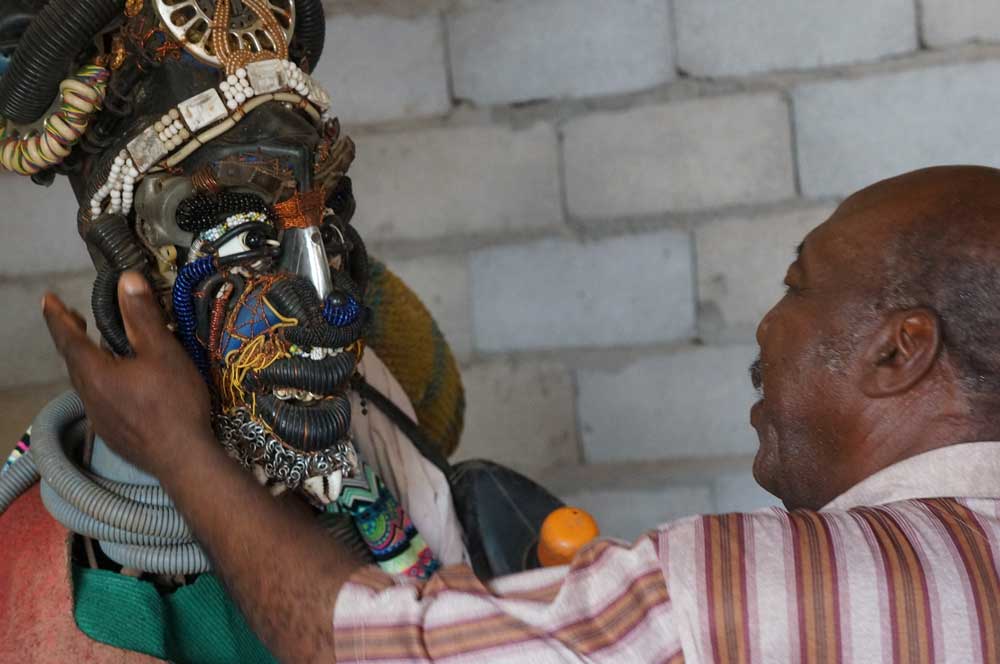
The artist working in his studio 2019 (Photo Ernst Wagner)
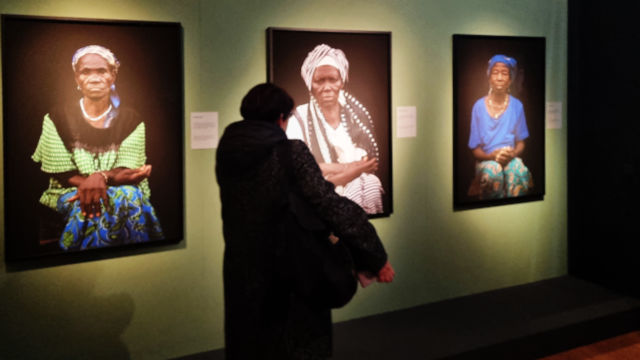
-
 Osuanyi Quaicoo Essel
Osuanyi Quaicoo Essel‘Witches in Exile’ Exhibition at Museum Fünf Kontinente: Advocacy or cultural exploitation?
In June 2024, Museum Fünf Kontinente, located at the heart of Munich, held an exhibition themed “Witches in Exile.” This exhibition dwelled on the photodocumentary of German-French artist Ann-Christine Woehrl and her African collaborator Senam Okudzeto. The duo visited Gushiegu and Gambaga townships in North East, and Northern regions, respectively, and other parts of Ghana between 2009 and 2013 for the said portraits of women alleged to be witches. The exhibition attracted approximately 12,000 visitors during its run and extended its original closing date due to public interest. This article analyses the cultural and ethical issues the exhibition raises and questions the motives behind it.
In some Ghanaian communities, the accusation of witchcraft is rooted in certain cultural beliefs and practices. The practice of witchcraft and sorcery is part of indigenous Ghanaian customary practices. Article 26(1) of the 1992 constitution provides that ‘Every person is entitled to enjoy, practice, profess, maintain, and promote any culture, language, tradition, or religion subject to the provisions of this Constitution.’ This clause implies that Ghana has cultural pluralism and does not suppress any indigenous culture. However, the constitution disapproves of any cultural practices that diminish people's dignity and dehumanise them. With regard to the practice of witchcraft, there are reports of people accused of witchcraft across Ghana who have experienced witchcraft-related violent attacks, stigmatisation, banishment, and in some cases threats to their lives (Actionaid International, 2012; Musah, 2013; Roxburgh, 2016; Badoe, n.d.). Some communities in northern Ghana have established safe havens for individuals accused of witchcraft. Scholars and actors have found that the witch camps are not ‘prisons’ but rather served as refuge for the alleged witches and wizards (Mutaru, 2018; Musah, 2013; Actionaid International, 2012).
Subsequently, there have been governmental efforts to legislate against the practice. Article 26(2) of the 1992 constitution of Ghana provides that ‘All customary practices which dehumanise or are injurious to the physical and mental well-being of a person are prohibited.’ In line with this constitutional provision, there is a bill in parliament under consideration. Apart from that, the Ghanaian society largely condemns instant justice and frequently calls on security agencies to bring culprits of violence against people on the basis of alleged witchcraft to book.
The Museum Fünf Kontinente disclosed on its website that showing the ‘Witches in Exile’ Exhibition was based on the political brisance of the topic in Ghana and the critical discourse in the country about witch hunts and the closure of the ‘witch camps’ (Museum Fünf Kontinente, 2024). On the contrary, the exhibition seems to have an ulterior motive of perpetuating the neocolonialist agenda of painting a grotesque image of Africa’s Ghana to prolong its imperialist and neocolonial domination. This has been the colonialists’ style of framing Africa to a global audience (Nkrumah, 1963). There are ethical contradictions that reveal the negative intent of the museum in showcasing this exhibition. Both the artists (Ann-Christine Woehrl and Senam Okudzeto) and the museum, in my view, flouted ethical standards and made the alleged women witches less dignified in the eyes of right-thinking people in the society. The way the exhibition was framed ran the risk of sustaining the very injustices it was claiming to eradicate. The photographs reduced complex socio-political crises, which have their roots in poverty, gender violence, and colonial legacies, to personal spectacles of suffering by isolating the women as symbols of "resilience." Instead of placing the structural factors that allowed their persecution in context, this strategy strengthened the stigma associated with being a "witch," enshrining their identities within a victim narrative. Under Ghanaian law, such an exhibition frowns upon the dignity of the women. It would not be tolerated, most especially for an educative institution such as a museum charged with the mandate of educating the people in a constructive way. Showing such an exhibition would be an affront to Ghanaian cultural standards.
Woehrl experienced trust with those women who participated, transitioning from "stranger to confidante"; nonetheless, there was a lack of proof of sustained consent for the worldwide museum exhibition. A question that begs for a response is: Were the women informed that their photographs taken under the guise of NGO work and support were going to be exhibited in a European museum? Since they are not illiterates, was it explained to them in the language they understand? Once the women's photographs were turned into art, they were curated by Europeans. This is similar to how colonial powers objectified marginalised bodies for Western viewers, depriving the women of control over their portrayal. Showing the women's photos in Munich, which is far from Ghana's legislative battlegrounds, turned their suffering into an exhibit that others could buy. The museum's focus on their "isolation" and "pride" ironically made them more likely to be accused of witchcraft.
The artists' claim to "give voice" conflicted with its power disparity, with a European photographer and a diaspora artist (Okudzeto) articulating African suffering for mostly White audiences. The museum's past as an ethnological institution that helped with colonial objectification made this situation even more awkward. Although the museum included West African perspectives, the primary location of the exhibition in Europe emphasised a Western viewpoint, transforming injustice into an artistic experience.
When you think about whether the photographers would put their families through the same thing, their humanitarian rhetoric does not hold up. It would be difficult to imagine showing a mother's anguish to people across the world without knowing that she would be able to go back to society or have influence over how she is seen. This contradiction highlights a more serious moral failure; the women have less freedom in the name of "awareness." The exhibition's legacy is yet unclear. Did it provide the women more authority, or did it make them feel like they were always exiles, stuck in Munich's galleries as symbols of "woe"?
Understanding the customary practices helps us understand the cultural and social contexts and the efforts of Ghana’s government to curb them through legislation. The practice of witchcraft and sorcery remains one of the cultural beliefs in Ghana. The phenomenon has attracted increased research interest in the quest to understand, reinterpret, and question the practice of keeping ‘witchcraft camps’ for alleged witches and wizards. Musah (2013) explored the experiences of the fifteen alleged witches, comprising thirteen women and two men resident in the Gnani witch’s camp in the northern sector of Ghana. The study revealed that the camp serves as a refuge for the alleged witches and wizards and not a ‘prison’ as perceived by the public. Their thoughts of the witch camp as a haven of refuge are owing to the fact that they face being stigmatised and attacked, which puts their lives in danger even after being exorcised and cleansed from alleged witchcraft as demanded by indigenous cleansing and ritual. For these reasons they remain in the camp instead of going back to their original communities.
Yaba Badoe (n.d., p. 95) shared the obstacles encountered in the documentary film The Witches of Gambaga. Badoe questioned the ulterior motive of some Western broadcasters and scholars in portraying issues of fighting alleged women’s witchcraft issues in Ghana, saying that though their Witches of Gambaga documentary was situated in the broader context of the women’s movement in Ghana and its ongoing campaigns to expose and stop all forms of violence against women, Western-based broadcasters had negative agendas and priorities. The obstacles included the complicated politics of representation in and beyond contemporary Ghana in the context of reproduced images that were given currency by ‘Western-based broadcasters, who operate according to their priorities and agendas, not those of African feminists experimenting with the media they have dominated for so long.’
"Witches in Exile" effectively illustrates the delicate balance between documentary art and ethical infringement. It by no means mobilised people to support Ghanaian women and for legislative purposes as it claims; rather, its techniques have made the dehumanisation it spoke out against worse. The photographers' insistence on "resilience" did not address the fundamental injustice of converting real individuals into artefacts for European consumption, so perpetuating their marginalisation under the pretence of solidarity. In addition, the bodies of the women with exploited in the name of exhibition for financial gains. As the pictures grace the museum, the women's consent, dignity, and healing remain in the shadows.
Published August 2025
References
- Actionaid International. (2012). Condemned without trial: Women and witchcraft in Ghana. Actionaid.
- Amuzuh, J. (2021). Report on alleged witches’ camp in Ghana – June 2021. The Sanneh Institute.
- Badoe, Y. (n.d). Representing Witches in contemporary Ghana: challenges and reflections on making the ‘Witches of Gambaga’. Feminist Africa, 16, 82-97.
- Mutaru, S. (2018). An anthropological study of ‘witch camps’ and human rights in Northern Ghana. In Green MC, Gunn TJ & Hill M (eds), Religion, Law and Security in Africa. Stellenbosch: Conf-RAP.
- Museum Fünf Kontinente (2024). Witches in Exile. Photographs Ann-Christine Woehrl.
- Installation Senam Okudzeto. https://www.museum-fuenf-kontinente.de/ausstellungen/r%C3%BCckblick-auf-unsere-sonderausstellungen/witches-in-exile-english/
- Musah, B. I. (2013). Life in a witch camp: Experience of residents in the Gnani witch camp in Ghana. (Mphil Dissertation). Universitas Bergensis.
- Pierre, S. (2018). Human rights violations and accusations of witchcraft in Ghana. 6(1). McGill Centre for Human Rights and Legal Pluralism.
- Roxburgh, S. (2016). Witchcraft and violence in Ghana: An assessment of contemporary mediation efforts. Cahiers d’Études africaines, LVI (4), 224, 891-914.
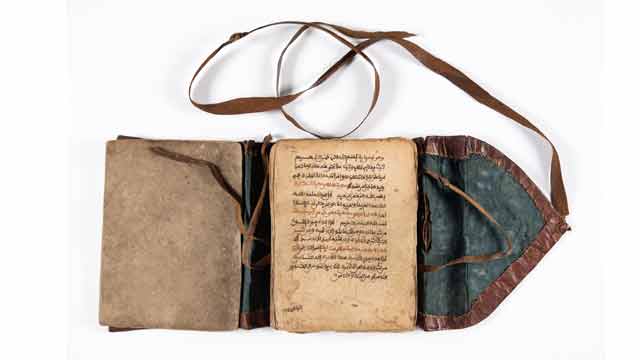
-
 Mahmoud Malik Saako
Mahmoud Malik SaakoThe Qur'an is typical for the time and the West African region in general. The idea originated in North Africa such as Morocco and Algeria. But the writing was later, influenced by the Hausa and Mande scholars in West Africa. The texts in this Qur'an are the same as the original from Arabia. But there are differences in the kind of calligraphy found in these Qur'ans and those found in Arabia. One important aspect of these Qur'ans is the calligraphy that comes after the beginning of a new chapter or Surah. Again, the use of red, gold and black colour in writing the Qur'an makes them unique.
Artistic features of the Qur'an
- The leather cover used to protect the Qur'an was designed with some relief using black ink. It shows that leather workers were very important in society. Similar covers are made but in a form of a bag for the Qur'an while others are wooden covers with a leather thong used to hold the wooden covers together with the Quran.
- The Holy Qur’an has Ayahs (words or verses) and Surahs (chapters). There is Bismillah before each Surah. The Qur'an has 114 Surahs or chapters.
- Calligraphy works in some portions of the Qur'an. Calligraphy as the art of beautiful, decorative writing has existed in Islam since the word of God, the Qur'an, began to be written. In West Africa which was known to the Muslim world as Bilad-al-Sudan (land of the blacks), Islamic calligraphy naturally came with Islam. They are just symbolic to honour the holy text.
- The use of three colours in writing such as gold, red and black: This shows how versatile the person was in giving an artistic impression of the Qur'an based on the Kanemi
- A large decorated sign known as shurafah (ennoblement) is written at the end of every fifteen hizb (that is the division of the Qur’an into parts and portions). This is done as a means of honouring the holy text. (See images below.)
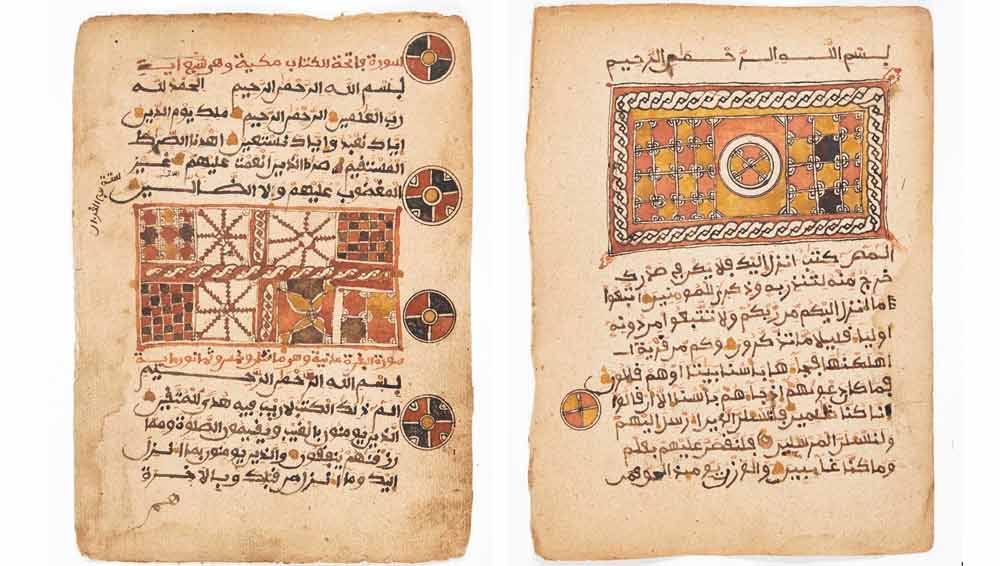
The shurafah or ennoblement at the beginning or end of a chapter (surah) is indicated in the two images. The gold, red and black colours are used to give it a splendid look. (Qur’an. 16th-17th century. Mossi in Togo. Museum Fünf Kontinente Munich. Courtesy Museum Fünf Kontinente. Nr. 20-3-1. https://onlinedatenbank-museum-fuenf-kontinente.de/detail/collection/b77d064f-c603-493c-af03-fc167f739586. [Stand: 08.08.24]. Photo: Nicolai Kaestner)
Material used for the Qur'an
The paper used is brown and a bit hard as compared to today’s paper used for printing. The ink is mixed in a variety of colours. There is jet-black ink that shines. Then there is a colour of black mixed with red and another colour which is neither black nor red. The ink is obtained through the following method. The roots of the desert date tree are collected and burnt into charcoal. This charcoal is then scraped into fine powder. The powder is filtered through a light piece of cloth. Water and gum Arabic are then added and the whole mixture is left to warm up in the sun. The mixture once prepared in this way gives out a very nice smell and its taste is very sweet.
Another method employed to produce the calligrapher's ink is to obtain the chaff of bulrush-millet (Pennisetum Spicotum), chips of the gum-yielding acacia (sieberiono), pods of the plant Egyptian mimosa (Acacia Arobico), slag from smithy and some bits of iron. All these items are then mixed with water. The mixture is filtered and boiled and once it is cooled it becomes ink. If the calligrapher wants a reddish colour or magenta colour imported dye of green or magenta colour is added. This type of ink is meant for the writing of the alphabet only and is always done in pure black. The ink is usually stored in small clay ink pots or small round gourds. The recent time, the ink is kept in small bottles.
What are the general specifics of these early Qur’ans?
The Qur'an is the holy text of the Islamic religion. In Islam, the Qur'an is believed to be the book of God’s words. The holy text remains sacred and unchanged since the beginning of time. The Qur'an is known as the most powerful text in Islam. Islam is a monotheistic faith and people of the religion take great pride in believing in pure monotheism. As followers of the Qur'an, Muslims must believe there is no one else besides Allah because Allah is the only one we worship sincerely, thus he is seen as the most powerful figure in the religion of Islam.
The Arabic text of the holy Qur'an in a book is known as the mus-haf (literally "the pages"). There are special rules that Muslims follow when handling, touching, or reading from the mus-haf. The Quran itself states that only those who are clean and pure should touch the sacred text. It is indeed a Holy Quran, a book well-guarded, which none shall touch but those who are clean... (56:77-79). The Arabic word translated here as "clean" is mutahiroon, a word that is also sometimes translated as "purified."
It was only Muslim believers who are physically cleaned through formal ablutions should touch or handle the pages of the Quran. Again, the Qur'an should be closed and stored in a clean or respectable place. Nothing should be placed on top of it, nor should it ever be placed on the floor or in a bathroom. Furthermore, when copying the Qur'an by hand, it should be legible with good handwriting. If you are reciting it you need to use a clear and beautiful voice. A worn-out copy of the Quran, with broken binding or missing pages, should not be disposed of as ordinary household trash.
Acceptable ways of disposing of a damaged copy of the Quran include wrapping it in cloth and burying it in a deep hole, placing it in flowing water so the ink dissolves, or, as a last resort, burning it so that it is completely consumed. But the translated Qur'an according to some scholars can be handled either by Muslims or non-Muslims.
Uses of the Qur'an
The Qur'an is meant for reading or recitation known in Arabic as taliwa. The recitation of the Qur'an is a highly honoured performance in Islam in which Allah blesses both the reciter and the listener. A person who memorizes the whole Qur'an is given the honorary title of a Hafiz (memorizer of the Qur'an). Again, the reproduction of the written Qur'an is as important as oral recitation. Two early calligraphic styles evolved in the writing of the Qur'an, Kufic (the more boxy, angular, heavy, and formal script) and Naskhi (the more elongated, rounded, cursive script).
The words in the Qur'an are regarded as the words of Allah and, therefore, handled with respect. Muslims also hold the view that some of the words contain mystical properties and as a result, Muslim religious scholars are sometimes consulted by people who have spiritual or psychological problems. They write verses from the Qur'an to ward off such evil spirits or for protection. The Qur'anic verses are often accompanied by diagrams drawn on a board and then washed off and given to the client to drink. As a result, these boards have high values based on the extent they have been used. It is believed that the older the board the more efficient it would be and vice versa.
At the Museum, there is one of the Qur'anic writing wooden boards that have verses from the Quaran on one side and diagrams on the other side. This board is brown and round at the base with a handle in a form of an animal beak. The surface is smooth while some old writing has remained and can be seen (see image below).
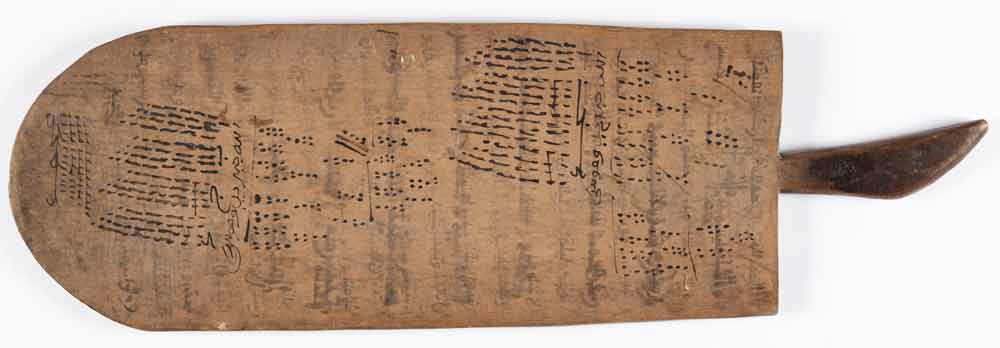
Board (Courtesy Museum Fünf Kontinente. Nr. 9-48. Photo: Nicolai Kaestner)
Where is the Qur’an kept?
Old Qur'ans were usually placed in two wooden covers before the use of leather cases or bags. It was easy to carry it once it was placed either in the wooden covers or in the leather bag. This is very important not to mess up the loose papers of the Qur'an. The two wooden covers after the Qur'an is placed and bound with a thong. There are two holes in the middle edge of the covers where the thong is passed through to bind the two wooden covers with the Qur'an. This method of bounding the Qur'an with wooden covers was practised during the early Abbasid period. Many of the early Abbasid manuscripts were copied into several volumes based on the Kufic script which was fairly heavy and not very dense. The Qur'ans of this early period were bound in wooden covers, structured like a box enclosed on all sides with a movable upper cover that was fastened to the rest of the structure with thongs. In this period, the Quran was arranged into 20 Juz or parts instead of the original 30 Juz during the Umayyad period. These wooden covers can be found at the Museum Fünf Kontinente (Inventar Nr 15-17-148).

Wooden cover of a Qur'an. Museum Fünf Kontinente. (Courtesy Museum Fünf Kontinente. Nr. 15-17-148. Photo: Nicolai Kaestner)
Appendix
When is it read and how?
It is read during the five daily worship by Muslims, at leisure times, during periods of hardship, during important occasions etc. However, in West Africa, it is read even at funeral celebrations. In many instances, the whole Qur'an is shared among those who can read, or the 30 Juz are shared among 30 people who recite or read it.
Islam in West Africa
Islam as a religion was revealed to the Prophet Mohammed in the 6th century in the Arabian Peninsula. Africa was the first continent into which Islam spread, from the Arabian Peninsula in the early 7th century. By the 10th century, the Berbers of West Africa were converted to Islam by their North African counterparts. It was the Berber Muslims who began to spread Islam into Western Sudan by the end of the 10th century through their trading activities. The Berbers of West Africa also converted some of the Manding-speaking traders to Islam, and they also began spreading it alongside their commercial activities. It was the Mande traders who began to spread Islam into many parts of West Africa through trading activities. The nature of Islam made it easy for the indigenous people to accept it as adherents were able to tolerate, to some extent, some of the local beliefs.
Later, the Hausa from northern Nigeria were also involved in the Kola-nut trade in the mid-15th century. The rulers of many of the Western Sudanese States encouraged the trans-Saharan trade and extended hospitality to both traders and visiting Muslim clerics. The most crucial factor in the diffusion of Islam into many parts of West Africa was the conversion of some of the rulers to Islam. Between the 14th and 16th centuries, many rulers of the Mali and Songhai empires were Muslims and performed the annual Islamic pilgrimages to Mecca to establish trade relationships with the Muslim world. It was during the era of European colonization of West Africa that led to the spread of Christianity among the locals.
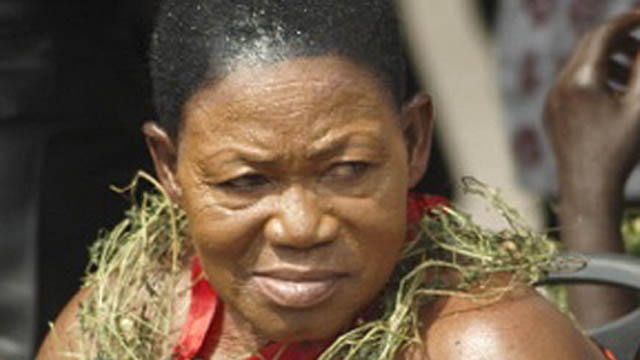
-
 Osuanyi Quaicoo Essel
Osuanyi Quaicoo Essel
Africans, including Ghanaians, had their peculiar way of life long before they encountered the colonialists. They had a robust governance structure (kinship system), laws and standards of beauty inherent in their beauty culture practices. The African society was orderly organised to the extent that there were minimal deviants. They had built no prisons for offenders, rather, their sense of communalistic living and religious practices shaped their modest way of life. Based on their customary laws and taboos, offenders atoned for their wrongdoings through rites and rituals which were enough corrective measures. In some cases, the corrective stigma associated with particular wrongdoing was enough deterrent to possible offenders. For example, someone who stole a bunch of plantains was made to carry the plantain on the head, and matched by multitudes through the streets of the community, announcing the offenses s/he has committed. Sometimes, offenders were sent to the chief palace for settlement of the case. The society was so organised and cultured to the extent that when the community became aware of the wrongdoing of an offender, s/he may not find a spouse or suitor in that community. Before arranging for marriage, the families of both parties engaged in serious investigation about the socio-moral backgrounds of both suitors regarding their behaviours in and outside the community. When a suitor had criminal records, the family of the suitors disallowed such a marriage. In personal communication with M. Opoku-Mensah (12th June 2020), he referred to a purported address of Lord Macaulay to the British Parliament on 2nd February 1835 which confirmed what pertained in precolonial Africa. Lord Macaulay reportedly said:
“I have travelled across the length and breadth of Africa and I have not seen one person who is a beggar, who is a thief such wealth I have seen in this country, such high moral values, people of such calibre, that I do not think we would ever conquer this country, unless we break the very backbone of this nation, which is her spiritual and cultural heritage…”
Just as any society, this statement suggests that Africans also had the way of life, including the standard of beauty and makeover practices.
Precolonial Ghana, as in the case of other Africans, held in high esteem their indigenous beauty culture standards. They held a complex standard of beauty embodied in their ‘Afrocultural aesthetics’ (Essel, 2017, p.25). Afrocultural aesthetics has to do with the conceptual and contextual hybridity of aesthetics that celebrate ideas expressed in artworks (Essel & Acquah, 2016) and the intended purpose of art, be it functional, symbolic or decorative. A work of art is considered good or beautiful once it served the purpose for which it was done. This implies that beauty is judged in context as well as the concept. The Afrocultural aesthetics also apply to the beauty culture practices of the people. One of the beautyculture practices precolonial Ghana held high was hair grooming aesthetic ideals. Hair occupied a central position in the scheme of social standing to the extent that it sent a message about the status of its wearer to the audience who understand such a language. One could differentiate a married woman from the others based on her hairdo in Ghanaian society. Hair was treated with natural hair softeners, conditioners, colourants, and accessories such as comb. Special combs that helped the people to keep the hair in good shape were fashioned by sculptors from wood, bones and metal. The combs were artistically shaped with symbolical essence just as the hair itself. What the precolonial African society did not do was to stigmatise the hair type and texture of their fellow Blacks.
The advent of the slave trade, colonialism and Western education began to sew the inferior seed of black hair stigmatisation and discrimination. Gradually, this ‘inferior seed’ (Morrow, 2014) sewn has entered the educational institutions which should be the agent of change, centre of Black consciousness, character reformation centre and panacea of pan-Africanism has rather turned into Afrosaxons colonialist surrogates perpetuating Afrocentric hair stigmatisation against their educands (Essel, in press). In the effort to decolonise the bastadised and proscribed Afrocentric hairstyle practices in Ghanaian schools, this article explores the conflicting tensions in the process on the part of the school authorities, students and the parents.
Decolonisation theories is central to this study. There exists different perspective on the subject matter of decolonisation. Some have looked at it from Euro-American perspective while others argued that the process remains incomplete when it is one-sided instead of two-sided, that is, looking at it from the perspective of the colonised and the coloniser. On this path, Wenzel (2017) examined the multiple objects and aspects of decolonisation namely, political economy, epistemology, culture, language and nature, and theorised that there exists unevenness and incompletion of the decolonisation process. By studying the various roles played by the colonisers, anti‐colonial nationalists, and Cold War superpowers in decolonisation, Wenzel (2017) observed that postcolonial independence did not necessarily bring national liberation. This liberation in my view includes mental emancipation, and redefinition of Africanness, believing in
ourselves.
In the encounter of the colonialists with the colonised, the former has painted monstrous and negative perceptual image about the latter which has affected the way of life of the latter.The colonialist projected their standards of beauty and art to the colonised and spoke ill of that the colonised to retard social progress and prolong colonial domination of the latter (Nkrumah, 1963).By so doing the colonialists’ beauty culture standards have been ingrained and practised in academic institutions and everyday life and has seeming override indigenous beauty culture standard of the colonised. In line with this, the decolonisation concepts that guides this study is that, the African needs to be measured by his/her cultural beauty standards that does not breach the fundamental laws of his nation or state. The African must gain national cultural consciousness and must not be necessarily be measured with the standards of the colonialist (Nkrumah,1963; 1964). Before the Black Hair Stigma in Precolonial Ghana There are different types of hair ranging from type 1(a, b, c), 2(a,b,c), 3 (a, b, c) and 4 (a, b, c). The types were classified according to the straightness, waviness, curl patterns and kinky look. Hair may also be described in terms of its texture, density, porosity and colour. These characteristics of hair
differences may manifest in individuals, groups, society or race. Despite the differences in hair type, all people of the world belong to one race, that is the human race (Elliot, 2016). Even among Blacks, there are differences in hair type. Precolonial Ghana was made of different ethnic groups of which the Akan were the majority. Though they were of different ethnicities, they did not discriminate against each other on the basis of their hair type or hairstyle. The people wore different hairstyles based on their ethnic affiliations, beliefs and practices, social status, and to celebrate events such as festivities and or funerals. Sometimes the hairstyles were worn for art sake. The hairdos had performative importance, semiotic power, and engendered identity. For
example, queen mothers wore a kind of hairdo named dansinkran (Figure 1) known for its iconic stature amongst the chiefdom.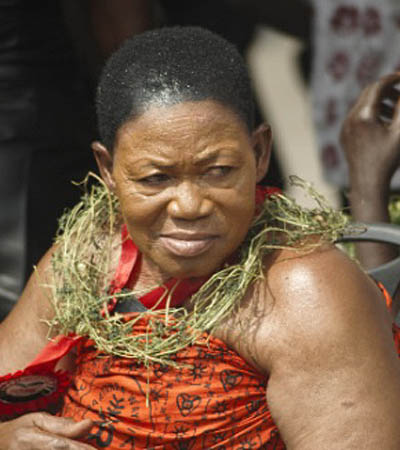
Figure 1: A woman wearing the dansinkran hairstyle. (Image courtesy: Godhit, 2017).
The hairstyles of the people ranged from natural dreadlocks popularly called rasta (known in Akan language as mpɛsɛmpɛsɛ), Afro, braiding, plaiting, shaving and African wigs. Though the word rasta is regarded more as a Jamaican phenomenon, mpɛsɛmpɛsɛ (which was named rasta) existed in some parts of Africa including Ghana in precolonial times. Some were born with the rasta. People born with rasta were considered by society as special beings, for that matter sacred. Apart from that, some priests and priestesses wore dreadlocks or afro. Cowries were placed in the rasta or afro hair of some priests and priestesses for symbolic, decorative, religious and ritual purposes. In this article, the term rasta is used in the context of both natural and artificial dreadlocks in precolonial, colonial, postcolonial and contemporary times. Again, the term Afro was introduced in the 1960s in reference to African American grown hair. From this word came Afrocentric. It is worthy of note that the enslaved Africans who were taken ashore had relatively long and grown hair. This was one of the hairstyles associated with males in precolonial Africa. The colonialists negatively described that hairstyle as bushy. Meanwhile,the long hair of the colonialists did not merit such a negative description. Till now, the term bushy hair connotes an offensive description of overgrown African hair. Many young Ghanaian people would prefer the term Afro to mean fully-grown hair than to describe their hair as bushy. Though the term Afro emanated from the US, the hairstyle was long in practice in many parts of Africa.One could differentiate between a maiden and a married woman just by looking at the hairstyles they wore. The people also used natural hair treatments that conditioned and softened it to keep it in good shape. The Akan often said ɔbaa n’enyimyam nye ne tsirhwin which literally means ‘The glory of a woman is her hair.’ This expression underscored why women in precolonial Ghana cared so much about their hair. They spent a great deal of their time in pursuance of their hair beauty culture practices. During puberty rites, female adolescents are given special education on hygiene, good grooming and hair beauty culture practices and treatments because of the premium society placed on the hair. Consequently, hair became a significant communicative symbol used to express moods such as bereavement, joy; and in some cases, power and authority. For example, a male child who lost his father, mother or close relation cut the hair down to the skin (Figure 2). He appeared hairless on the head as a sign of bereavement. Some Akan female adults wore a hairstyle called takua, done by holding the hairs together atop the head and with thread to stand upright. To them, such a hairstyle is design-less and simple in paying homage to the dead.
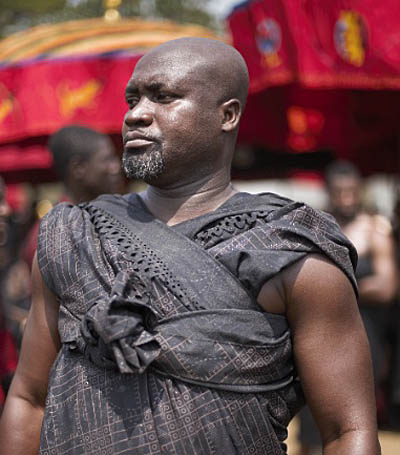 Figure 2: Man with hair cut to the skin as a signal of bereavement. (Image courtesy: Godhit, 2017).
Figure 2: Man with hair cut to the skin as a signal of bereavement. (Image courtesy: Godhit, 2017).Slave Trade, Colonialism and Western Education in Black Hair Stigmatisation
Precolonial Ghana had its own well-established form of education, evolved by the people themselves (Sampson, 1932; Essel, 2019) before their encounter with the colonialists. They trained the young ones through a rigorous enculturation process and apprenticeship system. They passed on the artistic culture and way of life from generation to generation through the robust apprenticeship system which is formal education and training (Essel, 2019). Training of the young ones was the duty of the immediate and extended families as well as other people in the community. It was for this reason that the precolonial society was described as living a communalistic life. In personal communication with M. Opoku-Mensah (12th June 2020), he referred to a purported address by Lord Macaulay’s to the British Parliament on 2nd February 1835. Macaulay had found that the people had strong cultural institutions that rule their socio-moral lives. In the said statement as pointed out by M. Opoku-Mensah (12th June 2020, personal communication), Lord Macaulay said to the British parliament:
"I propose that we replace her [Africa’s] old and ancient education system, her culture, for if the Africans think that all that is foreign and English is good and greater than their own, they will lose self-esteem, their native culture and they will become what we want them, a truly dominated nation."
Macaulay’s statement was recognition of the plausibility and relevance of the precolonial form of education that catered for the good socio-moral upbringing of the people which seemed impervious. As he suggested, the way forward was to introduce their culture including the language and beauty standards which they did, and used the slave trade, colonialism and Western education as a weapon to achieve their malevolent ideological and social-imperialism agenda. With the advent of Western education in the 1500s, learners with afro and rasta were asked to cut their hair before they were permitted to enrol. Afro and rasta hairstyles were considered unkempt and cutting them signalled cleanliness. The Euro-Christian churches planted in precolonial Ghana also asked new Black converts with rasta or afro to cut them as a sign of born again. The mission schools also proscribed
these hairstyles. In the name of religion, this practice continuously ate into the social-moral fabric of the society, especially, amongst the so-called Christian elite. In effect, this gradually contributed to afro and rasta hairstyles’ stigmatisation (Alhassan, 2020; Whiteman, 2010, Whiteman, 2007)). Those who wore these hairstyles, especially, the middle-class males and adolescents, were perceived as rascals, vagabonds, smokers, and unclean.
Based on rereading of scholarly information and archival sources on Black hair, interviews and focus group discussion as a method of data collection, the study provided insight into the hair decolonisation process in Ghanaian Senior High Schools and the conflicting tensions associated with the process. The focus group consisted of Senior High School teachers with more than five years of teaching experience at that Senior High School level. Descriptive and explanatory case study designs constituted the research design for the study. The descriptive aspect was for the purpose of describingthe phenomenon (the ‘case’) in its real-world context while the explanatory case study aimed at explaining how or why some condition came to be (Yin, 2018).A sample of twenty-eight (28) participants consisting of heads (2), teachers (20), and students (6) were purposively sampled from the accessible population of fifty (50). Simple descriptive analysis formed the method of analysis. To ensure the confidentiality of participants, pseudonyms were used to conceal their identity.
Conflicting Tensions in Black Hairstyles Decolonisation There have been reports of discrimination against the hairstyle of Black students in and outside Africa. During the 2015 West African Senior Secondary School Certificate Examination (WASSCE), three students of the St John’s Wesley Grammar School, Accra, Ghana were disallowed to write because they were wearing afro hair (Citifmonline.com 2015). In 2016, there were students protest in South Africa that questioned discrimination against African natural hair in class (Mwaura, 2016). Perry (2019) also reported Black hair stigmatisation which she sees as a vestige of segregated past that deemed blackness inferior and the emulation of whites as the route towards assimilation. This discriminative happening tells that black hair stigma persists in Africa even after colonialism. With the school as an agent of enforcing colonialists’ legacy of anti-Afrocentric hairstyle practices in primary, junior and senior high schools, specifically, rasta and afro, the practice
has become deep-rooted to the extent that attempt by parents and learners to question it proves futile. Students are not happy with the enforcement, and at some point in time prove adamant to school authorities. Mirekua narrated her story:‘I attended primary and Junior High School at Opah Municipal Assembly School from 2009 to 2012. There was a time I had to hide under my desk to avoid being sacked by the headmistress. I was given a warning at the assembly grounds to go and barb my entire hair. In my second year in Junior High School, I was told to go home and barb my hair because it would hinder me from taking part in the Basic Education Certificate Examination. I stayed home for a week because [after I cut my hair for] the fear of being mocked by friends seeing, as it was my first time of having a down cut.’
Mirekua’s accounts reveal the feeling of uneasiness and low self-esteem she developed as a result of being reprimanded to cut her long hair. Her hair was cut because she must be in school or face sacking sanctions. Students who go contrary were labelled as bad or stubborn. Maame Esi, was a student in a Senior High School in the Western Region of Ghana. She completed in 2014. She confessed that she complied with the rules and regulations governing hair beauty practices in her school because she feared being suspended, sacked or disgraced at the assembly grounds of the school. Not complying with the dictates of school authorities on hair in itself is a stigma. The enforcement of these anti-Afrocentric hairstyles has been internalised to the extent that some members of the society may cast aspersion on those who wear such hairstyles. A male participant said his best friend was
advised by the parent to Part Company with him because he left his hair to grow long. ‘My grandmum told me to keep my hair… One of my friends developed a cold attitude towards me afterward. When I asked, he told me that the parents have asked him to keep his distance from me because… I have become a bad boy. Only bad boys leave their hair without cutting it’, he said.
These vignettes of the students revealed that students kowtow to the hairstyle enforcement to avoid negative labelling by the school authorities and their own colleagues. There were others who also left the public school to attend a private school who were lenient with Afrocentric hairstyle restrictions. In a focus group discussion among 20 Senior High School teachers drawn across eight regions of Ghana, the issues that emerged were that students who wore afro and rasta are perceived as deviants and ill-mannered people who do not abide by the rules and regulations of the school. This is because the school proscribes wearing of these hairstyles. To
the teachers, students appear as adults when they wear afro and rasta hairstyles which do not distinguish them from the teachers. Succinctly put, ‘They appear like mothers and fathers’ than students in those hairstyles. In addition, they argued that wearing such hairstyles in school generates competition amongst the students as they may strive to put up flashy hairstyles and put little or no concentration on their academic work. As a result, they only permit students to wear rasta or afro on health and religious grounds. As explained earlier, hairstyles have religious implications in Ghanaian society. For example, afro and rasta have a strong affinity with African Traditional Religion, which is the authentic religion in precolonial Africa. A teacher explained that: Well, from my little knowledge, I know that … priest and priestesses do not barber. Secondly, some students have soft scalps making it easy for them to catch cold anytime their hair is down. These categories of students could be allowed to wear dreadlocks or afro to school. A teacher who aligned to the Christian faith perceived these hairstyles as unacceptable. He said, ‘My religious background wants us to have a close [hair] cut as a Christian man.’ The teachers said the culture of the school does not allow afro and rasta. So, they normally use scissors on students’ hair. They also admitted asking students to go and shave their hair but when the students refuse, they sacked them from the examination hall or class, since they were not ready to shave their hair without any tangible reason. Students who wear afro are perceived as ‘weed smokers’. On the contrary, four of the teachers argued that wearing afro or rasta is normal since it
borders on individual differences, and generally accepted in Ghanaian society. The issue is that these hairstyles become unacceptable when worn by students at the primary, junior and high school levels.
In response to the question of rules and regulations regarding hair beauty culture standards of students in public schools, a teacher said:What happens is that the housemasters, housemistresses, and some teachers on duty often send scissors to the various classes or examination halls to give students awkward hair cut against the will of the students to force them to shave their grown hair. This is
a kind of punishment given to the students for leaving their hair to grow. Some students, out of pain and dislike for such treatment, leave their hair in its awkward form as done by the teachers. Such students are often refused access to classes or examination
halls; canned, suspended or asked to weed as punishment. Students comply in order to take classes or
examinations.One of the participants has taught in five schools covering primary, Junior High School and Senior High Schools, with twenty-four years of teaching experience. She has taught in Ashanti and Central regions of Ghana, and currently a headmistress of a Senior High School. She opined that:
With twenty-four years of teaching, what the schools consider a neat haircut is down cut. Rasta isn’t allowed. Any child who came to school with grown hair is either driven home or the parents are invited to the school and advised to shave the hair of the ward. Some
parents come to explain to the school authorities that cutting the hair of their children has spiritual implications that may cause sickness to the child, so, the hair should not be cut. If the authorities disagree with them, it occasionally brings quarrels. Parents who
disagree are told that their children could not fit in the school... Personally, I think those who smoke marijuana wear rasta [dreadlock]. Once they come into the school with this hairstyle, their mannerism, their characters are influenced. They might not be smoking, but other students, sometimes, see them as marijuana smokers… Actually, for my long years in teaching, most of our recalcitrant students, most of our problematic students, when you look at them from head to toe, you realise that the sort of dressing speaks to their characters too.
The views of the headmistress-participant confirmed the thoughts of the teachers. The school expects learners to wear down-cut hairstyles as institutionalised by the colonialists. The school has done little or nothing to question the etymology of this self discriminating and self-stigmatising act they enforce hook, line and sinker. This negative enforcement has been instituted through a complex network of colonial apparatus namely Euro-Christianity, Slavery, colonialism and Eurocentric education making it difficult in decolonising the process. Any attempts to decolonise are faced with vehement opposition from Blacks to their fellow Blacks. Educated Blacks (Negroes) as pointed out by Woodson (1933, p. 7) ‘hope to make the fellow negroes ‘conform quickly to the standards of the whites and thus remove the pretext for the barriers between the races.’ Caucasians who attend Ghanaian public schools are exempted from this rule. Myjoyonline.com (2019, para 2, line 2 &3) reports of a leading member of a teacher union in Ghana who said: “what I gathered was that when Caucascians [Caucasians] students cut their hair to the level of black ladies, it makes them look very ugly and it can even affect their looks so Caucasian students are not allowed to cut their hair. There is no rule in the Ghana Education Service concerning Caucasians in Ghana because we are not Caucasians, we are negroes.”
Some teachers also argue that when students are allowed to leave the hair to grow long, it attracts lice, eczema and dandruff. These comments demonstrate the anchored conflicting tensions in the decolonising process. Diseases associated with hair are curtailed when students are properly groomed by the school to follow body and hair hygiene protocols. Their hair does not attract hair and skin-related diseases because it is black or not good. Hair and skin diseases are no respecter of colour or race. Good hair has nothing to do with its texture, density, porosity or colour. It is a hair of any type that is well maintained and kept healthy. The position of the school teachers and authorities brings to mind Carter Woodson’s (1933, p. xiii) assertion that:
When you control a man’s thinking you do not have to worry about his actions. You do not have to tell him not to stand here or go yonder. He will find his ‘proper place’ and will stay in it. You do not need to send him to the back door. He will go without being told. In fact, if there is no back door, he will cut one for his special benefit. His education makes it necessary.With this, Woodson looked at how the Negro has been miseducated to the extent that s/he exhibited ‘attitude of contempt to their own people’ (p.1). He also focused on the minds of Black people giving the right kind of education that would contribute to high self-esteem to their people. There are tensions and conflicts that ensue between school authorities and students on one hand, and school authorities and parents on the other hand. Students feel that such negative enforcement deprives them of their self-esteem, selfconfidence and uniqueness as individuals. Yet, they must abide by the colonialist monolithic mentality of wearing down-cut hair as a signal for obedience, neatness and smartness as required by the school to have access to education since noncompliance attracts harsh sanctions. Some parents who disagreed with the school authorities on the position of hairstyles, pick quarrels with the school authorities. Parents have the option of kowtowing or taking their wards from the school. One particular instance of a parent taking the school on is what happened in Achimota School on March 19, 2021, which became a national debate for more two weeks, and took a centre stage on social media, Ghanaian print (newspapers) and electronic media (radio, television, internet). One parent named Raswad Menkrabea took to his Facebook page to pour out his frustration about his son being denied admission on the basis of his rasta hairstyle. Raswad Menkrabea wrote:
This morning, the school authorities of Achimota School claimed that their rules do not allow students with dreadlocks to be admitted. The school authorities denied two brilliant dreadlock students from being admitted after having been posted there by the Computer School Placement System [Computerised School Selection & Placement System]. My son was one of the affected children and the other student was also refused on the same grounds. We have no option but to battle against this gross human right violation. As a child he has every right to his culture in so far as such culture do not breach the 1992 Constitution. He equally deserves the right to access education within his culture just like other cultural believers. As a Rastafarian, I think that dreadlock do no way cause any
harm which should even be a basis to be asserted by the school authorities. The fundamental questions to ask is what does our law
say about right to one’s culture? Do you deny a child access to education based on his/her culture? Do public school rules override the supreme law of the land?
This issue, which became a national debate in public transports and markets, attracted the attention of Ghana’s parliament in March 25 2021, based on which the Education Minister, Dr Yaw Osei Adutwum assured the house that the Ghana Education Service (GES) will soon issue policy guidelines on students’ admission to all Heads of Senior High Schools in Ghana to bring finality to the issue.
Wearing long or short hair plays no role in distracting students to focus on their academics. There are many renowned private schools in Ghana that do not proscribe students from wearing rasta or Afrocentric hairstyles. The school whether public or private has the primary role of grooming students to be creative thinkers with good time management skills. The hair students keep has nothing to do with their academic performance and socio-moral conduct.
From the discussion, it has emerged that the public schools proscribe Afrocentric hairstyles with no substantial scientific evidence that wearing afro and rasta inhibits the acquisition of creative and innovative thinking, and academic performance or progress of the students. Neither have the schools established from their arguments that wearing Afrocentric hairstyles negatively impacts the socio-moral and cultural wellbeing of the Ghanaian society or indigenous culture. They point to no sound research that establishes the relationship between academic performance and hairstyle worn, and the relationship between hairstyle and social conducts of students. The conflicting tensions around the hairstyles cut across precolonial, colonial and part of global fashion, and create multiple conflicting meanings within the many-sided existence of Ghanaian hairstyles. This helps to show how unstable, changing, and multiple the meanings of the hairstyles can be. Yet the Ghanaian public schools enforce the colonialists’ discriminative legacy of stigmatising Afrocentric hairstyles in Ghanaian schools with monolithic mentality without questioning the roots of such segregative practices. Teachers have challenges with students because when they wear rasta, afro and other Afrocentric hairstyles, they do so to show seniority. In other words, do so to signal that they have come of age. Therefore, wearing afro or rasta by the public school
students becomes a sign of rebellion and badness, while for the teachers they are signs of authority and respectability while this is not the case in the private school students. The difference between the public and private school policies creates a class division in the meaning of the hairstyles, where the Rasta and Afro styles become a sign of privilege.
Again, the teachers also deprived students of their Afrocentric hairstyles because they think it makes students susceptible to skin and hair diseases. These reasons deduced from the argument of the teachers and school authorities are not convincing to parents and students which leads to student-teacher and parent-teacher conflicts. Students gained continued access to education only when they shave their hair. Their education is threatened when they refuse to conform to the rules and regulations on hair. Students wear rasta, afro or long hair for several different reasons. Some wear it for spiritual/religious obligations, aesthetics and for fashionability purposes. This interesting practice challenges the so-called tradition and modernity opposition since a pre-colonial religious meaning and a fashion meaning can coexist in the same style and space. It is discouraging that six decades after independence from the colonialists, there are pitfalls in an attempt to decolonise the Afrocentric hair stigma created by the colonialists through the churches and schools they established. Surprisingly, the public-school authorities in Ghana have tended to be colonialists’ agents enforcing the discriminative Afrocentric hairstyles in schools. It is recommended that the Ghana Education Service and the Conference of Heads of Assisted Senior High Schools (CHASS) must work together to review the hair policies for students, so that it will not be a bottleneck for students to have access to education, which is their fundamental right enshrined in the 1992 constitution of Ghana.References
- Alhassan, S. W. (2020). “We Stand for Black Livity!”: Trodding the Path of Rastafari in Ghana. Religions, 11, 374, 1-10. doi:10.3390/rel11070374
- Citifmonline.com. (2015). School bans students with ‘unkempt’ hair from writing WASSCE. http://citifmonline.com/2015/04/22/school-bans-students-withunkempt-hair-from-writing-wassce/
- Essel, O. Q. & Acquah, E. K. (2016). Conceptual art: The untold story of African art. Journal of Literature and Art Studies, 6(10),
1203 – 1220. - Essel, O. Q. (2017). Searchlight on Ghanaian iconic hands in the world of dress fashion design culture (Unpublished Thesis).
University of Education, Winneba. - Essel, O. Q. (2019). Decolonising Ghana fashion education and training history. International Journal of Humanities & Social
Studies. 7(7), 381 – 392. - Essel, O. Q. (In press). Hair and body fashion identity narratives in ‘the Return of the Slaves’ exhibition.
- Elliot, J. (2016, May 26). Elliot Jane on the Rock Newman show. https://www.youtube.com/watch?v=fF9s0as_d_4
- Morrow, W. (2014). 400 years without the comb: Sewing the inferior seed. https://www.youtube.com/watch?v=SH7nNdz3ImY
- Mwaura, W. (2016). South African schools under attack over Afro hairstyles ban. https://www.dw.com/en/south-african-schoolsunder-attack-over-afro-hairstyles-ban/a-19513159
- Myjoyonline.com. (2019). Let it grow: Why the policy against long hair in schools must beabolished. https://www.myjoyonline.com/opinion/let-it-grow-why-the-policyagainst-long-hair-in-schools-must-be-abolished/
- Nkrumah, K. (1963). The African genius. Speech delivered by Osagyefo
Dr. Kwame Nkrumah, President of the Republic of Ghana, at the Opening of the Institute of African Studies on 25th October, 1963 - .Nkrumah, K. (1964). Consciencism. Panaf Books Ltd.
- Perry, A. (2019). “Stay out of my hair”: Black students need the federal government to tell schools to leave their hair alone.
https://hechingerreport.org/stay-out-of-my-hair/ - Sampson, M. (1932). Gold Coast men of affairs.
- Wenzel, J. (2017). Decolonization. In I. Szeman, S. Blacker, & J. Sully(Eds.), A Comparison to Critical and CulturalTheory.
https://doi.org/10.1002/9781118472262.ch28 - White, C. M. (2010). Rastafarian repatriates and the negotiation of
place in Ghana. Ethnology, 49(4), 303 – 320 - White, C. M. (2007). Living in Zion: Rastafarian Repatriates in Ghana,West Africa. Journal of Black Studies, 37(5),677-709.
- Woodson, C. (1933). The mis-education of the negro. Khalifah’s Booksellers & Associates.
Yin, R. K. (2018). Case

-
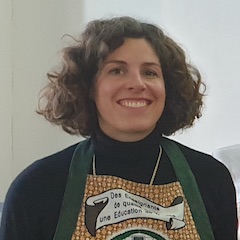 Annette Schemmel
Annette SchemmelThe photo at hand was shot in Paris in the 1920s. We are looking at a beautiful young woman with very fair skin who seems to have sunken her head on a table as if for a rest, while her left hand is carefully exposing a polished mask made from dark wood. The woman is Kiki de Montparnasse alias Alice Prin (1901 – 1953), Man Ray’s lover, a model for many painters and herself a successful artist. Supposedly, Kiki was central for the myth of the Montparnasse as an artistic enclave in Paris.3 The mask is simply “African” in the eyes of my pupils at first. I want them to learn that we are looking at a portrait mask4 of the Baule people in Ivory Coast. Pupils should also understand that such carved portraits served to honor an important member of a Baule society, a woman in this case. A dancer wearing a similar mask would incorporate the portrayed notable at the occasion of ritual dances, thus celebrating her achievements.5 This specific mask’s features are balanced and dignified, harmonious but not realistic, a point to which I will come back later.
Meanwhile I shall argue that Man Ray’s picture thrives on carefully staged contrasts. The title that has come to stick with this photograph hints not only at black-and-white photography itself, but also at the most obvious contrast, at the White and Black6 skin or surface of the picture’s protagonists. Yet there are further opposites linking the lady and the mask in the picture, namely the opposites of young, ultra-modern and lively versus ageless, “primitive” and inanimate, matt versus shiny, skin versus wood, a seemingly passive woman versus the upright face of the mask, holding versus being kept. The photo historian Wendy Grossman has described how these opposites relate: “Almost as if it were a direct cast, the vertical mask, with its shiny black patina, is a negative mirror image of the reclining model’s ovoid face, echoing her pursed lips, closed eyes, and tautly styled coiffure. Parallel symmetrical shadows extend beneath the two perpendicular forms, coupling face and mask in a shallow and austere space.”7
Clearly, Man Ray has smartly staged the Black and the White. By the time he shot this picture, Man Ray was making a living of object photography in Paris, then the world capital of fashion. It might therefore come as no surprise that this picture made its first appearance in an early print medium dedicated to beauty and fashion, the Vogue magazine. When the issue came out in 1926, everything “exotic” was fashionable in Paris, especially arts from (indirect) African origin, such as Jazz, Josephine Baker or, well, the mask in Man Ray’s photograph.8
Beyond its uncontested fashionable appeal “Noire et Blanche” unveils some deeper, more unsettling meanings, some of which I intend to unfold here. A simple reading is ready at hand if one places this artwork in the historical context of the colonial era. In 1926, the mask’s country of origin belonged to Afrique Occidentale Française. On this backdrop, the dreamy woman holding the mask in Man Ray’s picture appears to be a Freudian slip in the form of a photograph, an unconscious idealization of colonial domination. Are we looking at a personification of the imperial power of France carefully embracing its colony Ivory Coast?9
Next, we could follow a feminist lead towards interpretation. This photograph stages two females, whilst an important third actor of this mise-en-scène is invisible, the male photographer. Through his camera, the male artist is looking at the passive naked woman und at the artefact of a culture that is foreign to him. Obviously, the mask has become passive, too, once removed from its original context. In this reading, Man Ray’s photograph appears as a staging of the desire for submission – the submission of the idealized female and that of the cultural “other”. As viewers, we are lured into this voyeuristic pleasure, unless we take some critical distance.
Following a suggestion of some South African colleagues, we shall now look at this photograph through the lens of the Martinican author Franz Fanon. In his famous psychoanalytical text “Peau noire, masques blancs”, Fanon is pointing at the phenomenon of the essentializing construction of a Black soul (“l’âme noir”).10 Following Fanon, Man Ray’s photograph can be considered one of those efforts by European (and certain African) artists of the classic Modern era to catch hold of an imagined essence of Black culture. This effort needed to objectify Blackness in order to make this construct palpable and acceptable. Arguably, in “Noire et Blanche” the ’black soul’ lies in the hand of a white person and is reduced to an object, the sculpted mask. Furthermore, it could be argued with Fanon that Man Ray used the Blackness of the wooden object, the “noir” that is readily associated with the ‘continent of darkness’ in the collective imagination of Westerners,11 in order to highlight his girl-friend’s Whiteness. We know that contrasts help at intensifying and it is no secret that White is a color (of skin) that Europeans tend to associate with innocence and purity.12 Arguably, this racialized contrast of the “Noire” and the “Blanche” served to celebrate qualities that Man Ray projected onto Kiki de Montparnasse, his partner.
So far, I have tried to make clear that the artwork “Noire et Blanche” is not only a showcase of female attractivity, but that this photo also has a violent dimension to it because it relies on certain colonial mechanisms of distinction. As an art teacher, it is my ambition to make this picture’s ambivalence understandable for my pupils. I know that pupils are more likely to learn if they are allowed to make their own discoveries,13 for instance by exploring ‘real’ scientific data through the Internet. From our classroom, we can access the Metropolitan Museum’s online collections, which include a comparable portrait mask.
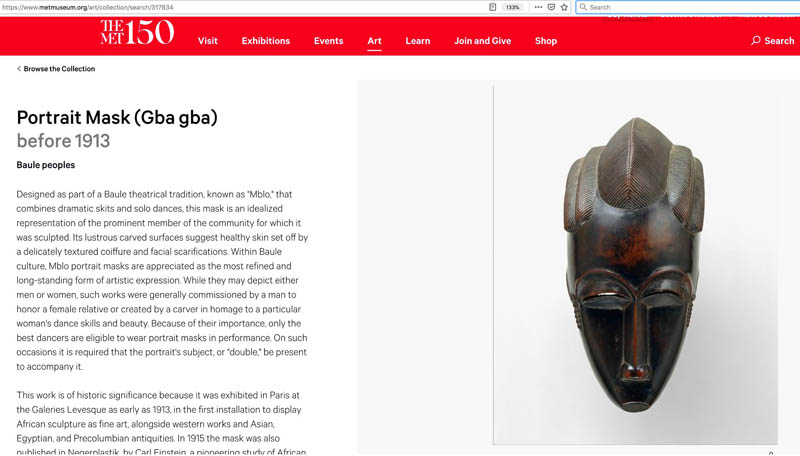
Website of the Metropolitan Museum, New York
Other than the black-and-white photograph by Man Ray, the museum’s more recent color picture unveils the fine shades of brown and red tones that are characteristic of the tropical wood used for Baule masks. Obviously, such masks are not Black in reality. Furthermore, pupils can learn from the provenance info that the Baule mask in the Met’s collection was famous amongst art lovers and artists in Paris and Berlin already before WW1.14 This insight helps to understand why Man Ray might have chosen a similar object for his photograph: artists tend to learn from each other.
As a continuation, I like to encourage my pupils to sum up the museum’s text about the characteristics of portrait masks by the Baule by means of notes in German language. In doing so, the learners realize that these masks are carved according to a complex canon of beauty, that the forehead is high for a reason, namely in order to represent intelligence, that the polished surface signifies good health and that a representation of a person can convey dignity even if the proportions of its face have been exacerbated. This is new to many youngsters, whose frustration with their own efforts at realistic drawing has shaped their preference for artists’ realistic skills. Pupils also learn from the online information that this mask can only be brought to live as part of a performance, thus discovering a problematic aspect of its preservation in a museum.
Coming back to “Noire et Blanche” with this new knowledge, my pupils realize that Man Ray’s photograph is concealing much of the knowledge that is available today. They understand that it is worthwhile to research background information for non-European art, even if this requires leaving their textbooks behind and going an extra mile with their foreign language skills. In the course of the classroom discussion that follows we are wondering why a Baule community would have let go of their precious mask, a question leading to recent restitution debates.15 Furthermore, the teenagers understand that the coquettish presentation of the mask in the hands of a naked European woman might be read as a sign of lacking respect by members of its culture of origin. At this point of the discussion some pupils have experienced a change of perspectives. This experience of assuming a position previously perceived as ‘other’ in the course of a lesson is the very purpose of our engagement with this artwork at school, arguably it is also the purpose of looking at art altogether.
Let me summarize this approach. Comparing Man Ray’s photograph “Noire et Blanche” with the mask from the Metropolitan museum’s collection is a way to scrutinize a canonical picture from a critical perspective without denying the aesthetic appeal of the historic photograph. By way of this lesson I hope to enable changes of perspective and to build sensibility for post-colonial readings of pictures amongst pupils. Taking a bold stance, I shall claim that such lessons are conducive to a more general type of visual competence because I like to think that my pupils’ experience with the implications of this attractive historic picture might encourage them to also critically scrutinize any other picture in the future.
References
[1] For a thorough photo-historical analysis read Wendy A. Grossmans insightful article “Unmasking Man Ray’s Noire et blanche”, American Art, Vol. 20, No. 2 (Summer 2006), pp. 134-47.
[2] For instance, Man Ray is mentioned in the widely used text-book Epochen der Kunst. Von der Moderne zu aktuellen Tendenzen (Hsg: Robert Hahne, Oldenburg Schulbuchverlag GmbH, 2013, S. 150/51). In this book, information about him and the photo “L’Enigne d’Isidore Ducasse” (1920) are featured under the header of „Fotografie und Film im Surrealismus“. It can be argued that „Noir et Blanche“ is surrealistic as well, since it seems to be illustrating Lautréamonts famous phrase “beautiful as the chance meeting on a dissecting table of a sewing machine and an umbrella” (Lautréamont alias Isidore Lucien Ducasse, „Die Gesänge des Maldoror“, 1874.), with Man Ray’s “chance meeting” bringing together a white woman and a wooden mask.
[3] en.wikipedia.org/wiki/Alice_Prin (last accessed on August 26, 2019).
[4] Wendy A. Grossman’s article “Unmasking Man Ray’s Noire et blanche leaves no doubt that the mask in the picture is actually an airport art version of a Baulé mask, by the way (p. 136).
[5] Collection Records of the Metropolitan Museums (Baulé Masken), www.metmuseum.org/art/collection/search/317834 ((last accessed on May 3rd, 2017), also https://www.metmuseum.org/art/collection/search/319512 (last accessed on August 26, 2019)
[6] In this text, I will spell Black and White with capitals in order to highlight the cultural construct of Race.
[7] For the complex history of the title see Wendy A. Grossman, “Unmasking Man Ray’s Noire et blanche”, pp.140.
[8] More about this fashion in en.wikipedia.org/wiki/Josephine_Baker (last accessed on August 26, 2019).
[9] Research on Man Ray does not support this easy hypothesis however. In Wendy A. Grossman’s article from 2006, the origin of the photograph is described as an open-ended artistic process partly sparked by commercial interest, partly by a collaborator, but not by political intention. However, I would like to argue that art works tend to transmit more or less unconscious convictions of their authors and their peers, which makes of artworks valuable witnesses of their times.
[10] Frantz Fanon, “Schwarze Haut, weiße Masken”, translated by Eva Moldenhauer, Wien: Turia + Kant, 2013, p. 14, 147.
[11] Fanon makes this point in “Schwarze Haut, weiße Masken” (2013), p. 158.
[12] “Symbolik der Farben, Formen, Zahlen” in Lexikon der Kunst, Bd. VII. S. 153-154, E.A. Szeemann Verlag, Leipzig 1994.
[13] I am here referring to pupils from eleventh grade of the Bavarian Gymnasium, whom the syllabus obliges to explore aspects of the body in art during half a year.
[14] Collection Records of the Metropolitan Museums (Baule masks), www.metmuseum.org/art/collection/search/317834 ((last accessed on May 3rd, 2017), also https://www.metmuseum.org/art/collection/search/319512 (last accessed on August 26, 2019)
[15] For a thorough introduction to this question read Felwine Sarr’s and Bénédicte Savoy’s “restitution report” commissioned by the French state. http://restitutionreport2018.com/ (last accessed on April 1, 2020).
published April 2020
Sound track / Hörimpuls Man Rays Noire et Blanche, 2018 (Schemmel): Link
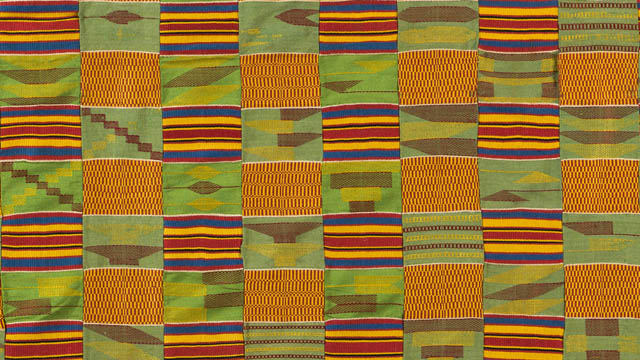
-
 Osuanyi Quaicoo Essel
Osuanyi Quaicoo EsselNoted for its attractive and bright colour schemes, a beautiful kente design is stuck on the walls of the entryway to the Permanent Exhibition of the African Collection at the Museum Fünf Kontinente. Its wide array of colours and strategic placement invites spontaneous spectatorship and captures into consciousness of visitors, the Afrocentric sense of colour use which is a precursor to the continental origin of the fabric. Indeed, kente originate from Ghana located on the African continent. Kente fabric designs have also gained international reputation and attracted considerable amount of research that centre on its historicity, weave structure, symbolic patterns, semiotic power, design structure, and its loom and the corresponding accessories, amongst others. Featuring the kente design in the collection by the curatorial team complements to drawing renewed attention to the indigenous fabric design technology of Africa.
Historically, kente has been known as a cloth which was a preserve for royals (kings and the chiefdom) in the Asante kingdom. It was later produced for use by all in the society. Being a fabric for royals, it signifies pride, wealth, power, authority and status of wearers. Though its usage extends to all, the kente designs worn by the Asante Kings are unique, distintive and of couture standard. The culture of adorning the Asante Kings with the top notch kente designs as in the ancient times has, therefore, not been eroded. In the court of the Kings were seasoned kente designers and weavers carefully selected to produce stunning kente design that are not found on the market. The fabric was woven with variously dyed handspun cotton yarns, in plain and double weave format in the form of stripes usually determined by their design structure. The stripes are joined together with the aid of a needle to form a wide sheet of fabric. The zigzag machine has become a replacement in joining the stripes together.
On the political sence of Ghana, the first president of the country, Osagyefo Dr. Kwame Nkrumah’s introduction of national dress agenda evoked the kingly use of the fabric in presidential inauguration ceremonies which has become a non-statutory policy emulated by six out of eight democratically elected presidents of Ghana from 1960 to present (Essel 2019). Nkrumah was the pacesetter in the use of kente in toga style for presidential inauguration in the history of Ghana. Prior to that he had worn kente fashion to political events and meetings in and outside Ghana before he became the president of the nation. His exemplary use of the Ghanaian fashion classic has been maintained and practised for more than half a century, though it is non-statutory.
Apart from its aesthetic clout, kente comes with symbolic patterns, whose decoding reveal the philosophical message encoded in the woven patterns of the fabric. Structurally, the kente fabric design featured in this exhibition encompasses variations of babadua, kaw, nkyemfre and fa hia kɔtwere Agyeman patterns, amongst others.
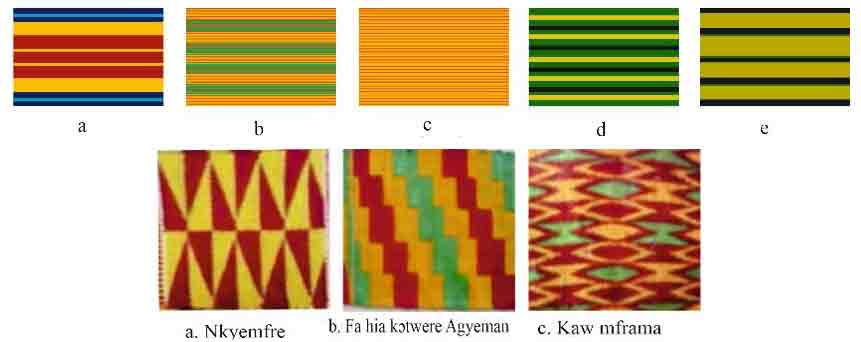
Figure 2: Top row: Variations of Babadua patterns. Bottom row: Names of some identifiable Kente patterns (Photo: the author)
Babadua is a name of a plant based on which the pattern was developed. The plant is noted for its strong look and resilience, perhaps a reason for its choice. Babadua, therefore, signifies strength, resiliency, formidability, firmness, superiority and power. These symbolic attributes of babadua is communicated by its wearer to observers. There are variations of babadua patterns used by kente designers (Figure 2). Some of the variations of babadua patterns are captured in the kente design (Figure 1). Nkyemfre (‘a pot shed’) pattern, depicted with alternating right-angled triangular shapes, symbolises history, recyclability and healing power, knowledge and service while Kaw mframa pattern derived from the physical characteristics of centipede, symbolises uniqueness. Fa hia kↄtwere Agyeman (literally translated as ‘lean your poverty on Agyeman’), arranged in the form of staircase in diagonals stands for hope, faith, sharing and benevolence (Essel, 2019). Combination of these observable kente patterns deftly arranged to communicate the idea of history, power, hope, pride, healing power, knowledge and service. The philosophical interpretation of kente designs could be informed by decoding its symbolical patterns. It could be observed that the variations of Babadua patterns dominate in the design (Figure 1). The dominance of this pattern informs the overall message embedded in the design. In this context, the fabric sings praises to the power and superior status of a king or chief in keeping intact the history and indigenous knowledge systems of the society.
Kente has become a prominent visual image and identity marker used in reference to the African continent. For instance congressional democracts led by Nancy Pelosi on June 2020 wore kente stoles to make political statement in pursuit of legislative goals of equality for Black people. This occured in solidarity of the gruesome death of the African-American George Floyed in the hand of white police and police brutality in the US. The kente fabric adorned by the lawmakers was used to signify African heritage and pride. During the 400th anniversary celebration of the arrival of enslaved Africans to America in 2018, the Congressional Black Caucus wore kente in paying allegiance to their African heritage. Kente fabric, therefore, has strong historical connections with Blacks across the globe.
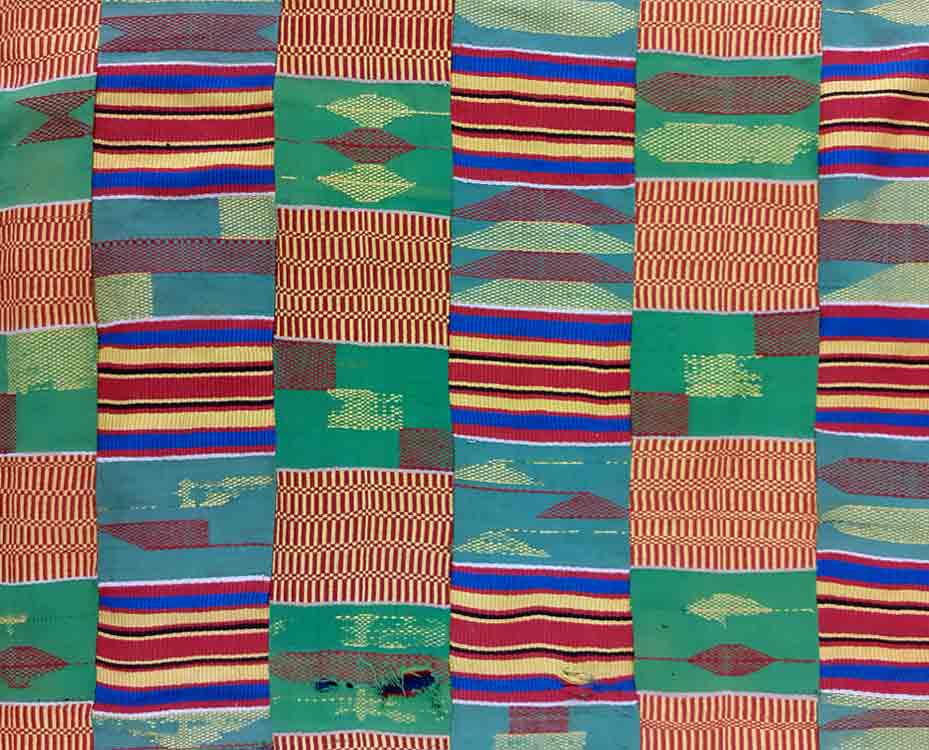
The Kente fabric in the depot of the Museum Fünf Kontinente © Museum Fünf Kontinente (Photos: Sophia Lubin)
Teaching and learning of kente fabric with the focus on history, sociocultural, political significance and educational relevance; improving the production technique for mass production purposes; improving of loom and its accessories; and alternate way of creating handmade kente print, among others, informed my teaching. Learners under my tutelage also explore appropriation of the symbolic kente patterns and engage in experimenting with kente designs.
published January 2021
Reference
- Essel, O. Q. (2019). Dress fashion politics of Ghanaian presidential inauguration ceremonies from 1960 to 2017. Fashion & Textiles Review, 1(3), 35 – 55.
This article is part of a gallery: Perspectives from Ghana on Museum Objects in Germany
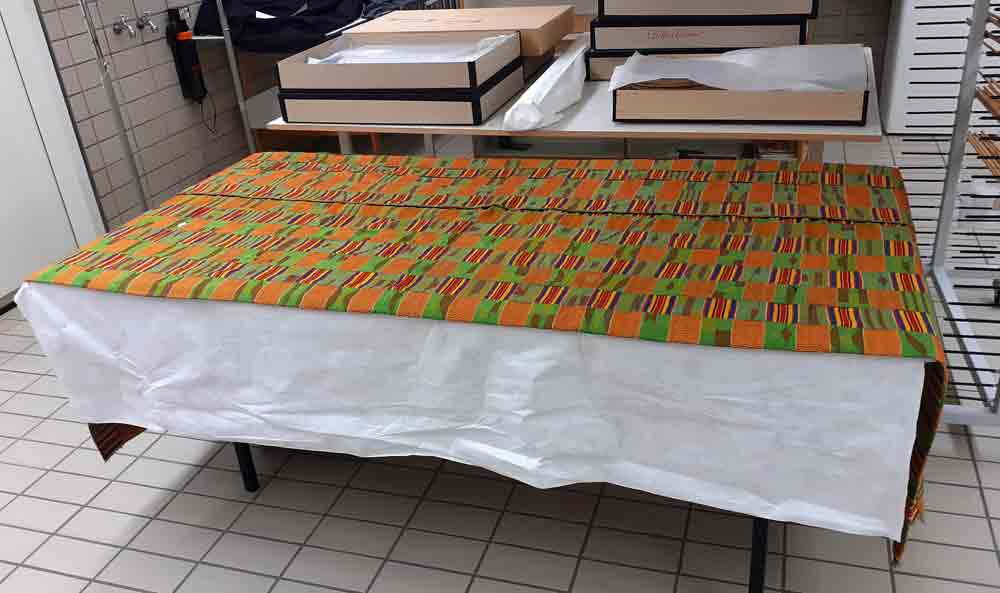
The Kente fabric in the depot of the Museum Fünf Kontinente © Museum Fünf Kontinente (Photos: Sophia Lubin)
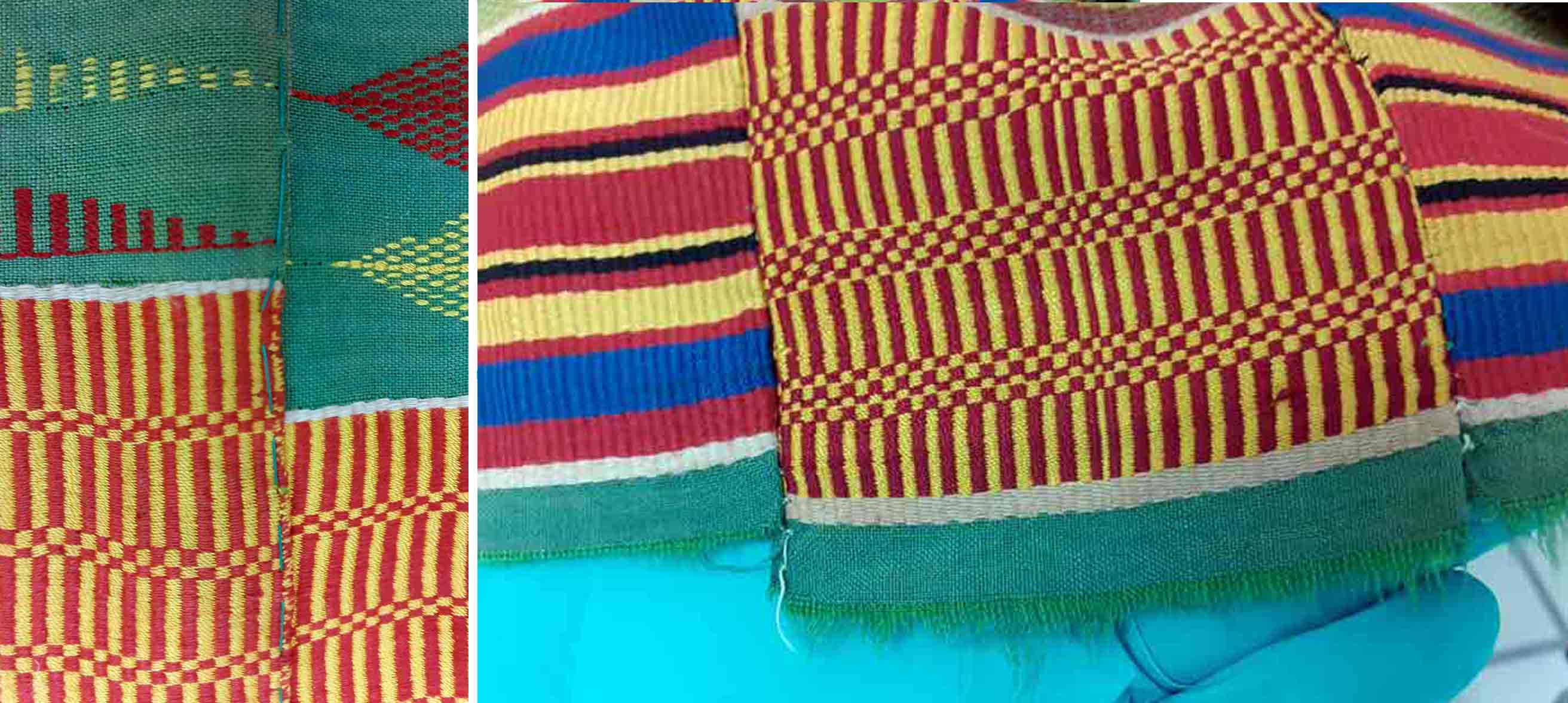
The Kente fabric in the depot of the Museum Fünf Kontinente © Museum Fünf Kontinente (Photos: Sophia Lubin)
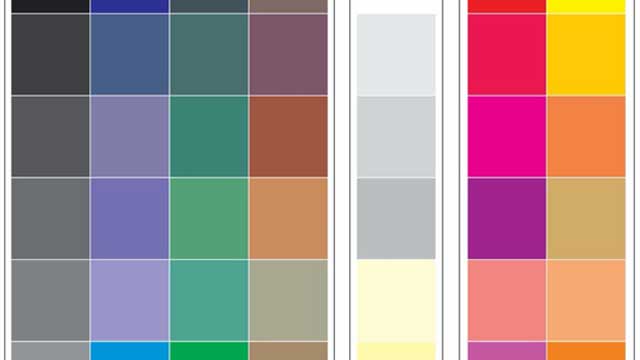
-
 Patrique deGraft-Yankson
Patrique deGraft-YanksonAkan definition of Colour
The Akan people have no precise terminologies that assign a ‘name’ which interprets into the meaning of colour the way it is understood in English and other languages. In other words, most of the answers to the question ‘what is colour’ makes very little meaning to a pure Akan speaker whose understanding of colour transcends a scientific definition. In spite of several efforts by contemporary linguists to subject the Akan concept of colour to nomenclatural consideration, the traditional Akan people continue to describe hues by their relationship with similar colours in nature.
Consequently, terminologies in Akan, which are associated with the word colour, are likely to describe what a hue looks like in association with the natural (or in few occasions, manmade environment) or how a hue makes one feel, think or behave. Among numerous attempts at coming up with an Akan word for ‘colour’, the ones many respondents settled on were yɛbea, subea, su, husuo, ahusuo and bↄbea. These words, which mean almost the same in Akan, literally describe the nature, quality or, probably more precisely, the physical look/appearance of something. By implication therefore, the terminologies deduced are more general and their usage go beyond the description of just the colour of an object or a situation under discussion.
Colour names
Colour names among the Akan people, are often given directly after identifiable objects within the known environment. Therefore, names given to colour in Akan have the tendency of affecting the perception, understanding and accurate adaptation of colour among the Akan people. Name, like colour itself, has strong cultural significance. Therefore, names that are understood in one’s language are likely to have better cultural associations and connections with their people than those that sound foreign.
In this regard, many Akan people are of the opinion that all efforts at identifying names for colours should continue with the culture of associating colours with the local names of known objects among the Akan people. For instance, if there are names such as ahabanmon (fresh leaves) for green and akokↄ serade/akokↄ aŋoa (chicken fat) for yellow, there could also be names like ahabanfunu/ahatawfun (dead leaves) for brown, gyafrane/gyanframa (fire flames) for orange, gon/dwene (gray hair) for gray, etc.
Number of colours
The number of colours recognizable by a traditional Akan are as many as those identifiable and describable in nature. As already indicated however, recognized Akan colour names and their identification are mostly in relation to those discernible in nature, for which reason their descriptions are broadly categorized. The following are colours available in the traditional Akan language.
- Kↄkↄↄ (Red)
To a very large extent, kↄkↄↄ, the sound of the name of the colour identified as red among the Akan people is more onomatopoeic than semantical in interpretation. Kↄↄ, the root word, visualizes the sensation of the word glow. Therefore, kↄkↄↄ actually connotes more to complexion with a strong bright colour. It commands an ambience of hot brightness, usually with scorching visual sensation, rather than a simple colour name. For this reason, kↄkↄↄ is attributable to all objects that emit some warmth in their visual ascriptions. Therefore, whilst a ripe pepper is described as kↄkↄↄ, ripe mangos, ripe oranges, glittering gold, burning coal, sunny skies, flames, the skin of a ‘white man’, etc. are all kↄkↄↄ as well. In the Akan colour scheme therefore, colours that could be placed analogous to kↄkↄↄ include red, orange, pink, wine and the like.
- Fitaa/Fufuw (White)
Fitaa/fufuw is white, light, plain, spotless, clean, neat, pure, holy, untainted and incorrupt. Moreover, fitaa/fufuw is always associated with cleanliness, purity, victory and spirituality. It denotates white coruscating brightness, visual spotlessness and stainlessness. No matter where it is spotted, the associated psychological and spiritual experience comes naturally, and this is inert in almost every Akan.
Another dimension of fitaa/fufuw is its direct association with light especially when it reflects bright objects to shine. When something shines or sparkles, or hyerɛn as it would be said in Akan, it is associated with brightness and for that matter, white. In this regard, a spark that would be lighted by any colour to give the feeling of brightness will be described as fitaa. The reason is that the psychological feeling of brightness invoked by the sensation is more important than its sensation on the eye.
- Tuntum
One does not need to understand the word tuntum to be able to link its semantic association with weight and heaviness. Tuntum connotes darkness and visual weight, and technically expressed, all the cool colours on the colour wheel fall within the brackets of colours in this category. Tuntum connotes darkness, gloom and heaviness. To the Akan, tuntum does not only stand for black, but absence of lightness, brightness, shine, glow, gaiety, happiness and sparkle. This is not to say that tuntum in Akan spells doom. Just as with all the other colours, the reason behind its application is what matters most to the Akan. For instance, the weight and compactness of tuntum also represents unmatched strength and solidity. Hence, expressions such as black power, black beauty, black star and black magic connote the highest levels or degrees attainable in the referent condition. So, whereas tuntum or dark colours are used in the expression of gloomy and moody conditions or situations, they are also considered for situations that require seriousness, formality, deep concentration, calmness, maturity, strength and energy. Again, in its association with darkness and stillness of dark night, tuntum also connotes calmness, coolness, rest, quietness and serenity.
The Akan Colour Chart: Minimal Dimensions of the Akan Colour Scheme
The following charts present attempts at putting into perspective the minimal dimensions of the Akan colour scheme. As mentioned earlier, everything that qualifies to be described as colour from the Akan point of view can be located within three broad colour spectra—tuntum (dark), fitaa (white) and kↄkↄↄ/memen (glow, spark, shine), and they physically manifest in the shades and tints of black, white and red. Right from this point, it is clear that colour among the Akan is perceived more with feelings than just the light sensation it emits. Therefore, the colours that fall under these themes are believed to share more physiological, psychological and spiritual feelings than aesthetical feelings (even though that is an integral part). In the examples of natural colours associated with colour names in the tables below therefore, the ripeness of pepper, mango, orange and tomatoes are all described as kↄↄ, establishing the overall feeling they evoke. The greenness of a virgin forest, the darkness of rain clouds, the depth of the deep blue seas and the blackness of charcoal are all tumm or tuntum (dark) because of their command of psychological heaviness. The bright skies, the white flower, cotton and the grey hair are all fitaa because they share similar ambience and invoke the same feeling of brightness. It should also be noted that apart from tuntum (black, dark), fufuw/fitaa (white, bright) and kↄkↄↄ/memen (red, glow, spark, shine), none of the associated colours has a name in Akan. What they have, at best, could be discussed as descriptions. In other words, colours of objects are rather described than named.
The following charts illustrate colour from the perspective of the participants in this study, as illustrated by the author:
Figure 1: Akan colour category Tuntum and its natural colour associations. (Photo: the author)
Figure 2: Akan colour category Fitaa/Fufuw and its natural colour associations. (Photo: the author)
Figure 3: Akan colour category Kↄkↄↄ/Memen and its natural colour associations. (Photo: the author)
From the above charts, the Akan colour reference scheme above was derived.
Implications for design and design education
Cultural understanding of colour from Akan perspectives will direct how colours could be appropriately grouped under the appropriate themes to enhance effective appreciation of design as well as effective communication. It would also ensure that the role of language and cultural interpretation of colour is given due recognition in the design education process.
Reference
- deGraft-Yankson, Patrique (2020), ‘Of the Akan people: Colour and design education in Ghana’, International Journal of Education Through Art, 16:3, pp. 399–416, doi: https://doi.org/10.1386/eta_00041_1
published November 2020

-
 Esther Kibuka-Sebitosi
Esther Kibuka-SebitosiSouth Africa gained its independence in 1994 with Nelson Mandela becoming the first black President on the fall of apartheid. The problem was: Even after the demolition of the apartheid system, social cohesion was a challenge as people still lived and gathered in separate groups, according to their race. Freedom had come but the people still segregated themselves. One of the ways to promote social cohesion is through sport. The hosting of the 2010 World Football cup therefore was a welcome opportunity.
The photograph shows the First National Bank Stadium or simply FNB Stadium. It is also known as the Calabash, because of its resembling an African vase. It is located near Nasrec and bordering Soweto and Johannesburg.
The Department of Arts and Culture defines Social cohesion as “the degree of social integration and inclusion in communities and society at large, and the extent to which mutual solidarity finds expression among individuals and communities”. This means that South African communities or society is cohesive when “ the extent that the inequalities, exclusions and disparities based on ethnicity, gender, class, nationality, age, disability or any other distinctions which engender divisions, distrust and conflict are reduced and/or eliminated in a planned and sustained manner. Thus, with community members and citizens as active participants, working together for the attainment of shared goals, designed and agreed upon to improve the living conditions for all”.
Based on the above understanding, building a nation is a complex process that entails “a society with diverse origins, histories, languages, cultures and religions come together within the boundaries of a sovereign state with a unified constitutional and legal dispensation, a national public education system, an integrated national economy, shared symbols and values, as equals, to work towards eradicating the divisions and injustices of the past; to foster unity; and promote a countrywide conscious sense of being proudly South African, committed to the country and open to the continent and the world“.
The hosting of the World Football Cup therefore was an optune moment in the history of the nation. According to Barolsky, (2011) sport was used as a catalyst to build a non-racial, non-sexist, democratic, prosperous and free South Africa. The FIFA World cup in 2010 referred to it as „African and South African. The Bafana Bafana team received great support from home. The social cohesion was divided into three dimensions: Civic, Social and Economic."
The impact of the FIFA World cup was significant in building social cohesion. There was little doubt that the World cup was an “extraordinarily unifying moment for the country as whole, which broke down social, racial and even gendered barriers as women were increasingly drawn into the fervor around the a game usually predominantly watched by men.” (Barolsky, 2011)
References
- Barolsky, V (2011).Impact of 2010 soccer World Cup on social cohesion and nation-building, Technical Report · January 2011.
- DOI: 10.13140/2.1.2007.5841
- Retrieved from https://www.researchgate.net/publication/271700976
- Department of Arts and Culture statement on Social Cohesion
published April 2020
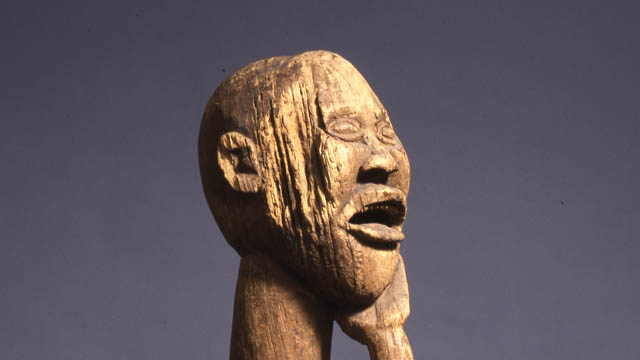
-
 Joseph Essuman
Joseph EssumanChoosing this object stemmed from my experience I had when my mother passed away in my arms. It was a painful reminder of mum's death when I saw the facial expression of the object. The question was; ‘So after all the painful moments she went through, she could not stay a little longer for me to pamper her before she died’? I therefore want this to be part of the project so that the world would appreciate responsible mothers and motherhood no matter the circumstance.
To be a mother marks female social completion in Africa especially among Ghanaians where motherhood is a pride. Without it, one is not quite an adult, or certainly not an adult who receives full respect. Images of this nature, especially in most communities of Ghana are very significant because of the belief systems of the indigenous people before conversion to Christianity or Islam. Though not so common today as a result of modernization and or Christian and Muslim religion as compared to a decade or two ago, it is still believed that, regardless of the changes in time and technology, these beliefs are still as revered as it used to be.
This work is a wood carving in the round portraying a standing, heavily-pregnant woman with her left hand on the chin; but laid on the left breast with the right-hand providing support beneath her belly. The legs are bent at the knees and she has a painful facial expression.
It is a semi-abstract form of work that is 161cm high which stands firmly on a pedestal. The pose of the figure gives an idea of life and death. The opened wide mouth indicates the pain she must be going through and the hand beneath the belly indicates a support for the weighing pregnancy and support for the unborn child.
The concept behind this piece of work depicts strain and stress most women go through before giving birth and it symbolizes fertility and good health. The elongated breasts suggest the vulnerable state of the woman though it has lots of breast milk to feed the unborn child.
This carved image is a representation of a pregnant woman which signifies life. This figure could be interpreted to represent several ideas in different cultures. However, Costa (2019) opined that, a wooden figure of a nude pregnant woman, which has been present at events, is not the Virgin Mary, but a female figure representing life.
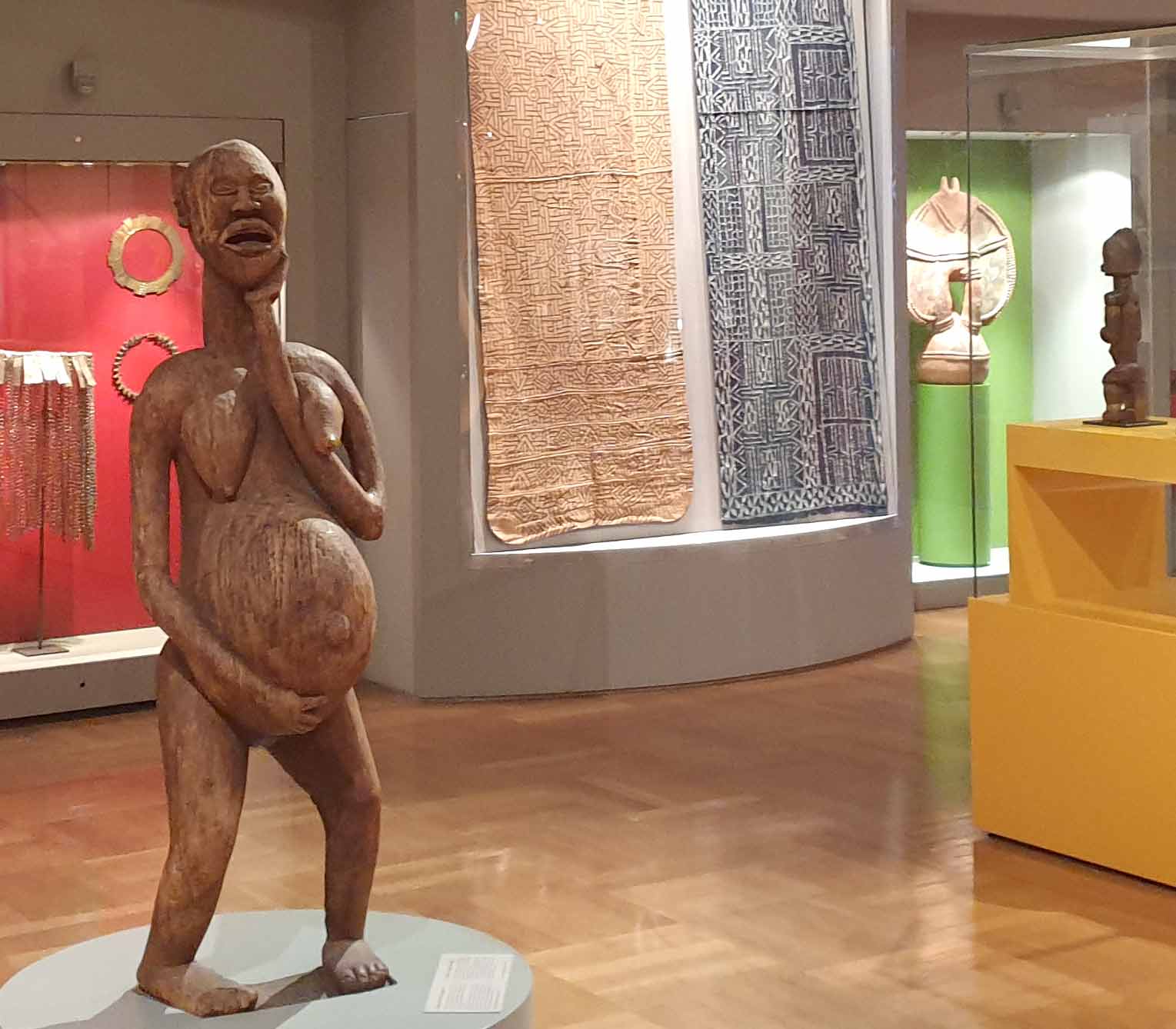
Anonymous artist, first half of the 20th century, wood, 161 cm, Bamileke, Cameroon (Photo Ernst Wagner)
In a similar narration, Costa (2019) said that, a wooden figure of a pregnant woman has been described as both a Marian image and as a traditional indigenous religious symbol of the goddess Pachamama, or Mother Earth. Costa maintained that it is an indigenous woman who represents life; it is a feminine figure and is neither pagan nor sacred but represents life through a woman.
Fundamentally, many indigenous Ghanaians believe that women are like trees that produce and reproduce to sustain life continuity. The woman is also believed to be a fertility goddess. It is with high esteem therefore that Ghanaian women who are capable of giving birth are exalted. As a result, these images or similar ones have been used to ‘serve’, particularly in the Akan and Ewe dominated communities in Ghana. They are seen as religious figures, an expression of health, fertility and grandmother goddesses, and they have over the years served as ritual or symbolic function.
Without children one cannot have a traditional funeral nor become an ancestor. While these issues relate to men as well as women, infertile men can acquire children through cooperative wives who ensure they become pregnant. Unfortunately, per the traditions of Ghana, women do not have that option. In practical terms, wives who are childless may be divorced or have to accept a co-wife. They have no support in their old age, if their husbands die, because that is the duty of children. In extreme cases, they are sometimes ejected from the husband’s house no matter their economic or social status and endure the pity or mockery of family members, friends, and acquaintances.
In most communities in Ghana, it is believed that babies born after a longed-for conception often bear names that reflect their mothers’ anxiety. For example, ‘Brenya’, which literally means “suffer and get” is such a name from the Akan people of Ghana. Also, ‘Nukomeko’, which literally means “I just laugh” is one of the names from the Anlo-Ewe of southern Ghana. These names are among many examples that reflect joy, triumph and satisfaction in a successful delivery after the pain of barrenness. Other names pointedly refer to previous distress and are meant as retorts to those who might have tried to block their pregnancy or had made fun of them. Examples are; ‘Dzitorwoko’, literally means “Only those who have the heart”, Azunukpenawo “It will be shame unto them”, or Nyavedzi “Matter that grieve the heart”. There are other unpleasant names that parents give their children as a mockery in return for what they suffered from either family, and/ or for child mortality. This has been buttressed by Agyekum, when he says that,
“the Akans, like other cultures in West Africa, believe that if a mother suffers constant child mortality, then the reason is that it is the child’s mother in the underworld that does not want the child to stay in the living world. To combat such an unfortunate situation, the parents give the child a weird name (2020: 221).”
For instance, a name such as ‘Asaaseasa’ which literally means ‘the land is finished’ is one of the many names that is used to combat such a situation. This suggests how important pregnancy and childbirth are revered in most communities in Ghana.
So, in the olden days in Ghana, just like in many parts of Africa, girls have received doll-like figures to care for – not as playthings when they are children, but as teenagers preparing for marriage. This sometimes occurs during initiation practices, when their attentiveness may be assessed. In the meantime, the girl would be detached from her family and allowed to stay alone in a small structure. The doll serves as her sole companion, and she “feeds” it, washes and oils it, decorates it with seed beads at neck or hips, and otherwise tends it like the infant she hopes to bear. Most of these dolls are made of females, as their breasts and genitals indicate. The reason being that, female children are especially desirable in order to increase the size of the matrilineage despite the desire that fathers always want their names to remain as a memorial for generations yet to come.
In direct reference to the subject under review, it is suggested that the woman is undergoing some form of pain. But as to whether it is a labour pain, abdominal pain, or crumps, could be a subject of debate depending on individual’s discretion.
It is good that technology has improved greatly over the years and there is a complete education on pregnancy as I try to analyze this piece of artwork. It is therefore necessary to note that these forms of education are very essential and there is no doubt that it will remain useful and also see tremendous improvement with time. Most of these challenges are normal occurrences during adulthood as stated earlier. It is in sharp contrast to what is used to be the case among other people across the globe where such issues are most often associated to evil spirit attacks hence creating fear in prospective mothers and a potential threat to motherhood.
It is relevant to note that womanhood is an undisputable way to ensure life’s continuous existence. In that regard, one can conclude that this artwork is tangible, contextually realistic (though physically semi-abstract) and precise to address the question of whether it communicates, represents or symbolizes the argument in the text. The world today and future will find its educational and cultural relevance as outlined in the context above. It is also appropriate to conclude that the interpretation of the meaning of the object was based not only in the belief systems of Ghanaian communities but transcultural significance and sensitivity to cultural aspects with regards to tolerance and respect as subjects of consideration.
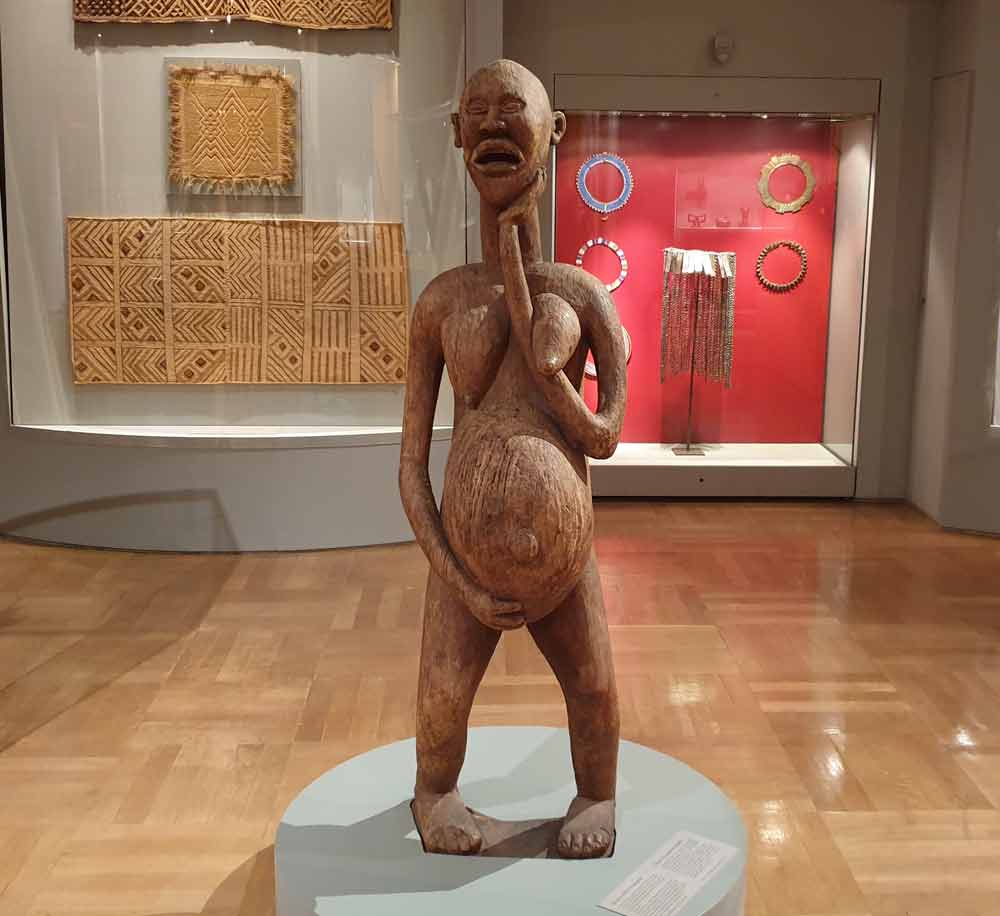
Anonymous artist, first half of the 20th century, wood, 161 cm, Bamileke, Cameroon (Photo Ernst Wagner)
References
- Costa, G. (2019). A communications official for the Amazon synod: https://www.catholicnewsagency.com/news/amazon-synod-final-report-an-instrument-communications-official-says-36081. Retrieved On the 19th March, 2020.
- Agyekum, K. (2006) The Sociolinguistic of Akan Personal Name: http://www.njas.helsinki.fi/pdf-files/vol15num2/agyekum.pdf. Retrieved On the 19th March, 2020.
This article is part of a gallery: Perspectives from Ghana on Museum Objects in Germany, published January 2021
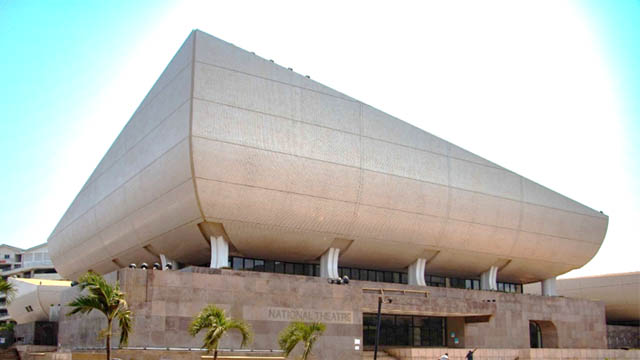
-
 Ebenezer Kwabena Acquah
Ebenezer Kwabena AcquahThis essay seeks to draw readers’ attention to the National Theatre of Ghana in order to recognize its relevance within the country’s visual cultural landscape. The National Theatre is a monumental edifice situated in the nation’s capital, Accra. It is supported by the government, and largely devoted to musical performances and stage productions, among others (Wilson, 1988). Theatrical performances in the National Theatre are part of the nation’s cultural heritage and present the people with creative thoughts and reflections on life. The establishment of the National Theatre of Ghana was, to a large extent, largely supported by the National Theatre Movement of the 1950s by cultural experts like Efua Sutherland and Professor J. H. Kwabena Nketia (Agovi, 1990).
The National Theatre was completed on December 16, 1992, commissioned and handed over by the Peoples Republic of China to the Government of Ghana on December 30, 1992 (www.nationaltheatre.gov.gh/history/ retrieved 2020, August 7). The Theatre was designed to be used by people from all walks of life and diverse age groups. Since its inception, the National Theatre has hosted a number of performances and exhibitions from both local and international communities with the intention of promoting visual culture in a heterogeneous global landscape.
Location, Structure, and Artistic Appreciation
The boat-like building is located near the junction of Liberia Road and Independence Avenue, adjacent to Efua Sutherland Children’s Park, in Accra’s central district.
Three distinct structural forms comprise The National Theatre building, with each structure housing its own performance group/company: the National Theatre Players, National Dance Company, and the National Symphony Orchestra. A closer look at the entire structure reveals three distinct parts aside from the structural forms mentioned earlier. The upper part portrays three boats joined together, supported by rectangular piers with curved outward projections, and a rectangular base with entrance and exit openings. In fact, the entrances and windows seem to be carved out of the rectangular base. All of the entrances are elevated from the ground level with a staircase, which leads up to the glass entrances and into the building (https://3rdworldarchitecture.wordpress.com/2018/02/04/national-theatre-of-ghana/ retrieved 2020, August 7). The base is designed to create a projection at the entrance that provides visitors with the necessary protection from inclement weather.

National Theatre. Aerial view over National Theatre. Photo: Cheng Taining, 1997, link: https://archnet.org/sites/1413/media_contents/15315.
Above the base, there are distinct white forms. They taper upwards from the centre and meet towards the outside of the base. The walls curve inwards and are lifted just above the solid base, with glass in between them, making the base and white forms more distinct and thereby reinforcing the differences between them. Small white tiles cover these forms, giving the building its shape and colour. A closer look at the shape of the National Theatre reveals a display of three boats/canoes or fishing vessels that meet at a central point, which takes the form of a captain's bridge. The entire structure is supported by curvy piers and rests on a rectangular base as presented in the image above.
A careful study of the architectural ‘language’ of the National Theatre reveals a combination of interior and exterior Asian architecture, symbolic Ghanaian forms and boat construction. Generally, Chinese architecture is based on the relevance of influential local cultural traditions and adherence to hierarchy (Lianto, 2020). It prioritizes spatial designs with balanced symmetrical central pivots and a reverence for nature and aesthetics. Additionally, the dominant use of red represents happiness, which is also found throughout the interior of the National Theatre.
The curvy structure of the theatre in general nods towards Asian architecture. The seating space is segmented along stepped floors and the undulating structured ceiling is reminiscent of waves with openings defined by lighting systems. In fact, the use of sculptural forms and other Ghanaian art works effectively combine with the architectural structure to convey the visual cultural landscape of the National Theatre.
Sculptures in Public Space
Sculptural forms executed by Ghanaian artists are carefully displayed outside the National Theatre. The following image shows a sculptural work that depicts a Sankofa, a traditional Ghanaian symbol.
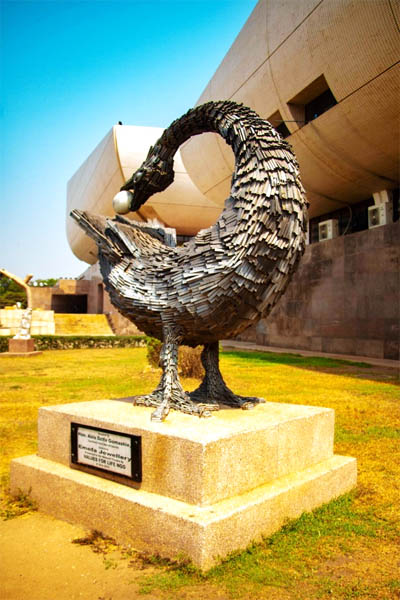
Emefa Jewellery, Sankofa, 2015, H: 11ft., Presented by Values for Life NGO to the National Theatre, Photo: Wisdom Dzigbordi.
The Sankofa represents taking the opportunity to reflect upon the past and applying significant and relevant ideas to current developments. Thus, the past has something relevant that must be considered and utilized as part of contemporary practice.
Education and Cultural Relevance
The National Theatre of Ghana is a significant cultural centre in Accra, Ghana and the entire form of this visual cultural structure provides people from diverse walks of life a place for entertainment and relaxation. The building is a visual architectural icon for the city and is an influential hub for creative art performances. It therefore serves as an important edifice to promote the arts, offering both Ghanaian and foreign artists a place to express their creativity.
In addition to providing entertainment and relaxation, the theatre seeks to educate people and stakeholders (who periodically use the place) on the responsibility of the National Theatre of Ghana as a strong cultural institution that ensures the development of culture, including the performing arts, and the need to respect cultural values. Through this education, the activities of the theatre are brought into focus, preserved, promoted and transmitted to the next generation for posterity and the promotion of visual culture across the world.
References
- Agovi, K. E. (1990). The origin of literary theatre in colonial Ghana, 1920-1957. Research Review, 6(1), 1-22.
- Frimpong, M. (2015). Towards an audience development plan for the National Theatre of Ghana. Unpublished Thesis. University of Ghana, Legon.
- Lianto, F. (2020, August 9). Building structure system of Chinese architecture, past and present. Retrieved from https://www.academia.edu/33602498/BUILDING_STRUCTURE_SYSTEM_OF_CHINESE_ARCHITECTURE_PAST_AND_PRESENT
- National Theatre of Ghana (2020). History of the National Theatre of Ghana. Retrieved on January 10, 2020 from http://www.nationaltheatre.gov.gh/history
- Wilson, E. (1988). The theatre experience (4th ed.). New York: McGraw-Hill Book Company.
- 3rdworldarchitecture.wordpress.com (2018, January 4). National Theatre of Ghana. Retrieved from https://3rdworldarchitecture.wordpress.com/2018/02/04/national-theatre-of-ghana/
published August 2020
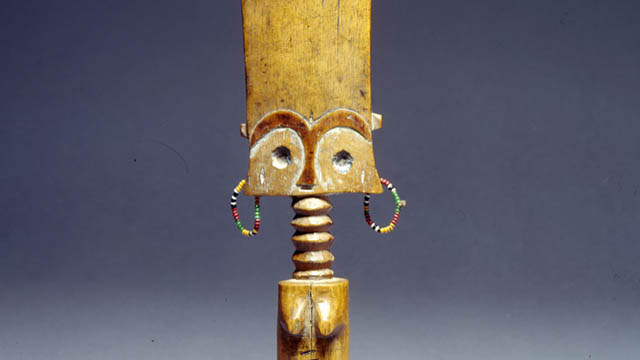
-
 Gertrude Nkrumah
Gertrude NkrumahInversion of Hegemony with Ideas of Femininity
Scholarly works abound on factors and causes of gender inequality in the Ghanaian society and many of these writings address gender inequality solely in terms of women as the victims and thus reinforcing the gender stereotype of female passivity. Although this is true in most cases, such studies do not necessarily address the question of how women have responded to and addressed issues of gender expectations and gender-related roles in African societies. By using the ‘Akuaba’ doll (fertility figurine), this research seeks to explore how the concept of womanhood has been portrayed and represented through time in the Ghanaian society among the Akan ethnic group. It seeks to extend an argument for the interpretation of these images beyond the depiction of women as sexual objects to that of creating an inversion of female hegemony in the society. I argue that instead of considering gender stereotypes as an all-pervasive oppressive tool, we must begin to think of the finer nuances and conceptualize how women have shaped, redefined, and negotiated socio-cultural construction of gender.
The object is widely referred to as the fertility figure, also known as the Akuaba doll among the Akans of Ghana. My reasons for selecting this object are two-fold. Firstly, it speaks to my childhood experiences as a girl growing up in an Akan society and secondly, as someone who is very passionate about gender-related issues either from an intellectual and personal perspectives, I was motivated to choose for this project an object that I can easily relate to, both from a personal and intellectual perspectives.
The object in question is the depiction of a female body, an exhibition of the Akan concept of an ideal woman. The features include a flat forehead with an elongated “ring-like neck shape”1 which reflects Akan standard of beauty. The understanding is that a woman with this type of neck is well-fed, healthy, and strong, a paragon of beauty and affluence. The flat broad forehead also is an embodiment of wisdom, while the accentuated breasts and hips with beads worn arounds the waist is the Akan ideal of womanhood, a depiction of woman as the giver of life. The beads worn around the waist has both aesthetic and symbolical meanings. In terms of beauty, beads were worn as an ornament for beautification, just as portrayed by the wearing of the jewels around her ears. It was also believed that wearing of beads around the waist is sexually appealing, while beads were also worn to broaden the hips and shape the waist for reproductive purposes. It is important to note that in the Akan society, and indeed in most Ghanaian culture, an ideal woman is one that carries and bears children. Clearly, ideas of beauty, sexuality and reproduction were the very essence of womanhood or femininity in the Akan society.
According to a very popular Akan oral tradition, the Akuaba doll is deeply rooted in one’s woman’s quest to overcome her inability in meeting societal ideas and expectation of womanhood.2 Akua, a childless woman, consulted a ritual specialist for a child. She was instructed to go to a woodcarver and make a doll of her choice for a child. Some rituals were then performed on the doll and given back to her to take home and treat and care for as her child. Later she became pregnant and gave birth to a daughter, just as she desired. The Akuaba doll then became symbolic for female reproduction. Amenumey explains that the Akuaba dolls were “…supposed to induce fertility and pregnancy….”.3 Among the Akan, like most precolonial Ghanaian societies, the concept of womanhood was largely defined and shaped by a woman’s ability to give birth to as many children as possible. Childbearing was a blessing from the gods and was usually celebrated with pomp and merrymaking. For instance, the custom was to reward a man whose wife has given birth to ten children with a sheep. The Akan refer to this as “badudwan”4 literally, a sheep for the tenth child. This was usually provided by the wife’s family to the husband to show their appreciation for the replenishing and sustainability of their family.5 In the quest to attain such feat, women worked hard to give birth to at least this number of children as prove of her worth to her husband and the society. This undoubtedly made women who were childless in the society feel undervalued and highly marginalized.
Such ideas and concepts of womanhood and inadvertent marginalisation of women still resonate in contemporary Ghanaian society and indeed in most contemporary societies. A woman’s value and worth continue to be tied with her sexual and reproductive abilities. Although women at present now have access to spaces and engage in works that go beyond the traditionally assigned roles of wife and motherhood (sexual and reproductive values), a woman is still expected to neatly fit in with socio-cultural construct of gender. This underscores the value place on women’s sexuality and reproduction to the detriment of other roles beyond these norms, thus leading to the marginalization of women. It is for these reasons that scholars such as Lerner and Allman have often called for the need to question entrenched patriarchal norms that undermine women’s oppression while it reinforces male- superiority.6
The understanding that women have continually been passive and largely detached from the making of their own history and are mere tools in the hands of a patriarchal society is neatly contested by the history behind the Akuaba doll. While it is true that it was Akua’s desperation to fit into societal expectation of ideals of motherhood that forced her to consult a diviner to help her conceive a child, the knowledge that Akua chose to actively engaged with the process of making the doll; how the doll is carved out, the shape, the physical features, and the aesthetic nature is significant. Additionally, the fact that she chose to carve out a girl child clearly indicates the active role she played in redefining and negotiating power with the matrilineal, yet patriarchal society, thus creating and inverting power in an all-pervasive patriarchal institution. It is also an indication that she did not consider the female as of little value in her society.
Paradoxically then, the history and philosophical ideologies that underpin the concept of the Akuaba doll is a clear exhibition of the nuances and complexities of societal construction of gender roles and status. In a society with a deeply entrenched gender expectations and assigned gender roles, it is remarkable that Akua sought to circumvent, manipulate, and yet conversely acquiesce with existing status quo to her advantage, an inversion of hegemony amidst patriarchal privilege. Therein lies the ambiguities and contradictions of performing gender.
References
- Addo-Fening, R (1973). Asante refugees in Akyem Abuakwa 1875-1912. Transactions of the Historical Society of Ghana. 14, 1. 39-64.
- Akyeampong, E & Obeng, P. (1995). Spirituality, Gender, and Power in Asante History. The International Journal of African Historical Studies. 28, 3. 481-508.
- Allman, Jean. (1996). “Rounding up Spinsters: Gender Chaos and Unmarried Women in Colonial Asante.” Journal of African History, 37, 2, 195-214.
- Amenumey, D. E. K. (2008). Ghana: A concise history from pre-colonial times to the 20th Century. Accra: Woeli Publishing.
- Appiah Anthony K. (1991) “Is the Post- in Postmodernism the Post- in Postcolonial? Critical Inquiry. Vol. 17, No. 2. 336-357.
- Lerner, G. (1994). The creation of feminist consciousness: From the Middle Ages to 1870. Oxford: Oxford University Press.
- Lerner, G. (1986). The creation of patriarchy. New York: Oxford University Press.
Footnotes
1) It is quite common today to hear songs in the Ghanaian society eulogising a woman’s beauty by referring to her ring-shaped neck, together with other physical features. This is an indication that the Akan standard of beauty in the past as enshrined in the Akuaba doll continue to resonate with contemporary Ghanaian societies.
2) This is a popular story among the Akans and was often recounted to young girls especially by an older woman in the family or society. I grew up listening to these stories from my mother and grandmother, among others.
3) D. E K. Amenumey. (2008). Ghana: A concise history from pre-colonial times to the 20th Century. Accra: Woeli Publishing. P. 90. From a spiritual and philosophical perspectives, the use of the Akuaba went beyond just fulfilling the desires of childless women. In most of these Akan societies, when a woman gives birth to twins but in an unlikely situation where one of them dies, she is expected to make a replica of an Akuaba doll in replacing the dead child. Some would also bury the dead child with the Akuaba doll as a way of warding off evil spirit from killing the living child.
4) “Badu” is an Akan name for the tenth born child. ‘Ba’ or ‘ɛba’ is the Twi word for child, while ‘ɛdu’ or ‘du ‘means the number ten in the Akan language. Therefore, the name Badu in Akan usually refers to a tenth born child.
5) It is significant to point out that Akan society, unlike most ethnic groups such as the Mole-Dagbani, Ewe, Ga-Adangbe and Guan, is mostly a matrilineal society. Lineage, inheritance, and chieftaincy succession have always been through the female line. Although precolonial Akan society was not completely immune from patriarchal ideals, women played important roles and and had significant status in society especially in areas of religion, politics and economy. For further details on this, see for example the articles Addo-Fening, R (1973). Asante refugees in Akyem Abuakwa 1875-1912. Transactions of the Historical Society of Ghana. 14, 1. 39-64 & Akyeampong, E & Obeng, P. (1995). Spirituality, Gender, and Power in Asante History. The International Journal of African Historical Studies. 28, 3. 481-508.
6) See for example, Allman, J. (1996). “Rounding up Spinsters: Gender Chaos and Unmarried Women in Colonial Asante.” Journal of African History, 37, 2, 195-214, Lerner, G. (1994). The creation of feminist consciousness: From the Middle Ages to 1870. Oxford: Oxford University Press., & Lerner, G. (1986). The creation of patriarchy. New York: Oxford University Press.
This article is part of a gallery: Perspectives from Ghana on Museum Objects in Germany
published January 2021
 ISB_Team
ISB_TeamA German Perspective on the Akuaba Doll in the Museum Fünf Kontinente Munich
Akuaba Dolls are wooden figures that were and apparently still are in use mainly in rural areas in southern Ghana. Young women hoping for pregnancy or - if they are already pregnant - for the health and beauty of their child, wear these figures on their bodies like real babies and take care of them. That is why they are called 'dolls'.
Akuaba or better Akua-Bà literally means 'child of Akua'. The story tells of "a woman named >Akua< who could not get pregnant and went to a local diviner or priest and commissioned the carving of a small wooden doll. She carried and cared for the doll as if it were her own child, feeding it, bathing it and so on. Soon the people in the village started calling it >Akua< >ba< - meaning >Akuaba's child<, since >ba< means child. She soon became pregnant and her daughter grew up with the doll." (Annor et al., p. 308)
This story also forms the basis for the function of the widespread dolls as aids in a desire for pregnancy. An Akuaba Doll expresses this desire for a child, so the figure is 'cared for' by a girl from puberty onwards. This happens within the family. Outside the family, Akuaba Dolls can be found in shrines under the care of a ritual specialist, where they can be borrowed for their purpose.
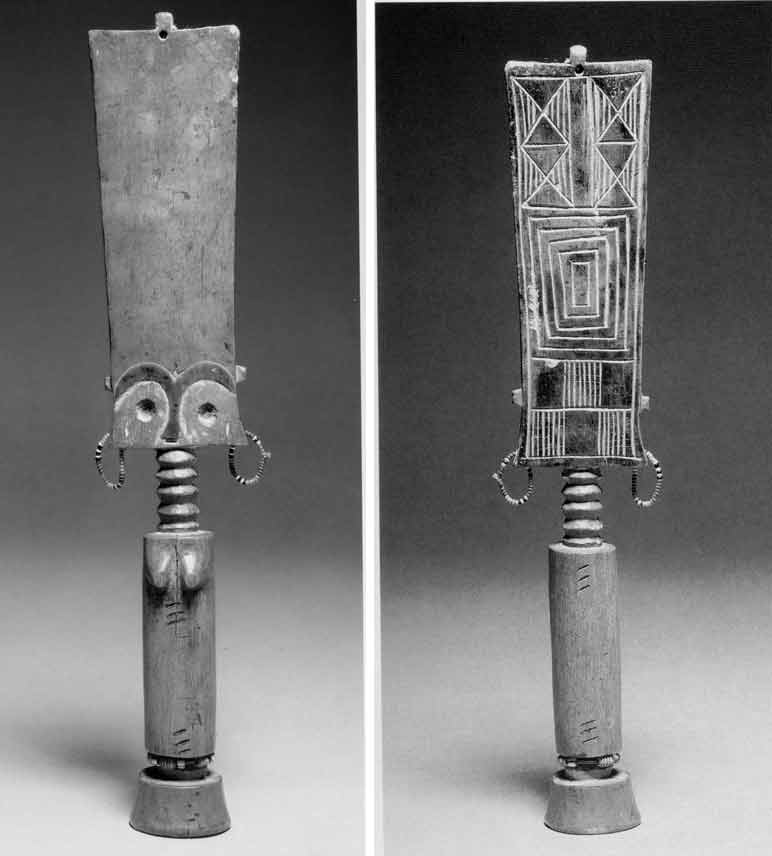
Fig. 1 & Fig. 2 Views of the Akuaba Doll in the Munich Museum Fünf Kontinente
Anonymous artist. Fante Fertility Figure. Early 20th century, Wood. 27,5 cm. Museum Fünf Kontinente. Presentation at Museum Fünf Kontinente.
© Museum Fünf Kontinente
Description
The doll in Munich's Museum Fünf Kontinente (Fig.1) comes from the Fante area. It shows a female figure. The very strongly abstracted forms and proportions symbolise various aspects:
The rectangular shape of the very flat head becomes - seen from the front - somewhat broader in an elegant curve towards the top. A strikingly high forehead, with eyes, eyebrows and nose only indicated, while mouth and ears are missing. The accentuated arch segments of the eyebrows flow together and then form the nose. On the back, the head has geometric patterns (Fig. 2). Added earrings of glass beads give the figure a colourful accent. For Kecskési (p. 38), their daintiness is a sign that the doll has been lovingly treated. At the very top there is another small moulding with a hole where hair was originally attached (compare Fig. 3a).
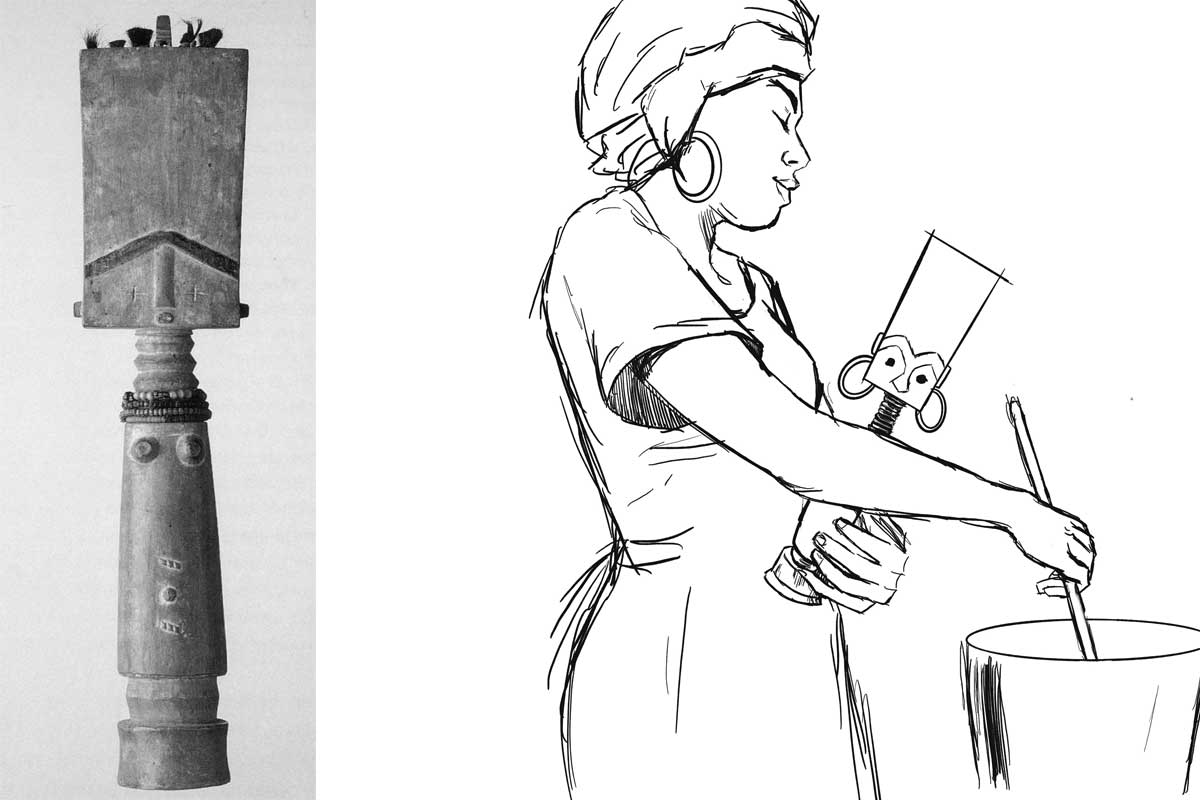
Fig. 3a: Akuaba Doll from the Linden Museum Stuttgart (Forkl p. 94). Fig. 3b: Use of the doll (drawing by Vanessa Rast - courtesy the artist)
The neck has five rings. It sits on a very slender, round trunk, which in turn stands on a delicate base. Striking are two groups of three diagonal embrasures each, which are repeated on the back. The figure has no arms, the legs are short stumps. The protruding forms in the chest area mark the figure as female. Its strict symmetry is softened by small deviations. One can well imagine taking the cylindrical figure in one's hand.
Material and technique
A ritual specialist to whom a woman who wishes to have a child goes makes the decision about the choice of doll at the respective shrine. If no suitable figures are available there, he instructs the woman to order a new Akuaba Doll from the woodcarver. The craftsmen then visit the tree to obtain the wood and ask the tree's spirits for permission to do so (oral information from the Ghanaian colleagues 2022 in Bayreuth [Link]). The Akuaba Doll in the Munich Museum was carved from softwood. (There are also darker examples made of hardwood, for example among the Ashanti, also an Akan group, as the presentation in the Ghana National Museum in Accra shows - see Fig. 4.) In the example in Munich, eyebrows and nose are darker.
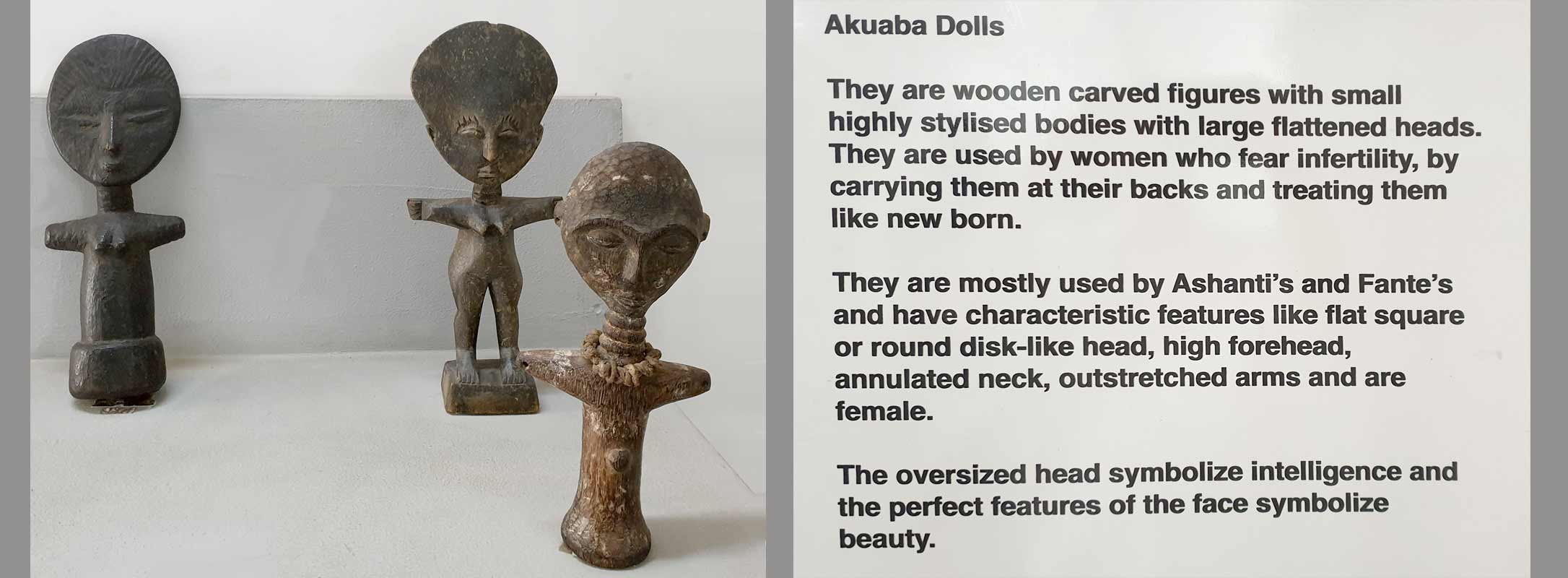
Fig. 4: Presentation of Akuaba Dolls at the Ghana National Museum in Accra (March 2023. Photo: the author)
Interpretation of the Munich figure within the original Ghanaian context
(1) Utility function: The figure is made for the family context. It is meant to lead to fertility, sometimes also to the beauty of a child. The size (height 28 cm), the pleasant material and the weight allow the figure to be carried and cared for like a baby. When an Akuaba Doll has fulfilled its task, it is often returned to the ritual specialist who accompanies the process.
The breasts indicate a female figure, which does not necessarily have to do with a corresponding desire for the sex of the child desired. Forkl (p. 94) assumes, however, that "women desire daughters, on the one hand as progenitors in a matrilineality oriented society, and on the other hand as support in household work." (There are also Akuaba figures with the characteristics of both sexes and probably male specimens; furthermore, breastfeeding examples and those who in turn carry other Akuaba Dolls.)
(2) Body shape: T The conspicuous and disproportionately large rectangular head symbolises the head as the seat of intellect and wisdom in local imagery. Akuaba figures among the Ashanti show round heads (see fig. 4), but they are also proportionally very large. High foreheads and flat faces correspond to the ideal of beauty. Luxuriant bulges on the necks tell that the figure is well-fed and thus refer to happiness and prosperity. There are Akuaba Dolls that show more feminine body shapes, wider hips, possibly emphasised by strings of pearls.
(3) The spiritual context: As Nkrumah writes in her contribution, an Akuaba figure serves as a dwelling place for a soul being, a being that is in a transitional area between the earthly and the spiritual world. Carrying and caring for it is a prerequisite for the entrance of such a soul being, which then sets out to appear on earth as a living being, i.e. to enter the family of the young woman through birth. A ritual specialist is involved in the selection, consecration and regulations for use. After a birth, the figure is returned to the ritual specialist.[1]
(4) The social and cultural context: The figure can also be seen as a sign of the traditional expectation for a woman to bring children into the world. In recent times, where traditional societal expectations of women collide with other worldviews, the ritual use of Akuaba Dolls obviously decreases .

Fig. 5: Souvenir shop at Accra Airport (March 2023. Photo: the author)
In the last decades, an interesting production for tourism has been established - apparently the dolls are seen as 'typical for Ghana'. However, these are not Akuaba Dolls in the traditional sense, but rather 'quotes'.
How can one relate Akuaba Dolls to European visual traditions and experiences?
As familiar as the image of an Akuaba figure may seem in Europe - as a 'typical' example of traditional African art - its traditional meaning is unknown in Europe. Nevertheless, it obviously seems to be attractive to tourists, e.g. as 'airport art' (see Fig. 5), perhaps because its shape somehow corresponds to the cliché idea of 'typically African', the size fits well into the suitcase, or the large head (by means of the Bambi effect) makes it appear 'cute'.
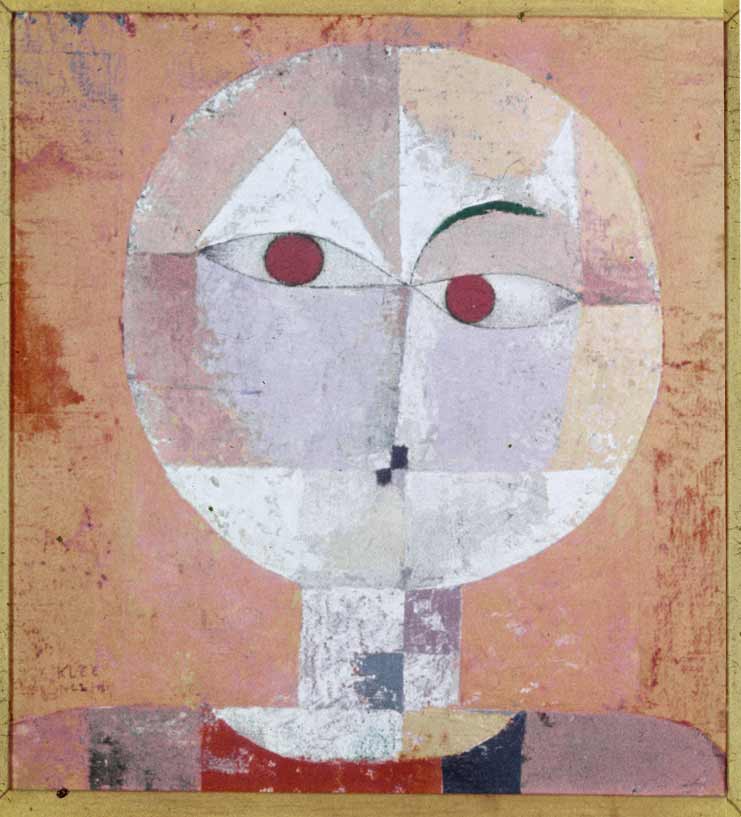
Fig. 6: Paul Klee. Senecio. 1922. Oil on chalk base on gauze on cardboard. 40.3 × 37.4 cm. Kunstmuseum Basel (Wiki Commons)
In the context of art history, the influence of Akuaba Dolls (and many other carved representations from West Africa) on European art of the early 20th century (see Fig. 6) is of interest. [2] The formal similarity to Klee's painting (fig. 6) is striking at first glance, but whether this is a direct reference must first be verified. In the context of art history, it would then be of interest in a next step which aesthetics were of interest to the artists at the time and which they blanked out, i.e. which "image of Africa" they wanted to have and also communicate.

Fig. 7: Hieroglyph Anch
(Photo: https://anthrowiki.at/Anch)
The authors also considered whether the formal similarity of the Akuaba Dolls with the ancient Egyptian hieroglyph ‘Anch’ (the "loop of life" or the "key of life" - see Fig. 7) could have come about through a historical relationship between Egypt and Ghana. This would also correspond to the accentuation of content in Nkrumah's text with regard to the "representation of the woman as the giver of life" (see her chapter). Nevertheless, this association would also have to be examined more closely. To assume a universal archetype in the sense of C. G. Jung appears to be pedagogically misleading in its levelling effect.
In the German educational context, on the other hand, it seems important to link the figure - beyond clarifying its function - to Akua's story and thus include the role of narratives. This prevents another comparison that is also too quick and reductive when it comes to social practices (and not the isolated object), as dolls are also cared for and nurtured in traditional European contexts, but mostly by young children before puberty. So, in Europe, it does not belong to a fertility ritual, even if the child puts itself in the role of a ‘little mother’ or ‘little father’. (Another interesting question, whether Ghanaian women also go to a doctor when they are not pregnant, and whether there are comparable ritualised practices in Central Europe - for example among alternative practitioners or in esoteric circles - would have to be addressed in interdisciplinary approaches.)
Such comparisons appear to be useful, as they can show both similarities and differences, with the aim of better recognising one's own perceptual conventions or stereotypes and thus putting them into perspective. All this still leaves the question of the status of this doll in Munich when it is displayed in a showcase in a European museum (see Lab entry: What is an object? Link). Such a presentation contradicts its ritual and spiritual use. An Akuaba is then no longer an Akuaba. But what is it then?
Sources
This text is based on:
- Contribution by Gertrude Nkrumah: https://explore-vc.org/en/objects/the-akuaba-doll.html
- Talks with the Ghanaian EVC partners in Bayreuth in 2022: https://explore-vc.org/en/activities/archive/april-22-25-2022-joint-workshop-uew-team-and-isb-team.html
- The presentation at the National Museum in Accra, seen in March 2023: Fig. 4.
- Reading: see list of references
References
- Akyeampong, E & Obeng, P. (1995). Spirituality, Gender, and Power in Asante History. The International Journal of African Historical Studies. 28, 3. pp 481-508
- Anderson, Elizabeth L. (1989): The Levels of Meaning of an Ashanti Akua'ba. In: Michigan Academican. 21 205-219
- Annor, I., Dickson, A & Dzidzornu, A. G. (2011): General Knowledge in Art. Accra (Aki-Ola Publications)
- Forkl H. (1997): Healing and body art in Africa. Stuttgart (Lindenmuseum)
- Kecskési, M. (1999): Kunst aus Afrika - Museum für Völkerkunde München. Munich (Prestel)
Footnotes
[1] The number of five neck bulges here (there are also specimens with 3, 8 or 9 bulges) may also be a reference to the sacred number of "Odumankoma", the Akan creator deity, in this context.
[2] On the relationship of the European avant-garde to the aesthetics of West African carvings, see also the discussion of the Blue Rider post on this website (link 1 and 2).
 Christin Winter
Christin WinterMy Encounter with Black Feminism and Womanhood Inspired by the Akuaba Doll
I first came in contact with the Akuaba Doll while reading Bernardine Evaristo’s award winning book Girl, Woman, Other. In the book, the character Nazinga was described as “at least six foot tall with ornamented dreadlocks, large wooden Akuaba fertility doll earrings, red trousers, a cream embroidered caftan and strappy Roman sandals“ (Evarsito 2020, p. 81). I searched for Akuaba fertility doll earrings on the internet, but did not delve further into the topic at this time. A few weeks later, attending a seminar with Dr. Wagner at Friedrich-Alexander University in Erlangen, I stumbled upon the Akuaba Doll again. I knew, I had to take this opportunity to get to know her better. The comment from Gertrude Nkrumah is to be considered my first source of information about the history of origin and the tradition into which the Akuaba Doll is woven.
Through Nkrumah's feminist perspective on the Akuaba Doll, I wanted to dive deeper into the topic of Black Feminism to extend my knowledge in feminist theory. With the Akuaba Doll as my point of departure, I decided to focus on the ability to bear children and the social significance of abortions for Black women.[1]
At this point I move past the Akuaba Doll and her cultural context. Other works of art could have led me to a similar path. I have chosen to look at the Akuaba Doll with categories, which are not directly related to the Akuaba Doll and her cultural context as I questioned whether I have the right to write about the Akuaba Doll considering the colonial past of my own country, Germany. I am a white, European woman, a feminist, who is aware of intersectionality and racist structures within the society I have been socialised in and its way of thinking, but with no cultural connection to the Akuaba Doll other than the colonial impact on African art and culture (cf. Kushinator, Rahman and Dompreh, 2020[2]). Therefore, I chose a topic to which I have access via my role as a student of pedagogy and focus on Black Feminism and Womanhood of Black women living in white-dominated countries.
In white-dominated societies, Black women were excluded from a feminist movement for decades (cf. hooks, p. 216f.). White women systematically utilised the racist hierarchy within women to gain power and thereby forced a specific Black feminist movement to form and uncover the oppression Black women had and still have to face. The prefix “Black” emphases the specific oppression Black women face in white-dominated countries, although, of course, there has been feminist movements in Black-dominated countries before (cf. Roig quoted from Berlin Biennale 2022, 48:00 – 49:50).
In American history, Black women have always had to fight to be seen as women. As bell hooks gets to the heart of it: “the black female was a creature unworthy of the title woman; she was mere chattel, a thing, an animal” (hooks 2015, p. 214). Sojourner Truth[3] had to bare her breasts to prove that she was a woman indeed. Being yelled at “I don’t believe you really are a woman” by a white man represents the contempt and disrespect for Black womanhood (cf. hooks 2015, p. 214). In her famous speech “Ain’ I a Woman” (1851), she argues, that she – as her white women audience too – is indeed a woman. Here she argues with characteristics, that can also be found in the Akuaba Doll. The most important argument is the carrying and bearing of children and the “mother’s grief” (Truth 1851 quoted from hooks 2015, p. 215) she cried out, when her children were sold into slavery.
The ability to bear children has always played an important role in the history of womanhood and was – and still is – utilised to oppress and exploit Black women. In times of slavery, Black women were forced to procreate and bear children, who were worth a lot of money in a perfidious system of human trafficking (cf. Federici 2020, p. 23f.). In the late 20th century, Black men in the U.S. reasserted what they called their “rightful positions as patriarchs” (Taylor 2022) and denounced birth control and abortions as genocide that compromised the future and freedom of Black families by limiting the Black population (cf. Federici, p. 25f.). With the overturn of Roe v. Wade[4] – Black women are specifically affected, as Kwajelyn Jackson, Executive Director of the Feminist Women’s Health Center in Atlanta, Georgia puts it into a nutshell: "Abortion bans are inherently racist because they do not consider the lived experiences of Black people and other communities of colour. Many state policymakers would rather criminalize and endanger Black birthing people than supply them with all of the resources they actually need" (Jackson quoted from Long 2022). Even before the abortion laws were restricted, Black (and other BIPoc) women in the U.S were two to three times more likely to die from pregnancy-related causes than white women (cf. CDC 2019). Being allowed to decide whether you want children or not and furthermore, having access to certain facilities to end a pregnancy or not is still a bound to privileges. It is not only tied to the health care system, but also to cultural beliefs and practices, to the financial and educational background, as well as to class, race and many other factors.
In a world imprinted by patriarchy and privilege, it is important to unravel power structures that dominate our world, uncover where they come from and how different groups are affected differently. As patriarchal patterns of thought are inscribed in nearly all societies of our world, it is a tough task to uncover them in every aspect of our lives and hence require lifelong learning and feminist thought. Nevertheless, it is indispensable in order to build an anti-racist gender-equal society in which every woman can decide herself, if she wants to get children without fearing financial or social consequences.
In this context the Akuaba Doll can be interpreted as an early moment of feminism, where women disrupt the patriarchal system that marginalizes them. As Nkrumah states, by deciding about the gender of her child in a binary system, she chose to bear a girl rather than a boy, which – in the matrilineal line – effects the lineage, inheritance, and chieftaincy succession (cf. Nkrumah 2020). In my eyes, Akua used the power she had to influence her life to her advantage. Yet the worth of women was still tied to her sexual and reproductive abilities, but nevertheless she made a first step by empowering women to stand up for themselves and for their own lives.
References
Berlin Biennale (2022). Panel: Afrofeminism. Bridging the Gap. <https://12.berlinbiennale.de/media/panel-afrofeminisms-bridging-the-gap/> (09/30/2022).
Center for Reproductive Rights (2022). The World’s Abortion Laws. <https://reproductiverights.org/maps/worlds-abortion-laws/> (09/30/2022)
Evaristo, B. (2020). Girl, Woman, Other. UK: Penguin Books.
Federici, S. (2020). Jenseits unserer Haut. Körper als umkämpfter Ort im Kapitalismus. Münster: Unrast.
hooks, b. (2015). Ain’t I a Woman. Black Women and Feminism. New York: Routledge.
Kushiator, G., Rahman, A. and Dompreh, H.-O. (2020). The Influence of Western Culture on Traditional Art Forms and Cultural Practices: ‘Akuaba’ doll among Akan Women in Africa. ADRRI Journal of Arts and Social Sciences, Ghana: Vol. 17, No.6 (5), S.59 – 71.<https://www.researchgate.net/publication/344438737_The_Influence_of_Western_Culture_on_Traditional_Art_Forms_and_Cultural_Practices_%27Akuaba%27_Doll_Among_Akan_Women_in_Africa> (09/30/2022).
Long, S. (2022). Abortion Bans pose a Danger to all Mothers. For Black Women, they’re especially damaging. <https://www.refinery29.com/en-us/2020/10/10015405/abortion-ban-racism-black-women-effects> (09/30/2022).
Nkrumah, G. (2021). Inversion of Hegemony with Ideas of Feminity. <https://www.explore-vc.org/en/objects/the-akuaba-doll.html> (09/30/2022).
Taylor, K.-Y. (2022). How Black Feminists defined Abortion Rights. <https://www.newyorker.com/news/essay/how-black-feminists-defined-abortion-rights> (09/30/2022).
Footnotes
[1] In this context, I will delve into the topic of reproductive abilities and use the term "woman" throughout my text. However, I want to clarify that the ability to bear children is not a defining characteristic of womanhood. Not all women have a uterus, and not all women are able to bear children. Furthermore, one's physical appearance is not a determining factor of one's gender identity. Despite this, the reproductive ability is instrumentalised in our society and can lead to harmful stereotypes, which many women are confronted with at some point in their lives.
[2] In addition to exploring the different forms and cultural backgrounds of Akuaba Dolls, this article delves into the ways in which culture, religion, and artistic expression are intertwined in African cultures. The article points out how the colonization by white, western, and Christian men and women caused a change in function and values of the Akuaba Doll.
[3] Sojourner Truth lived from 1797 to 1883. She was an American abolitionist of New York Dutch heritage and a women’s rights activist. She was born into slavery, but escaped to freedom in 1826. In 1851 she joined George Thompson, an abolitionist and speaker, on a lecture tour through central and western New York State. At the Ohio Women’s Rights Convention in Akron, Ohio, she gave her speech with later became famous as “Ain’t I a Woman?”
[4] Roe v. Wade is a legal case in which the U.S Supreme Court ruled that unduly restrictive state regulation of abortion is unconstitutional and that the Constitution of the United States generally protects a pregnant woman's liberty to choose to have an abortion. This decision from 1973 was overturned by the U.S. Supreme Court in 2022.
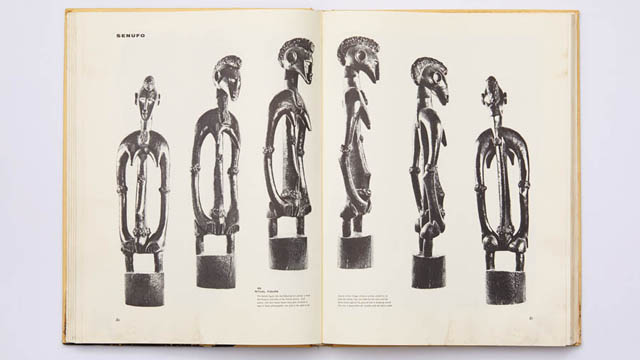
-
 Niklas Wolf
Niklas WolfPhotography as a technique and medium is questioning terminologies of truth and representation as part of the respective and genuinely inscribed authorship of technically enhanced images since the emergence of early photographic works. Through rapid and widespread distribution in print media, photographic images soon became part of the formulation and documentation of shared visual memory in the Global North.
Walker Evans, the father of documentary as one web article states1, heavily influenced the style of modern (not meaning contemporary) photography. His importance as a photographer is essentially based on the photographs he took during the Great Depression in the mid-1930s. The photographic portraits of the three US-american tenant families Fields, Borroughs and Tingle became icons of photographic history and formed the general visual representation of this era by telling a story (in the sense of a historical narrative) at the same time. They, thinking like Evans here, document the person(a), meaning identity or essence, of white, hardworking americans, who, even if they struggle, keep up their integrity. They represent a socio-cultural construct in insisting on their ability of showing, ordering and defining the truth. As Evans' images focus on an American underclass of the time, they show the author of those pictures as part of their own reality.
How does the search for some kind of visual truth in modern photographic images take place when they seem to not look for their own but for the other, which is imagined to be foreign to them and mostly without history? What kind of approach to questions about history and its narratives are they able to re-present as a consequence?
Concepts of history are always entities that reveal just as much about their architects as they do about the evidence integrated into them, which represents constructors and construct at the same time. History rarely appears in a singular form, is never neutral and always normative. It is part of its own discourses, demands order as well as testimony. In documentary terms, the latter (the testimony) should legitimize science and itself. Ordering structures and strategies, on the other hand, require places and institutions where they can appear. Gazes at the end of which historical narratives should stand are seldom equal. Often they are one-sided observations, classifying and hegemonic, alienated observations through mimetic imitation or intended othering. The basis of such categorical observations are specific techniques and strategies for appropriation; results are metaphors or emanations of one's own reality.
The exhibition African Negro Art, which was on view at the Museum of Modern Art New York in 1935, marks the beginning of the institutionalized exhibiting of so-called (or labeled) African Art at major western art museums. Finally coining a terminology often still used today, 603 African objects were exhibited at the MoMA from March 18 to May 19 1935. Walker Evans was commissioned to (literally) photographically document the objects on display.
The resulting images are characterized by long exposure times, which made it possible to guide a light source around the respective object while the cameras aperture was open. The illumination is therefore mostly impressively uniform and soft, strong shadows and the constitution of space are avoided. The images have a hyperfractual clarity.2 The surface of a Bamende facemask for example is uniformly illuminated, the exposure emphasizes the contrasting structures and lines, the formal essence, if one would say so. The actual plasticity of multidimensional objects becomes obvious in a second shot. The face of the same mask appears to be pointedly drawn forward, the slight inclination of a wide comb only becomes apparent here. It almost does not seem to be the same object, so much does the first shot focus on the ornamental surface. Evans used an 8 x 10 medium format camera, the resolution of the images is correspondingly high. The partly dramatic concentration on the object causes a visual monumentalization of things, image sections are often claustrophobic narrow - the objects are not relationally representative, but are re-presented according to their formal characteristics, analyzed by the photographer. This leads to major shifts in reception. One of Evan's most effective images is the photograph of a Pende pendant made of ivory. As if from nowhere, from a timeless, deep black and imponderable background, the masks face emerges from the pictorial ground. The focus lies on the middle plane of its face, which is photographed using a large aperture. Therefore initial blurring starts as early as behind the eyes of the carved face. It is shot from above, not from the front. Viewers are urged to imagine the figure's body (which is neither present nor laid out in the object). Deep shadows let the face appear threatening and alien, framed by sharp contrasts; it becomes clear that the intention of the mask cannot be a good one. Evans gives the alien object an equally alien character, an emotion. The mask stands pars per toto for the ‘other’, the uncanny.
Evans photographs were published quite widely. Starting with the exhibitions catalogue they were used in several publications by the exhibitions curator James Johnson Sweeney focusing on the ‘Art’ of Africa in a broader even more general and art historical perspective: the generalizing and educative intention of pictures and text is already foreshadowed in the somewhat holistic titles of such publications - African Folktales and Sculpture (1952) and African Sculpture (1964) for example . Entering the realm of the photobook as a medium Evans photographic images become part of semi-theatrical stagings, some kind of educational character is inscribed into them, especially looking at the close interlacing of text and pictorial object. Ultimately, the message and content of the images are only self-referential. Evans photographs where often published together with the ones of Elitot Elisofon, who amongst other jobs worked as a photojournalist for the LIFE magazine. In The Sculpture of Africa (1958) Elisofon makes use of the photobook as a medium very consciously. For example he uses different photographic views on the same sculptural object to kind of animate it in a cinematic way, using the photobook as an idea to look at three-dimensional properties of things in a two-dimensional way, making the accessible by flipping through the book. Both photographers work is often labeled as having a documentary style, both seem to have a special interest in photographically analyzing pictorial qualities of the surface and materiality of the things they look at. Exposure and contrasts (re)produce haptic qualities and material properties of the things being looked at through the camera quasi argumentatively, based only in the photographic objects themselves.
Methodically, Walker Evans' documentarism is ergo characterized by the omission of object-immanent information and the simultaneous genesis of image-immanent content. His pictures do not allow conclusions to be drawn about the size, material and context of the representations; a mostly unspecific monochrome background detaches the objects from the contexts inscribed into them. The photographer repeats aspects of the aesthetically and content-wise neutral display of a modern art exhibition and demands that the images focus on purely formal aspects. The representations do not permit any connection between the signifiers in terms of content. In narrow sections, each object is presented in a very specific view - the photographic images ergo become significant only in a Western canonical art context, shifted to its terminology and histories.
Stylistically, Evans' photographs can be described as clean and cerebral.3 The images of African objects are clean (and timeless) in the sense that they are cleansed of any context; they are cerebral in the sense that they are open to new inscriptions and attributions. The highly specific aesthetics of the images serve to conceal and reveal equally specific information at the same time, they are markers of tailored representations4 which are more the presentation of Evans as the author of those images and his techniques to strip pictorial objects from their original terminology and historical narratives, than the representation in the sense of a documentation of the object shown.
1) https://www.theguardian.com/artanddesign/gallery/2015/dec/03/walker-evans-documentary-photography-great-depression-gallery; 15. Juli 2020.
2) Cf. Campany, David: Walker Evans. The magazine work, Göttingen 2014, S. 52.
3) Cf. Strother, Z.S.: Looking for Africa in Carl Einstein’s Negerplastik, in: african arts Winter 2013 VOL. 46, No. 4, S. 8 – 21, S. 8.
4) Cf. Webb, Virginia-Lee: Perfect Documents. Walker Evans and African Art 1935, New York 2000, S. 15.
References
- Eliot Elisofon: The Sculpture of Africa (text: Ralph Linton, William B. Fagg), New York 1978
- James Johnson Sweeney, Paul Radin (eds.): African Folktales and Sculpture, New York 1964
- Kerstin Pinther, Niklas Wolf (eds.): Photobook Africa. Tracing Stories and Imagery, München 2020
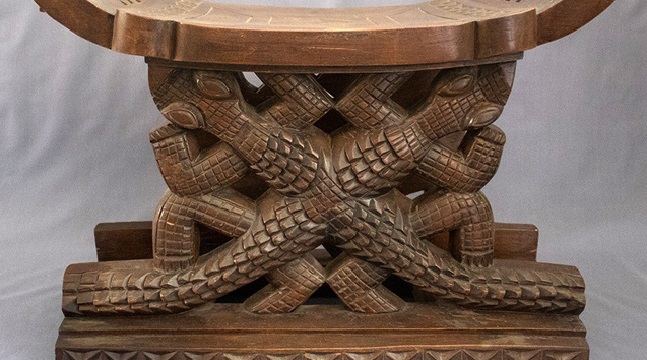
-
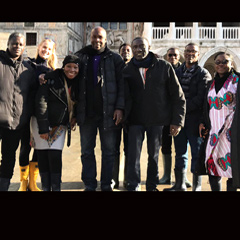 UEW Team
UEW TeamThe Funtumfunefu-Dԑnkyԑmfunefu stool is a carved traditional wooden stool designed with an Akan symbol known as Funtumfunefu-Dԑnkyԑmfunefu (pronounced ‘fuun-tum-fu-ne-fu den-cheem-fu-ne-fu). This type of stool called asԑsԑgua in Fante (a dialect of Akan people from Ghana) is an art-cum-utilitarian object. It is basically composed of three main parts namely the animu (top) which is the seat; the mfinfinin (middle) which bears the design that gives identity to the stool; and the wiabour (base) which is the part that touches the ground and gives stability to the stool (Antubam, 1963; Amenuke, Dogbe, Asare & Ayiku, 1991). In this particular image, the middle portion, which is the focal consideration for this presentation, is created with the Funtumfunefu-Dԑnkyԑmfunefu symbol. The size of the stool is composed of a base that measures 53cm x 28cm, the top arc-shaped seat that gives the stool a length of 55cm and an overall height of 42.5cm.
The stool was presented as a special gift to the Chairman of the Provisional National Defence Council (PNDC), who doubled as the then Head of State, Flight Lieutenant Jerry John Rawlings by the Chiefs and people of Dormaa in the Bono Region of Ghana. It was brought to the Ghana National Museum through the State protocol in 1992. Flight Lieutenant Jerry John Rawlings led Armed Forces Revolutionary Council (A.F.R.C) to power through coup d’état on June 4, 1979 and prepared the grounds for the coming of the third republican constitution. In the same year, Dr. Hilla Limann was inaugurated as the president of the third republic after winning the election. Rawlings returned to power on December 31, 1981 through another military takeover with his Provisional National Defence Council (P.N. D.C) of which he was the chair. Rawlings’ PNDC party stayed in power for almost eleven years before working out for the adoption of the Fourth Republican constitution through a referendum on April 28, 1992 (Essel, 2019). Subsequently, presidential election was held, which he led the National Democratic Congress (NDC) to win. Though the exact date he received the stool as a gift is unknown, it might have been received within 1981 to 1992, judging from the period of his military regimes and constitutional terms of office before the Ghana National Museum received the stool as part of its collections.
The artist who carved this stool is anonymous. Within the context of the Ghanaian traditional creative work productions, this is not strange, since artworks produced in precolonial and traditional Ghanaian societies were hardly signed by the artists who produced them. This was because the artworks were communal, that is, they were produced for use by the community. The chiefs and kings had varied proficient artists in their courts or communities who produced artworks for the community. With the Funtumfunefu-Dԑnkyԑmfunefu stool being a special gift to the then president of the state, it might have been created by a revered and creative carving-artist in the Dormaa community.
The Funtumfunefu-Dԑnkyԑmfunefu symbol falls within tangible artistic creations which takes its name from the Akan expression for Siamese crocodile. Akan is a major Ghanaian language, which is spoken by about 48 percent of Ghana’s total population as first language, and by an additional 35 percent as additional first language or second language (2010 Population and Housing Census). The symbol derives its name from an Akan proverb which suggests that the Siamese crocodiles share a common stomach and yet struggle for food. Semantically, fun means stomach while funtum means ‘put together’ or ‘mixed together’. Funtum also represents the rubber tree that produces a milky sticky substance used to glue items together. Fu-ne-fu (literally, ‘stomach and stomach’) represents two stomachs joined together. Dԑnkyԑm is crocodile. Dԑnkyԑmfunefu, therefore, means ‘two crocodiles with stomachs joined together’. On the other hand, funtum, as verb, also means ‘to stir something up with tension’, generally producing dust. This also draws attention to the struggle or the confusion that comes with the two crocodiles struggling to feed.
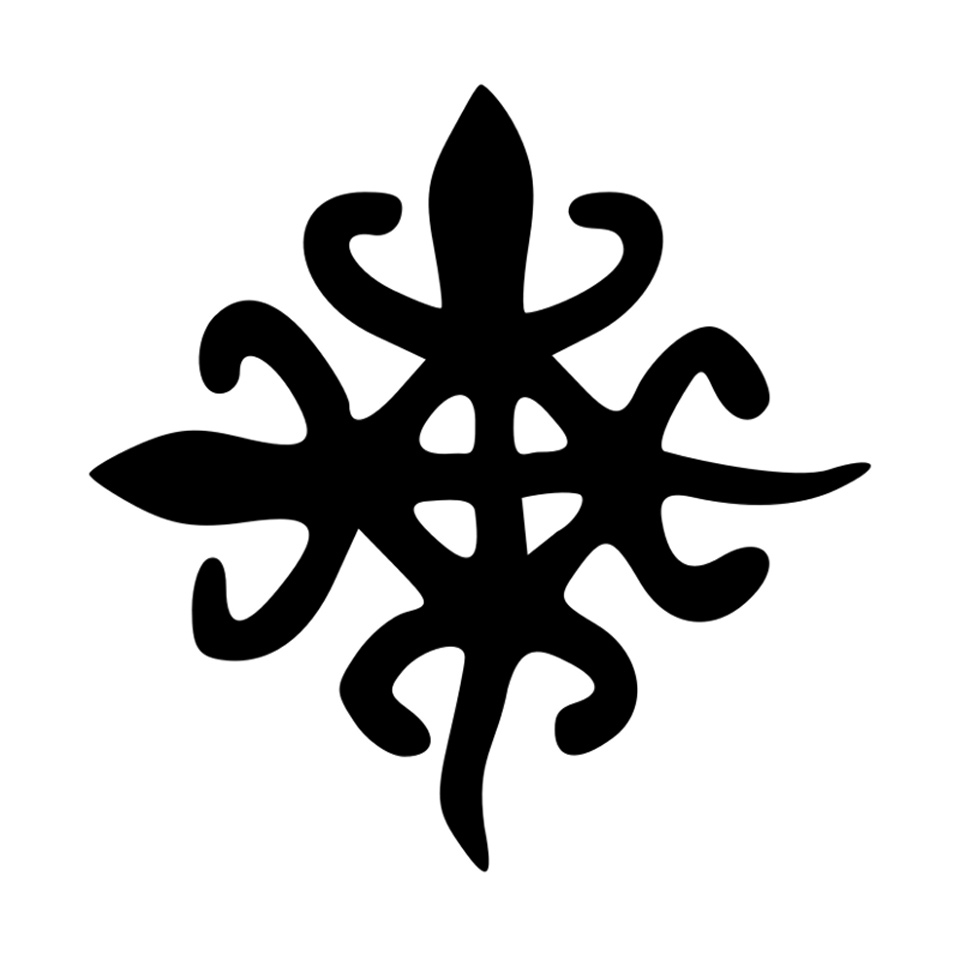
Funtumfunefu-Dԑnkyԑmfunefu symbol (Photo: the author)
The Funtumfunefu-Dԑnkyԑmfunefu symbol (see Figure above), is a graphical representation of two crocodiles rendered in silhouette in a perpendicular orientation with a conjoined and centred stomach, which is a common food receptacle. There are four juxtaposed arc-like lines interspersed and connected by four diagonal lines, creating a rhombic shape at the centre of the symbol. The four arc-shaped lines suggest the limbs, with the prominent sharp-tapered edges attached to the forelimbs placing emphasis on the cephalic regions. At a casual glance, the idealised limbs appear to be same in size, yet a close observation reveals that the forelimbs slightly outsize the hindlimbs. Two tadpole-shaped linearity with sharp-tapered edges placed perpendicularly to fuse with the limbs give a heightened impression of two reptile figures put together.
The Akan expression fun, which is the stomach in the case of the Siamese crocodiles, has two levels of meaning in Akan worldview, the superficial and the hidden. The Siamese crocodiles have a common stomach yet the two heads scramble for food. Each tongue yearns to have a taste of the food, though the gulps of food consumed by each enter a common receptacle. The complexity of this allegorical image could also be found in its multifaceted cultural interpretations.
Criteria for Selection (Educational Relevance & Quality)
The Funtumfunefu-Dԑnkyԑmfunefu symbol belongs to the family of Adinkra symbols. The symbols encapsulate the general Ghanaian philosophical thoughts and ideologies, cultural values, beliefs and practices. Its origin and first usage is traced to the Asante nation state, which is part of present day Ghana (Rattary, 1927). Its usage predates the 19th century as recorded by Bowdich (1819).
The multi-layered meaning of the Funtumfunefu-Dԑnkyԑmfunefu symbol tells its usefulness and educational relevance in the Ghanaian society. Due to its historical, socio-cultural and national importance in Ghana, Adinkra features in the design of decorative and functional artworks. The Funtumfunefu-Dԑnkyԑmfunefu symbol designed into carved wooden stool symbolises unity in diversity, democracy, shared destiny and female-male duality. Giving visual annotation to the idea of unity in diversity, the compositional structure of the Funtumfunefu-Dԑnkyԑmfunefu symbol shows formidable stability, an attribute of unity. There is deliberate inflation of emphasis depicted by the prominent sharp tapered edges attached to the forelimbs, which connotes power, energy and aggressiveness in the process of scrambling for ‘food’ by the Siamese crocodile. Viewers who do not understand the true symbolism of the image sometimes greet the aggressive depiction and the centred common stomach with negative interpretation. However, in the same stable composition, the graceful movement that bedews the tadpole-shaped figures placed at right-angled position creates an impression of diversity.
Methods/Interpretation/Research Questions
The asԑsԑgua (stool) in Ghana symbolises the soul of the society and serves as inoffensive symbolic link between the people or the subjects and their head of state or king (Antubam, 1963). It implies that the stool has both political and nationalistic useful to the citizenry and their ruler. In this instance, the stool reminds its users and observers of the need to engage in activities that will lead to unity rather than divisive tendencies. It teaches the Ghanaian society of shared destiny and the need to strive for oneness irrespective of one’s political affiliation, social standing, physique or race. The integration of the Funtufunefu Denkyemfunefu symbol into the political significations of stool symbolism therefore combines the essence of communal leaving and nationalistic feeling with power and governance. Just as the Funtufunefu Denkyemfunefu stool symbolises unity in diversity, and nationalism, the coat of arms of Germany also symbolises national unity. In this sense, both are thematised on unity and national consciousness. Both designs are abstracted animal figures and play allegorical role in the semiotic interpretations of the symbols.

The coat of arms of Germany
https://de.wikipedia.org/wiki/Bundeswappen_Deutschlands [28.010.24]
In terms of artistic presentation, both were rendered in silhouette. The Funtufunefu Denkyemfunefu stool gives expressive meaning to unity by underscoring that individual difference, diverse shades of opinions and social standing that usually operate in the search for unity but must end in oneness of purpose for the national good. The broad vertical lines that conjoin the flanked arc-shaped lines to give impression of the wings of the eagle figure suggest strength, power and authority of the Germany coat of arms (Figure 3).
The common symbolic ideology in both the Germany coat of arms and the Funtufunefu Denkyemfunefu stool is to strive for oneness. Exploring the design concepts, socio-cultural and identity connections between these two images create opportunities for new levels of greater bilateral understanding and integration.
Obviously, interrogating images of this nature and identifying their essence within their traditional setting vis-à-vis other cultures is likely to help to eliminate prejudices about visual cultures among nations and reduce the barriers in visual communication.
References
- Amenuke, S. K., Dogbe, B. K., Asare, F. D. K., Ayiku, R. K., & Baffoe, A. (1991). General
- knowledge in art for senior secondary schools. London: Evans Brothers Ltd.
- Antubam, K. (1963). Ghana’s heritage of culture. Leipzag: Koehler & Amelang.
- Bowdich, T. E. (1819). Mission from Cape Coast Castle to Ashantee. London: Cass.doi: 10.1017/CBO9781107444621.
- Essel, O. Q. (2019). Dress fashion politics in Ghanaian presidential inauguration ceremonies from 1960 to 2017. Fashion and Textiles Review, 1(3), 35-55.
- Rattary, R. S. (1927). Religion and art in Ashanti. . London: Oxford University Press.
published March 2020
 Bea Lundt
Bea LundtI am fascinated by the Ashanti-stool, being a symbol of soul of society, “to house the spirit of the Asante nation - living, dead and yet to be born” (Wikipedia), as it is described in this article. Travelling in Ghana very often, I had been told the background-story of this object again and again, so I know its importance to the people. Additionally, you can find several publications describing its meaning.
The beginnings are rooted in the 17th century when the Asante-confederacy was founded. As the legend tells, the Golden Stool fell from the sky as a religious legitimation of the King Osei Tutu, representing wealth and power of the region. During colonial times the Asante defended the stool against the British. They had been very successful to repulse the European invaders until they were finally beaten. So, for me the Golden Stool is also a symbol of anticolonial defence. People identified with this object as the representative symbol of their culture and protested any robbery of it. The stool as the main symbol of authority of the confederation gives the feeling of security and duration. Every 5th year it is presented to the public during the Akwasidae-Festival in Kumasi. As I read, there is also a Golden Stool of other ethnic groups, Denkyira and Ga. It is very interesting that this object can be constructed in different shapes and can also be decorated in quite different ways with additional meanings.

Golden Stool of Asante on its throne, the hwedom dwa, with its immediate caretaker (1935), United Kingdom Government, © public domain
One of the most exciting buildings I have ever seen, is the Golden Jubilee House (Flagstaff House) in Accra, which is the Presidential Palace and office of the President of Ghana (completed in 2009). Its architecture is following the model of the Golden Stool of the Ashanti people.

Golden Jubilee House - Flagstaff House (open access, https://commons.wikimedia.org/wiki/File:Golden_Jubilee_House.jpg)
The example of decoration which is chosen in this article is the Adinkra-symbol for „unity in diversity“. It always remembers me of the European story of Menenius Agrippa and the plebs, a narration which is bequeathed since Greek antiquity. It uses the body as metaphor for the society. The stomach is the symbol for the ruling elite. All the other parts of the body are in a revolt against the stomach, whom they define to be lazy. As the story moves on, they learn that they have to accept the different organs with its different functions because all of them need each other and work together. Also the two crocodiles have to accept that they live with a common belly whilst they both gain different food, which might be the symbol of diversity of the individualistic interests and spiritual goods from outside. They are equal beings which is an important difference to the European story which is used to play down rightful claims of disadvantaged groups.
The comparison of this symbol with the German coat of arms, the eagle: Germany has a quite different history and structure as e.g. Great Britain, France or Spain, countries who have a long tradition being structured centralized. The federal organized structure in Germany makes „diversity“ of the different regions much stronger in our consciousness than the longing for oneness. The state “Germany” just exists since the end of the 19th century; it comprises a hybrid population with many migrants from all over the world. It has to be blamed for two world wars and was divided in 1945; so the centres changed.
The eagle is a very old symbol found in the old Orient, e.g. in Egypt. Today it is also used by other countries like Austria or the USA. So it is not a specific part of the German culture or political tradition. Also, the traditional setting of this figure is joined to problematic contexts and even has a negative meaning as it often represented imperial endeavours, dictatorship, holocaust, state control and militarism. Very often the eagle is designed in a satirical critical way. A collection of this caricatures can be found in the “Haus der Geschichte der Bundesrepublik Deutschland” (House of History of the Federal Republic of Germany) in Bonn. It might be pedagogically interesting to follow these different performances and messages of the original pattern of this bird.
Reference
- Catherine Meredith Hale: Ananse Stools and the Matrilineage. Doctoral Dissertation Harvard University 2013; openly available via https://www.google.com/url?q=https://dash.harvard.edu/bitstream/handle/1/11004913/Hale_gsas.harvard_0084L_11004.pdf?sequence%3D3%26isAllowed%3Dy&source=gmail&ust=1594720839716000&usg=AFQjCNHu7lCXklUnOk2v6aQFdM2GjPKefw"> https://dash.harvard.edu/bitstream/handle/1/11004913/Hale_gsas.harvard_0084L_11004.pdf?sequence=3&isAllowed=y
Published July 2020
 Ernst Wagner
Ernst WagnerThe EVC team from Ghana has chosen this traditional stool that plays a ritual role in the Akan culture. This stool uses a specific symbolic language. The two ravenous and competing crocodiles have a common stomach, i.e. their bodies are fused together. Thus this symbol "represents the idea of unity in diversity, democracy, shared destiny and female-male duality.” But then the text above goes further. It compares the symbol from the Akan culture with the German national coat of arms, which also shows a stylised animal, an eagle. There are many similarities between both symbols, the animal, the shape, the symmetry. Therefore – so the assumption in Ghana – the German coat of arms also has the same meaning as the Akan symbol: national unity. The assumption from Ghana, the equation, triggered an intense discussion in the German team of teachers in 2019. A German historian would say this interpretation is wrong. But, on the other hand, the eagle is definitely used in this sense, e.g. by politically right-wing groups in Germany.
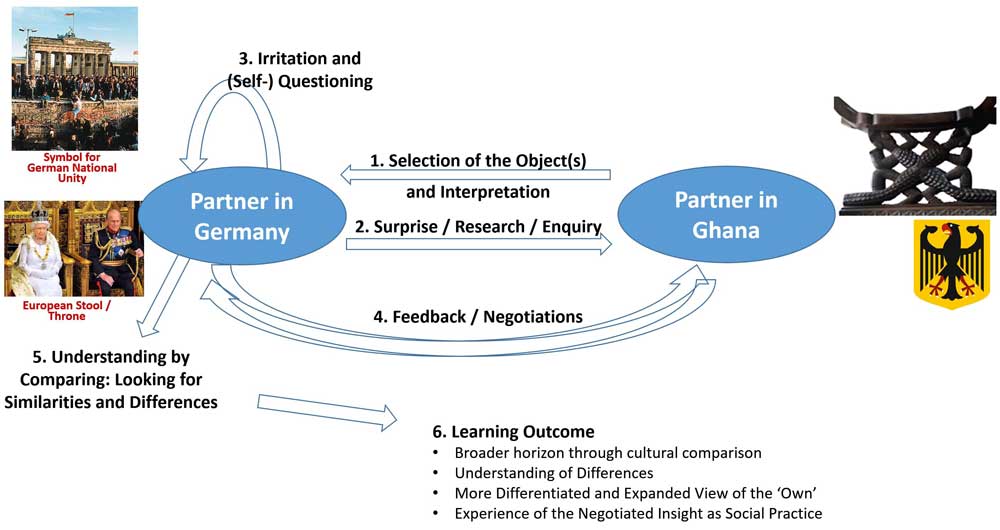
This figure presents a simplified visualisation of an extremely complex dispute that took place over several months - from a German perspective.
- The partners in Ghana selected the stool, interpreted it and made a connection to the German coat of arms.
- The addressees in Germany were very surprised by this, which led to intensive research into the symbols of the Akan culture. Through this, an acquaintance with the unfamiliar form of artistic expression took place.
- But, there was also an examination of the equation of meaning in the German coat of arms. The German team took up various aspects: the idea of the stool as a seat of power with symbolic adornment (as here with the English throne). But, the question of what image could be associated with the theme of "national unity" in Germany led to something quite different: the photo of cheering people on the Berlin Wall in 1989, when the division between the communist-totalitarian part of Germany and the capitalist-democratic part collapsed. This photo is much more anchored in the collective cultural memory than the coat of arms in respect to unity.
- In this way, the interpretations were discussed and negotiated together.
- Similarities and differences between the various cultural symbolisations could be identified,
- In a final reflection, the German team formulated their own learning experiences in this process.
Of course, everything was much more complicated and complex, but for the moment, perhaps the following conclusions can be drawn:
- The team in Ghana presents artefacts that are considered as important for the own context, the team in Germany tries to understand it, but starts a critical discussion when it comes to a German object, the coat of arms.
- The interpretations are negotiated with each other on eye level.
- The objects from Ghana and Germany (the stool and the coat of arms), although obviously completely different at first, are related to each other, come into contact with each other. Complex-entangled interactions of the objects themselves occur.
- What is initially seen as separate from each other becomes entangled in this way. The boundary between ‘one's own’ and ‘the other’ becomes fluid.
- This creates a hybrid intellectual space in which ambiguity becomes a paradigm.
Published August 2022
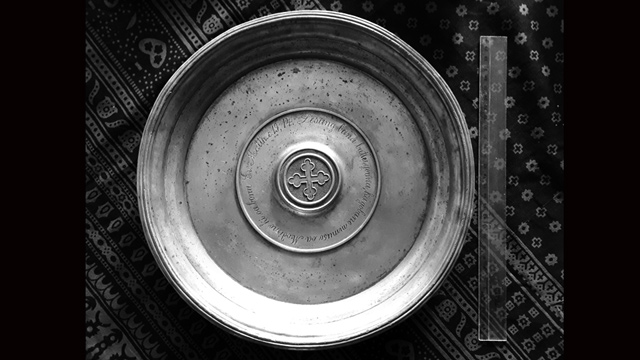
-
 Lize Kriel
Lize KrielA German bowl inscribed in Africa
In the process of finding out more about this baptismal bowl – where it comes from, who used it, and when it was discarded, it becomes a portal into South Africa’s contested past. Methodologically, a cultural-historical approach is taken to investigate the object as multiple signifier, not only as part of a transcontinental network, but also within a local, transcultural, context – what John and Jean Comaroff (1991, p. 200) referred to as the “long conversation” between European missionaries and African Christians.
The bowl was meant to be used with an accompanying, although, in this case, not quite matching, pitcher for the baptism ceremony, in which Christians use water to symbolise the blood of Christ washing away their sins. The Wallmansthal station where the bowl was found, was established by the Berlin Mission Society in 1869. The farm was about thirty kilometres north of Pretoria, today a capital city of South Africa. It became home to African converts gathered from the Kekana-Ndebele and several other pre-colonial northern Sotho polities (Van Rooyen, 1953, pp. 15-20). By the mid-twentieth century, the congregation was approximately 550 people strong (Schulze 2006, p. 456). Together with several other German protestant mission societies, the Berlin Mission contributed to the making of a Christian denomination referred to as “Lutheran” in South Africa today. After a century under white missionary tutelage, the African Church became independent as the Evangelical Lutheran Church of South Africa in the 1970s (Pakendorf, 2011, p. 115).
Knowing that a protestant congregation in Bochum, Germany, donated a church bell to the Wallmansthal Church in 1870 (Van Rooyen, 1954, p. 26), we can deduce that the baptismal bowl may also date from this era. The pitcher bears the mark of Gerhardi & Co. Judged from its Art Nouveau design elements and knowing that this Ludenscheid-based (Gerhardi) company was quite prolific in the production of cast pewter in the Jugendstil (Online Encyclopedia), a post 1890 manufacturing date seems equally probable.
Called Taufgeschirr (Baptismal dishes), bowl-and-pitcher sets of this kind are still being manufactured and used in churches in Germany today. Some congregations include images of old as well as new baptismal bowls on their websites as part of the material markers of their heritage. The exact same design displayed by the Evangelical Church of Illertissen in Germany on their website, is still in use today in the Evangelical Lutheran Church of Masealama (formerly the Kratzeinstein Congregation of the Berlin Mission Church) in South Africa’s Limpopo Province (Joubert, 2015).
Many baptismal bowls were inscribed with verses from the Bible. The quote on the Wallmansthal bowl is a contracted version of Matthew 19:14. What makes this bowl an exceptional object of transculturation, is the fact that its inscription appears in the early orthography of the local African language, Sepedi: “Lesang bana batle gonna, ka gobane mmuso oa Modimo ki oa bona” (NIV: “Let the little children come to me, … for the kingdom of heaven belongs to such as these”).
The bowl was used in church services on mission stations in the same way it would be used in protestant churches in Germany: the pastor would sprinkle the children of African Christians on the forehead with water which had been poured into the bowl from the pitcher. The initial African converts, however, were baptised as adults, only after proving that they had internalised enough knowledge of the Bible and convinced the white missionaries of their commitment to the beliefs and practices of Christianity (which, well into the twentieth century, remained entwined with Western ideas about civilisation).
To these converts, the baptismal bowl was symbolic of their ritual immersion into a foreign way of thinking, living and believing. And yet it was inscribed in their own language, invoking possibilities for cultural translation; for selective appropriation as well as for imbuing the alien culture with own interpretations, relating it to the indigenous and the familiar, and composing new meanings in anticipation of changing circumstances. The baptismal bowl is thus taken as reflective of broader processes of societal, economic and political reconfiguration brought about by the colonial encounter, but with an emphasis on African resilience.
On the site where the Wallmansthal baptismal bowl was used, these processes played themselves out in a series of extraordinary episodes that indirectly also related to broader world-political epochs: Up until the First World War, the Wallmannsthal land sustained an African Christian farming community. In 1936, as an attempt to address their post-war financial crisis, the Berlin Mission sold off a large section of the farm, giving the (exclusively black) African buyers full title deeds for their plots. Until after the Second World War, Wallmannsthal was a bustling African town giving its inhabitants the economic advantage of being close to job opportunities in Pretoria (Van der Merwe, 1987, pp. 69, 135).
In 1967 the Apartheid government forcibly removed all the inhabitants, including the Berlin Mission Christians who had still lived on the retainer of the farm where the Church and other mission station buildings were (Schulze, 2005, p. 458). Wallmannsthal then became a military base and arms depot for the South African Defence Force. During the late 1980s, with the Cold War still dictating international relations and South African whites slowly awakening to the need for political reform, the Defence Force contemplated the restoration of the site. These plans never materialised.
In the early twenty-first century, in a successful land claim, the Wallmannsthal farm was returned to the descendants of its early twentieth century owners. The restitution did not herald a final episode of utopian prosperity. Increasing demands on limited resources seem to be one of the reasons for the reinstated landowners’ current challenges, ranging from obtaining municipal infrastructure, to addressing the status of illegal squatters on their land, and designing the best possible ways of yielding a sustainable livelihood for an increasing population (eNCAnews, 2018).
Today the Evangelical Lutheran Church of South Africa is but only one of several Christian denominations in South Africa with missionary roots. Many more South Africans belong to African independent or African initiated churches – and, increasingly, international churches with their roots elsewhere in the Global South. The process of inscribing Christianity with own meaning and local significance, continues.
References:
- 925-1000.com (2018). Online encyclopedia of silver marks, hallmarks and maker’s marks. Retrieved from https://www.925-1000.com/silverplate_G.html.
- Comaroff, J & Comaroff, J. (1991). Of revelation and revolution. Christianity, colonialism and consciousness in South Africa I. Chicago: Chicago University Press.
- eNCAnews (2018, 27 October). Pretoria land claims. Retrieved from https://www.facebook.com/eNCAnews/videos/pretoria-land-claims/302862580316147/
- Evangelische Kirchengemeinde Illertissen (2019). Die Taufe. Retrieved from https://evang-kirche-illertissen.de/informationen/taufe/
- Gerhardi (2019). Gerhardi – Ein innovatives Traditionsunternehmen. Retrieved from http://www.gerhardi.com/index.php?id=9&L=0
- Joubert, A. (2015). A journey into the life of a mission-ethnographer. doi: 10.6084/m9.figshare.1375528
- Pakendorf, G. (2011). A brief history of the Berlin Mission Society in South Africa, History Compass, 9/2, 106-118.
- Schulze, A. (2005). “In Gottes Namen Hütten Bauen“. Kirchlicher Landbesitz in Südafrika: Die Berliner Mission und die Evangelisch-Lutherische Kirche Südafrikas zwischen 1834 und 2005. Stuttgart: Franz Steiner.
- Van der Merwe, W. (1987). Die Berlynse Sendinggenootskap en Kerkstigting in Transvaal, 1904-1062. Pretoria: Government Printers.
- Van Rooyen, T.S. (1953). Kronieke van Wallmansthal I, Pretoriana: Journal of the Old Pretoria Society 4, 15-20.
- Van Rooyen, T.S. (1954). Kronieke van Wallmansthal III, Pretoriana: Journal of the Old Pretoria Society 2, 24-28.
published February 2020
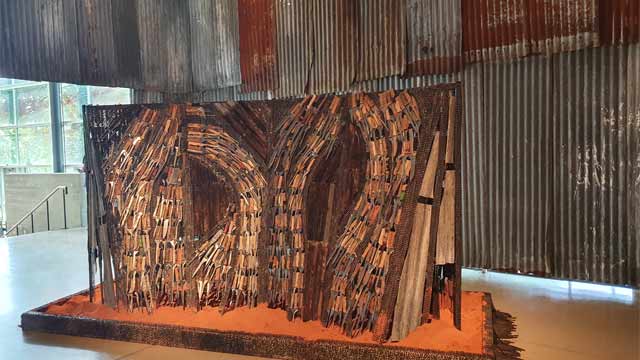
-
 Ngugi Waweru
Ngugi WaweruPreparation in Nairobi
The Wakujuu collective (link) was invited to Documenta in 2022. The process that started from there has been long, not only to make the art work to be presented in Kassel, but also to become part of Lumbung, the concept the curators proposed. We went through a long process coming up with ideas, collecting materials, shaping it, discussing among ourselves as artists and also with the artistic team from the Lumbung Network. In addition, we decided, before we take our exhibition to Germany, we do it here in Nairobi to share it with our community, fellow artists and other people. Thus, we started local workshops with different people, artists, photographers, musicians and community members. These workshops led to a huge festival in the community in 2021 which was part of our offsite project for documenta, together with the exhibition we did in Nairobi. The idea was to share with our community what we bring to Kassel.
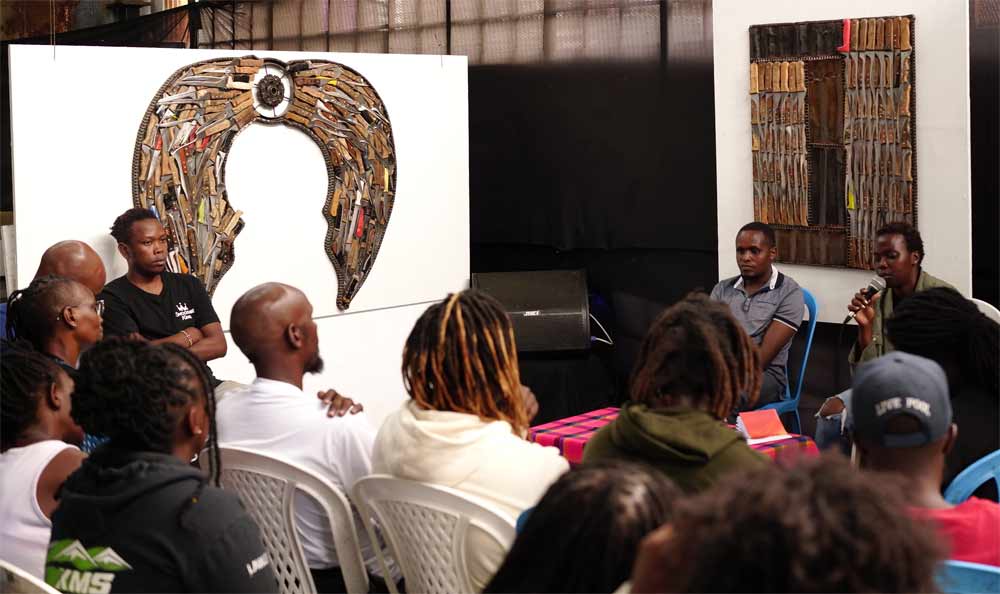
Workshop in Nairobi (Courtesy the artist)
It’s important to mention that in our collective, all individual artists have their own ideas. So, we started to look at the objective for the whole collective. We discussed and then we decided that every individual artist does his own artwork, but we discussed as a collective, supporting each other, giving ideas, criticizing.
Preparation in Kassel
When we came to Kassel, we brought some material with us and we found other material there. At the Documenta we were supported by a team. It was challenging, but still most enjoyable and it created a lot of learning.
For instance, we were excited to work together with Instar from Cuba, Britto-Arts Trust from Bangladesh and Wakali Wood from Uganda, as we were sharing the same spaces. The idea of Lumbung is sharing. And it doesn't matter what you're sharing: stories, food, materials or tools. We got to sit together and discuss also with Jatiwangi Art Factory. We lived like a family. And this is the most memorable thing that I will take with me forever, not only with the Lumbung members, but with the Kassel community. It's a thing you wish to repeat over and over.
When we were invited to come to Germany the first time in 2021, there were incidents of racism. And I started feeling I don't want to go to Europe. But this time it was different, apart from the antisemitism accusations that seemed to halt the whole event. Even with the German people with whom we worked at Documenta halle we just connected immediately; we just became family.
Our art works at documenta
The different artworks we made for Kassel had different themes, but all tackling what is happening in the world, not only in Mukuru slum (where we are based in Nairobi[1]). The world is one big village and we all have the same challenges that are affecting us as humans, like climate change, war, economic hardship, failed systems, pandemics and so on. When you look at the world, it's fragile, it's dangerous, and it’s not livable. Everything is tough. But there are also good stories.
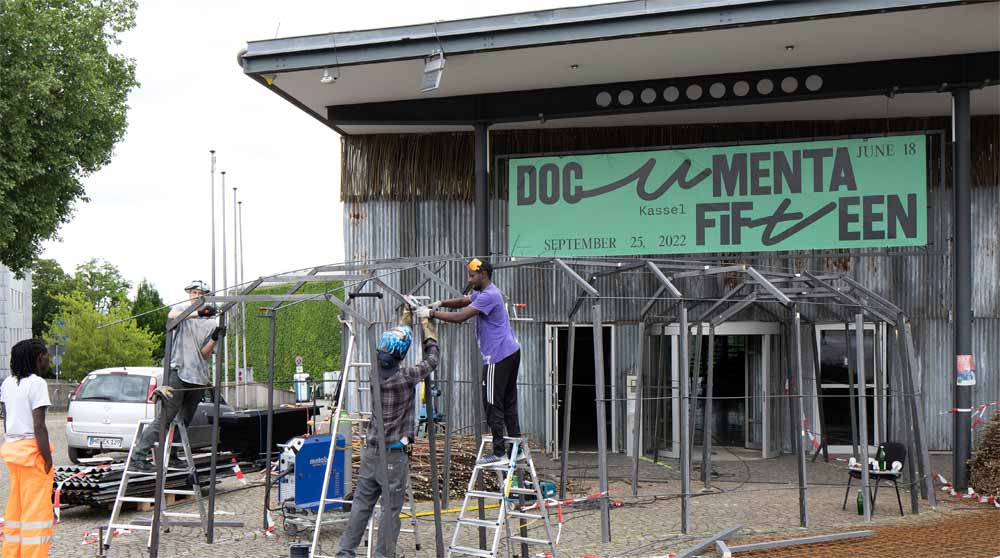
Construction of the tunnel in Kassel (Courtesy the artist)
The tunnel
For the entrance to Documenta Halle, where we exhibited our works, we used the corrugated iron sheets that the houses are made from in Mukuru. Our installation started with a tunnel, built by Kimathi Kaaria and Lazarus Tumbuti from our collective. You enter the tunnel and hear a sound. You go inside and you don't see anything. There is just darkness, and you hear this sound, recorded randomly in the streets in Mukuru.
The title of the installation is “Wakija Kwetu… ”. It is a Swahili name that means: “When they come to our home they get to know us better.” The sound is bringing you to Mukuru. The idea is to move you from Kassel to Mukuru and give the impression how it feels like to be in the streets there. And when you go inside, you see the corrugated iron sheets, you see the walls of our houses. You have this feeling of being in Mukuru.
Inside you are welcomed by three installations, ‘misingi wa nyumani’ by Joseph ‘Weche’ Waweru, ‘wrapped reality’ by Shabu Mwangi and ‘kahio kugi gatemaga o mwene’ done by Ngugi Waweru.
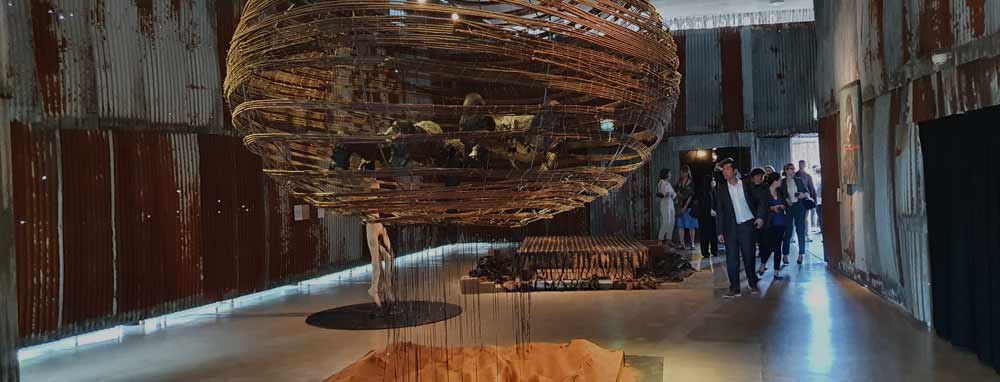
Inside the tunnel (Courtesy the artist)
Ngugi Waweru. Kahio kugi gatemaga o mwene. Used knives, motorbike chains, corrugated iron sheets. 2022
The situation of the world is the theme of my work “kahio kugi gatemaga o mwene”, in which I used old knives. I heard from many people, that the world is beautiful and brutal at the same time, it's scary. And I said to them: “Exactly, it's scary now to be in the world.” There was COVID, there is war, there is hunger - it's scary. It's like you are surrounded with death or illness.
 Ngugi Waweru. kahio kugi gatemaga o mwene. Used knives, motorbike chains, corrugated iron sheets. 2022 (Courtesy the artist. Photo Avi Sooful)
Ngugi Waweru. kahio kugi gatemaga o mwene. Used knives, motorbike chains, corrugated iron sheets. 2022 (Courtesy the artist. Photo Avi Sooful)My artistic process always starts in the brain and how I feel when observing the surrounding. For my Documenta work, I was studying those people who come to the community in Nairobi to sharpen knives for the butchers. I realized that they sharpen the knives over and over again until they are worn out. That led me to knives and I started collecting them long time ago. I didn't know what I will do with them. But, when we started talking in our collective about the exhibition, I came across a proverb: Kahio kuhiga muno gatemaga o mwene. It is a Kikuyu proverb that means “When a knife is too sharp, it cuts the owner.” I remembered that I had these sharp knives. This is how I came up with this idea of my art work for documenta fifteen.
In the older days before we were colonized proverbs were used to educate or warn people. In this case I used the proverb to warn people. This Kikuyu proverb warns against the possibility of being harmed by one’s own decisions. The human quest for advancement in various spheres (technology, education, religion, economies, or colonizing other planets, etc.) is also marked by a growing distance between people and the qualities that makes us human beings – our capacity for love, kindness, care, understanding, sharing, community. Just as a knife is eroded as it is sharpened repeatedly, so are we made less and less human by the actions we take to adapt and survive within our present society.
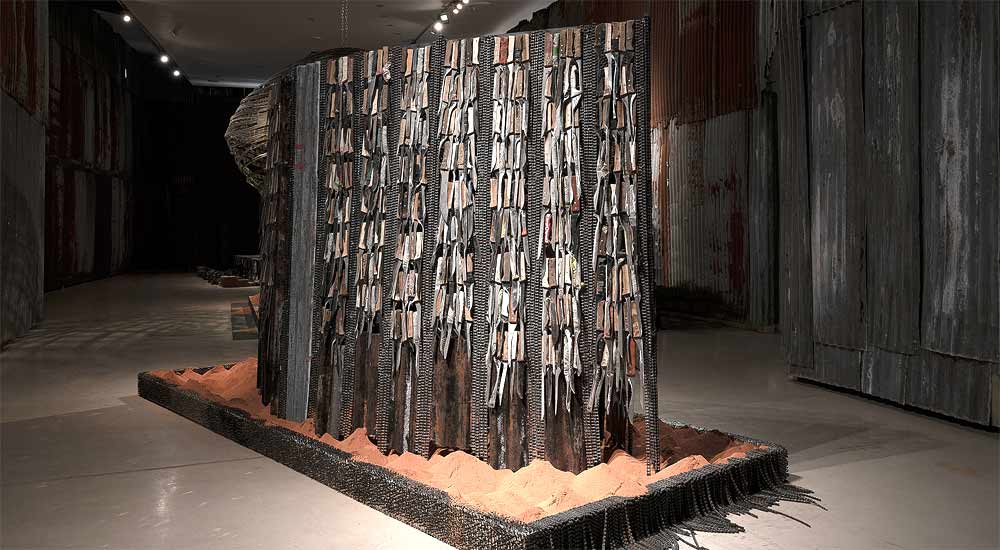
Ngugi Waweru. kahio kugi gatemaga o mwene. Used knives, motorbike chains, corrugated iron sheets. 2022 (Courtesy the artist. Photo G. Tenter)
Background
But we have also good stories, the Wajukuu story, our story, e.g.. This story is creating hope where there is no hope. Building community and togetherness. Sharing is what we are doing to solve our issues, as artists, as a community. The world can learn from us. It doesn't matter where you come from, it doesn't matter what you have or what you don't have: We all have challenges. We have to come together and find solutions.
Before the white man came to Africa, art was part of our life. When a child was born there was a ritual, a dance and a song to welcome the child into the family/community. In other traditions there was painting of the house. When the white man came, all of this was demonized. They forced us to start living their life. Even in school, we learn about Picasso or Leonardo da Vinci, but there were African artists whom we never heard from. They were masters, and the elders taught the young. Since we went through the white man’s education, art is defined according to the name. Now it's art, before it was our lifestyle.
When the colonizers came, they took away three most important things, our land, our freedom and our religion. When they left they gave back our land and some part of our freedom but they never gave back our altars. What the white man also left is capitalism. But, with capitalism there is no way to connect with our Gods and our planet. Capitalism creates appetite for profits. With this appetite we destroy our home, our earth in the quest for riches. The capitalism system all over the world is suppressing our spirituality, our creativity, and our being human. It's making people to be workers, not free people or free thinkers. It took millions of colonizers’ soldiers, hundreds of years to disconnect us from our true being and our true Gods. What we are doing as Wajukuu Artists is like a tear drop in the ocean, but we are able to ignite a spark that will connect us to our roots. Our role in the community is to ignite a spark of change and alternative way of thinking.
When we started to make art in Mukuru, the kids came where we were worked. At first we chased them away. But they would come again and again, because kids are attracted to the good things and art attracted them. After a few unsuccessful attempts to chase them away we decided to take them in. We realized if we don’t take and train them they will grow with the same vices we grew up with. For us, it's not about teaching them to be artists, but to create a platform for the kids to express themselves and give them an alternative education. We intend to find land to start practicing agriculture, teaching kids how to take care of the soil, to take care of the plants, the trees, and the environment, and also to reconnect with our spirituality, with our roots. This means, we teach kids our traditions. We also incorporate traditional dancers and traditional instruments in order for us to go back to our ways, not necessarily exactly, but to have a connection with our past.
published February 2025
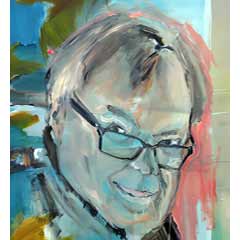 Johannes Kirschenmann
Johannes KirschenmannDocumenta
For over half a century, documenta in Kassel was considered the most important exhibition of contemporary art in Europe and beyond. It marked the respective current state of the art discourse in and for the Global North. The documenta in 2002, curated by the Nigerian-American Okwui Enwezor, corrected the existing narrow focus on art mainly from America and Europe for the first time.
Twenty years later, in 2022, documenta was curated (again for the first time) from the Global South and additionally by a collective: ruangrupa from Jakarta. ruangrupa organized this documenta under the theme “lumbung”, the Indonesian name for a shared rice barn. Applying the lumbung ideal to the art world means that artists and collectives should work together sharing knowledge, resources and ideas. Instead of the purely market-oriented art business, the exhibition should focus on social, ecological and economic sustainability. Thus, the curators did not only ask the artists to present artworks, but offered support for their collective work in the public space. This is one of the reasons why, in addition to the existing museum spaces, numerous other places such as old factories or churches in Kassel were included as shared spaces.
An outstanding example of the implementation of the Lumbung concept was the Wajukuu Art Project working in the slums of Nairobi. (Wajukuu is Kiswahili for grandchildren, or other relations of the second generation.) Wajukuu's installations at Documenta drew on used materials, furniture and everyday objects from the slums. In this way, they offered an aesthetic as well as socio-political examination of questions of identity:

Entrance to the Documenta Halle through Wajukuu's tunnel (Courtesy the artist)
Anyone who wanted to visit the documenta-Halle in Kassel, a modern hall with a glass façade built in 1992, first had to pass through an installation by Wajukuu: a tunnel-like, dark corridor made of corrugated iron, rusty Mabati, a building material commonly used in the Mukuru slum. “In reference to the vernacular architecture of Maasai housing, the meandering tunnel that contained the installations was covered by thin dark-brown reeds.” (https://www.textezurkunst.de/de/articles/eric-otieno-sumba-documenta-sell-the-vision/) The contrast between this noisy, dark scrapyard atmosphere and the light-flooded modernity and transparent rationality of the documenta hall could hardly be starker. In the tunnel, you could hear dogs barking, engines rattling and sirens wailing.
During the creation process two other worlds collided: “In a ‘Post Documenta Artist Talk’ (Link) on October 13, 2022, two members of the collective reported that it took some negotiation to obtain clearance to build the tunnel without professional architectural guidance. The artists convinced the two firms that had been commissioned for construction to allow the structure to be built outside of construction norms and standards.” https://www.textezurkunst.de/de/articles/eric-otieno-sumba-documenta-sell-the-vision/#id4

Inside the tunnel (Courtesy the artist)
At the far end of this tunnel, visitors (with their predominantly Western-influenced view) stood in front of enigmatic sculptures. These were again made from used materials from the slum. Together with videos on screens, they encouraged visitors to reflect on life in the slum and prompted speculation about their possible use and meaning. Soft materials, for example, formed a resting place in the size of a typical one-room dwelling (Joseph Waweru Wangui). Next to it was another installation by Shabu Mwangi: a mirror set in a bed of sand, with a cloud floating above it, a wickerwork of bent woods, with two human figures. Behind them emerged two half-arches, formed from used sharp knives: the work of Ngugi Waweru “Kahiu kogi gatemaga mwene” (“If a knife is too sharp, it will hurt the owner”).
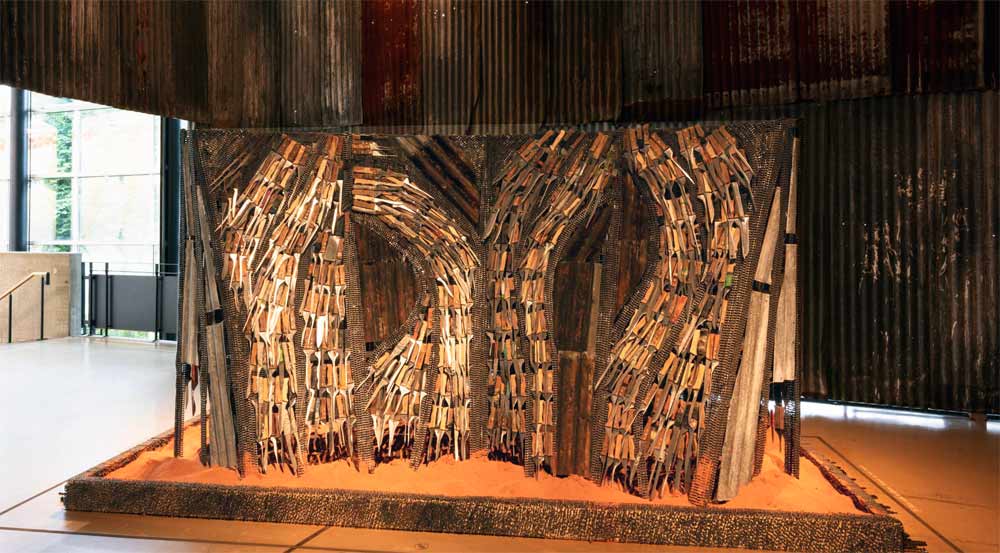
Ngugi Waweru. kahio kugi gatemaga o mwene. Used knives, motorbike chains, corrugated iron sheets. 2022 (Courtesy the artist. Photo Avi Sooful)
This work of art, which is not quite two meters high, stands in a basin filled with reddish, sandy earth - the edge of the basin is covered with motorcycle chains. On this "pedestal" is a construction made again of corrugated iron, which is covered with more motorcycle chains and, above all, sharp meat knives. In two large fields at the front, which are at a slight angle to each other, 'streams' of knives each frame a large opening in which the rusty corrugated metal construction is visible. For the viewer, it is above all the knives that make an impression. (They can also be found - less ornamentally arranged - on the back of the sculpture). This effect is certainly due to the fact that - as with El Anatsui e.g. - their ornamentation and the glitter of the flashing blades unfold their splendor from a reduced colorfulness. A splendor, however, which - with the narrow, long blades - is quickly associated with violence and destruction, torture and death, threat and power.
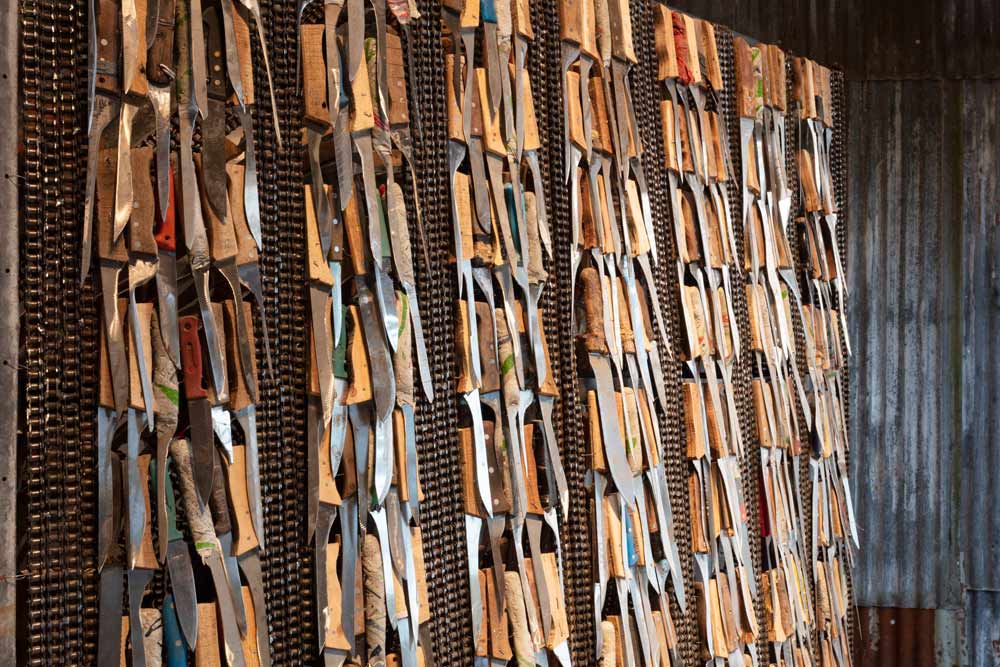
Ngugi Waweru. kahio kugi gatemaga o mwene. Backside (Courtesy the artist. Photo Ernst Wagner)
In respect to these associations, images from European cultural memory come to mind, from Caravaggio's Beheading of Holofernes by Judith to Arman's "accumulations" with knives or Marina Abramović's performances. Immediate impact and these associations play together to steer a perception between beauty and threat - in the given context obviously a symbolic expression of the slum experience. This specific form of aestheticization has also been questioned by art critics: is the work about the authenticity of the real experience or does it not rather serve a certain cliché of African slums? (https://www.textezurkunst.de/de/articles/eric-otieno-sumba-documenta-sell-the-vision/)
However one decides, the impression of the work that it leaves behind remains, for which its artistic quality (according to the standards of the Global North) is decisive: it is visually striking, formally consistent and coherent, it draws on familiar aesthetics while at the same time is innovating, and it remains open for interpretation, the viewer is invited to. This artistic quality was certainly also decisive in Wajukuu being awarded the Arnold Bode Prize in 2022, a prize that is awarded every two years by the city of Kassel to outstanding contemporary artists. The concept of creation, the relationship between the work and its anchoring in the social process in the slum was certainly a decisive factor as well. Thua, the jury of the Bode Prize has also honored an important social project and acknowledged the work to improve living conditions in the slum.
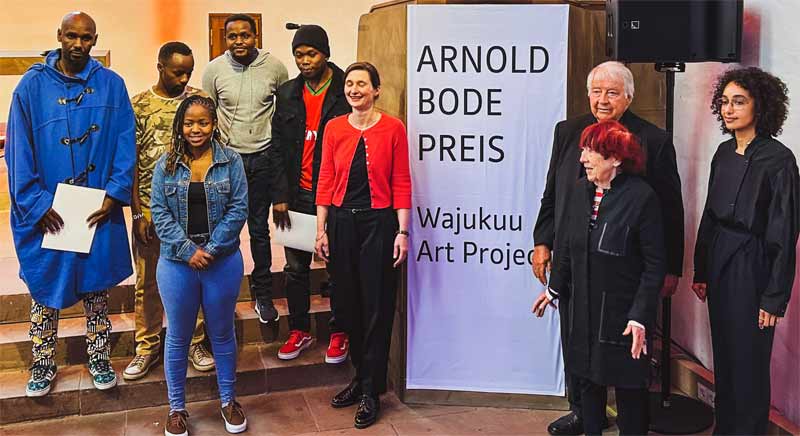
Award ceremony in Kassel 2022 (Courtesy the artist)
With the awarding of the prize, all the voices that did not see "l'art pour l'art" thinking in the Wajukuu Project, but rather the will to change something in the reality of life with the help of art, were heard once again. "The Art Project uses art to create a future that shapes and improves the path for the next generation. Art forms the core of Wajukuu, not just as a practice, but as a way of life with tangible implications in the lives of its community." (Ann Mbuti: From beginnings. Laudation for the award of the Arnold Bode Prize 2022; source of the text: Cultural Office of the City of Kassel)
Finally, the city of Kassel purchased this particular work by Ngugi Waweru, "Kahiu kogi gatemaga mwene", for its collection in the Neue Galerie (https://www.kassel.de/buerger/kunst_und_kultur/documenta/index.php). Now, it is isolated as a single work by a single artist, which was originally a contribution to a group presentation of a collective and which (together with the corrugated iron tunnel) was perceived as a unit. The transfer of the sculpture to the museum thus raises questions about the loss of context and the resulting transformation of meaning: Collective art practice and social commitment become (another) work of art in a museum, which at best still documents the Lumbung approach of 2022. Without context, without informative videos about the artists' work, without the other sculptures by the Wajukuu artists, we are confronted with an aesthetic object that continues to fascinate, but has lost an important dimension, its context.
Accordingly, the interpretations of Waweru's now solitary sculpture were strangely sparse. The title of his work was interpreted in all publications as a warning to people in a meritocratic and consumer society, according to Ann Mbuti in her tribute at the award ceremony. Not a word about the sculpture itself, its materials, its atmosphere and effect. Not the question of what we see and feel. Arnold Bode, the ingenious stager of modern art, would also have awarded the prize to Wajukuu, but he would have strongly objected to the isolated presentation of Waweru's sculpture after the documenta.Published February 2025
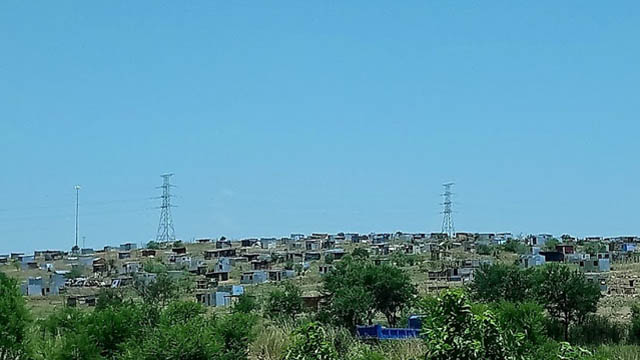
-
 Esther Kibuka-Sebitosi
Esther Kibuka-SebitosiIt is 25 years since South Africa achieved a democratically elected government in 1994. Nelson Mandela, who was imprisoned for 27 years, became the first black president after years of apartheid system governing the Republic. What is apartheid and what were some of the effects on housing? The Sustainable Development Goal 11 aims to make cities safe and sustainable; ensuring access to safe and affordable housing and building slum settlements into decent houses. It also calls for investment in roads, transport, creating green spaces and improving urban planning. This would envisage participatory planning and inclusive development. The image demonstrates the complexities of participatory planning and urban development in previously divided societies.
Historical perspectives
South African history can be divided into distinct phases: pre-colonial era, colonial era, post-colonial era, apartheid era and the post-apartheid era. During these periods, many different historic events characterised by violent clashes between the indigenous people and european settlers forcefully displacing them from their land occurred. The cultural differences were used to oppress and marginalise the people while racial tensions underlying the political oppressions were extensive. The shack is an object that symbolyses not only the oppression in living conditions, but also inequalities in economics and infrastructure.
Apartheid systems created shacks
Between 1948 and 1991, the system of administration in South Africa was apartheid. It was a National party system of racial discrimination and human rights violation. Fundamental to it was the Homeland Citizens Act of 1970, which augmented the Native Land Act of 1931 through the establishment of the so-called Homelands or reservations. The Act authorised the forceful removal of black people from urban centres to “Bantustans”. Surprisingly the apartheid perpetrators and sympathizers quoted a similar act in India where the British had done similar things without backlash from international community.
The typical Township in South Africa refers to underdeveloped segregated areas established from the 19th century until the end of the apartheid era to cater for non-whites namely Indians, “Africans” (meaning black) and people of colour. The Townships were located on the periphery of towns and cities. The Diepsloot Township in the image above therefore fits its purpose to serve the affluent towns because of its location along the highway.
The images show the shacks in Diepsloot Township. Close to 1.4 million people live in Diepsloot Township. Characteristically, such areas abound with crime, violent protests due to lack of basic services and overcrowding. The township is also full of diversity of culture, tribes, tradition and many nationalities, due to rural to urban migration. The major problems include unemployment, poverty and lack of basic services which result from lack of education and skills. Coupled with deprivation of water, sanitation and basic infrastructure, shack living environments are unsustainable and challenging sustainable cities.
In South Africa, the term “township” and “location” refers to segregated urban areas that arose from the late 19th century that were reserved for non-whites (Indians, blacks and people of colour). Built on the periphery of towns and cities, townships integrated the roots and systems of apartheid so deeply that they are almost difficult to eradicate. Despite strides made over the past twenty five years to provide decent housing for the majority of the population, Townships and shacks in particular still exist. As part of the mining industry, the black population comprising men lived in hostels and servants' accommodations. With increasing urbanization, the rapid urban expansion could not keep up with the influx of people which led to overcrowding. In the 1950s, townships in the Witwatersrand areas grew exponentially as the gold rush expanded. The shack township settlements were of poor quality but provided advantage over the hostels in more established areas as they were cheaper and not regulated by the apartheid government. With increasing eviction of black people from “white” areas, the forced removals resulted into a broad movement into segregated townships creating the designated race groups - black, coloured and Indians per the Population Registration Act of 1950 and the Group Areas Act.
With the fall of apartheid in 1994, the townships still persisted because it was a systemic problem that can only be solved in a multi-sectoral way. Typically, most towns in South Africa have a township associated with them. The New Democracy has created modern developments in townships since 1994 for example building wealthy homes and middle class income homes. In Soweto for instance there are many new developments. Hence "township" is changing its meaning and ways as it no longer means the original apartheid low income location but a home for the growing middle class. This has resulted in properties and real estate development in the townships. Although many houses were built inofficially, the government has improved the access to water, electricity and roads that impact on the quality of life. The biggest challenge is to make the progress sustainable. With plans to build the sewage system, water and electricity, townships are increasingly attract young people. As they belong to the generation of millennials, who want to stay connected globally, it is not surprising that the shacks in townships have connected to digital devices and satellite television, after all, the people have to live their life. A study in Diepsloot showed that 24% of the residents lived in brick structures, 43% in shacks and 27% in backyard shacks (additional units build on a plot of land by the landlord to get extra income (Harber, 2011).
Summary
The shacks are small constructions built on the periphery of towns and cities to provide cheap accommodation to the growing number of people working in towns or cities. The discovery of diamonds and gold in the 19th century in South Africa had a profound impact on the wealth of the region, propelling it into world stage competition for industrialisation. This was a fundamental shift from an agrarian-based economy with effects on the people and society. Not only were conflicts between the “Boer” farmers and the British Empire created, but also conflicts among the black natives as the groups fought for control over resources of the mining industry. These fights continued to define the mining industry for years and years. One sphere impacted was the human settlements. Between 1948 to 1994, the country was dominated by Afrikaner nationalism led by systems of racial segregation and a white minority rule called the apartheid, an Afrikaans word meaning “separateness”. The blacks, Indians and people of colour were forcibly removed from their land into Homelands or townships. With increasing demand for housing, shacks provided a cheaper option close to towns and cities. With no basic services, the areas continue to challenge governments as they are in need of building sustainable cities and sustainable solutions.
Shacks remind us of the lived experiences of people wanting to create sustainable livelihood in the economy. Given the opportunity of a job in a town or city, the viable option would be to live in a shack that is cheaper than brick construction. The downside is the lack of basic infrastructure and basic services for the population who want to participate in the economy. The dual economy in South Africa comprises the affluent businesses listed on the Johannesburg stock exchange and the basic township economy. People who want to participate have to choose between living in a shack or to be excluded from economy. The contradictions of the creation of jobs without viable sustainable housing options leads to the perpetuation to the segregation. An extension of two cities - two economies. Shacks on one side of the highways and the affluent middle class on the other side. The images show the contradictions and frustrations of moving towards sustainable cities in a country divided by inequalities.
This phenomenon is not only a South African one, but known worldwide: In Brazil and Mexico there are also areas divided by inequalities of social, economical and recently technological divide.
References:
- Harber, A. (2011) Diepsloot, Jeppestown: Jonathan Ball Publishers LTD, 2011. 2011. 1-226. Print.
- Tinashe, P. (2014). We have a story to tell — Diepsloot youth: A quest for safe space and opportunities to earn a living. (PDF).
- Rosa Luxemburg Stating. p. 2. Retrieved 9 November 2018.
- Foster, D. (2012): After Mandela: The Struggle for Freedom in Post-Apartheid South Africa
- https://unequalscenes.com/alexandra-sandton Retrieved 22 Jan 2019
- https://www.google.com/search?rlz=1C1EODB_enZA550ZA550&tbm=isch&q=shacks+in+Townships+near+Lanseria+Airport&chips=q:shacks+in+townships+near+lanseria+airport,online_chips:apartheid,online_chips:gauteng,online_chips:apartheid+museum&usg=AI4_-kTUvSb-CcNIqEavZu8utwO5g7HbUg&sa=X&ved=0ahUKEwislenZooLgAhXUQxUIHeIRDOYQ4lYILSgC&biw=1025&bih=587&dpr=1, Retrieved 25 January, 2019.
published April 2020

